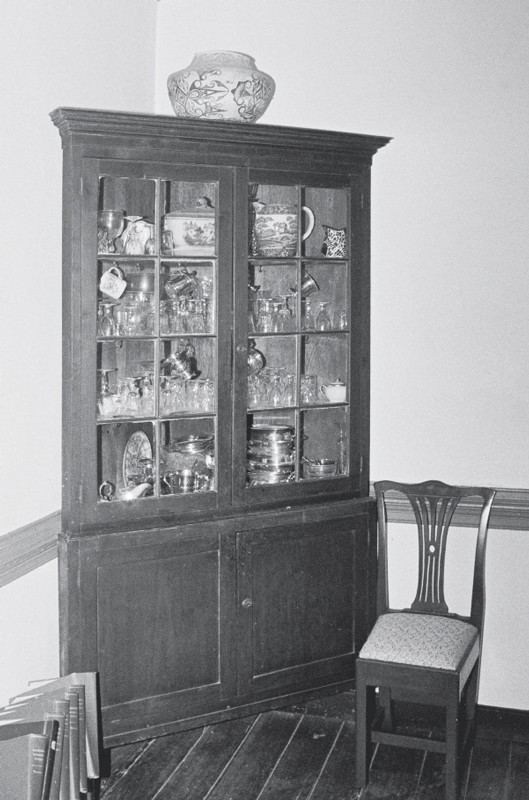
Zuni water jar, 1880–1895, in the St. George Tucker House dining room, Williamsburg, Virginia, 1986. (Courtesy, Colonial Williamsburg Foundation; photo, Willie Graham.)
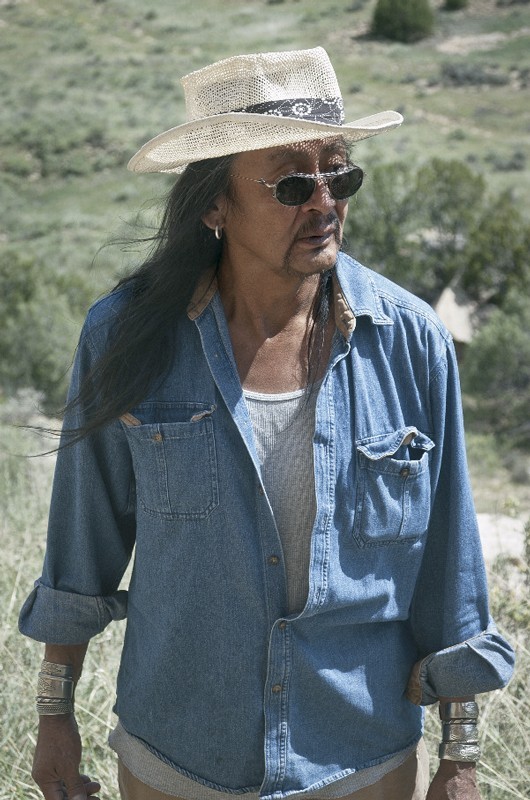
Randy Nahohai, 2011. (Photo, Edward Chappell.)
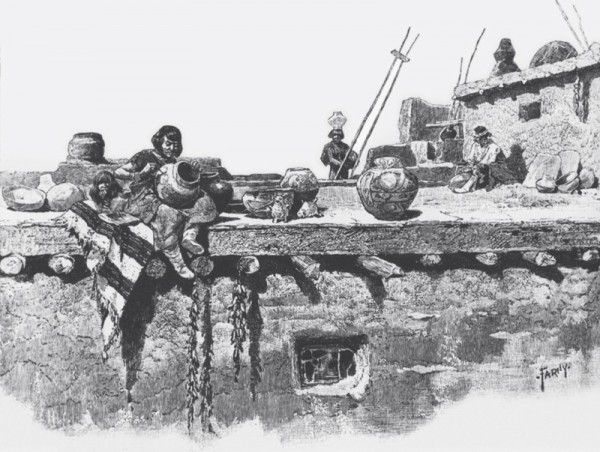
Decorating Pottery, engraving by H. F. Farny, published in Frank Hamilton Cushing, “My Adventures in Zuñi,” Century Magazine 25, no. 2 (December 1882): 201. (Courtesy, Cornell University.)

Pueblo of Zuni, 1879. (Photo, John K. Hillers; courtesy, Cowan’s Auctions.) Hillers accompanied James and Matilda Stevenson and Frank Hamilton Cushing to Zuni.)

Young Zuni woman with water jar, 1873. (Photo, Corps of Engineers, attributed to Timothy O’Sullivan; author’s collection.)
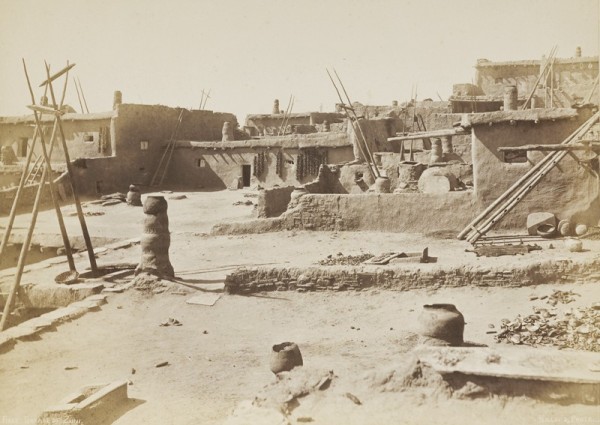
Bottomless jars used in constructing chimneys, Pueblo of Zuni, New Mexico, 1879. (Photo, John K. Hillers; courtesy, Cowan’s Auctions.)
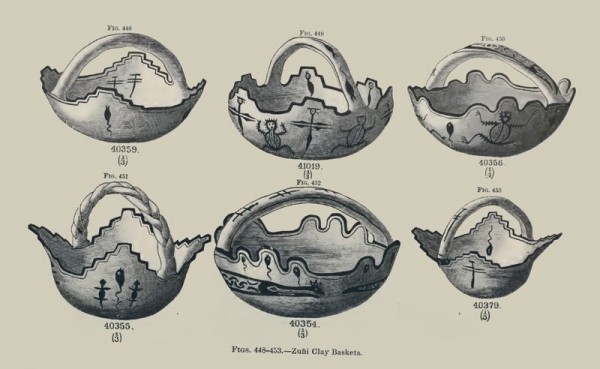
Terraced bowls collected by James Stevenson at Zuni in 1879, published by Bureau of Ethnology, Annual Report, 1883, figs. 448–53. (Courtesy, Smithsonian Institution.)

Zuni house interior with plain walls, masonry benches, and water jars, 1899. (Courtesy, National Anthropological Archives, Smithsonian Institution; photo, Adam Clark Vroman, NAA. GN02297.)
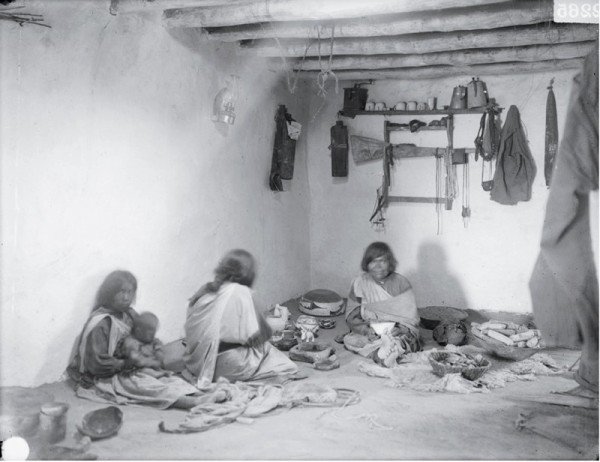
Zuni house interior with women burnishing and painting pottery, 1899. (Courtesy, National Anthropological Archives, Smithsonian Institution; photo, Adam Clark Vroman, NAA. GN02265.)
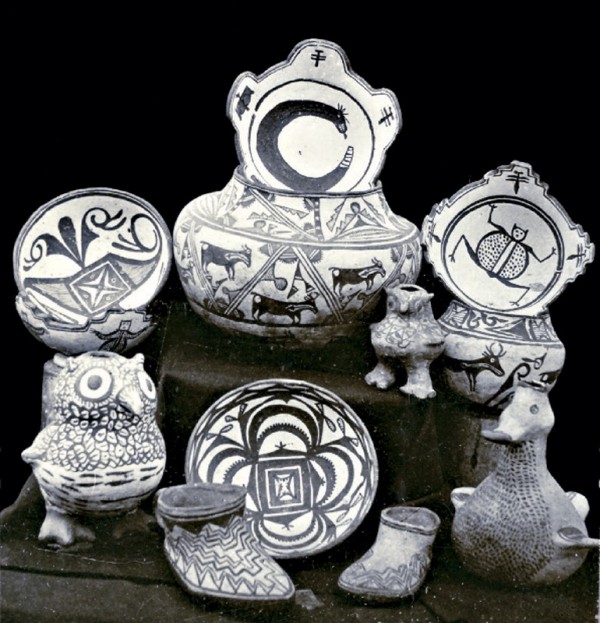
Zuni vessels assembled for the tourist trade, ca. 1900. (Photo, author’s collection.)

Photograph showing aestheticization of Zuni vessels, in sharp contrast to the earlier view in fig. 10. (Photo, Burton Frasher; author’s collection.) The jars are probably by Tsayutitsa, ca. 1930.
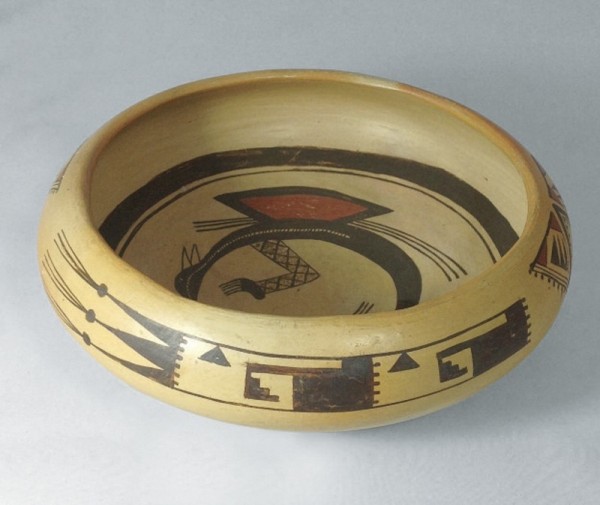
Sikyatki Revival bowl with avian motif, Daisy Hooee Nampeyo, Hopi-Tewa, 1950–1970. Earthenware. D. 8 1/4". (Photo courtesy, Quinn's Auction.) In shape, color, and motifs, this vessel is quite unlike those she taught Zuni students to make.
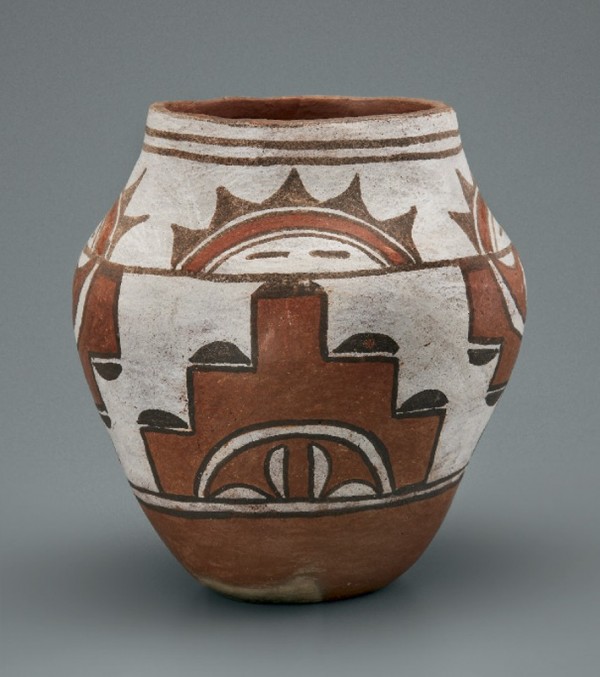
Jar, Eudora Montoya, Santa Ana Pueblo, New Mexico, 1960–1970. Earthenware. H. 7". (Unless otherwise noted, all objects in author’s collection; photo, Gavin Ashworth.)

Jars, John Montoya, Sandia Pueblo, New Mexico, 1994. Earthenware. H. of tallest 3 1/2", H. of shortest 1 7/8". (Photo, Gavin Ashworth.)

Jars, Kewa Pueblo, New Mexico. Earthenware. Left: Andrew William Pacheco, 1990. H. 4 3/4". Center: Robert Tenorio, ca. 1988–1989. H. 5 7/8". Right: Andrew William Pacheco, 1991. H. 5 3/4". (Photo, Gavin Ashworth.)

Objects by Diego Romero and Santiago Romero, Cochiti Pueblo, New Mexico. Earthenware. Left: Bowl, Diego Romero, 2006. D. 8 1/2". Inscribed “American Highway: Still Truckin’.” Center: “Desert Lylee” (Romero family dog), Santiago Romero, 2012. H. 10 5/8". Unmarked. Right: Bowl, Diego Romero, ca. 2008. D. 7". Inscribed “On the Green” (Photo, Gavin Ashworth.)

Lizard jar, Teresita Romero, Cochiti Pueblo, New Mexico, 1950–1975. Earthenware. H. 6". (Photo, Gavin Ashworth.)

Jar, Tsayutitsa, owned by Pueblo of Zuni, New Mexico, 1939. Earthenware. H. 21 5/8". (Courtesy, Museum of Indian Arts and Culture.)
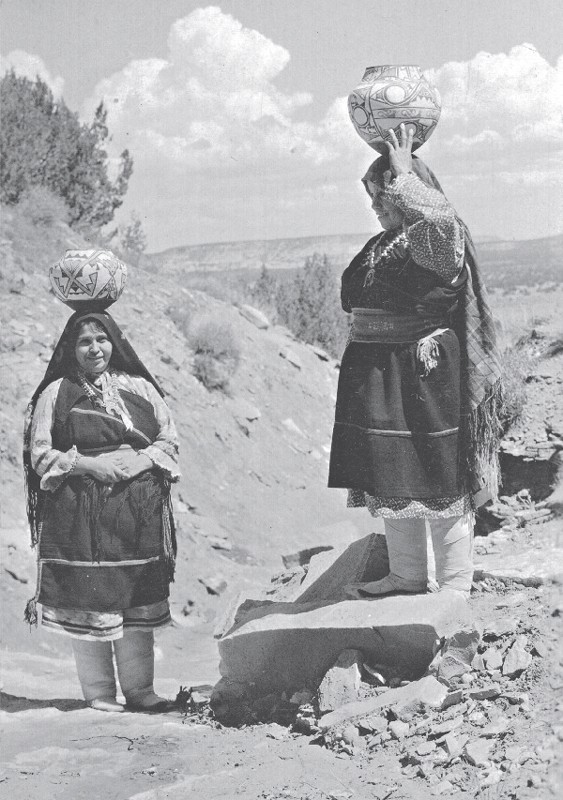
Zuni women with water jars, ca. 1931. (Photo, Burton Frasher; author’s collection.)

Zuni pottery owls, New Mexico, ca. 1950–2015. Earthenware. Back row: Unidetsa Kallestewa, Erma Kalestewa Homer, and Myra Eracho; middle row: Spotted-Feather Owl Potter, Bica-Kalestewa family, Eileen Yatsattie, Quanita Kalestewa, and Zoe Jarmon (two); front row: Spotted-Feather Owl Potter (two), Josephine Nahohai, Erma Homer, Nellie Bica, Nellie Bica and Erma Homer, Rowena Kalestewa, Erma Homer, Celecita Vicente, and Sadie Tsipa. H. of tallest 11", H. of shortest 2 3/8". (Photo, Edward Chappell.)
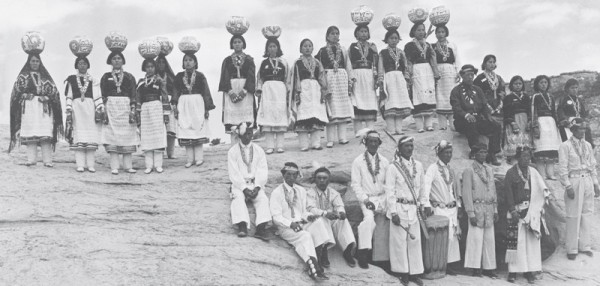
Lawsaiyatesetsa (far left, back row) at Gallup Inter-Tribal Ceremonial, 1937. (Photo, H. Eisenhand; author’s collection.) She carries a jar different from the Deer in His House and Rainbird jars carried by the younger women.
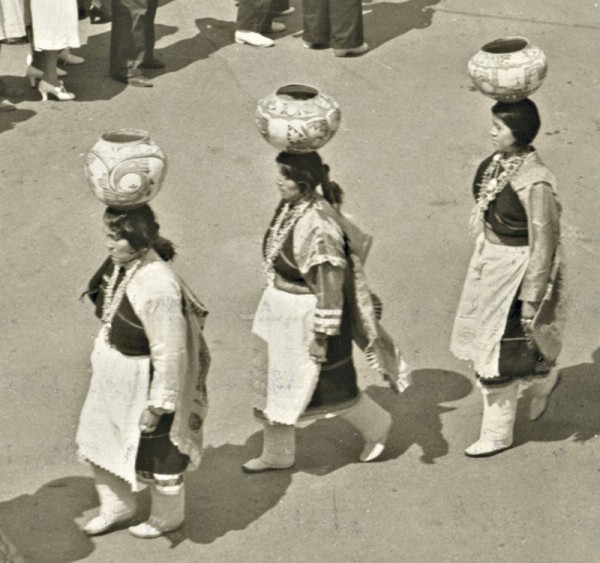
Lawsaiyatesetsa (far left) at Gallup Inter-Tribal Ceremonial, 1938. (Photo, Burton Frasher; author’s collection.)

Jars, Tsaw-a:si, Pueblo of Zuni, New Mexico, 1951. Earthenware. H. 6 1/2", 9 1/4". (Photo, Edward Chappell.)

Offering bowls by (left to right) Erma Kalestewa Homer, Eileen Yatsattie, and Brandon Kallestewa, Pueblo of Zuni, New Mexico, ca. 1995, ca. 2000, 2004. Earthenware. D. 7 1/4", 8”, 6 7/8". (Photo, Gavin Ashworth.) The bowl on the far right is slipcast.

Erma Kalestewa Homer holding a stew bowl made by her grandmother Nellie Bica in about 1980. (Photo, Edward Chappell.)

Pitcher for Rain Priests, Rowena Him, Pueblo of Zuni, New Mexico, ca. 1987. Earthenware. H. approx. 11". (Photo, courtesy Milford and Randy Nahohai.)
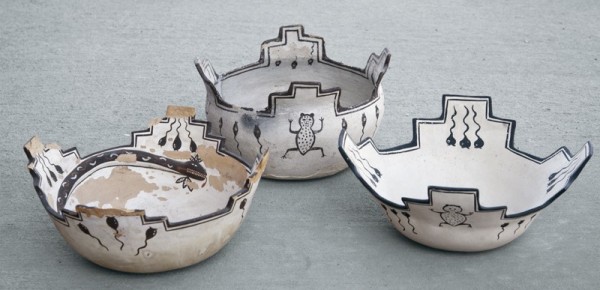
Bowls for Rain Priests, Pueblo of Zuni, New Mexico, (left to right) 1986–1990, 1945–1960, 1980–1985. Earthenware. W. (left to right) 12", 9 3/8", 11 3/4". (Courtesy, Eileen Yatsattie; photo, Edward Chappell.) The bowls on the right and left are Eileen Yatsattie’s first and second replacements for the center bowl, by Margaret Walela.

Left and right: Jars, Jack Kalestewa, Pueblo of Zuni, New Mexico, 1985–1990. Earthenware. H. 5 1/4", 6 1/2". Center: Cornmeal bowl, Quanita Kalestewa, Pueblo of Zuni, New Mexico, 1985–1990. Earthenware. W. 10". (Photo, Gavin Ashworth.)
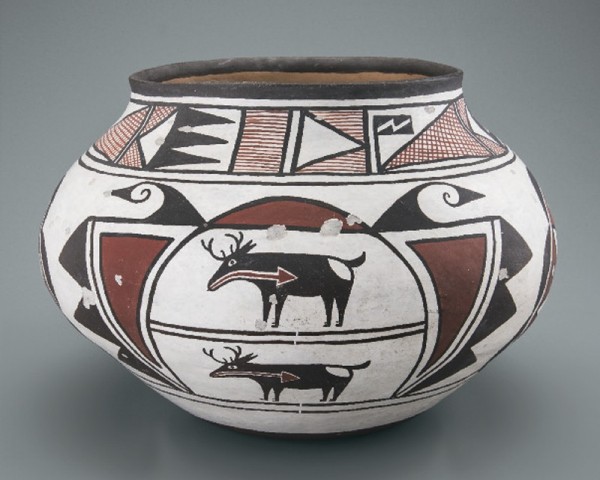
Jar decorated with Deer in His House motif, Nellie Bica, painted by Erma Kalestewa Homer, Pueblo of Zuni, New Mexico, ca. 1985. Earthenware. H. 9 1/2". (Photo, Gavin Ashworth.)
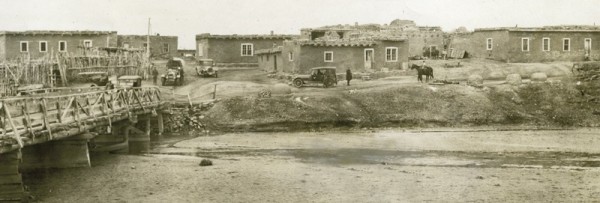
Zuni River and town viewed from the south, ca. 1920, when Josephine Nahohai was a young girl. (Photo, author’s collection.)
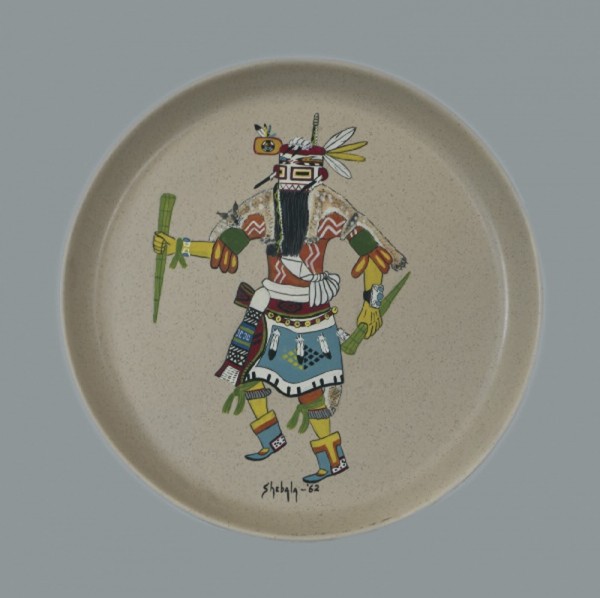
Plate with He-lele Ko’hanna figure painted by Dixon Shebala after industrial firing, 1962. Stoneware. D. 10 1/4". Signed on obverse: “Shebala – 62"; mark on reverse: “BAUER CALIF-U.S.A.” (Photo, Gavin Ashworth.)

Josephine and Nat Nahohai, Pueblo of Zuni, New Mexico, ca. 1945. (Photo, courtesy of Milford and Randy Nahohai.)
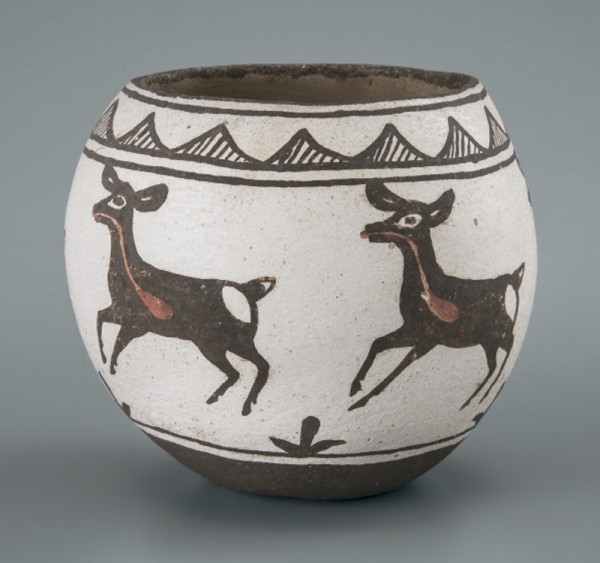
Jar, Myra Eriacho, Pueblo of Zuni, New Mexico, 1950–1960. Earthenware. H. 4 3/8". (Photo, Gavin Ashworth.)

Jar, Ethel Youvella, Tewa-Hopi, Polacca, Arizona, 1975–1990. Earthenware. D. 10 1/2". (Photo, Gavin Ashworth.)

Zuni potter Kyusita, also called Cayusetsa, applying coils of clay, 1918. (Photo, George H. Pepper; author’s collection.)
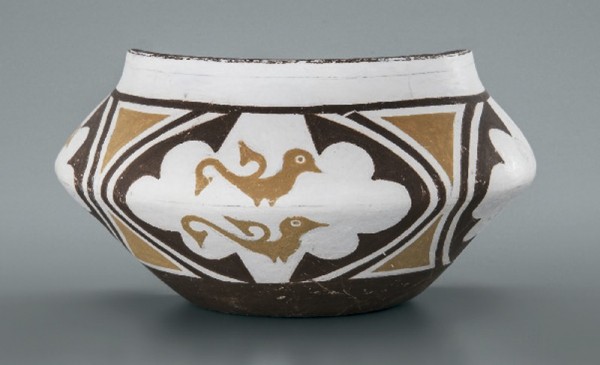
Unfired jar, Quanita Kalestewa, Pueblo of Zuni, New Mexico, 1987. Earthenware, painted with hematite brown and yellow ochre over kaolin slip. D. 6 1/2". (Photo, Gavin Ashworth.)

Kyusita, having stacked dried dung over unfired pottery, 1918. (Photo, George H. Pepper; author’s collection.)

Zuni woman firing pottery, Pueblo of Zuni, New Mexico, 1932. (Photo, Burton Frasher; author’s collection.)

Owl, Josephine Nahohai, Pueblo of Zuni, New Mexico, ca. 1960. Earthenware. H. 9 1/2". (Photo, Gavin Ashworth.)
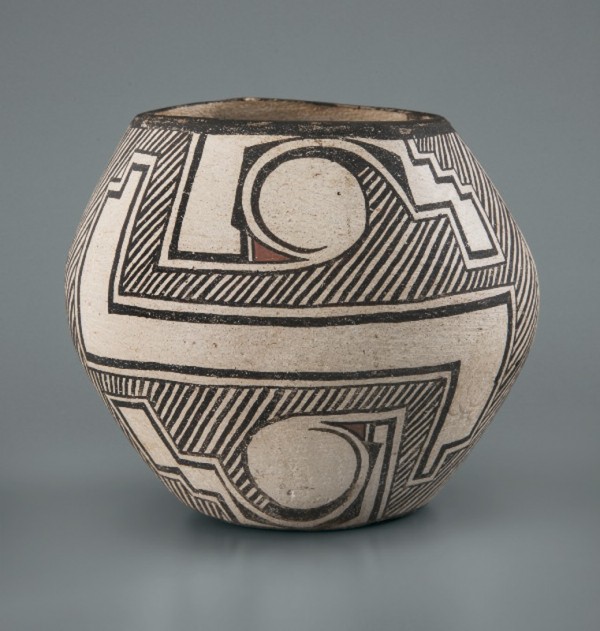
Jar, Josephine Nahohai, painted by Nat Nahohai, Pueblo of Zuni, New Mexico, ca. 1965–1975. Earthenware. H. 4 1/2". (Photo, Gavin Ashworth.)
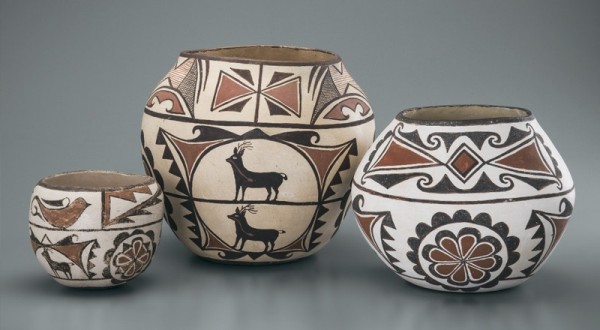
Jars, Josephine Nahohai, painted by Nat Nahohai, Pueblo of Zuni, New Mexico, 1975–1982. Earthenware. H. (left to right) 4 1/4", 9 1/2", 7". (Photo, Gavin Ashworth.) The two smaller jars have white slip; the larger one is unslipped.
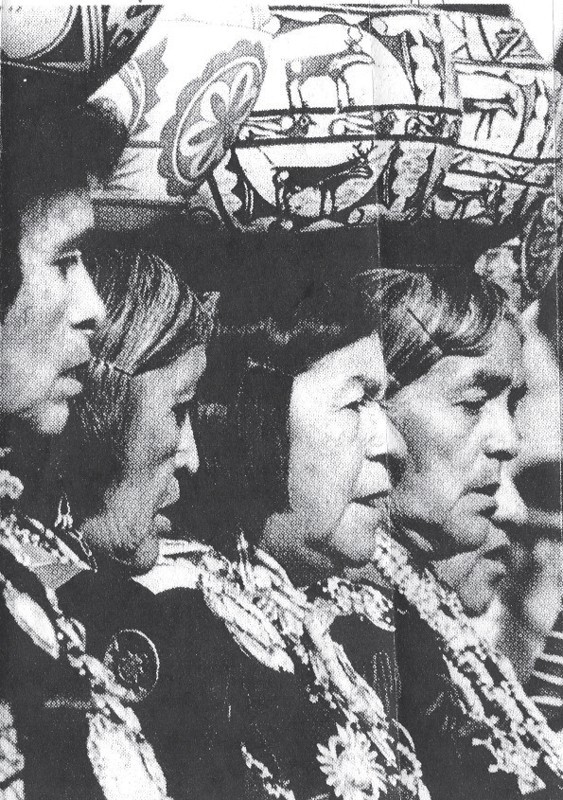
Josephine Nahohai (second from left) performing with Olla Maidens at Heard Museum, Phoenix, 1982. (Photo, courtesy Billie Jane Baguley Library and Archives, Heard Museum, call number PCD:199B 1276589_0042.) Josephine is balancing a slipcast jar painted by Randy Nahohai.

Owl by Jaycee Nahohai that broke during outside firing, 2010. (Photo, Edward Chappell.)
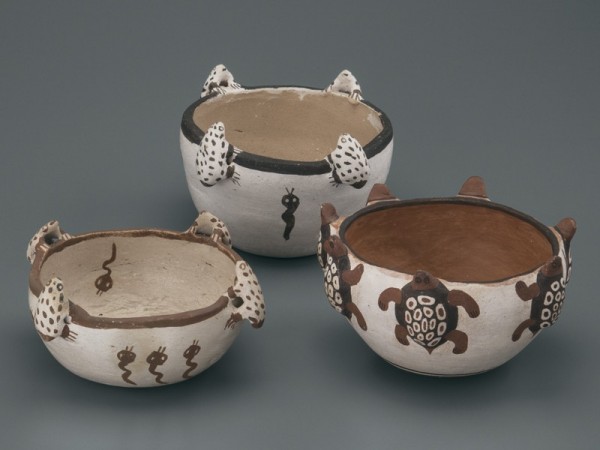
Frog bowls (left and center), Josephine Nahohai, Pueblo of Zuni, New Mexico, 1970–1984. Earthenware. W. 6 3/8", 6 3/4". Turtle bowl (right), Josephine and Milford Nahohai, Pueblo of Zuni, New Mexico, 1986. Earthenware. W. 6 3/8". (Photo, Gavin Ashworth.)

Jar, Josephine and Milford Nahohai, Pueblo of Zuni, New Mexico, 1986. Earthenware. H. 9". (Courtesy, the School for Advanced Research, SAR.1986-16-1; photo, Addison Doty.)

Cornmeal bowls by Josephine Nahohai, Pueblo of Zuni, New Mexico, 1975–1985. Earthenware. Left: Painted by Josephine Nahohai. W. 6". Center: Painted by Nat Nahohai. W. 6 3/8". Right: Painted by Randy Nahohai, who regularized Josephine’s terraces by applying a black border and ornamented the bowl with tadpoles and dragonflies. W. 6". (Photo, Gavin Ashworth.)
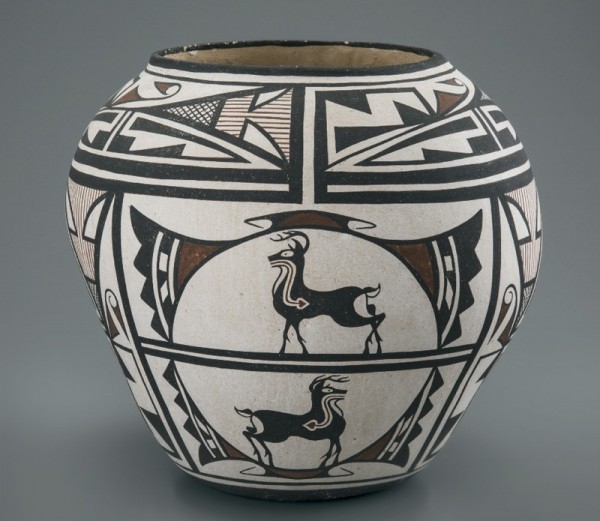
Jar, Josephine Nahohai, painted by Randy Nahohai with Deer in His House motifs, Pueblo of Zuni, New Mexico, 1978–1984. Earthenware. H. 9 1/4". (Photo, Gavin Ashworth.)
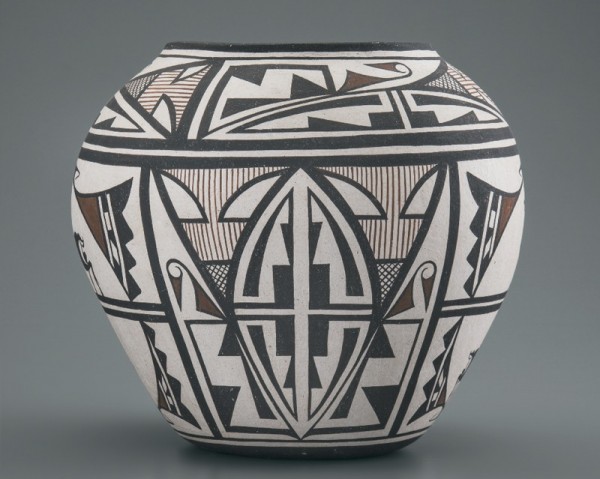
Side view of the jar illustrated in fig. 47, showing dagger motifs flanking doubled and quadrupled frets. (Photo, Gavin Ashworth.)
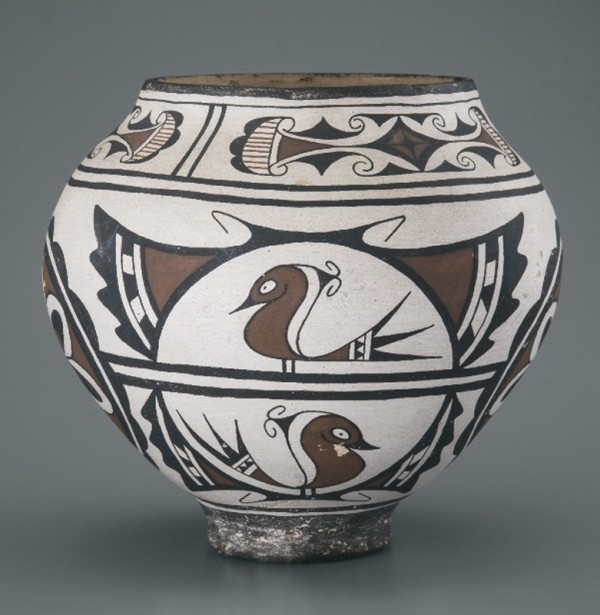
Jar, Josephine and Randy Nahohai, Pueblo of Zuni, New Mexico, 1985. Earthenware. H. 8". (Photo, Gavin Ashworth.)

Jar, Josephine, Randy, and Milford Nahohai, Pueblo of Zuni, New Mexico, 1983. Earthenware. H. 8 1/4". (Courtesy, Heard Museum Collection, object number NA-SW-ZU-A7-44; photo, Craig Smith.)
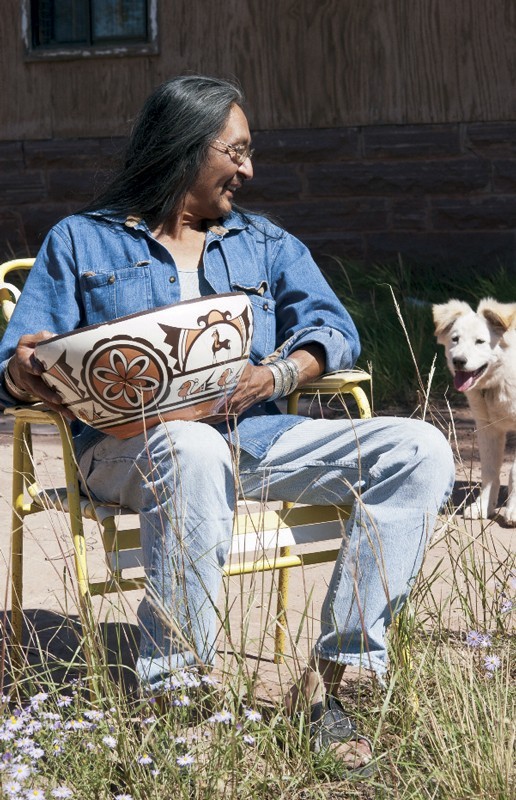
Randy Nahohai with stew bowl made for his mother as part of a set for Cindy Tsethlikai’s Shalako house ceremony, 1978. W. 14 1/4". (Photo, Edward Chappell.)

Corn figure, Randy Nahohai, Pueblo of Zuni, New Mexico, 1984. Earthenware. H. 8 1/4". (Courtesy, Smithsonian Institution, National Museum of the American Indian.)

Seed jars, Randy Nahohai, Pueblo of Zuni, New Mexico, 1984. Earthenware. H. of larger jar approx. 5". (Photo, courtesy Randy Nahohai.)
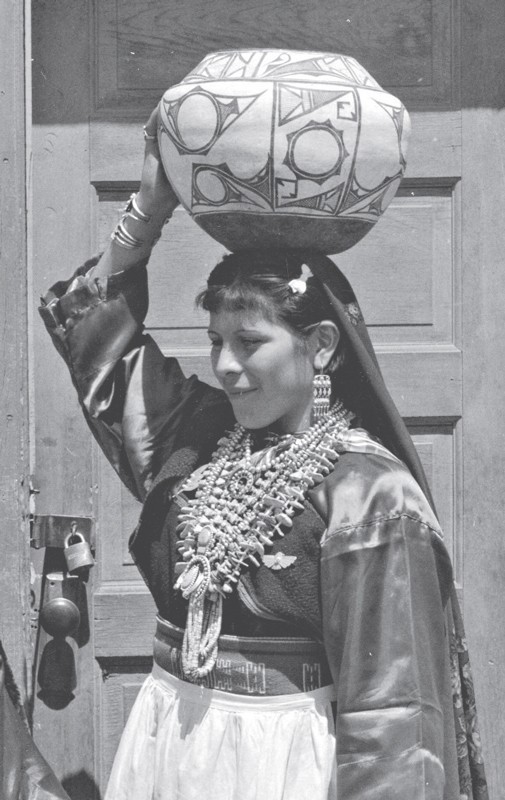
Vera Eustice in costume carrying a jar decorated with pairs of capped spirals, daggers, and circles, ca. 1940. (Photo, Burton Frasher; author’s collection.)
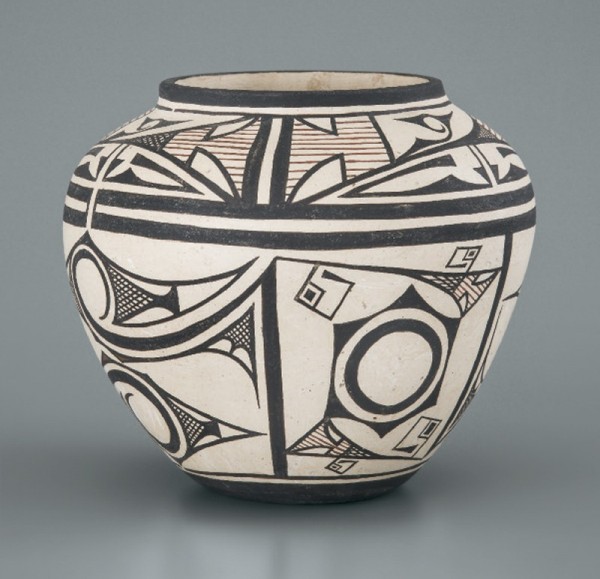
Jar, Randy Nahohai, Pueblo of Zuni, New Mexico, 1985. Earthenware. H. 5 1/2". (Photo, Gavin Ashworth.)

Rose Gasper, Josephine Nahohai and Eloise Westika sketching designs from Zuni pottery at the School of American (now Advanced) Research, Santa Fe, New Mexico. (Photo, Stephen Trimble.)

Jar, Eloise Westika, Pueblo of Zuni, New Mexico, 1980–1990. Earthenware. H. 4". (Photo, Gavin Ashworth.)
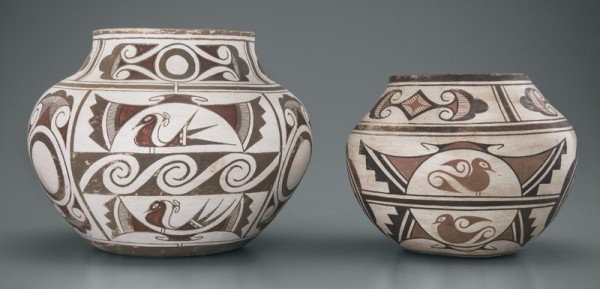
Jars, decorated with Bird in Its House designs, Josephine and Randy Nahohai, Pueblo of Zuni, New Mexico, ca. 1985 (left), 1986 (right). Earthenware. H. 9", 7 1/4". (Photo, Gavin Ashworth.)
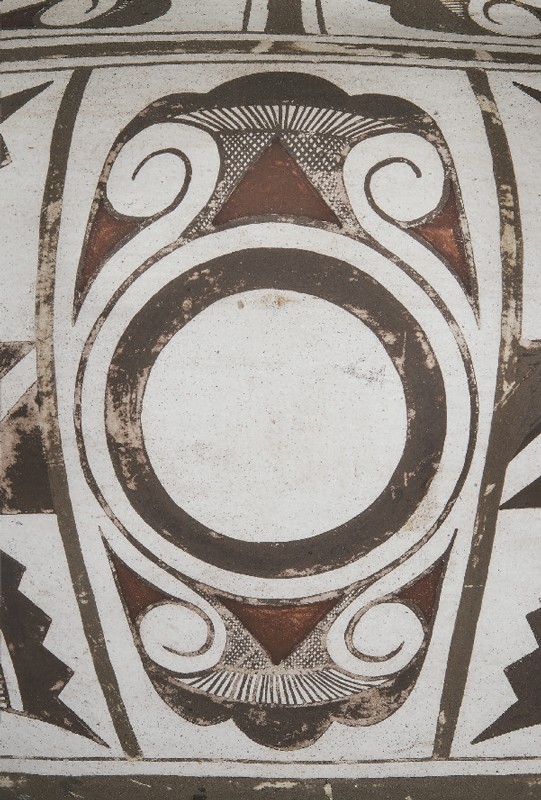
Spacer panel with crooked circle motif on the ca. 1985 jar illustrated on the left in fig. 58, painted by Randy Nahohai. (Photo, Gavin Ashworth.)

Rainbird jar, Randy Nahohai, Pueblo of Zuni, New Mexico, 1985. Earthenware. Dimensions unknown. (Photo, courtesy Milford Nahohai.)

Nahohai family (clockwise from upper left): Milford with Randy’s 1985 Rainbird jar, Randy holding newborn Jaycee, Rowena Him with a pottery owl by Josephine, and Josephine with a Rainbird bowl by Randy. (Photo, Steven Trimble.)
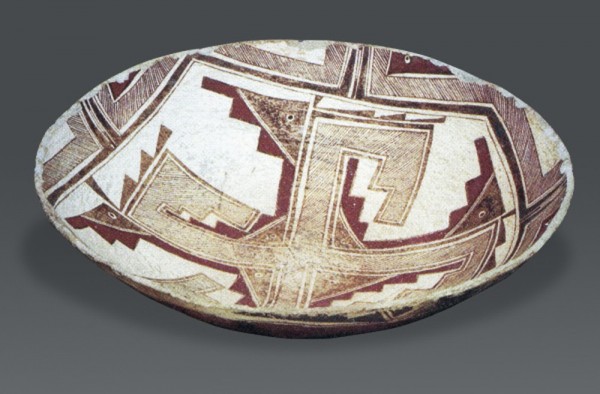
Fragmentary Kiapkwa Polychrome dough bowl from Zuni, ca. 1830. Earthenware. W. 17". (Courtesy, Museum of Indian Arts and Culture.)

Jar, Josephine Nahohai, painted by Randy Nahohai, Pueblo of Zuni, New Mexico, 1986. Earthenware. H. 9 7/8". Catalogue No. 87.48.20 (Courtesy, Maxwell Museum of Anthropology, University of New Mexico.)

Sketches for directional figures and Rainbirds, Randy Nahohai, 1986. Graphite, ink, and colored pencil on paper. 10 3/4" x 14". (Courtesy, Randy Nahohai.)
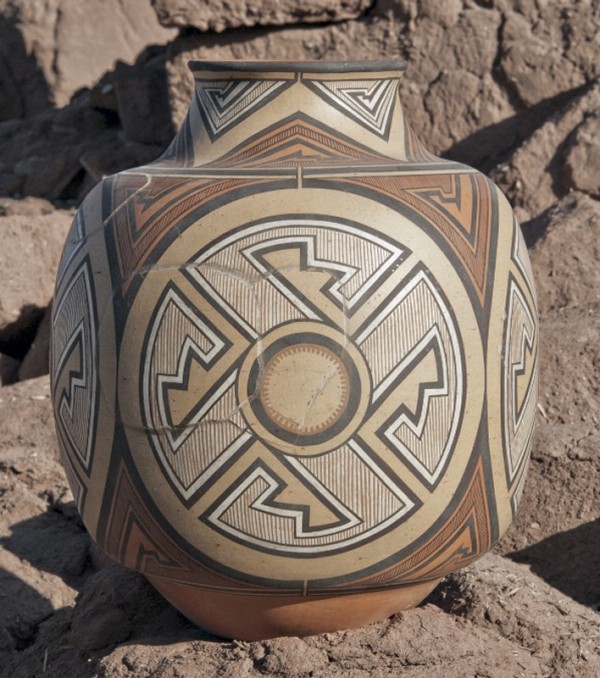
65 Jar, Randy Nahohai, Pueblo of Zuni, New Mexico, 1988. Earthenware. H. 14 1/2". (Courtesy, Milford Nahohai; photo, Edward Chappell.)
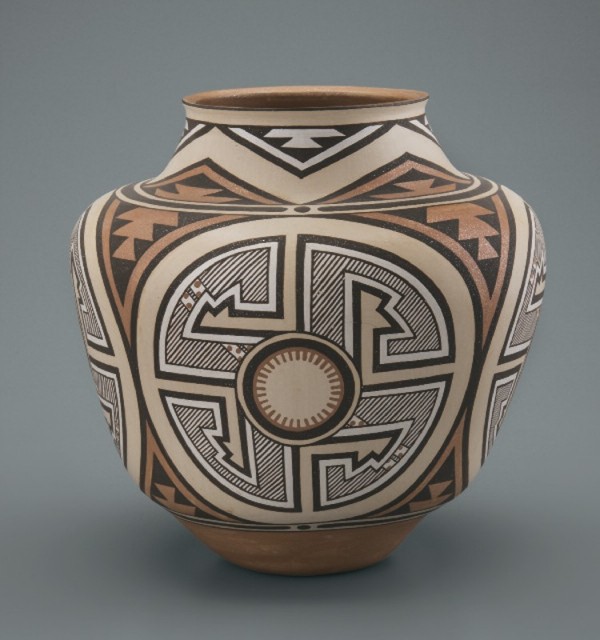
Jar, Randy Nahohai, Pueblo of Zuni, New Mexico, 1998. Earthenware. H. 10 1/4". (Photo, Gavin Ashworth.)
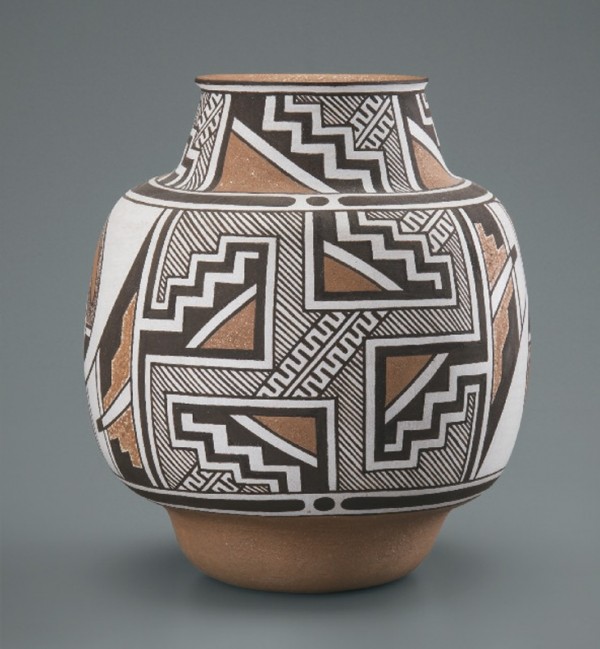
Jar, Randy Nahohai, Pueblo of Zuni, New Mexico, 1997. Earthenware. H. 8 7/8". (Photo, Gavin Ashworth.)
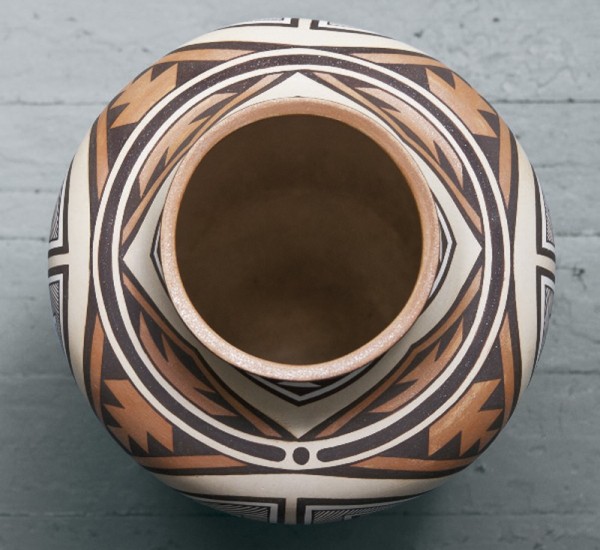
Jar, Randy Nahohai, Pueblo of Zuni, New Mexico, 1998. Earthenware. D. 10 1/2". (Photo, Edward Chappell.)
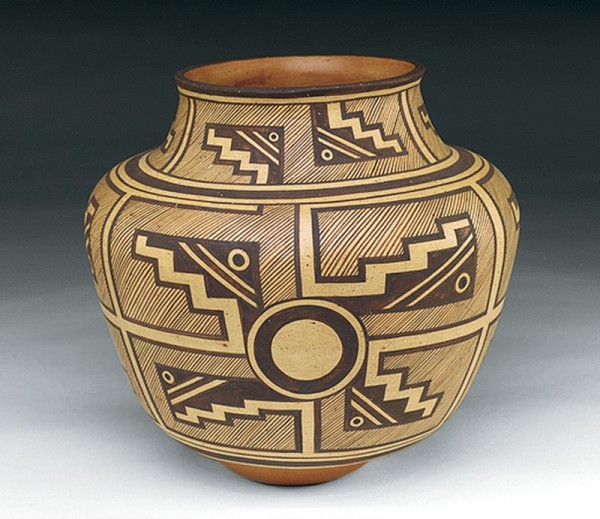
Jar, Randy Nahohai, Pueblo of Zuni, New Mexico, 1988. Earthenware. H. 8 5/8". (Photo, National Museum of the American Indian.)
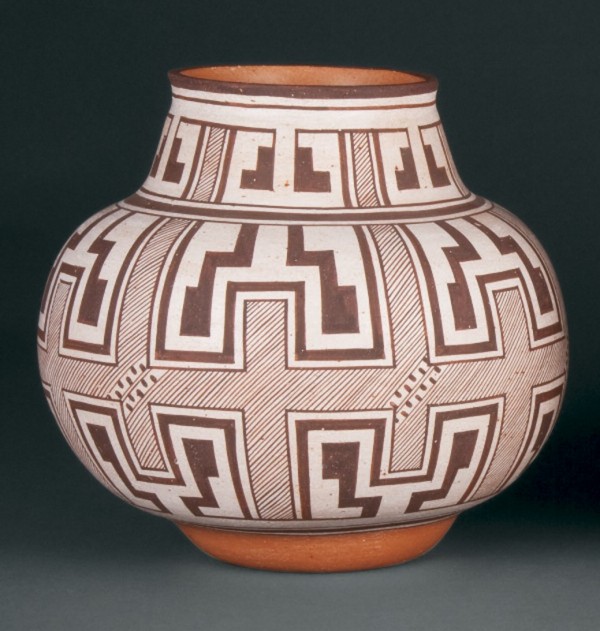
Jar, Randy Nahohai, Pueblo of Zuni, New Mexico, 1987. Earthenware. H. 10". (Courtesy, Eiteljorg Museum of American Indians and Western Art, Indianapolis.)
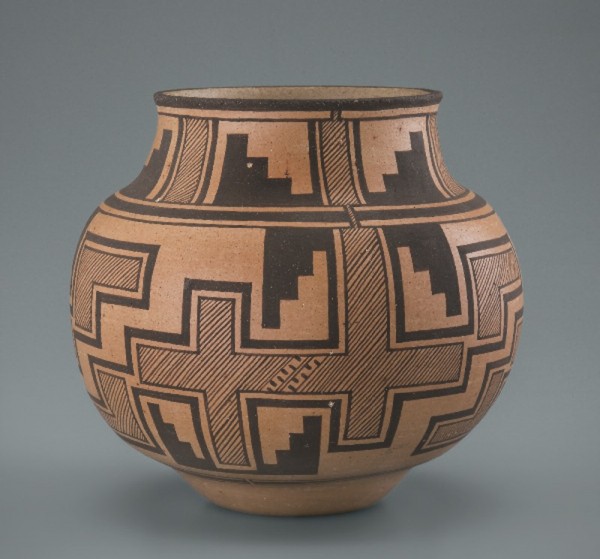
Jar, Randy Nahohai, Pueblo of Zuni, New Mexico, 1987. Earthenware. H. 7 7/8". (Photo, Gavin Ashworth.)

Jar, Randy Nahohai, Pueblo of Zuni, New Mexico, 1987. Earthenware. H. 12 1/2". (Photo, Bonhams.)
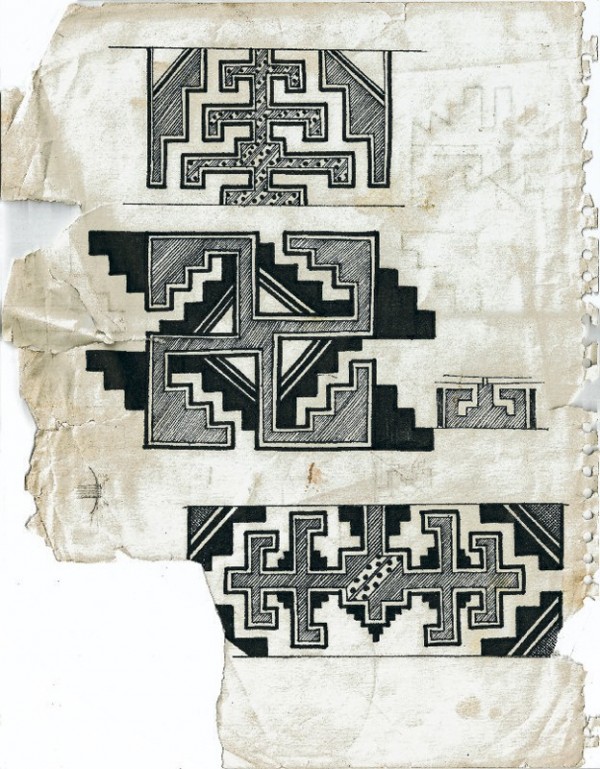
Sketches for geometric and directional figures, Randy Nahohai, ca. 1986. Graphite and ink on paper. 10 3/4" x 14 1/8". (Courtesy, Randy Nahohai.)

Sketches for Rainbird evolution, Randy Nahohai, 1986. Graphite, ink, and red pencil on paper. 10 3/4" x 14". (Courtesy, Randy Nahohai.)
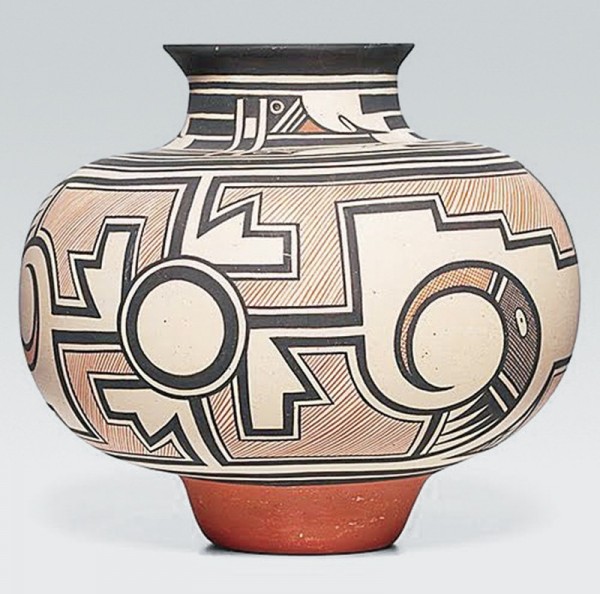
Rainbird jar, Randy Nahohai, Pueblo of Zuni, New Mexico, 1985. H. 9". (Courtesy, Treadway Gallery.)
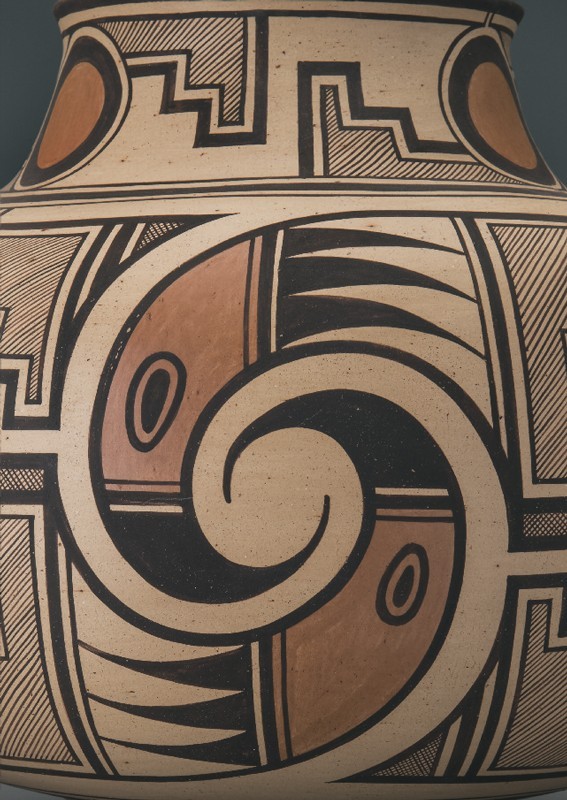
Rainbird motif, Randy Nahohai, Pueblo of Zuni, New Mexico, 1987. (Photo, Gavin Ashworth.)

Jars, Randy Nahohai, Pueblo of Zuni, New Mexico, 1987. Earthenware. H. 12 1/2" (left), 9 5/8" (right). (Photo, Gavin Ashworth.)
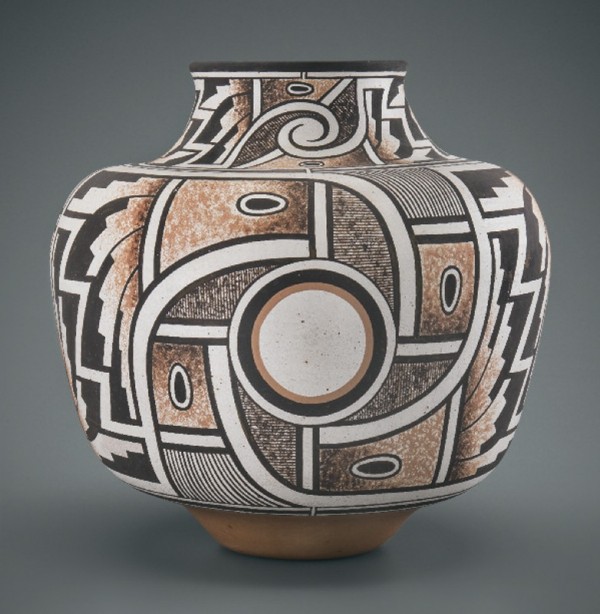
Jar, Randy Nahohai, Pueblo of Zuni, New Mexico, 1988. Earthenware. H. 12 1/2". (Photo, Gavin Ashworth.)
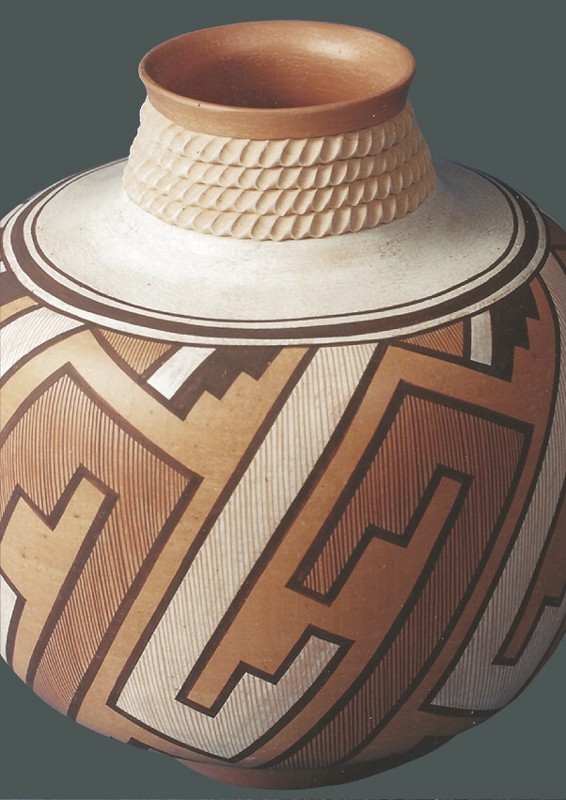
Jar decorated with hanging cloud motifs, Randy Nahohai, Pueblo of Zuni, New Mexico, 1988. Earthenware. H. 14". (Courtesy, John Barry.)
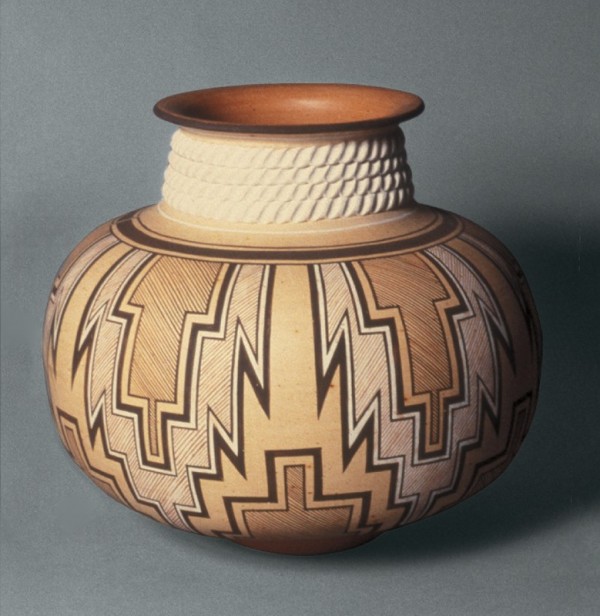
Jar, Randy Nahohai, Pueblo of Zuni, New Mexico, 1987. Earthenware. H. 10 3/4". (Courtesy, Heard Museum, object number 4070-1; photo, courtesy Milford Nahohai.)

Corrugated pottery sherd from surface at Hawikuh village, precontact. (Photo, Edward Chappell.)

Jars, two with corrugated necks, Randy Nahohai, Pueblo of Zuni, New Mexico, 1987–1988. Earthenware. (Courtesy, Randy Nahohai; photo, Randy Nahohai.)
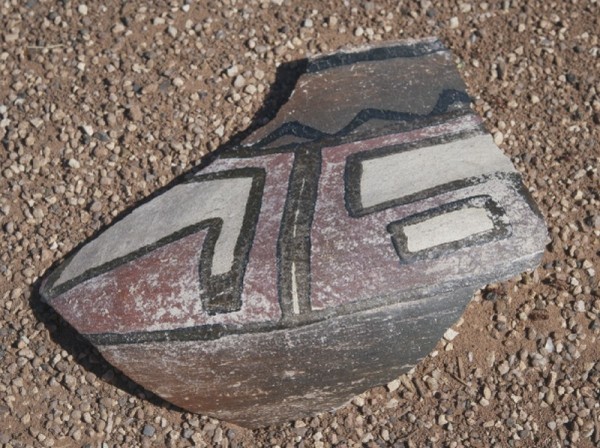
Hawikuh Polychrome jar fragment, glaze-painted, 1630–1680. (Courtesy, Milford and Randy Nahohai; photo, Edward Chappell.)
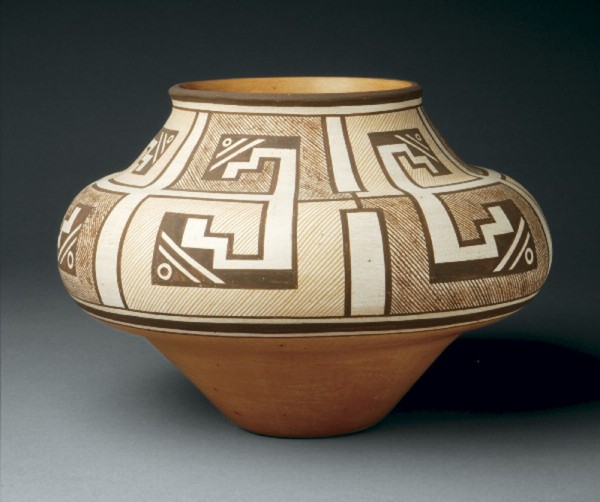
Jar, Randy Nahohai, Pueblo of Zuni, New Mexico, 1988. Earthenware. D. 12 1/2". (Courtesy, the School for Advanced Research, SAR.1994-4-600; photo, Addison Doty.)
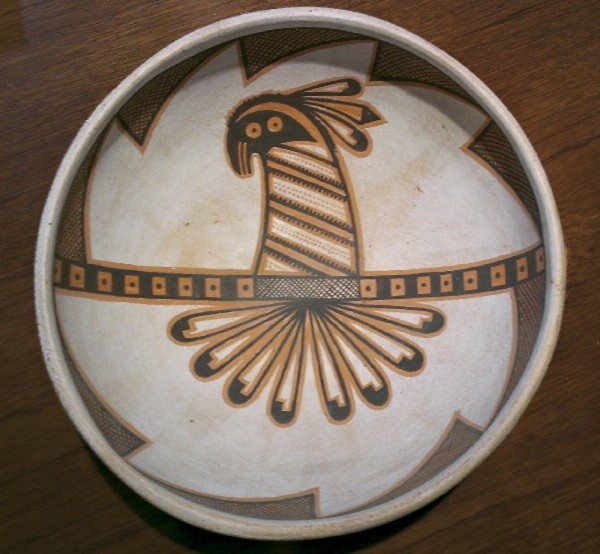
Bowl made for Brenda Shears, Randy Nahohai, Pueblo of Zuni, New Mexico, 1987. Earthenware. D. 8 1/4". (Courtesy, Keith Kintigh and Brenda Shears; photo, Brenda Shears.)

Hawikuh flying saucer jar, Randy Nahohai, Pueblo of Zuni, New Mexico, 1989. Earthenware. D. 14 1/2". (Photo, Gavin Ashworth.)
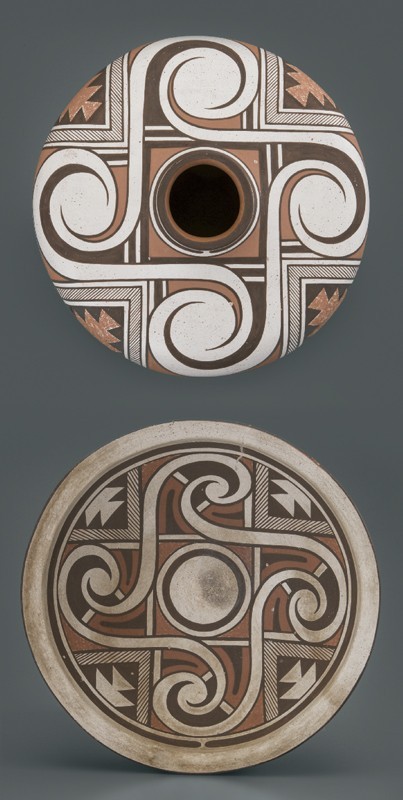
Jar (top) and bowl (bottom) with Rainbird compositions, Randy Nahohai, Pueblo of Zuni, New Mexico, 1990 (jar), 1991 (bowl). Earthenware. D. 11 1/2", 12 1/2". (Photo, Gavin Ashworth.)
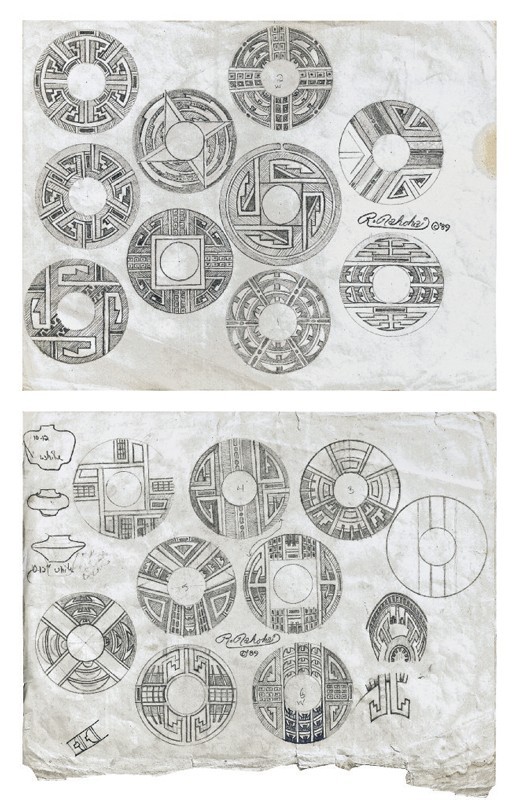
Two sheets of designs for painting jars, Randy Nahohai, 1989, inspired primarily by William Baake’s drawings of pottery excavated at Hawikuh. Graphite on paper. 14" x 11". The rough sketch for a flying saucer jar viewed from the side is labeled “10–12 white for Brenda Shears” on the left. (Courtesy, Randy Nahohai.)
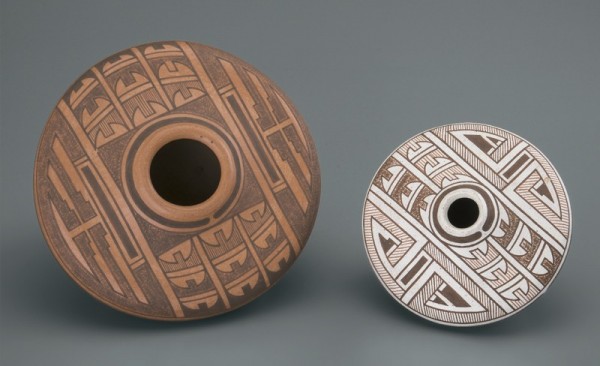
Jars, Randy Nahohai, Pueblo of Zuni, New Mexico, 1989. Earthenware. D. 8 1/8" (left), 5 7/8" (right). (Photo, Gavin Ashworth.)
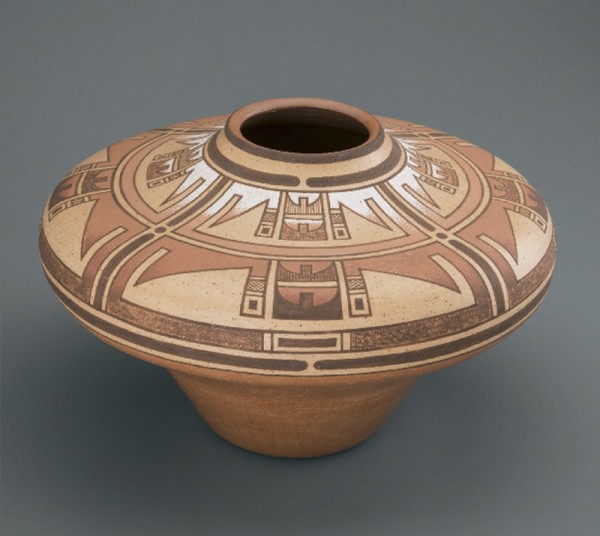
Jar decorated with designs drawn from Matsaki Polychrome vessels, Randy Nahohai, Pueblo of Zuni, New Mexico, 1989. Earthenware. D. 13 1/4". (Photo, Gavin Ashworth.)
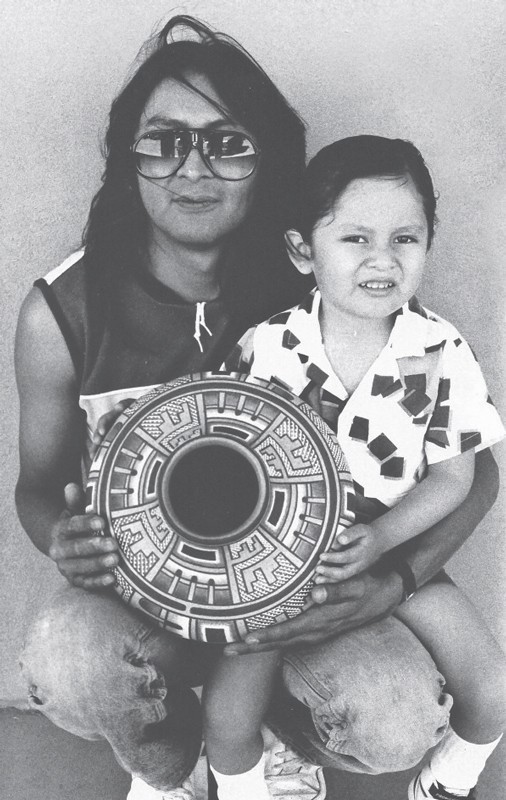
Randy and Jaycee Nahohai with jar, 1989. (Photo, James Ostler, courtesy Milford and Randy Nahohai.)
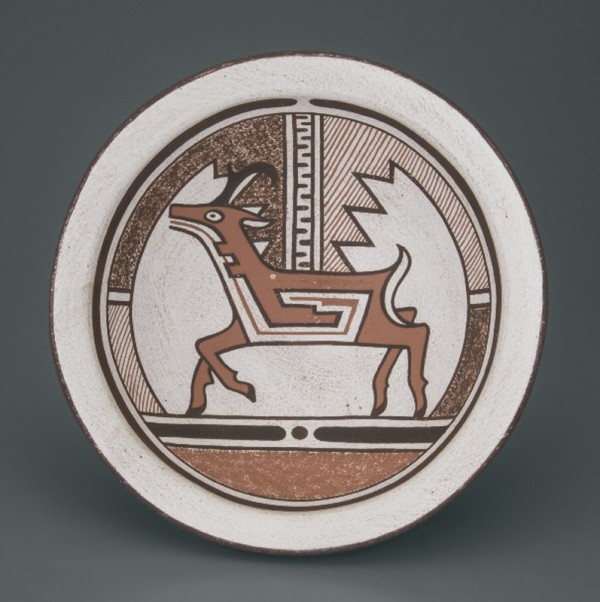
Bowl decorated with Antelope motif, Randy Nahohai, Pueblo of Zuni, New Mexico, 1992. Earthenware. D. 8 1/8". (Photo, Gavin Ashworth.)
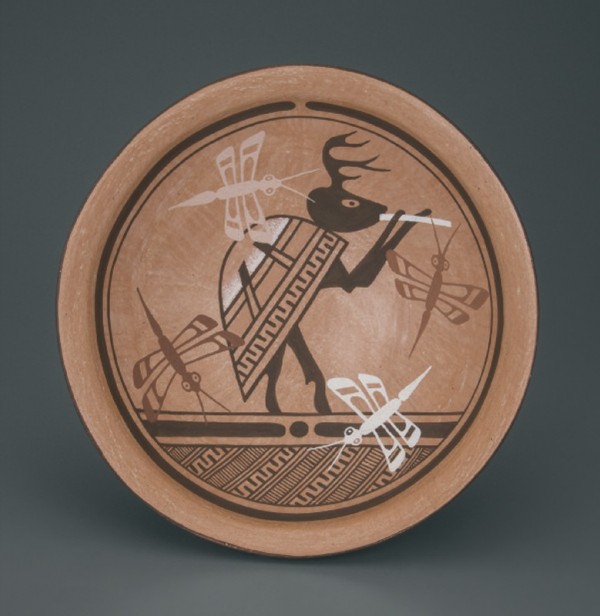
Bowl decorated with Flute Player motif, Randy Nahohai, Pueblo of Zuni, New Mexico, 1992. Earthenware. D. 9". (Photo, Gavin Ashworth.)

Bowls with flared rims and corrugated coils, Randy Nahohai, Pueblo of Zuni, New Mexico, 1992 (left), 1991 (right). Earthenware. Left: white-slipped exterior with rose-painted coil. D. 8 1/8". Right: orange-slipped exterior with unburnished coil. D. 12 1/4". (Photo, Gavin Ashworth.)

Bowl decorated with Wood Rat motif, Randy Nahohai, Pueblo of Zuni, New Mexico, 1992. Earthenware. D. 8". (Photo, Gavin Ashworth.)

Bowl, Randy Nahohai, Pueblo of Zuni, New Mexico, 1990. Earthenware. D. 7 5/8". (Photo, Gavin Ashworth.)
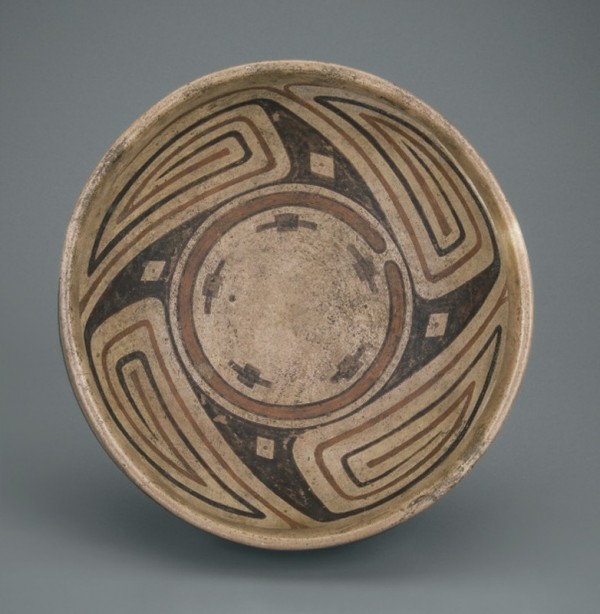
Bowl decorated with design inspired by a 1350–1450 Gila Polychrome jar, Randy Nahohai, Pueblo of Zuni, New Mexico, 1992. Earthenware, with unslipped surface. D. 7 3/4". (Photo, Gavin Ashworth.)
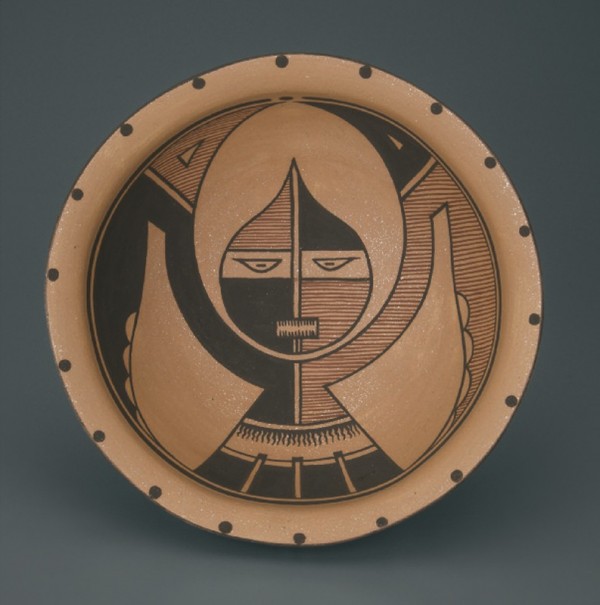
Bowl decorated with Knifewing motif, Randy Nahohai, Pueblo of Zuni, New Mexico, 2009. Earthenware. D. 8 3/4". (Photo, Gavin Ashworth.)

Bowl decorated with Longhair motif, Randy Nahohai, Pueblo of Zuni, New Mexico. Earthenware. D. 7 1/4". (Photo, Gavin Ashworth.)
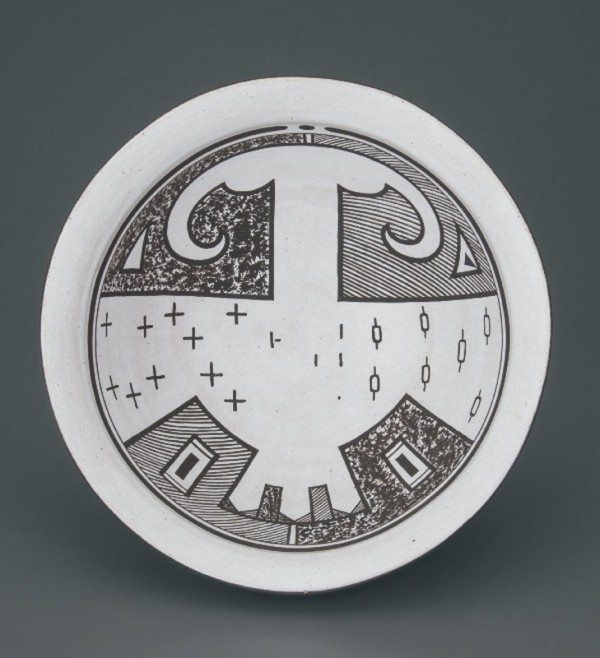
Bowl, Randy Nahohai, Pueblo of Zuni, New Mexico, 2009. Earthenware. D. 7 3/4". (Photo, Gavin Ashworth.)

Bowl, Randy Nahohai, Pueblo of Zuni, New Mexico, 2009. Earthenware. D. 7 3/4". (Photo, Gavin Ashworth.)
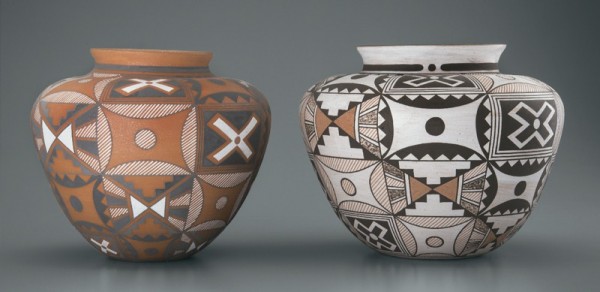
Kaleidoscope jars, Randy Nahohai, Pueblo of Zuni, New Mexico, 2007. Earthenware. H. 7 5/8" (left), 8" (right). (Photo, Gavin Ashworth.)

Flute player rock art, Village of the Great Kivas, Zuni, precontact. (Photo, Edward Chappell.)
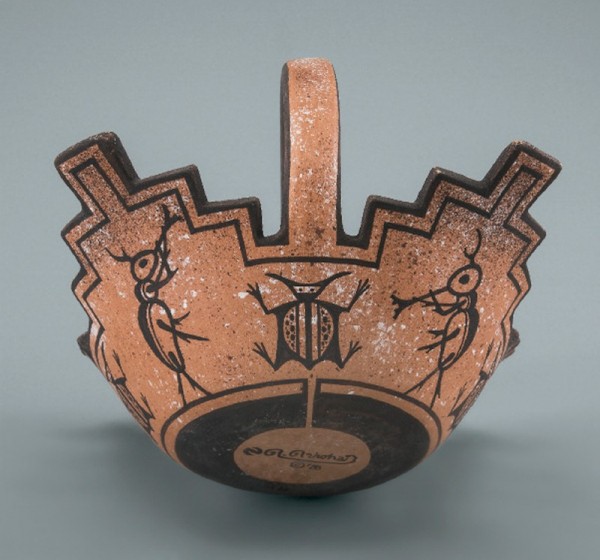
Cornmeal bowl decorated with flute players and frogs, Randy Nahohai, Pueblo of Zuni, New Mexico, 1988. Earthenware. W. 8 3/8". (Photo, Gavin Ashworth.)
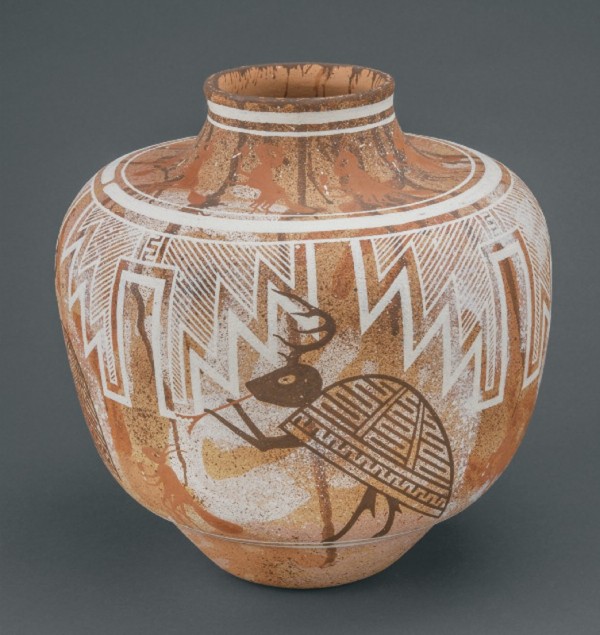
Jar, Randy Nahohai, 1990. Earthenware. H. 12 1/8". (Courtesy, Museum of Indian Arts and Culture.)

106 Jar, Randy Nahohai, Pueblo of Zuni, New Mexico, 1991. Earthenware. H. 14". (Photo, Gavin Ashworth.) The stains running down the face of the jar and the inverted brown handprints (as at the center) are applied before the figures and multiple white cloud motifs.
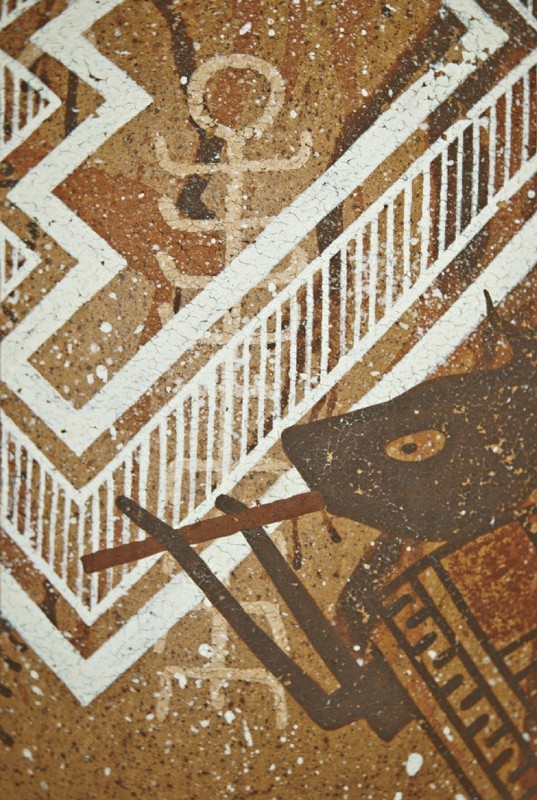
Detail of the cliff-faced belly on the jar illustrated in fig. 106, showing petroglyph, Hanging Cloud motif, and flute player. (Photo, Edward Chappell.)
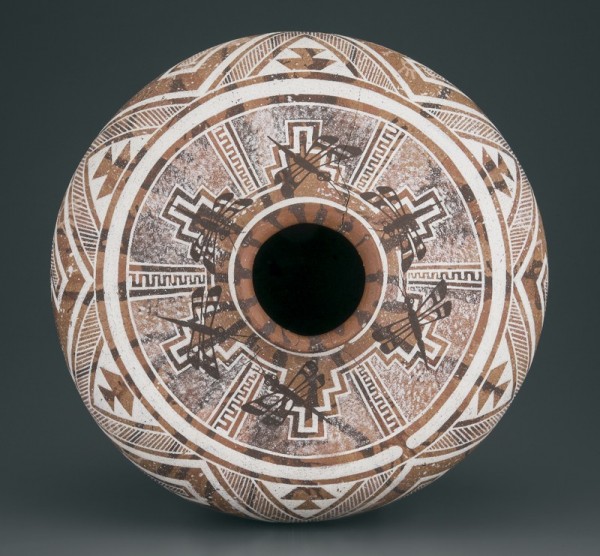
Jar, Randy Nahohai, Pueblo of Zuni, New Mexico, 1991. Earthenware. D. 14". (Photo, Gavin Ashworth.) This view of the top shows six painted terraces, cloud motifs, and dragonflies.

Rainbird sketches, Randy Nahohai, 1985. Graphite, ink, and colored pencil on paper. 14" x 10 3/4". (Courtesy, Randy Nahohai.) Randy drew the more conventional Rainbird patterns at upper left before painting the 1985 jar illustrated in fig. 60.

Rainbird jars, Randy Nahohai, Pueblo of Zuni, New Mexico, 1999 (left), 2007 (right). Earthenware. H. 8 1/2", 7 3/8". (Photo, Gavin Ashworth.)
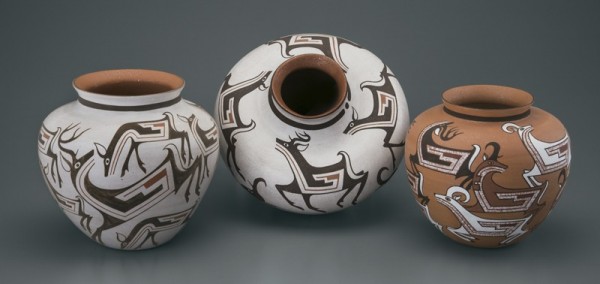
Jars decorated with deer, antelope, and rams, Randy Nahohai, Pueblo of Zuni, New Mexico, 2006 (left), 1996 (center), 2010 (right). Earthenware. H. 6 7/8", 6 5/8", 6 3/8". (Photo, Gavin Ashworth.) Micaceous orange slip is hand-rubbed inside the lip of all three and on the outside of the jar on the far right. Flute players are painted on the lower body of the middle jar.
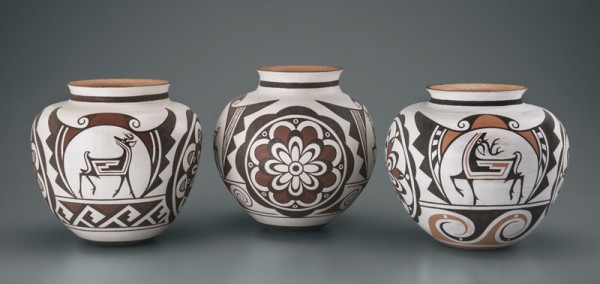
Jars decorated with Deer in His House motifs, Randy Nahohai, Pueblo of Zuni, New Mexico, 1999 (left and center), 2002 (right). Earthenware. H. 7 3/8", 7 5/8", 7 1/4". (Photo, Gavin Ashworth.) Micaceous orange slip is hand-rubbed inside the lips and some mica is included in the unsmoothed brown.

Jar decorated with Corn Maiden scenes, Randy Nahohai, Pueblo of Zuni, New Mexico, 1994. Earthenware. H. 12 1/8". (Courtesy, Denver Art Museum.)

Cornmeal bowl, Rowena Him, Pueblo of Zuni, New Mexico, 1987. Earthenware. H. 4 3/4". (Photo, Gavin Ashworth.)
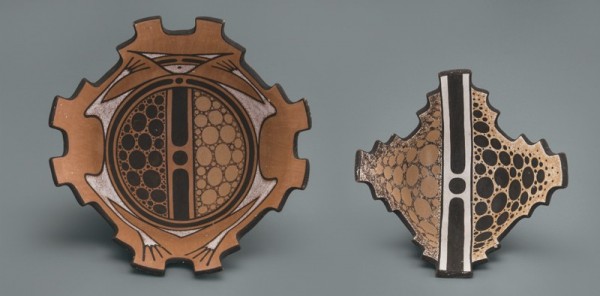
Cornmeal bowls decorated with frog (left) and frogless (right) pattern, Randy Nahohai, Pueblo of Zuni, New Mexico, 1992. Earthenware. W. 10 1/2", 8". (Photo, Gavin Ashworth.)
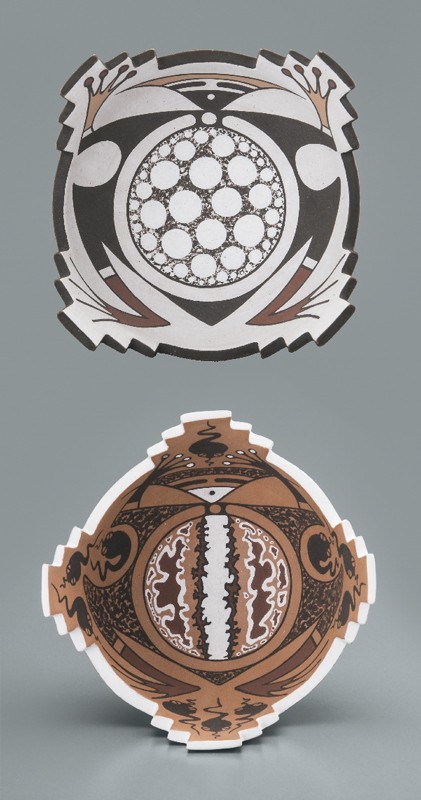
Cornmeal bowls decorated with frog figures, Randy Nahohai, Pueblo of Zuni, New Mexico, 2009 (top), 2011 (bottom). Earthenware. W. 6 1/2", 6 3/8". (Photo, Gavin Ashworth.)
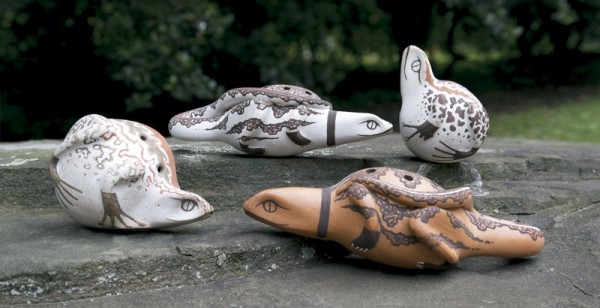
Frog and lizard flutes, 2004 (left), 2007 (center), 2011 (right). Earthenware. L. 7", 3 1/2", 7". (Photo, Edward Chappell.)

Frog jars, Randy Nahohai, Pueblo of Zuni, New Mexico, 2002 (left), 2006 (center), 2009 (right). Earthenware. H. 5 1/2", 6 1/2", 5 7/8". (Photo, Gavin Ashworth.) Micaceous orange slip covers the outside and extends inside the lip.

Jar, “Frog on Maize,” Randy Nahohai, Pueblo of Zuni, New Mexico, 2008. Earthenware. H. 6 1/4", D. 7 1/8". (Photo, Gavin Ashworth.)
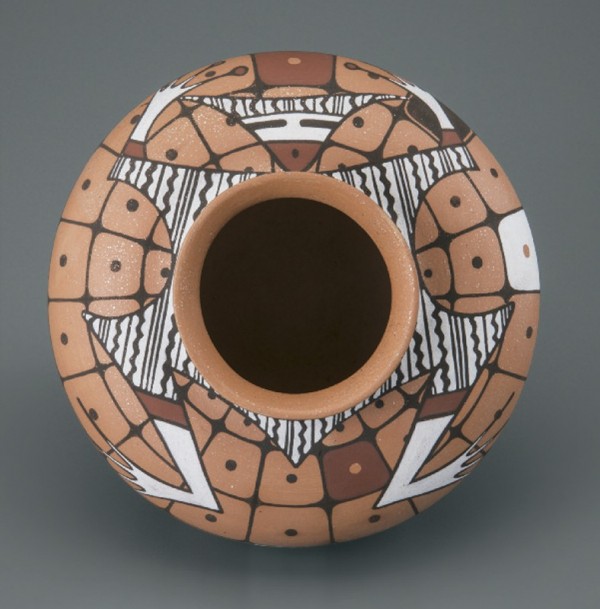
Top view of the jar illustrated in fig. 119. (Photo, Gavin Ashworth.)

Jars decorated with cloud patterns, Randy Nahohai, Pueblo of Zuni, New Mexico, 1999 (left), 2012 (center), 2009 (right). Earthenware. H. 5", D. 8 1/4", H. 5". (Photo, Gavin Ashworth.)

Tularosa Star, the center jar illustrated in fig. 121. H. 7 7/8". (Photo, Gavin Ashworth.)
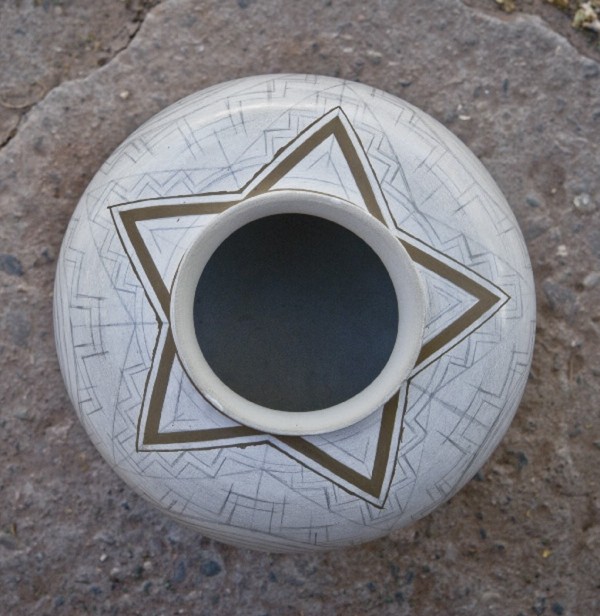
Top view of the center jar illustrated in fig. 121, showing penciled guidelines. (Photo, Edward Chappell.)

Dragonfly motif on a potsherd from the surface at the Hawikuh site, seventeenth century. (Photo, Edward Chappell.)

Cornmeal bowls with Milky Way decoration, Randy Nahohai, Pueblo of Zuni, New Mexico, 2002 (top) and 2009 (bottom). Earthenware. W. 7 1/8" and 8 3/4". (Photo, Edward Chappell.)
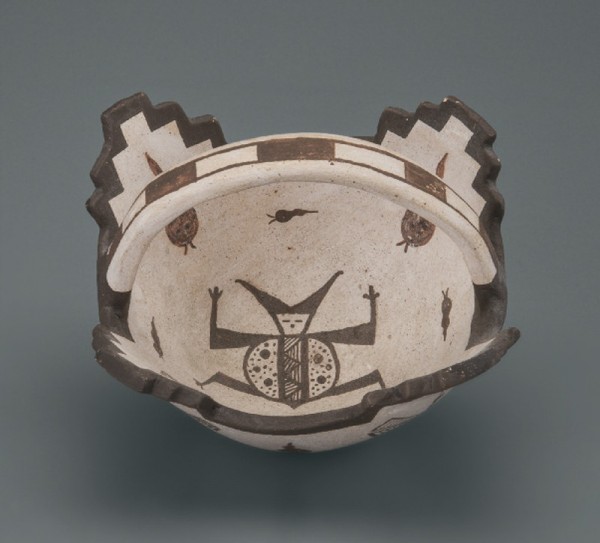
Cornmeal bowl, Josephine Nahohai, painted by her grandson Dion Nahohai, Pueblo of Zuni, New Mexico, 1989–1992. Earthenware. W. 6 1/2". (Photo, Gavin Ashworth.)
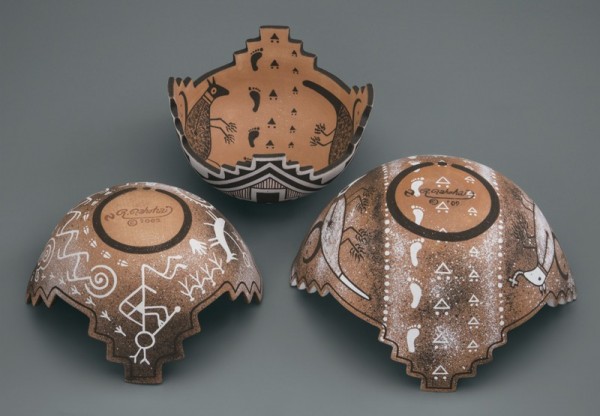
Cornmeal bowls, Randy Nahohai, Pueblo of Zuni, New Mexico, 2002 (left), 2013 (center), 2009 (right). Earthenware. D. 7 1/8", 8 3/4", 6 3/4". (Photo, Gavin Ashworth.)
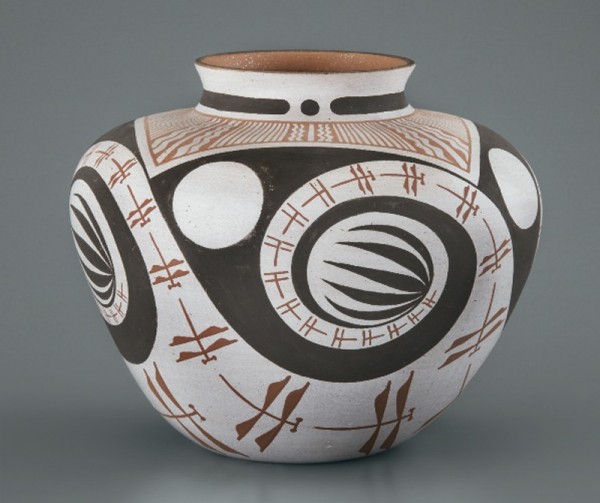
Jar, Randy Nahohai, Pueblo of Zuni, New Mexico, 2008. Earthenware. H. 5 3/4". (Photo, Gavin Ashworth.)

Bowls with sun spirals, Randy Nahohai, Pueblo of Zuni, New Mexico, 1999 (top), 2006 (middle), 2007 (bottom). Earthenware. D. 4 1/4", W. 9 3/8", W. 10 3/4". (Photo, Gavin Ashworth.)
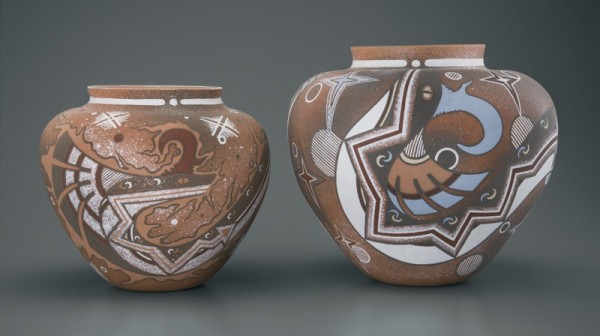
Jars with Kolowisi, Randy Nahohai, Pueblo of Zuni, New Mexico, 2006 (left), 2008 (right). Earthenware. H. 7 1/2", 9 1/8". (Photo, Gavin Ashworth.)
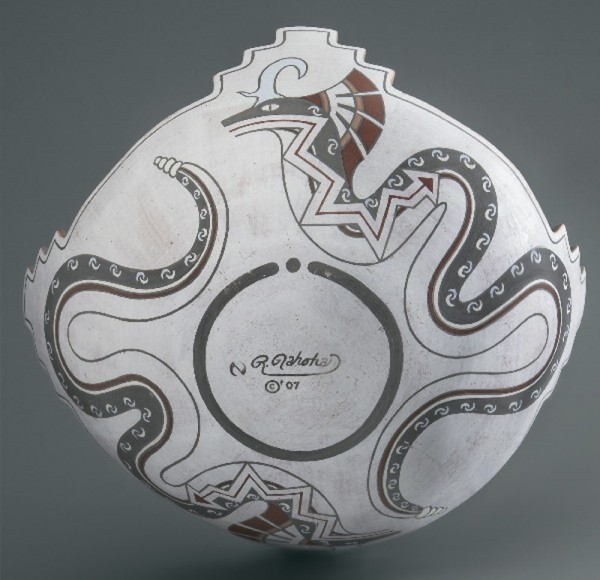
Bowl, Randy Nahohai, Pueblo of Zuni, New Mexico, 2007. Earthenware. D. 10 3/4". (Photo, Gavin Ashworth.)

Jar and bowl, Randy Nahohai, Pueblo of Zuni, New Mexico, 2011 (left), 2013 (right). Earthenware. H. 8", W. 7 1/8". (Photo, Gavin Ashworth.)
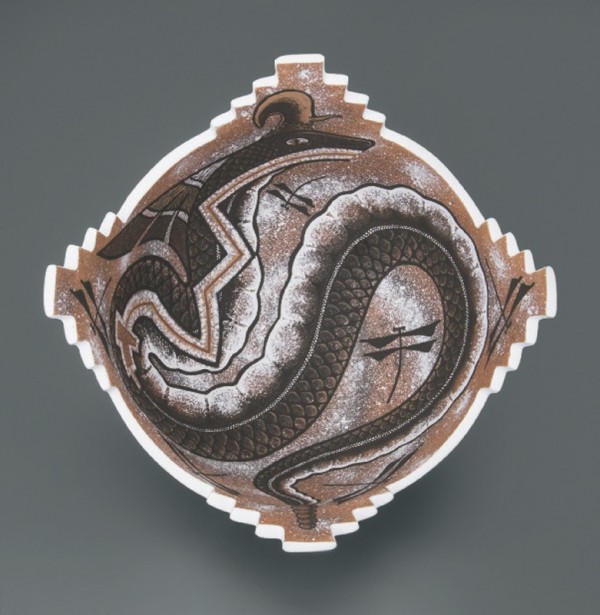
Bowl, Randy Nahohai, Pueblo of Zuni, New Mexico, 2014. Earthenware. W. 10". (Photo, Gavin Ashworth.)
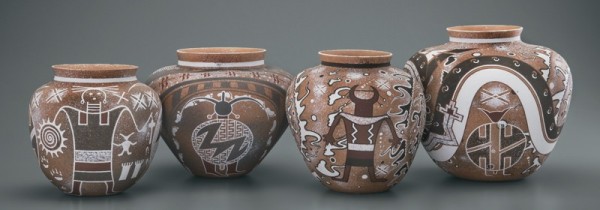
Jars decorated with motifs drawn from rock art figures, Randy Nahohai, Pueblo of Zuni, New Mexico, (left to right) 2004, 2007, 2011, 2011. Earthenware. H. 6 3/4", 6 7/8", 7", 8". (Photo, Gavin Ashworth.)
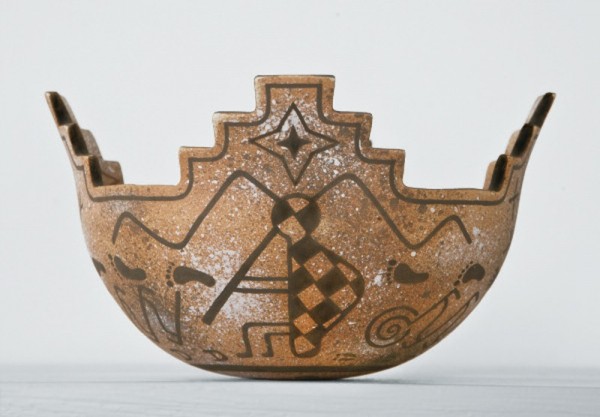
Cornmeal bowl decorated with rock art motifs, Randy Nahohai, Pueblo of Zuni, New Mexico, 2014. Earthenware. W. 12". (Photo, Edward Chappell.)

Cornmeal bowl made for Darrell and Shaun Tsabetsaye, Randy Nahohai, Pueblo of Zuni, New Mexico, 2012. Earthenware. W. approx. 12". (Photo, Shaun Tsabetsaye.)
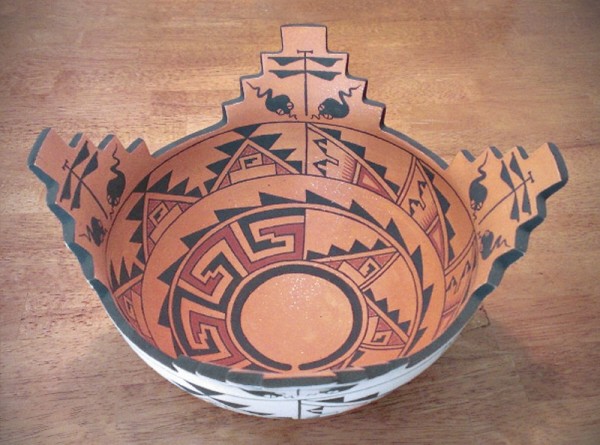
Medicine bowl, Randy Nahohai, Pueblo of Zuni, New Mexico, 2012. Earthenware. W. 12". (Photo, Shaun Tsabetsaye.)
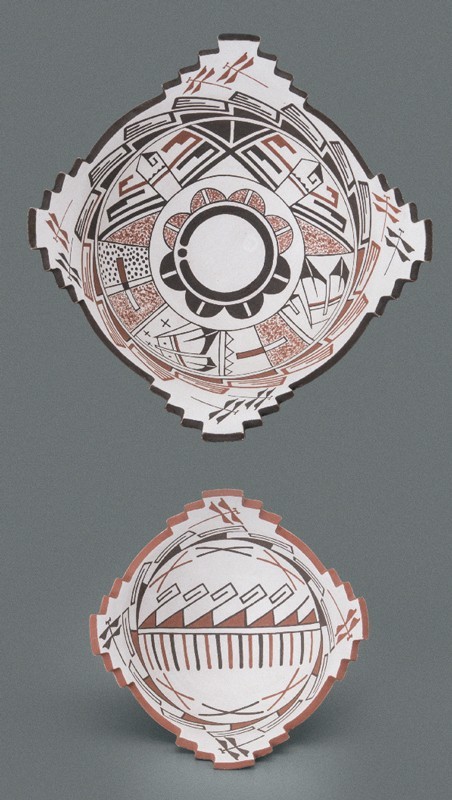
Cornmeal bowls, Randy Nahohai, Pueblo of Zuni, New Mexico, 2012 (top), 2013 (bottom). Earthenware. W. 11 3/8", 8 3/8". (Photo, Gavin Ashworth.)
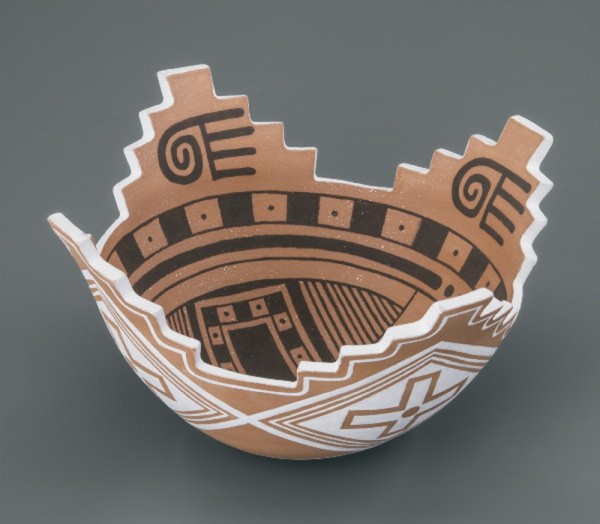
Cornmeal bowl decorated with motifs of Pinnawa Glaze-on-white bowls from 1350–1450, Randy Nahohai, Pueblo of Zuni, New Mexico, 2013. Earthenware. D. 9 1/2". (Photo, Gavin Ashworth.)
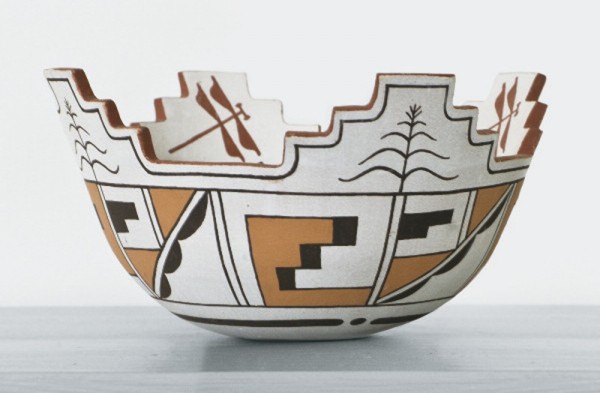
Cornmeal bowl, Randy Nahohai, Pueblo of Zuni, New Mexico, 2013. Earthenware. W. 8 3/8". (Photo, Edward Chappell.)

Cornmeal bowl, Prayers and Messengers, Randy Nahohai, Pueblo of Zuni, New Mexico, 2015. Earthenware. D. 9 3/4". (Photo, Edward Chappell.)
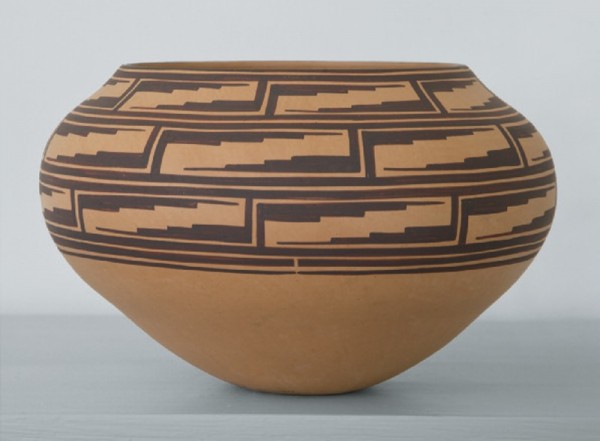
Jar, Anderson Peynetsa, Pueblo of Zuni, New Mexico, 1989. Earthenware. H. 5 3/8". (Photo, Edward Chappell.)

Jar, Alan E. Lasilou, New Mexico, ca. 2007. Earthenware. H. 5 7/8". (Photo, Edward Chappell.)
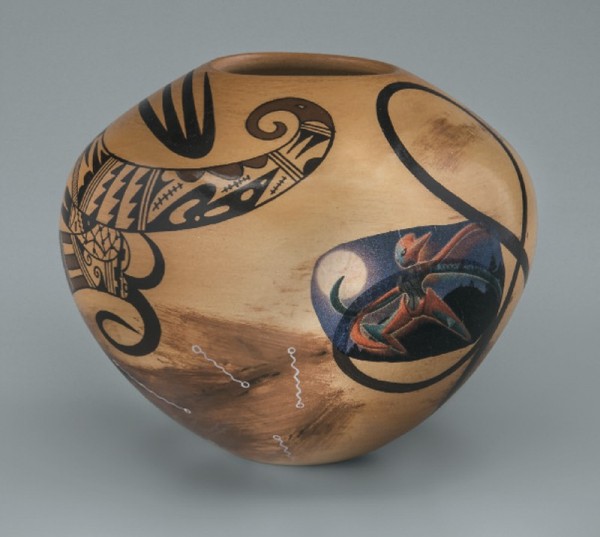
Jar with painted and decal decoration, Les Namingha, Santa Fe, New Mexico, 2010–2011. Earthenware. H. 5". (Photo, Gavin Ashworth)
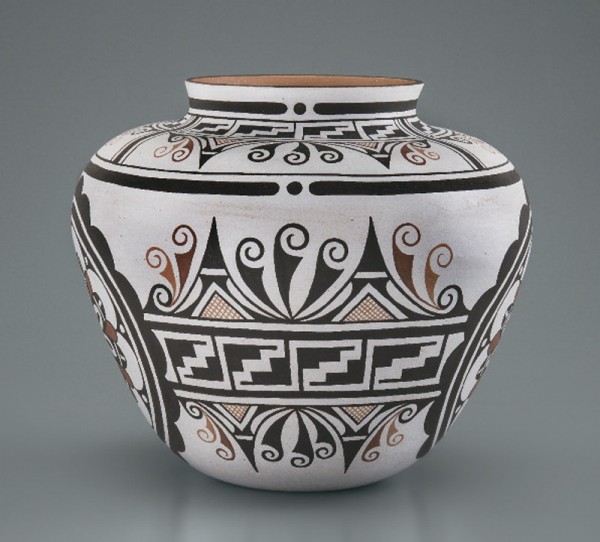
Jar, Randy Nahohai, Pueblo of Zuni, New Mexico, 2013. Earthenware. H. 8 3/8". (Photo, Gavin Ashworth.)
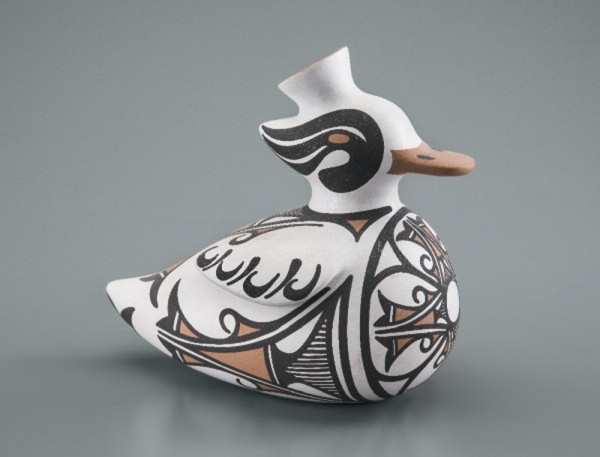
Duck vessel, Rowena Him, Pueblo of Zuni, New Mexico, 1998. Earthenware. L. 7 3/4". (Photo, Gavin Ashworth.)

Frog vessel, Rowena Him, Pueblo of Zuni, New Mexico, 1996. Earthenware. L. 6". (Photo, Gavin Ashworth.)
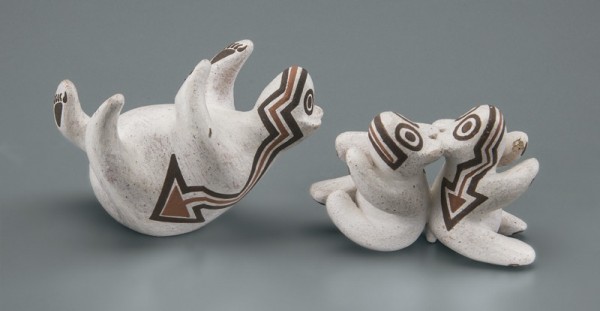
Pottery bears, Rowena Him, Pueblo of Zuni, New Mexico, 1988–1992. Earthenware. L. 2 3/4" (left), 2 3/8" (right). (Photo, Gavin Ashworth.)
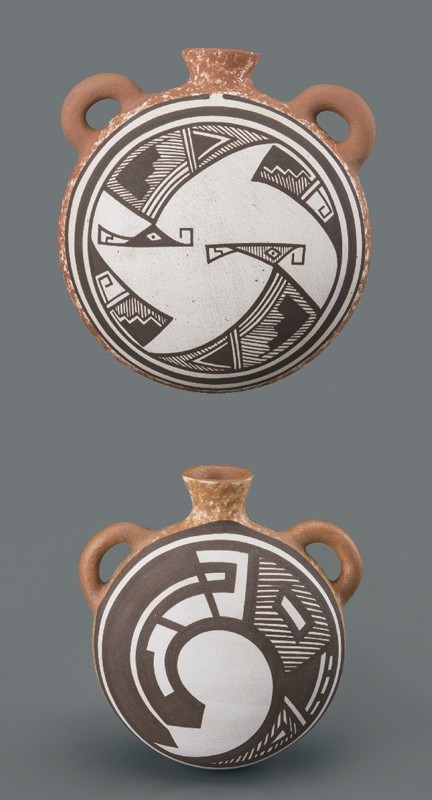
Canteens, Rowena Him, Pueblo of Zuni, New Mexico, 1993 (top), 1998 (bottom). Earthenware. H. 7 1/4", 6 1/2". (Photo, Gavin Ashworth.)

Bowl, Rowena Him, Pueblo of Zuni, New Mexico, 2005. Earthenware. D. 6 1/4". (Photo, Edward Chappell.)

Jar, Rowena Him, Pueblo of Zuni, New Mexico, 2008. Earthenware. D. 7 7/8". (Photo, Gavin Ashworth.)
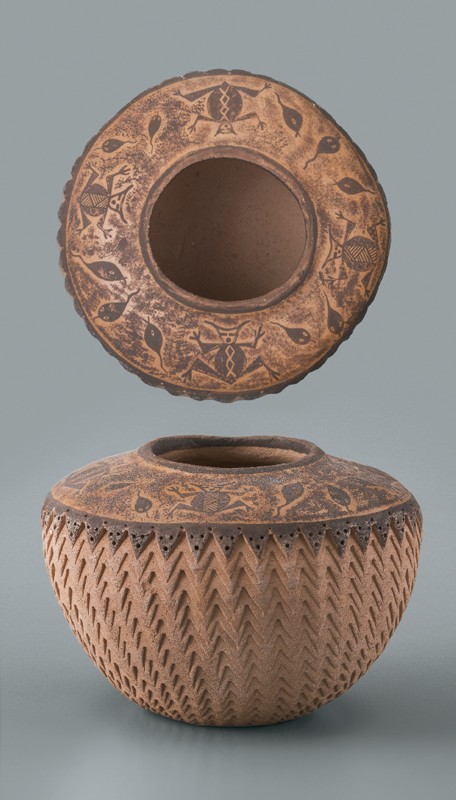
Jar, Josephine and Milford Nahohai, Pueblo of Zuni, New Mexico, ca. 1990. Earthenware. D. 4 7/8". (Photo, Gavin Ashworth.)
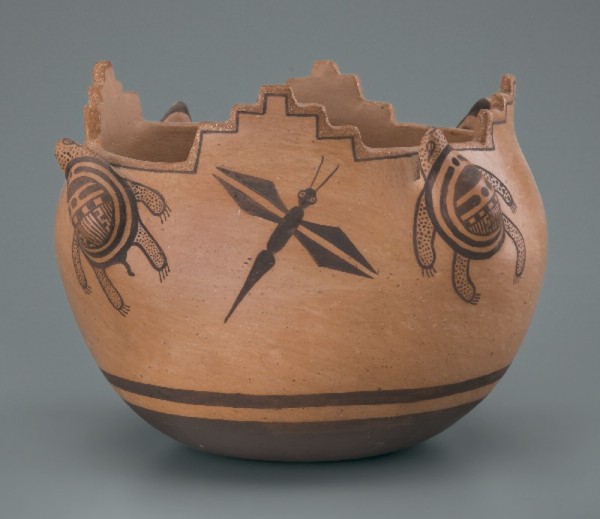
Cornmeal bowl, Josephine and Milford Nahohai, Pueblo of Zuni, New Mexico, 1994. Earthenware. D. 7 7/8". (Photo, Gavin Ashworth.)
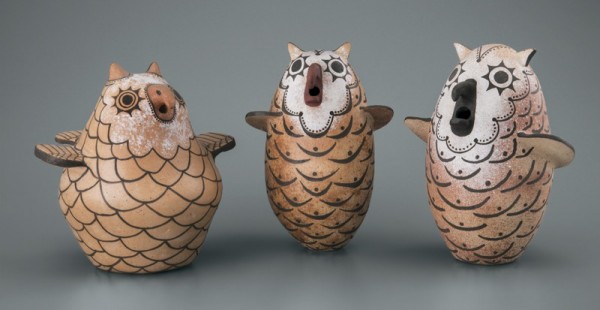
Owls, Josephine and Milford Nahohai, Pueblo of Zuni, New Mexico, 1998 (left), 2000 (center), 2001 (right). Earthenware. H. 6 1/8", 6 1/2", 6 1/2". (Photo, Gavin Ashworth.)
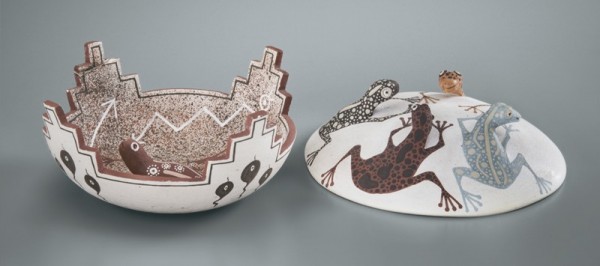
Cornmeal bowl and incense burner, Milford Nahohai, Pueblo of Zuni, New Mexico, 2002 (corn bowl) and 2010 (incense burner). Earthenware. W. 5 7/8", D. 6", respectively. (Photo, Gavin Ashworth.)
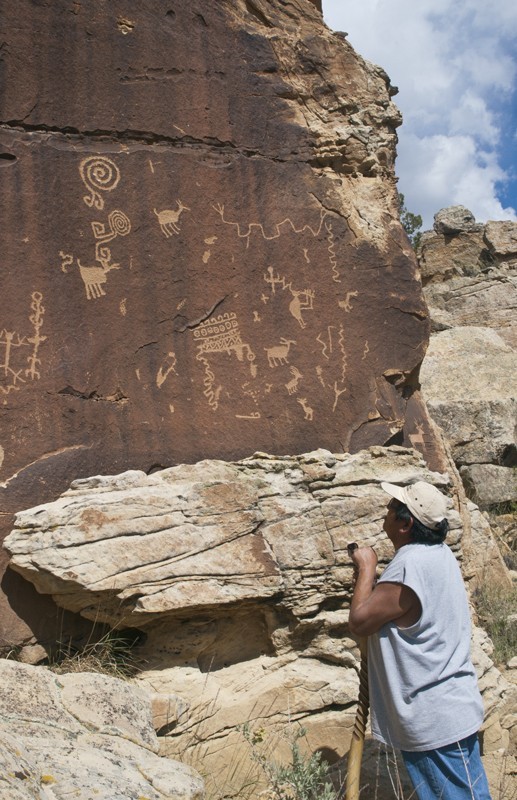
Milford Nahohai, at Village of the Great Kivas, 2011, who is particularly interested in spirals with pairs of outer scrolls, as seen at upper left. (Photo, Edward Chappell.)

Parrot bowls. Rowena Him, Pueblo of Zuni, New Mexico, 1995 (top), 2000 (second). Earthenware. D. 5 1/2", 7". Milford Nahohai, Pueblo of Zuni, New Mexico, 2004 (third), 2010 (bottom). Earthenware. D. 6 3/8", 6 1/2". (Photo, Gavin Ashworth.)

Kechipawan parrot bowl, Milford Nahohai, Pueblo of Zuni, New Mexico, 2012. Earthenware. D. 6 1/2". (Photo, Gavin Ashworth.)
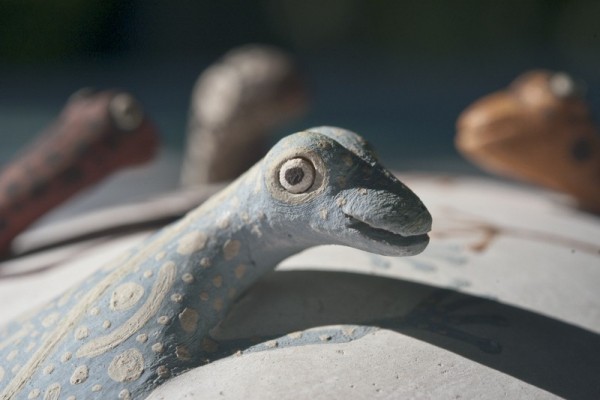
Detail of incense burner with colored frogs illustrated in fig. 155, Milford Nahohai, 2010. (Photo, Edward Chappell.)
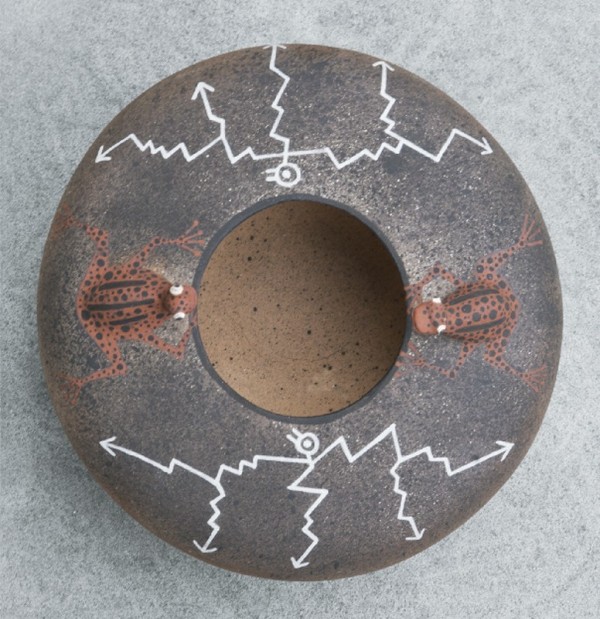
Jar, Milford and Jaycee Nahohai, Pueblo of Zuni, New Mexico, 2013–2014. Earthenware. D. 7 1/2". (Photo, Edward Chappell.)
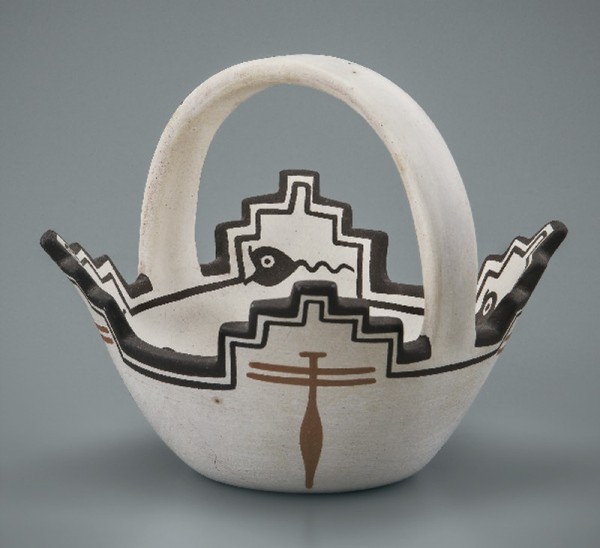
Cornmeal bowl, Eileen Yatsattie, Pueblo of Zuni, New Mexico, June 1997. Earthenware. W. 5 7/8". (Photo, Gavin Ashworth.)
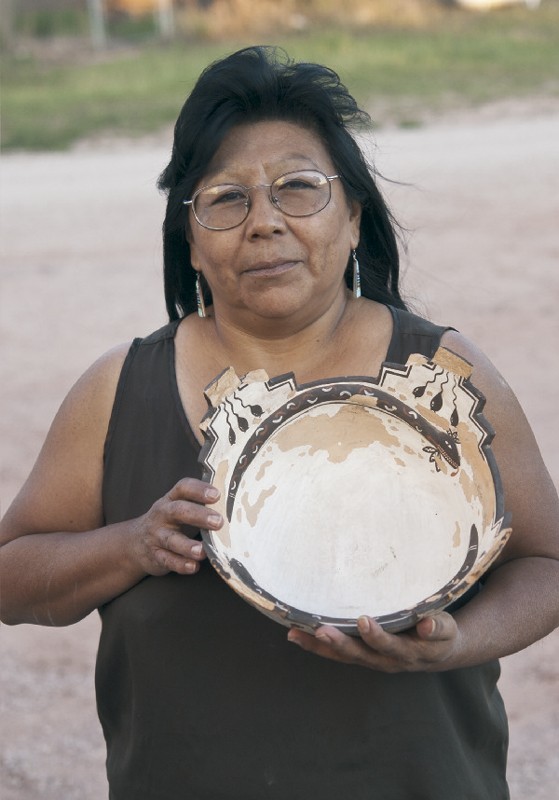
Eileen Yatsattie with her traditionally made second bowl for Rain Priests. (Photo, Edward Chappell.)
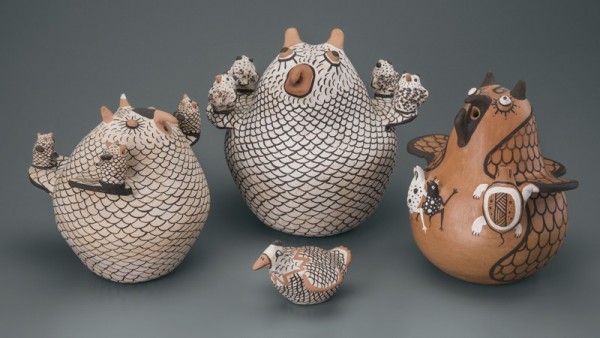
Owls, Pueblo of Zuni, New Mexico, 1989. Earthenware. Left: Shaped and painted by Irma Nahohai. H. 6 1/2". Back center: Shaped by Josephine Nahohai and painted by herself and Irma. H. 7 7/8". Right: Shaped by Josephine and painted by Maynard Nahohai. H. 7 3/8". Chicken figure (front center) by Josephine and painted by Maynard, ca. 1990. W. 4 1/4". (Photo, Gavin Ashworth.)
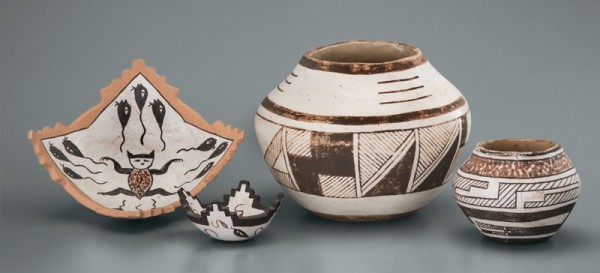
Cornmeal bowls and jars, Josephine Nahohai, painted by Maynard Nahohai, Pueblo of Zuni, New Mexico, ca. 1990. Earthenware. H. of large jar 6 1/4", W. of small bowl 3 7/8". (Photo, Gavin Ashworth.)
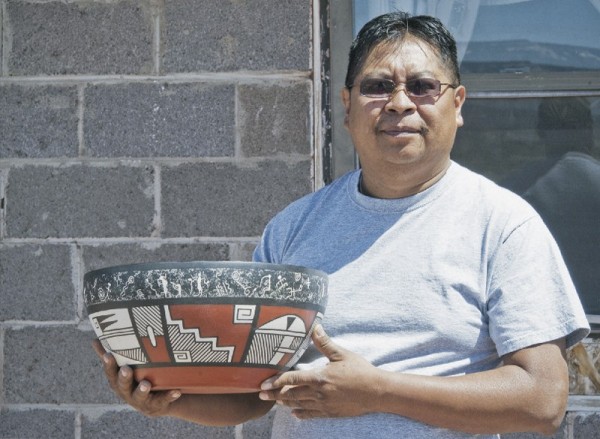
Maynard Nahohai with his painted and sgraffito-decorated greenware stew bowl for Long Horn House, 2008. (Photo, Edward Chappell.)
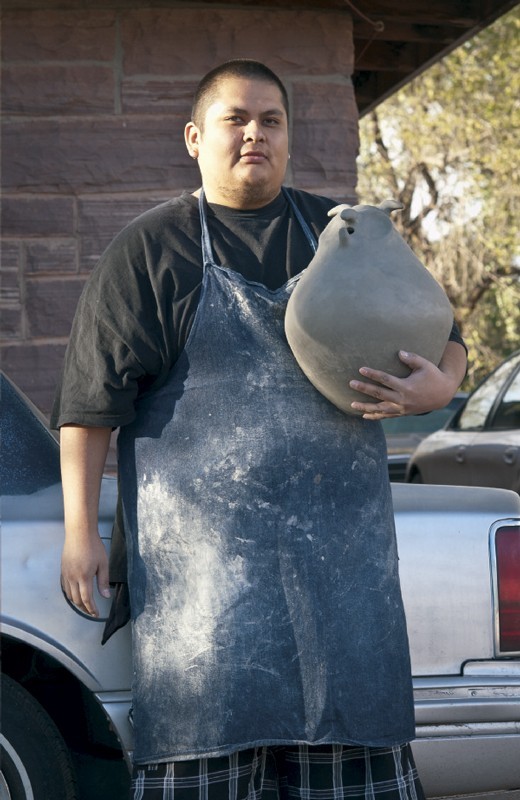
Jaycee Nahohai with his first large owl, 2012. (Photo, Edward Chappell.)
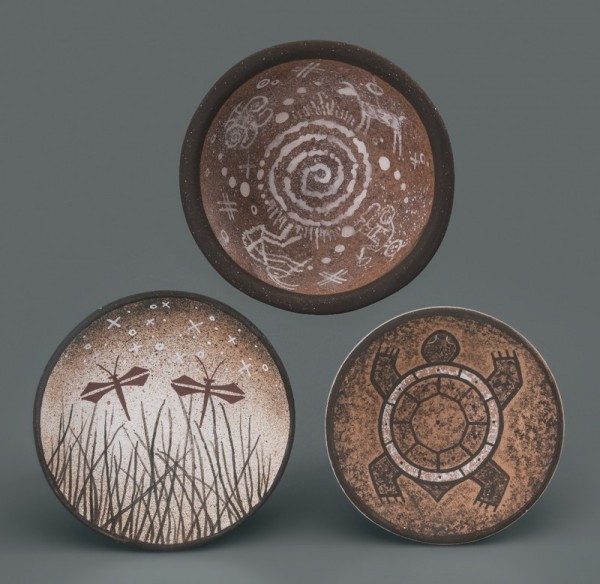
Small bowls, Jaycee Nahohai, Pueblo of Zuni, New Mexico, 2004 (bottom left), 2009 (top), 2010 (bottom right). Earthenware. D. 5 1/4", 5 1/4", 4 7/8". (Photo, Gavin Ashworth.)

Jar, Randy and Jaycee Nahohai, Pueblo of Zuni, New Mexico, 2007. Earthenware. H. 5 1/4". (Photo, Gavin Ashworth.)

Puzzle jar, Jaycee Nahohai, Pueblo of Zuni, New Mexico, 2013. Earthenware. H. 7 1/4". (Photo, Gavin Ashworth.)

Pitchers, Jaycee Nahohai, Pueblo of Zuni, New Mexico, 2014. Earthenware. D. 8 5/8" (left), 7 5/8" (right). (Photo, Gavin Ashworth.)
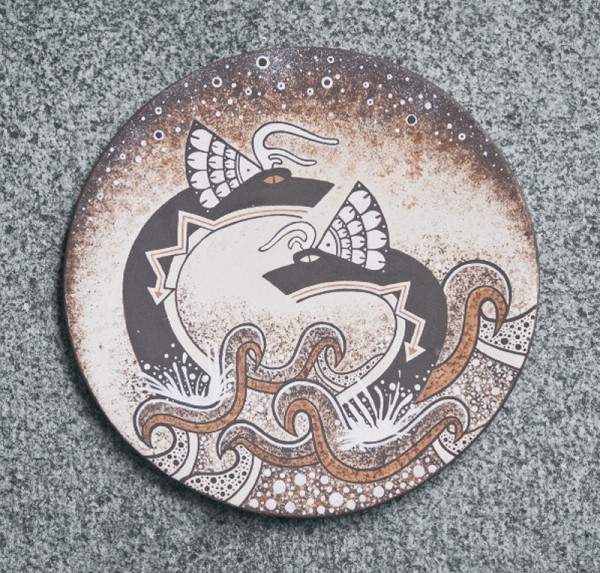
Kolowisi plate, Jaycee Nahohai, Pueblo of Zuni, New Mexico, 2011. Earthenware. D. 10 5/8". (Photo, Edward Chappell.)
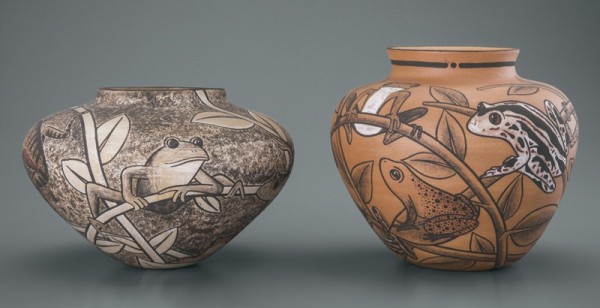
Frog jars, Jaycee Nahohai, (right) shaped by Randy Nahohai, Pueblo of Zuni, New Mexico, 2012. Earthenware. H. 6", 7 1/4". (Photo, Gavin Ashworth.)
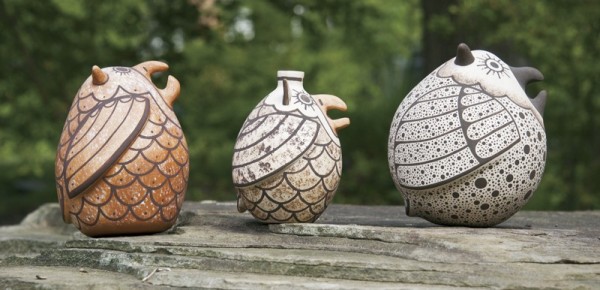
Owls, Jaycee Nahohai, Pueblo of Zuni, New Mexico, 2009 (left), 2010 (center), 2011 (right). Earthenware. H. 5 1/2", 4 7/8", 5 3/4". (Photo, Edward Chappell.)

Owls, Jaycee Nahohai, Pueblo of Zuni, New Mexico, 2013 (left) and 2014 (right). Earthenware. H. 7 1/8", 7 3/4". (Photo, Gavin Ashworth.)
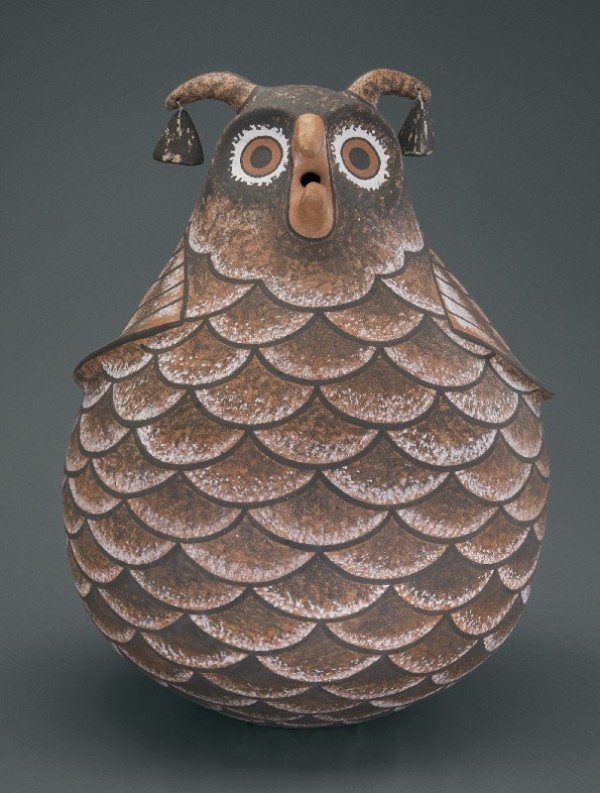
First large owl to survive, Jaycee Nahohai, Pueblo of Zuni, New Mexico, 2013. Earthenware. H. 15 1/2". (Photo, Gavin Ashworth.)

Jaycee Nahohai shaping a jar lid on a banding wheel, 2015. (Photo, Edward Chappell.)
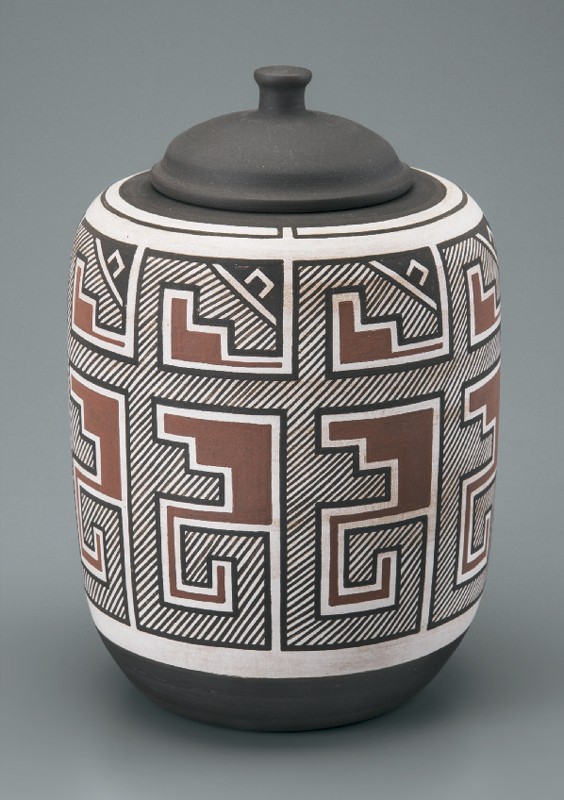
Lidded jar, Jaycee Nahohai, Pueblo of Zuni, New Mexico, 2014. Earthenware. H. 9 7/8". (Photo, Gavin Ashworth.)
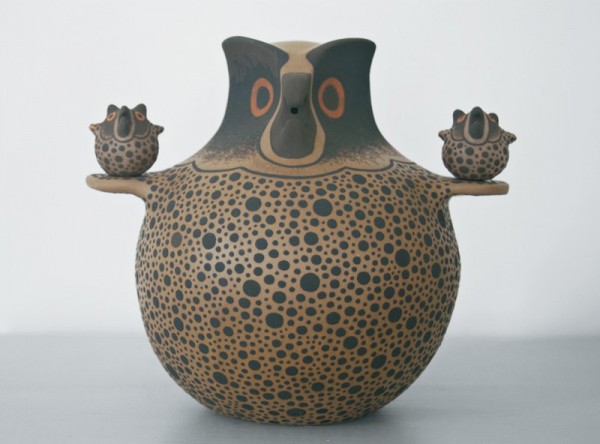
Storyteller owl, Jaycee Nahohai and Rowena Him, Pueblo of Zuni, New Mexico, 2014. Earthenware. H. 7". (Photo, Edward Chappell.)
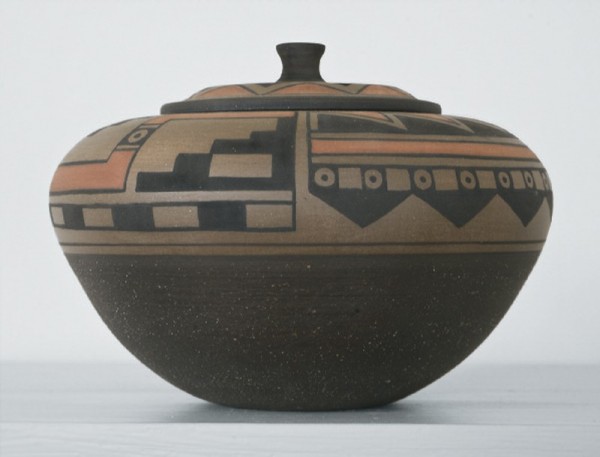
Lidded jar, Jaycee Nahohai, Pueblo of Zuni, New Mexico, 2014. Earthenware. D. 12". (Photo, Edward Chappell.)

Lidded jar, shaped by Rowena Him and Jaycee Nahohai, painted by Jaycee Nahohai, 2014. Earthenware. H. 4 3/4". (Photo, Edward Chappell.)
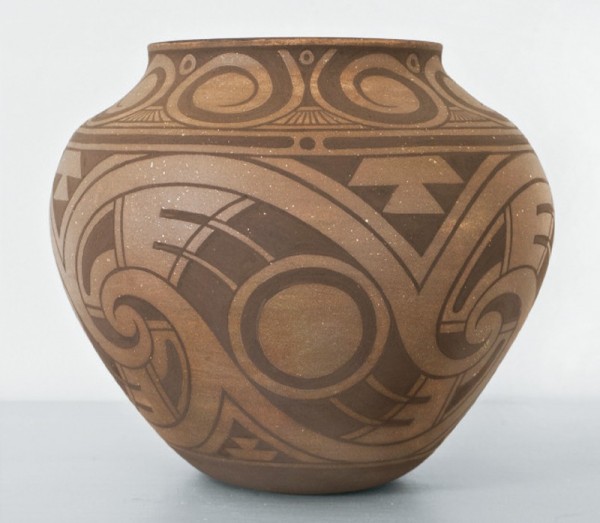
Jar, Randy Nahohai, Pueblo of Zuni, New Mexico, 2014. Earthenware. H. 8 1/4". (Photo, Edward Chappell.)

Glaze-painted pottery from surface at Hawikuh. (Photo, Paul Diehl.)
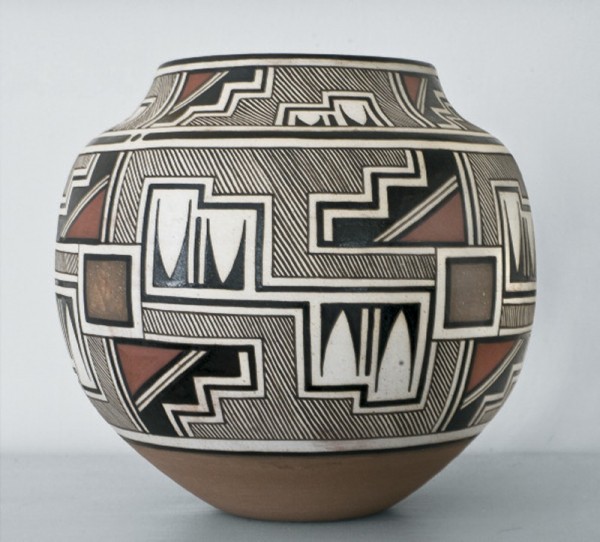
Glaze-painted jar, Jaycee Nahohai, Pueblo of Zuni, New Mexico, 2015. Earthenware. H. 8 3/8". (Photo, Edward Chappell.)
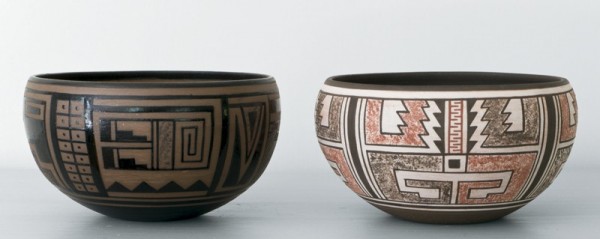
Offering bowls, Jaycee Nahohai, Pueblo of Zuni, New Mexico, 2015. Earthenware. D. 5 1/2". (Photo, Edward Chappell.) The bowl on the left is glaze-painted.

Cornmeal bowl, Milford Nahohai, Pueblo of Zuni, New Mexico, 2004. Earthenware. W. 6". (Photo, Edward Chappell.) This bowl represents his brief influence from Australia, which he had visited.
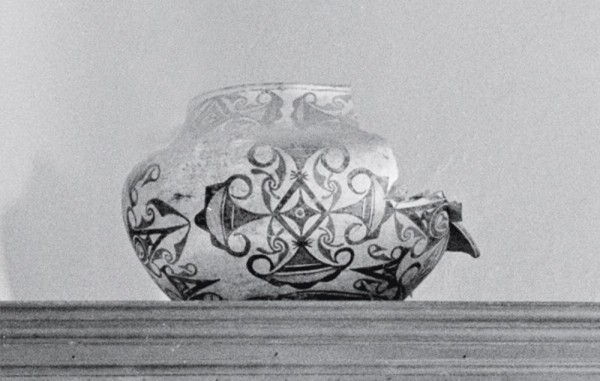
Zuni water jar, 1880–1895, brought by George Coleman from Gallup, New Mexico, to Williamsburg, Virginia. (Courtesy, Colonial Williamsburg Foundation; photo, Willie Graham.)
Bookshelves overflow with publications about Native American pottery from the southwestern United States. A few extol the work of the region’s celebrity potters. More, including some of the earliest and most comprehensive, are broadly conceived cultural studies that use archaeological collections to trace the movements of ancient populations, developments in their technologies, and the reach of their trading networks. The following study of potters in the modern Zuni Pueblo draws connections with this larger, older tradition of scholarship. It does something else besides. By working with a contemporary family of Zuni potters—the Nahohais—I have had the privilege to observe how elements of a larger culture take shape piece by piece, pot by pot, brushstroke by brushstroke, influenced by values shared by parents, children, and kin as well as by choices, sometimes idiosyncratic and creative, made by the artists themselves when they press their thumbs into a lump of clay or dip a brush into a dish of paint. Culture, magnified by biography, comes alive. But living traditions come from the past. So that first.
Historical Context
Early in the twentieth century Zuni potters found their rhythm of life and structures of commerce altered by the advent of the railroad. Soon after the trains started arriving, these potters—virtually all women—began making the forty-mile trek by wagon from their village on high, rocky land just west of the Continental Divide to the scruffy mining and rail town of Gallup, New Mexico, east of the Arizona line and 150 miles west of the Rio Grande.[1] For them and other Native people, Gallup had grown to be both a benefit and a curse, a source of modest income and a center of unwanted foreign intrusion.
The A:shiwi potters, known to outsiders as Zunis, carefully packed their handsome newly made wares, along with a few old vessels, for the rough ride to the rail station. There, they briefly encountered buyers from another world, who communicated awkwardly in a different language but traveled with sufficient cash to spend on large souvenirs.
One of these self-confident foreign customers in the 1920s was George Coleman, a genteel Virginian who lived with his family in the rambling Williamsburg house his great-grandfather had built to overlook a market square in the old Tidewater town. Coleman treasured those local credentials, but he made his livelihood as Virginia’s commissioner of highways, and he sometimes traveled far, occasionally on the transcontinental railway.
Coleman stepped off the Atchison, Topeka and Santa Fe train in Gallup and joined others gesturing and talking among the Zuni women alongside the tracks until he had purchased three sizable water jars with thin, hand-coiled walls and rich ornamental painting. He paid little, probably about five dollars, and packed the jars so poorly that all three broke on the long ride back to Virginia. Still, such southwestern pottery was in fashion among well-traveled Americans in the 1920s, so his family glued the oldest and best jar back together and set it on the dining room cupboard (fig. 1). It remained there for more than half a century, a dramatic piece of exotica in a room filled with family portraits, old silver, and food prepared by generations of household servants.[2]
Coleman’s experience exemplifies much of the popular history of Native American art in the early twentieth century, particularly Pueblo pottery. As the story goes, touristic buying and art collecting replaced traditional use of family-made ethnographic objects, especially ceramics, because cheaply manufactured vessels sold to Indians made local production unnecessary in the late nineteenth and early twentieth centuries. “Too much Tupperware,” potter Randy Nahohai (fig. 2) jokes, “was why Zuni pottery almost died out,” referring to the pattern of replacement by industrial products. It was a lucky alignment of developments that educated Arts and Crafts taste for handmade, locally or ethnically distinctive decorative arts rose to prominence as functional Native use declined.[3]
Museum professionals and anthropologists cultivated this popular interest in the name of science and education. Frank Hamilton Cushing and Matilda Coxe Stevenson, for example, focused primarily on Zuni as a supreme example of a distinctive Native community. Cushing and Stevenson both began publishing material in the 1880s that introduced Zuni to readers throughout the country and in Europe. They expressed paternalistic affection, and Cushing fought strenuously for Zuni land rights, while both scholars exoticized the people. Cushing in particular wrote popular accounts—such as the series “My Adventures in Zuñi,” published in Century Magazine—that were as much travel writing as ethnography and served as financial and political support for his scholarship (fig. 3).[4]
Cushing and Stevenson arrived at Zuni in 1879 as part of the first organized expedition mounted by the nascent Bureau of Ethnology (hereafter BAE, although it did not officially become the Bureau of American Ethnology until 1897) and led by Colonel James Stevenson, Matilda Stevenson’s husband. John Wesley Powell had visited Zuni and the Hopi mesas in 1873, and as bureau director he initiated this and subsequent expeditions with the purpose of collecting material from the pueblos before it disappeared into the hands of “visitors and speculators.” The Stevensons acquired vast quantities, sending some five thousand Zuni pottery objects to the BAE in 1879 and on two subsequent visits, at a time when the total Zuni population was less than two thousand.[5] The railroad made such large-scale and rapid transfer possible.
Cushing, too, was involved in the acquisition of Zuni objects for museums as far away as Germany, as European as well as North American museums vied for Native American objects from what they viewed as a rapidly diminishing pool of goods.[6] But the ethnologists’ aim was broader than mass consumption of picturesque ceramics and other artifacts. Stevenson, Cushing, and the BAE were motivated and directed by a newly focused evolutionary view of human history developed by Lewis Henry Morgan that cast such tribes in an especially important light. In 1877, inspired by Charles Darwin’s theory of evolution and natural selection, Morgan advanced the paradigm that all human progress developed through comparable stages, from “Lower Savagery” through “Upper Barbarism” toward “Civilization,” and that study of non-industrialized societies could help explicate human history in general.[7]
Communities like the Pueblos of New Mexico and Arizona, Morgan’s apostles argued, could stand in proxy for the stages through which Europeans had developed long ago. Study of such peoples was a pressing need because expansion of industrialized populations, like those of English-speaking America, severely threatened the purity and even survival of Native culture.[8] The BAE fieldworkers, then, were involved in what is now called “salvage ethnography,” out to harvest all the information and material culture that embodied the character of the people.[9]
Physical art forms, as well as spiritual beliefs and their ceremonial systems, were high on the agenda for recording. Zuni art and belief systems were distinctive among the Pueblos and both were seen as having great potential as evidence linking living Pueblo people with the predecessors who had left dramatic archaeological remains throughout much of the Southwest. The competitive Stevenson and Cushing viewed comparative study of Pueblo pottery as offering graspable links in a chain leading back into North American prehistory.[10] There was a certain nationalistic mandate to the quest, establishing an impressive antiquity for the country. As photographer Edward Curtis wrote two decades later, “You, who say there is nothing old in our country, turn your eyes for one year from Europe and go to the land of an ancient primitive civilization. The trails are rarely traveled, and you will go again” (fig. 4).[11]
Located far from cities and the Rio Grande, Zuni was seen as having a particularly complex and unaltered ceremonial culture. Cushing suggested that no ethnographic resource in North America, perhaps in the world, was richer in uncollected material than the Pueblos, and that Zuni was their “highest representative.” Religious belief, the “inner life of the Pueblos,” he argued, formed the deep framework of the people’s material life. Cushing, a rural New Yorker, slowly ingratiated himself into belief-based groups at Zuni in order to learn hidden ways, and Matilda Stevenson assertively recorded ceremonies and their accoutrements.[12] Much influenced by Cushing, Stewart Culin, prominent ethnology curator at the Brooklyn Institute of Arts and Sciences (now the Brooklyn Museum), made Zuni ceremonial materials, textiles, and pottery making the central elements in the museum’s iconic 1905 Hall of the Southwest.[13]
Such aggressive collecting and recording of religious belief and ceremonial systems created problems in a culture where control of esoteric knowledge and avoidance of intrusion on ceremony are fundamental. Practical motivations for secrecy grew as the national government increasingly imposed assimilationist schools and land distribution on Zuni and other Pueblos. In this context, past archaeological excavation at Zuni ancestral sites is now recognized as colonialism.[14] Extensive digging at the circa 1450–1680 village of Hawikuh and roughly a thousand of its graves by Frederick Hodge for the Heye Foundation in 1917–1923 increased resentment, even as it provided hard-currency jobs for Zuni men and artistic resources for later potters. That resentment has endured, with growing popular intrusion into pre-solstice Shalako ceremonies, the elaborate winter ritual that brings Zunis home to the Middle Place and ensures prosperity for the coming year.[15]
In recent decades the Pueblo of Zuni has employed its own anthropologists and archaeologists, as well as sponsored excavation in the town that contributes depth to seriation of ancestral pottery.[16] This is happening in the context of anthropologists in general working to support Pueblo interests while avoiding appropriation of sacred knowledge and objects.[17] Zuni leadership has crafted a consensus on repatriation of particular religious objects from such museums as the Smithsonian Institution and Denver Art Museum.[18] Zuni elder Octavius Seowtewa, aided by Denver anthropologist Chip Colwell, recently traveled to London, Paris, Berlin, and elsewhere to ask more recalcitrant European museums to return War God effigies taken from sacred shrines.[19] The A:shiwi A:wan Museum has successfully mediated exchanges between many of the Zunis and outsiders at the Pueblo, although there was substantial community sentiment that the museum should be located at some distance from the town.[20] There is, then, a spectrum of outlooks among Zunis regarding access to cultural information, and it is a basic responsibility of all non-Zuni visitors, myself included, not to pursue or circulate controlled spiritual knowledge.[21]
Much Zuni pottery, when closely observed, raises important questions about the principal forces that have affected its making since the era of Cushing and Stevenson. Beyond that, there is value in studying how small groups of Zunis have developed their pottery and its uses over the last half century, within the modern Pueblo world. The potters’ circle at the center of this article is a single extended family, the Nahohais, who have learned primarily from one another and by examining older pottery and anthropological publications. I focus on a principal innovator, Randy Nahohai, while seeing creativity and skillful performance in other family members: mother, siblings, wife, son, and nephews. Randy Nahohai has made his own rules while working to sustain the distinctiveness of his community, a small, culturally unified society that seeks to maintain degrees of separateness in contemporary society, especially in spiritual matters. The story suggests that the potters who looked backward most intensely are also those who pushed the art form forward most dramatically. This group of artists has both broadened the range of fine pottery produced at Zuni and cultivated popular respect, inside and outside the community.[22] By better understanding these local perspectives, we can more thoughtfully judge the values outsiders have assigned to Pueblo pottery, and more broadly to what are often called ethnic or folk arts. If the work blurs boundaries traditionally assigned to these fields, that blurriness reflects present reality and that of the future. Such categories are decreasingly relevant and useful.
This study is primarily based on conversations with the Nahohai and Kalestewa families and on observation of their work. Our discussions began at Zuni in 1987 and grew more frequent and intensive after 2007. I do not substantially address the potters who primarily learned their techniques in school, as theirs is a somewhat separate story.[23]
PART I
Zuni Polychrome
The shaping and painting of pottery were remarkably varied among the Pueblos in the nineteenth century, and none was more distinctive than Zuni pottery.[24] By then, the work of Zuni potters had evolved into a number of distinctive forms, painted in characteristic ways, which led scholars and collectors to call the work Zuni Polychrome. Rather arbitrarily, some of those authorities see Zuni Polychrome as ending about 1920.
Most visually impressive were large water jars called ollas in Spanish and tinajas in Shiwi’ma (Zuni language), according to Cushing in 1879, and kāh’-wi-nā-kä-tehl-le according to the 1883 catalog for the Smithsonian.[25] Nearly all the jars had well-defined tripartite shapes: a round body between an outward-curving neck and a narrow base shaped like a truncated cone. Photographs and a handful of early films show Zuni women filling such jars with four to six gallons of water, then balancing them on their heads to carry them from the river or spring to their house. The rich ornamental quality of the vessel distinguished its bearer, quietly shaping an identity based on the skill of the potter.[26] Conversely, the women carrying high the great jars through the Pueblo brought a visual unity to the community, like the specialized dress of Zuni dancers at ceremonies in the plazas (fig. 5).[27] Graceful movement was a challenging skill that involved climbing ladders up multiple stories and descending through hatchways, requiring a different training from that of the dancers.
Upper openings of simpler globular jars were covered with leather and used by Zuni men as drums, te/-peja, and others without bottoms were stacked, one above the other, and used as chimneys rising from the flat roofs of the town (fig. 6).[28] Smaller pottery canteens followed mammiform shapes that Cushing interpreted as having more than passing resemblance to women’s breasts.[29] Randy Nahohai calls the canteen meh-heh’doh.[30]
Potters also made bowls in simple round shapes with convex sides and straight or outwardly turned rims as vessels for preparing and serving food. Cushing, Stevenson, and recent scholars have observed three general sizes of bowls made circa 1875–1885, the smallest sometimes identified as vessels for individual food consumption, which Randy Nahohai and his son Jaycee call sa’tsa’nah.[31] Zunis ate from shared stew bowls in the late nineteenth century, and the broad vessels had ritualistic as well as functional roles when they were used to carry food to participants in religious ceremonies.[32] Jaycee calls these ma’si-ya’kya sa’weh or sa’leh.[33] The largest—more than sixteen inches in diameter—were used for bread making after the Spanish introduction of wheat. Randy characterizes the dough bowl as “like an aluminum tub” and calls it mo-tsa-ash-na-kya sa-le.[34]
Equally distinctive in shape as the great tripartite jars are smaller terraced bowls: broadly proportioned vessels with stepped sides or round bumps representing the landscape of Zuni (fig. 7). Cushing related the belief that Earth Mother brought form to the world as a great terraced bowl, and that the Zuni world remains like an offering bowl “terraced with mountains, whence rise the clouds.”[35] In English, Randy Nahohai refers to the form as “cloud bowl,” and his brother Milford calls the bowl a-wetuyaba sa’le.[36] Terraced bowls played integral roles in Zuni ceremonial life by the time Cushing and the Stevensons intruded on such scenes.[37] The general absence of terraced bowls from excavated seventeenth-century archaeological deposits indicates a post-Pueblo Revolt (1680–1692) evolution in at least some accoutrements of religious offerings and medical intercession. One wonders which contributed more to a change toward such distinctive vessel shapes: the introduction of the form through displacement of other Pueblo peoples, or the later lessening of Roman Catholic control.[38] A better understanding of when Zuni potters began making the bowls awaits more excavation in the present town.
Motifs painted on the vessels varied according to their form and function. Outsiders associating Native American motifs with names, meanings, and spiritual purpose is a long-debated exercise, one now as often attributed to cultivating sales to non-Native buyers as to actual beliefs. Early anthropologist Jesse Fewkes called it “picture writing.”[39] Romanticized explanations for design elements extend well beyond Native American material culture, as when everyday preindustrial Anglo-American building components are ascribed to religious beliefs, nautical construction, or mortgage status.[40] Pueblo pottery scholars Dwight Lanmon and Francis Harlow were especially prudent in avoiding most interpretations of meaning in their monumental study of Zuni Polychrome pottery and its origins.[41] This article takes a somewhat riskier route because it is more focused on the purposes and thoughts of contemporary makers, to the degree they are shared.[42] Cushing, Stevenson, and their successors observed that Zuni culture was so rich and its belief systems so intact that interpretations of motifs have validity, even if they vary over time and among individuals.[43] Much of that culture and its beliefs still flourish.
Into the twentieth century, too, there was a clear division between motifs used for different sorts of vessels, dependent on use. In the 1920s anthropologist Ruth Bunzel wrote that “The cleavage between household and ceremonial objects in regard to form and decoration is so complete that it is difficult to believe that two such different ceramic types belong to the same age and the same people.”[44] Motif selection, then, was not random. Drums were unornamented or painted with rattlesnakes and large mammals such as bears or mountain lions associated with the medicine society, on a plain background.[45] Terraced bowls were usually painted with depictions of frogs, tadpoles, dragonflies, sometimes butterflies, and the mythic water serpents called Kolowisi. Bunzel observed that these figures were crudely painted on a plain white field without any of “the carefully integrated structure that characterizes the household pottery.”[46] Rather, their structure was more often contextual, as the vessels took up prescribed positions in ceremonial spaces that also contained colorful altars, figural wall paintings, supplicatory floor patterns, and other objects of spiritual use. Terraces on altar posts and elements hung from chamber ceilings reflected the silhouettes of the bowls.
With encouragement and direction from Franz Boas, Bunzel came to Zuni initially to study women’s work, subscribing to the view that “society consisted of more than old men with long memories.”[47] She referred to decorated domestic vessels as household art worthy of greater care by the makers, who most often were also the users. Nineteenth-century drawings and photographs show the striking vessels in rooms of houses virtually unornamented otherwise, contrasting with ceremonial space (figs. 8, 9). Like ceremonial vessels, jars for transporting and storing water and bowls for food preparation or eating were overwhelmingly slipped with a white surface. From the nineteenth century into the twentieth, Zuni potters painted the recessed lower segment of their water jars a darker color (first orange or red, later primarily brown-black). This continued the late-eighteenth-century tradition, now called Kiapkwa Polychrome, contrasting with the application of orange paint to the unarticulated lower segment of Acoma, Laguna, and Zia Pueblo jars.[48] Zuni potters painted motifs on the upper two segments, with independent neck patterns separated from the protruding belly by one or more heavy horizontal lines.[49] Into the twentieth century such segregating lines above and below the belly were usually interrupted by a small break.[50] I call these principal horizontal lines “boundary lines.”
On these, the most publicly used vessels, potters painted the principal canvas in a number of compositions. One approach was to wrap an overall pattern around the full circumference of the belly. Another was to divide the belly into horizontal and vertical registers, which could be roughly rectangular, or an unboxed series of circles, crooks, or other motifs alternating with large rosettes, conceivably inspired by geometric rosettes common in European-American (including Hispanic) decorative arts.[51] The belly pattern often consisted of crook-and-scroll compositions, the crooks sometimes taking the form of a stylized, coiled head of a bird. Most prominently, and often copied by late-nineteenth- and twentieth-century potters at eastern Pueblos, especially Acoma, the belly was painted with depictions of deer, seen in profile, with a red arrow extending into their mouths, a convention associated with the animals’ sacred breath, which was respected by Zuni hunters.[52]
Potters painted the exterior of large stew bowls with many of the more geometric domestic motifs, which were highly visible when women carried these vessels, too, on their heads, among the largely unornamented buildings at Zuni. The potters painted canteens and the interiors of round food bowls for domestic use with similar motifs. Heavy boundary lines, again with a break, commonly separate a relatively narrow upper zone of bowl interiors, like the lines marking the shoulders of water jars. Crook, scroll, and other motifs are often arranged around a central circle, square, or concave diamond shape. Concentration of ornament on the inside of bowls reflects the fact that most often they were placed on the floor or other low surfaces and viewed from above. Drums were left blank or painted with one or more aggressive species of animal on a plain field. Purely utilitarian cooking pots (which by the 1880s were being replaced by a trade in metal vessels) and those favored for chimneys were typically left unslipped and undecorated.[53]
Extreme Contact
Both the production and use of Zuni pottery were jolted by exposure to the modern world beginning in the late nineteenth century, and to some degree the responses have paralleled developments at other Pueblos. The picturesque Southwest became a commodity for artists and travelers, with Santa Fe and the northern Pueblo of Taos playing central roles.[54] Santa Fe reinvented itself as a regional destination for leisure travel by developing an architectural vocabulary that drew on the urban massing of existing Pueblo communities such as Acoma, Taos, and Zuni, and on endemic details like adobe walls and projecting vigas (joists) below plastered flat roofs. Developers and Anglo designers appropriated Pueblo art forms for their new or historicized old buildings.[55] Hotels came to resemble Zuni architecture shorn of its trap doors, ladders, and mica-glazed windows just as such details were disappearing from the village. Firms such as the Fred Harvey Company provided tours to genuine Pueblos, making it easier to meet real Indians and buy products of their culture, especially pottery. Zuni was far from the tourist centers, but that remoteness strengthened its appeal for certain travelers.[56]
The interest and purchasing power of such visitors, dealers, and museums has had a powerful impact on Pueblo pottery that has varied among the communities according to the degree of outsider access, individual talent, and the attitude of the makers toward the often aggressive Anglo market. Pottery not purchased by museum collectors was literally stacked up by traders and offered in retail store windows like factory-made merchandise (fig. 10). Curio merchants commonly bought the cheapest goods from local dealers and sold them nationwide as handicrafts appropriate for middle-class houses.[57] In response, perceptions of authenticity—that is, based on what was made for traditional use as opposed to what was made for sale to outsiders—offered a criterion by which scholars and the educated Anglo public judged and influenced the work of many potters, especially at the eastern Pueblos.
Regional preservationists and anthropologists played influential roles, seeking to stimulate Pueblo arts, create a more discerning market, and maintain or improve quality as they saw it. Styling himself an “art archaeologist,” Kenneth Chapman at the Museum of New Mexico and later at the Laboratory of Anthropology in Santa Fe carefully drew and categorized painted Pueblo pottery designs such as Zuni bird motifs as a means of preserving and cultivating regional Southwest culture.[58] He applied art connoisseurship to San Ildefonso and Kewa (then Santo Domingo) pottery, for example, evaluating which designs were the most skillfully executed and dynamic.[59] Chapman and others helped change public perception of Pueblo pottery from the classification of ethnographic objects, or curios, to art, reflecting a more universal early-twentieth-century fascination with nonacademic art and abstract painting (fig. 11).[60]
Ironically, the cultivation of popular taste for what was considered ethnic or vernacular art often carried strictures in the cause of authenticity. Throughout much of the world, from Yucatan to the White Sea, a strong modern perception has been that folk culture is largely static, varying more across regions than over time. Such interest especially resonated in the United States in the 1920s and 1930s, when, in a time of economic turmoil, Americans sought stability and elites were discomforted by the growth of immigrant populations. Seeking purity of traditions, scholars of folk music pursued what they viewed as intact, anonymous English and Scottish ballads. Soon the search for ballads unspoiled by publication extended to American enclaves distant from industry and worldly education, such as the southern Appalachian Mountains.[61] African-American and Native American folkways were seen as comparable or richer than the scattered British relics, and worthy of recording while they survived alongside industrializing America. Like restoring Spanish missions and old New England houses, cultivating Native American arts was important to sustaining the personality of those regions for what was considered the public good.
In the Southwest, championing authenticity in Native pottery contributed to an idealized conception of Pueblo life used to fashion an appealing regional identity that would attract outsiders.[62] Artistically engaged members of the Anglo Santa Fe community did seek to protect Pueblo culture and landholdings by promoting what they viewed as authentic Native art, particularly painting.[63] But one can also consider this in systemic political terms, beyond local circumstances. Literature and anthropology professor Barbara Babcock identifies demands for “authenticity” in Native craftwork and efforts to lock Pueblo people and other Native Americans into an ethnographic package as mechanisms for managing them into peaceful supporting roles for the larger society.[64]
In the still influential book Patterns of Culture (1934), anthropologist Ruth Benedict used a Nietzschean model to portray Zunis as Apollonian—communal, peaceful, even passive—in comparison with Dionysian Native Americans of the Plains and Northwest Coast. Their harmonious personality defined their urban culture, a culture that left impressive monuments from the past. For the reading Anglo public it was a seductive stereotype, whether projected back on Pueblo ancestors or applied to the living. Benedict’s conflict-free characterization has been substantially challenged, even if Zuni attitude does suppress aggrandizers. Archaeologist Stephen Lekson skewers what he calls the “Benedictine Fallacy” that Pueblo culture was timeless and universally harmonious, but it sells well nevertheless.[65]
Conceptions of authenticity have often been focused on continuing preindustrial Pueblo production methods as well as shapes and painting morphologies dating from the late nineteenth century. Archaeological excavations have uncovered long histories of particular patterns and extensive evolution well before first contact with Europeans. Anthropologist Bruce Bernstein inverts the popular view to suggest that the chief tradition of Pueblo pottery is, in fact, change.[66] Change in precontact pottery making was sometimes rapid, with entire styles morphing and disappearing. Change appears to have accelerated in the era of violent contact with Spanish soldiers and mission builders. As early as 1939, H. P. Mera hypothesized that the oppressive Spanish encomienda labor system disrupted populations to such an extent that pottery styles were diffused among the Pueblos.[67] Archaeologist Barbara Mills sees increased use of Puebloan ceremonial motifs on Zuni ancestral pottery from the missionization era before the Pueblo Revolt, beginning in 1680, and a broad shift to more abstracted feather motifs as well as more subtle changes in materials acquisition and production as the Zuni population declined and the number of substantial villages dropped from as many as eight to one. Mills posits that Zuni potters made a rapid, intentional change to vessels much closer in appearance to nineteenth-century Zuni pottery, when repopulating that single village circa 1680–1700.[68] J. J. Brody points to broader Pueblo loading of abstract ritual imagery onto pottery as the people experienced the diseases, religious intolerance, and administrative oppression brought by Europeans.[69] In less than a decade following the Stevensons’ first collecting in 1879, Mills and anthropologist Margaret Ann Hardin observed a simplification in the painted decoration of small eating bowls at Zuni. The change could reflect a decline in the concentration of traditional knowledge due to the loss or destruction of some of the best models and the death of older, skilled potters from a smallpox epidemic caused by Mormon settlers, as well as production for a new external market, including the Smithsonian, thought to favor a certain variety of work.[70]
In spite of abundant evidence of long-term change in Southwest pottery, already evident in the 1920s, sophisticated consumers considered Zuni Polychrome and contemporary traditions at other Pueblos as authentic objects against which new work could be critiqued. Such rarefied taste as well as the tourist market affected what people made, but personal and community preferences dominate when a broader story of Pueblo pottery-making is told, or certainly this is so in Zuni.
Chapman and other self-appointed cultural managers significantly helped Pueblo potters do thoughtful, careful work and cultivated public respect for certain potters. Together, reflecting on what design methods in old pottery could best direct new work, the potters and their facilitators created a recognized canon of contemporary Pueblo pottery, a solid base from which later artists could develop. The canon also perpetuated standards that placed hurdles in the careers of innovators and modest potters who simply disagreed. Hardin observes that potters like the Nahohai family had to overcome potentially crippling categories by which dealers and administrators judged Zuni pottery at the great Santa Fe Indian Markets (previously called Fairs) into the 1980s. Traditional outdoor firing was a common request. The younger potters drew their own lessons from old work and chose self-determination rather than take direction from what Randy Nahohai gently refers to as “the experts.” He breezily dismisses the challenges, remarking that his chief innovation at the Indian Market was to sell broken pots.[71]
Old and New Traditions: Pueblo Context
For more than a century Pueblo potters have preserved, recaptured, or created traditions, often under the surveillance of connoisseurs and critics. They have increasingly developed and altered traditions through individual choice rather than from ignorance of alternatives. Classroom education and exposure to electronic media and modern materials have liberated artists’ options, even when institutional training sought to limit what it defined as the acceptable oeuvre. Some innovators have enlivened or initiated durable traditions that have drawn fellow artists into constructing specific Pueblo styles, and others have seen no substantial response from their communities. Much of this evolution has been undeniably market-based. As we will see at Zuni, however, the market is not entirely external nor is the choice of designs so controlled by outsiders.
First, modern developments at selected other Pueblos provide some context for individuals and families engaging with a cash economy while sustaining Pueblo identity, often on their own terms. Most famous is Nampeyo (ca. 1856–1942), a Tewa potter at the tiny village of Hano on First Mesa in eastern Arizona, who developed a pottery style in the 1890s that drew on precontact Sikyatki Polychrome pottery with energetic geometric and bird motifs that had influenced ancestral Zuni pottery. Polacca Polychrome wares were influenced by later Zuni pottery, or at least the two shared motifs, and the wares had become standard for Hopi and Tewa people on the Arizona mesas circa 1780–1890. Nampeyo’s earth-tone colors and distinctive freehand ornamentation made hers the first modern revival Pueblo pottery desired as furnishings for Arts and Crafts, Mission, and similarly themed houses being built for the growing number of middle-class families. Nampeyo demonstrated pottery making and stayed with her family members at Fred Harvey Company’s faux Pueblo Hopi House at the Grand Canyon in 1905–1907 and in Chicago in 1910. The market for her pottery fluctuated, and she lived a modest life on the mesa, without modern amenities or command of the English language. She founded a dynasty of potters who have continued working in her revival style and retained her name into the fifth and sixth generations.[72] One of her granddaughters, Daisy Hooee (1906–1994), traveled internationally, studied art at the École des Beaux-Arts in Paris, and in the 1960s became the second person (and first non-Zuni) to teach Pueblo pottery-making at Zuni High School, shifting from Hano Polychrome to Zuni Polychrome motifs (fig. 12).[73]
Near Santa Fe, Maria Martinez (1887–1980) and her husband Julian (1879–1943) made the first eastern Pueblo pottery widely recognized as art. After developing polychrome pottery drawn from the late-nineteenth-century San Ildefonso tradition, they worked in consultation with archaeologist Edgar Hewett on pottery informed by earlier wares excavated at Bandelier National Monument (although the difficult Hewett claimed more influence than he provided). In 1919–1920 they began making smooth-surfaced, black-on-black pottery (blackware) by smothering their manure-fueled fire to create a reduction atmosphere. Before firing, Maria burnished the body to a high gloss, and Julian painted it with black slip, drawing on diverse ancestral and contemporary Native American sources, including Zuni and Hano Polychrome.[74] The result—matte black designs on supremely polished black pottery—had great appeal to the Anglo population in an era when Native American–themed motifs were common in stylized classical and Art Deco designs and a certain reserve in figural ornament was valued in machine-finished material. Making some of their blackware as plates and other European-American forms increased its desirability in the popular market. Maria, her family, and her followers, as well as the Tafoya family at Santa Clara, have made great quantities of refined black pottery, which continues to appeal to buyers with urbane and often Modernist taste.[75] The growing fame of both families and their proximity to Santa Fe allowed them to sell much of their pottery directly to tourists and collectors, bringing substantial income to their communities They, like Nampeyo and her family, developed means of entering the cash economy while living and working in their Pueblo communities and continuing to play major, traditional, community roles. This provided a model for other matriarchs and their families, among them that of Lucy M. Lewis at Acoma.[76]
Never in the twentieth century did Acoma pottery slip from the public view, and there have long been more potters from Acoma than any other Pueblo. Within that context, though, Lucy M. Lewis (1902/5–1992) attained a high standard of work. At mid-century she employed a number of painted designs inspired by or borrowed from precontact Mimbres, Tularosa, and Hohokam pottery, as well as nineteenth-century Zuni Polychrome, all of which she saw in publications and in Santa Fe museum collections. Mimbres is especially worthy of brief explanation because it became such a recurring influence on Southwest potters when it was excavated in the twentieth century. Mimbres women were part of the larger Mogollan group and lived in present-day Southwestern New Mexico from about 1000 to 1250. They painted domestic and funerary bowls with such imaginative human, animal, and geometric compositions that they now seem the wittiest of Native American ancestors, whatever the ancient artists’ intended meaning.[77] Lucy Lewis’s daughters Emma Lewis Mitchell and Dolores Lewis Garcia and other descendants have perpetuated the clarity of her figural design, painting in black or black and red on white slipped vessels.[78] The family has exhibited its pottery at Santa Fe Indian Markets since 1960, where their friendship has encouraged non-Acoma potters, including the Nahohais.
Many talented Pueblo women worked successfully without fame and generous income. The style of Santa Ana pottery diverged in the nineteenth century from that of nearby Zia to production of bowls and globular jars painted with robust abstract motifs. There was little market for new Santa Ana pottery in the early railway era, and the number of potters dropped nearly to zero between about 1910 and the 1940s. Potter Eudora Montoya (1905–1996) was most active in reviving Santa Ana work about 1946, making thick-walled, white-slipped pots that she or her husband painted with elemental brown or black and red motifs, roughly rendered in slips that she sometimes acquired from sources other than those her ancestors had used, such as white kaolin she bought from Zia (fig. 13). Among her motifs were ones Kenneth Chapman showed her on what he believed were the best old Santa Ana pots previously acquired at the Pueblo. The amount of work declined in the 1950s and 1960s but was revived when Montoya taught pottery making to other Santa Ana women in 1973. It was revived once again in the 1990s by those taught by Montoya, and a small group of women potters now keep the tradition alive.[79]
As bland postwar American popular taste broadened and Pueblo pottery-making became somewhat more profitable by the 1970s, more men took up the trade. In the 1990s, after first painting mass-produced greenware, John Montoya created a lively revival idiom in hand-coiled pottery at Sandia, a Pueblo without a recent tradition of ornamental pottery. He drew on varied sources to make Acoma-like jar shapes, figures reminiscent of Zuni owls, and vases resembling precontact cylinders excavated at Pueblo Bonito in Chaco Canyon. He painted all these with geometric rock art motifs and Mimbres renderings of small animals as well as popular Native American images of plants, feathers, and rainstorms (fig. 14). He often added naturalistic portraits of larger mammals and mountain landscapes. Painting with gray and soft brown on pinkish white slips, he covered every surface of his vessels, some nearly two feet tall. He talked of moving to Japan and opening a Native American art store, but died unexpectedly about 2004 and no one has substantially followed his pottery-making lead.[80]
Kewa has been viewed as a particularly conservative Pueblo whose pottery changed relatively little in the eighteenth and nineteenth centuries. Its potters remained active primarily for Pueblo use into the twentieth century, but some of them defied Native leaders by selling pottery in Santa Fe Indian Fairs in the 1920s, led by Monica Silva from Santa Clara, who had married a Kewa man. By the 1980s Robert Tenorio (b. 1950) was most prominent among contemporary Kewa potters, turning to traditional methods with help from his grandmother Andrea Ortiz and great-aunt Lupe Tenorio after first studying jewelry making and stoneware pottery at Santa Fe’s Institute of American Indian Arts in the late 1960s. Using shadowy black and orange on a cream ground, he often combines traditional Kewa geometric motifs with animal portraits appealing to non-Pueblo collectors (fig. 15, center). His sisters and his nephew William Andrew Pacheco began working in a comparable manner, Pacheco beginning as a teenager to paint dinosaurs on jars and plates about 1990 and continuing to work with wry imagery within the developing family idiom (fig. 15, right and left).[81]
The contemporary art market for work by living Pueblo potters has shifted to favor what could be called ironists over straight traditionalists. Among the most commercially successful potters of recent decades have been men and women who mixed elements of revival style with contemporary individualized expression. One of the most creative is Diego Romero (b. 1964), who paints semi-spherical bowls with narrative scenes in a manner that draws on classical and cartoon art as well as Mimbres pottery. Most often the artist uses Mimbres-inspired figures to portray, with humor and pathos, current Native Americans living in a strange modern world (fig. 16, right and left). Romero lived in Berkeley and Cochiti and studied art at UCLA and the Institute of American Indian Arts. He addresses contemporary issues and popular art using revival idioms in such an engaging way that every self-respecting museum showing Native American art must exhibit one of his bowls. Museums tend to favor his savvy portraits of present-day Native life and reinterpretations of comic book images over his explicit anticolonial and (rarer) sexual scenes.[82] As familiar with European-American art and pop graphics as he is with Southwest pottery, Romero’s smart use of gold, green, and other unexpected colors in combination with traditional Pueblo pottery hues shows that he makes his choices knowingly.
His brother and sometime collaborator artist Mateo Romero (b. 1966) cites their grandmother Teresita Romero’s freewheeling Cochiti revival pottery with applied small animals (fig. 17) as the principal inspiration for his own politically assertive easel painting. In comparing her work with that of Diego Romero, one sees a refinement in execution that exemplifies much of the development in Pueblo pottery over the last half century. In 2012 Diego’s son Santiago Romero (b. 1987), educated at Dartmouth College, began making three-dimensional clay renderings of his father’s trickster coyotes and Desert Lylee, the family’s blue dog, acting out a second generation of antics.[83] Dressed in lightning-backed vest and wood-grain circuitboard-pattern pants, Desert Lylee is shown begging for food, symbolizing Pueblo people’s supplication, sacrifice, and restraint in perpetually pleading for rain (see fig. 16, center). Santiago moved on to geometric bird sculptures (doves, parrots, and quails by late 2014) inspired, he says, by the William Butler Yeats poem “The Second Coming,” which he interprets as a chaos of birds marking the rise or collapse of civilization.[84] All three Romeros unapologetically confront the loss of the innocence that Chapman’s generation of connoisseurs found beguiling in Pueblo art.
Just as earlier critics judged working Southwest potters by the degree to which they maintained or revived traditional methods and iconography, curators now celebrate only museum-anointed artists who break free from “restrictive inheritance” or recast tradition with angst or irony.[85] Hipster dealers regard (and promote) two varieties of Pueblo pottery as most desirable and expensive: that by living radicals and that by dead traditionalists. Especially with Zuni pottery, the highest commercial value is assigned to good work claimed to predate World War I, unless it is clearly by an identifiable later potter. There is no reason to accept these market-driven criteria as objectively valid. Doing so would be to ignore the perspective of a community that has long favored selective acceptance of outside ideas while staunchly defending its beliefs. Anthropologist James Ostler calls Zuni a cultural as well as a language isolate, suffering little concern for non-Zuni taste. Zuni artists are locally acknowledged when they excel within a niche, more by specialization than revolution, and excessive personal attention can be divisive in the community, or worse.[86] Ostler observed that the artists design primarily for a Zuni audience, even when their work is largely sold to outsiders.[87] Bernstein remarks that repetition can be as important as innovation.[88] There is sufficient honor in sustaining tradition.[89] This can itself involve creativity and change, embracing what appears to be a stronger as well as older mode of work.
Making Choices
Material culture scholars employing linguist Noam Chomsky’s cognitive models argue that members of traditional societies follow the rules of their culture unconsciously, based on cultural learning. When speaking, creating songs, or building houses, for example, individuals make choices that are diverse but grammatical, drawing on the performances of other speakers, singers, or builders with which they are familiar. “From birth the head is filled with constant sensations, a hum of sound, a shimmering of sights,” folklorist Henry Glassie remarked, from which the person derives a set of procedures used to structure his or her creations, whether formed by hand or mouth.[90] There remains room for change, as new models are introduced when necessary. Archaeologists are particularly interested in such changes evinced in the material record of the Southwest, long before as well as after contact with Europeans. All Pueblo communities sustained dramatic change when the Spanish invaders sought to alter their patterns of work and replace their systems of belief, and perhaps even more in the nineteenth and twentieth centuries, with modernization and political intervention threatening to erase much of their time-honored experience and introducing different, foreign models for nearly everything.
For Zunis and countless other groups, maintaining distinctive traditions has in the last two centuries become increasingly a matter of choice rather than performance within a limited grammar. Art or craftwork performed at home allows a certain “cocooning” that has helped preserve rituals and beliefs essential to Pueblo communities, but cocooning there represents selective shielding of practices and values rather than removal from all agents of mass culture. From Nampeyo to Diego Romero, artists have chosen to reinvent as well as preserve design elements that can represent both individual expressions and a shared aesthetic.[91] Zunis in particular have kept their pottery tradition alive through an era in which minority cultures worldwide have responded to radical change. Cultural survival, then, is a dynamic rather than static process. Beginning late in the last century, Randy Nahohai and other Zuni artists increasingly worked to reestablish and enrich the tradition within a community that has chosen to maintain a distinctive and complex web of practices and beliefs, especially spiritual ones.
Randy, we will see, has quietly set about constructing a coherent grammar of Zuni pottery over the last three decades, a grammar with shapes drawn from historic Zuni models, and with ornament inspired by a variety of sources, all of which resonate with his perception of the Zuni past. Much of his work can be seen as less overtly radical than that of Diego Romero and Santiago Romero, but certainly it is no less thoughtful. Looking at the spectrum of Randy’s work, one sees an extraordinary rigor in the development and use of his enhanced grammar. It is a rigor he applies only to himself—he seldom criticizes others for following different routes along their design careers—yet it is intended as an effort on behalf of the community, not for the artist’s satisfaction alone. A detailed look at twentieth-century Zuni pottery and the Nahohai family’s work is useful in understanding an art form that is changing within a culturally distinct society.
Museum visitors often encounter one or two Pueblo pots in an exhibit, pieces that alone might convey limited meaning. Viewers may find a piece appealing in shape, ornament, or union of the two. (Zuni potters are among the best in creating this union.) The observer might judge whether the potter has performed her work with care and assurance, and whether she selected colors attractive to the viewer. Is it evenly and gracefully made? Broadening the view to encompass multiple pots from a single community or era provides viewers with comparative information, so they can consider ways in which potters varied their work within a tradition, to see more clearly the maker’s formal intent. Labeling helps the viewer move beyond sculptural and surface appreciation to recognize utilitarian quality and economy of form. A concave base helps balance a jar on the maker’s head or her uneven floor. The wear patterns on a bowl reflect how it was employed in a kiva or house. Virtually all exhibitions also offer a date or era, to the degree it is known or estimated. Much museum exhibition and published scholarship stops there, with the apparent basics in hand. But it need not, with the degree of context recorded in the Southwest since the nineteenth century and the commentary of contemporary potters. Even when conversation remains superficial, the generally taciturn artist speaks with insight and often with eloquence.
Survival at Zuni
Outside critics saw Zuni pottery as achieving high quality in the late nineteenth century and declining through much of the twentieth, providing a declension model that conveniently supports the market’s earlier dating of good work. Prophets of doom have been vocal and authoritative ever since Matilda Coxe Stevenson wrote in 1904 that no Zuni women produced wares equal to those she and Colonel Stevenson previously had acquired in great numbers. Brooklyn’s Stewart Culin rapaciously collected objects from Zuni in 1902–1904 but believed it was among the Native American sources exhausted by 1909.[92] Ruth Bunzel said in 1929 that Santa Fe efforts to reinvigorate Zuni pottery production had failed, and that most of what was then being made was still being used in Zuni households rather than for sale. Margaret McKittrick Burge from the advocacy group New Mexico Association on Indian Affairs visited Zuni in 1932 and reported that without outside intervention Zuni pottery-making would soon cease entirely. Given its distance from Santa Fe and the supportive institutions there, she saw little hope for the Pueblo’s potters.[93] The U.S. Federal Census for 1940 listed only two Zuni women as potters—Tsayutitsa (or Taiyuwasetsa) and Manuelita Massie, both past sixty-five years old—compared with 125 beadworkers, all women, many of them much younger.[94]
The twentieth-century bourgeoisification of Zuni pottery has, then, focused on anonymous work perceived to have been done before World War I, commonly represented by the display of one or two handsome Zuni Polychrome jars in art museums and crossover institutions such as the Peabody Essex Museum in Salem, Massachusetts, and Musée du Quai Branly in Paris. Now, pottery by two women who did extensive work in the first half of the twentieth century is attracting attention. As late as about 1940, Tsayutitsa (ca. 1871–1959) made grandly scaled jars, distinctively shaped and beautifully painted, that are as accomplished as work by any Zuni potter in the nineteenth century (fig. 18).[95] She reconceived a Zuni Polychrome composition now called Rainbird (kya-shima wot’tsa’nah) incorporating a tapering spiral of ancient lineage.[96] She took elements from the stepped, hachured nineteenth-century patterns and their associated spiral motifs, doubled them, and placed them in mirrored positions separated by white negative space that appears to gesture up and down.
Tsayutitsa is not the sole accomplished potter of her generation. Karen Lucic and Bruce Bernstein have drawn attention to a large group of “pseudo-ceremonial” jars produced in the 1920s and 1930s to sell at high prices to New Mexico institutions desirous of rare ritualistic pieces.[97] Appearance indicates that talented potters, Tsayutitsa among them, were involved in making the jars, if not sharing fairly in the profits. Catalina Zunie (ca. 1862–1949) has also been recognized for making large, accomplished jars and bowls. Conceptually, her decoration is less imaginative than that of Tsayutitsa, moving in a different direction from late-nineteenth-century tradition. Her painting of frogs, tadpoles, and insects on the jars reflects the blurring of distinctions between water jars and cornmeal bowls by the turn of the century, ostensibly the result of outside market pressure. She was the first to teach pottery making at Zuni High School.[98]
Numerous photographs of Zuni women with large, well-made jars illustrate that other Zunis worked as potters in the 1920s and 1930s, whether or not the subjects specially dressed and posed for the shoot (fig. 19). Zuni women continued to make pottery through World War II and the subsequent quarter century. They did consequential work that provided income as the Zuni population grew dramatically and as the Pueblo relied less and less on farming and herding, even though their output attracted limited outside critical attention at the time. When the works are unsigned, their pottery is often attributed to a more marketable, if less accurate, early date.
Protection of Owls
It is true that the curio trade could often outdistance the art market when travelers’ expendable income slumped and popular design attention turned away from Native work, as it did after 1940. Owl figures, mujuqi or mu-hu-kwi, increasingly replaced ollas as the purchasable product most publicly associated with Zuni potters.[99] New Mexico curator Betty Toulouse reported, mistakenly, that potters ceased making anything other than owls.[100] They were a curio of some pedigree, as Lanmon and Harlow suggest there was an explosion in production of clay owl figurines as early as about 1875.[101] More than fifty clay owls (in addition to clay ducks, chickens, and selected mammals) were collected in the BAE’s initial mass pottery acquisition, but Cushing and Stevenson subsequently recorded little or no use of them at Zuni, and by the twentieth century they were clearly made for a non-Native market.[102] Owls are presented to the buying public as guardians, that warn their allies when danger approaches, and some Zunis quip that they are especially effective in guarding against Navajos.[103] It is a good story, easily told across the pottery-covered blanket or sales counter. Ranging in height from an inch to nearly a foot, pottery owls were seductive and portable items sold to tourists in the Southwest.[104]
Whether ovoid or lightbulb-shaped, pottery owls often have been formulaic, but they represent a Zuni touristic art form in which numerous Zuni women developed their own distinct styles and performed the work with pride and imagination. A core group of owl makers can be identified, and the influence of these potters on one another is recognizable (fig. 20). Several examples make the point. Those by Unidetsa Kallestewa (ca. 1878–1966) appealed to the more committed sort of collector. She favored large, erect figures in which a round lower body is gracefully combined with a narrower head and shoulders. She wrapped the red beak with a dark brown border extending out like a Salvador Dalí mustache to outline the upturned face with round eyes treated as concentric circles. The potter most recognized for her Zuni owls is Nellie Bica (ca. 1905–1999), who became a more active potter in the 1960s but is said to have learned from her sister-in-law Kallestewa and aunt Juanita Hapia before 1920.[105] Bica’s countless owls show Kallestewa’s influence in their smooth transition from head to body and in the applied details. Both squeezed a beak from a single coil of clay and set it vertically over a roughly opened mouth, and both capped the beak with a brown painted triangle. Bica simplified the outline of the head to a plain cinquefoil and circled the eyes and mouth with dashes. Bica’s daughter Quanita Kalestewa (b. 1932) and granddaughters continue to make familiar white owls with subtle variations.[106] Most prolific is granddaughter Erma Kalestewa Homer (b. 1958), whose owls are 1 to 9 inches high, carefully shaped and painted, with or without legs, and with white or ochre bodies and faces, depending on the buyer’s preference.[107]
Myra Eriacho (1908–1983), sister of the potter Lawatsa, made a different variety of owls by the 1950s and 1960s, with more rotund bodies and wide shoulders supporting a realistically low head. Her beaks are stylized as a flatter coil emphasized with a bold red apron, hung with a wide brown swag below the eyes. The eyes are ringed with chevrons and the pupils are painted off-center, as though the birds are glancing backward.[108] Eriacho must have taught her relative Celecita Vicente, who made owls with all the same characteristics, including facial swags and glancing-back eyes.[109] Vicente extended the upper back feathers from dots on the owl’s heads, a detail connecting her work to that of another relative, Josephine Nahohai, in the 1960s.
A yet to be identified potter active in the 1940s and 1950s did imaginative but cruder work, often with a sense of humor. Some of her fat-bodied owls balance on short legs, each with three oversized talons; others present the viewer with anxious babies. More like the makers of late-nineteenth-century Zuni owls, this potter covered nearly the whole body with roughly painted feathers extending up around the projecting eyes and fringed beak, with each feather dotted in brown or red. She incorporated horizontal borders with break lines, painting a brown boundary line turned down to a solid brown base in order to create a visible break, front and center. This recalls an old detail that most other potters had abandoned by mid-century. These owls are related to the work of Zoe Jarmon (ca. 1896–d. by 1973), who used similar eyes and striped wings, and who carried the fringed beak more eccentrically to the top of the head. Either a third related potter or the Spotted-Feather Owl Potter in a more rudimentary phase of her career hurriedly produced adult owls and squatting owlets that seem impatient for a meadow mouse, all painted without the line break.
All these women sometimes placed baby owls on stumpy wings or directly on the body of an adult. The group sculptures are popularly called “storyteller owls,” a reference to the human storyteller figures first made by Helen Cordero at Cochiti in 1964.[110] The subject is older at Zuni, however, because two owls with babies are included among a group of Zuni pottery in Stevenson’s 1879 catalog.[111]
Lawsaiyatesetsa in the Public Eye
Owls became the big seller at Zuni but were not the sole product. Potters continued to craft substantial, well-made vessels, as demonstrated by the large water jars that Zuni women, dressed in traditional garb, balanced on their heads as they marched the paved streets of Gallup for the Inter-Tribal Ceremonial, an annual event that began in 1922. Prominent among the marchers was the potter Lawsaiyatesetsa, or Kaiyutsalugtetsa (ca. 1881–1958), wife of Lonkeena (ca. 1866–1971), a revered and multilingual Zuni who was the repository of extensive oral traditions and recorded stories for visiting fieldworkers.[112] In the 1950s Lonkeena helped organize the Olla Maidens, a group of Zuni women who danced and sang locally and across the nation, theatricalizing the familiar image of Zuni women carrying water jars on their heads through the village.[113] Lawsaiyatesetsa appears to have been an innovator: on a series of jars in the 1920s and 1930s she drew together elements of the Zuni Polychrome Rainbird motif with older interlocking swirls and stylized feathered crowns from ancestral Zuni pottery (fig. 21).[114] She conceived the design in an integrated manner, laying a concave-sided square over the shoulders, then extending its dark outlines downward to spiral between pairs of large avian heads, trailing feathers. A small plant sprouts inside a white field at the tip of the spiral, like the first bloom in spring, enfolded by the Rainbirds. The jars have been interpreted as influenced by Hopi or Laguna pottery, but they bear similarities to pre-1860 Kiapkwa Polychrome in composition as well as shape, and one wonders if Lawsaiyatesetsa had access to Kiapkwa jars still at Zuni or to archaeologists’ findings of Matsaki pottery at nearby Hawikuh.[115] Distant Santa Ana potters used related Zuni spiral compositions on jars circa 1880–1900, adding large flower or bird figures to the tip of volutes extending from horizontal border lines, but without the pairs of avian heads joining the circuit. Lawsaiyatesetsa created a more figurative composition of renewal with swirling pairs of Rainbirds giving life to the earth in an endless cycle requiring their benefaction.[116]
She also painted ollas with more conventional Deer in His House designs and other motifs, but she preferred her Rainbird composition, and this is the sort of jar she carried when most photographers caught the Olla Maidens in Gallup (fig. 22).[117] The shape of her jars is distinctive, with a swollen upper body. It is interesting that she had a long career as a potter, but relatively few of her recognizable jars are known in museum collections or the market. The uneven survival rate suggests that she made most of her jars for Zuni use rather than for sale to outsiders.
A more orthodox Zuni potter working in the first half of the twentieth century was Tsaw-a:si, also called Mrs. Watson and “Mother of Raymond Watson,” who made a group of jars and a bowl she sold to a dealer in May and June 1951. An accompanying photograph shows her, a gray-haired woman in her late sixties or seventies, holding the largest jar. Her work is similar to that of Kyusita, who performed the steps in working Zuni pottery for George Pepper to photograph in 1918 (see fig. 35). The jars are canonical for their era, having high shoulders, concave neck, no flexure near the base, and all painted with familiar motifs in brown and orange on a kaolin slip. She used double break lines below daggers, pairs of acute-angled frets, and scrolled diamonds on the neck. On the main field, she painted pairs of long-snouted deer in feathered houses above interlocking scrolls and stylized birds on a ground line or in matching houses below, alternating with rosettes (fig. 23).[118] Tsaw-a:si painted identical deer and birds along with Knifewing figures on a sizable terraced bowl for sale outside the community. She varied the variety and placement of the animals in relation to the vessels’ sizes. Her jars, with a predictable choice of motifs, were commonly seen when carried by Zuni women in popular events in Gallup, and they supplied a modest mid-century market for Zuni pottery—modest when compared to the sale of Acoma and San Ildefonso wares.
Pueblo Use: The Local Narrative
Zuni pottery is a principal art form that Zunis recognize as representing their community, a role shared publicly only by jewelry and ceremonial dress. As Hardin observed in 1983, contemporary Zuni painters commonly include recognizable pottery as ethnic signals in their portraits of the Pueblo. Favored gifts from potters or their families for such events as graduations and marriages, vessels are displayed and shown to guests with pride. For Zunis living in Albuquerque or elsewhere, a cornmeal bowl provides a connection to home, the Middle Place, Halona:wa, which in Zuni belief is the center of the world. Water kept in a Zuni jar tastes better than that from a tap or refrigerator jug.[119]
The usual focus on the outside market overlooks the other half of the potter’s constituency, much of it operating beyond the view of non-Zunis. Randy Nahohai suggests that traditional use sustained the making of Zuni pottery through periods in the twentieth century when sales were low.[120] Especially at Zuni, providing locally made pottery for religious usage has remained a significant part of the potter’s work, even as Pueblo use of particular grades of pottery has ebbed and flowed in recent decades. This phenomenon itself is worthy of note. Indeed, the potters’ choices between coil-raised and slipcast bodies, painted with homemade pigments or store-bought colors, reveal that outsider concepts of authenticity can be ignored in some of the pottery’s most important service, within the community.[121] Some of the most skillful potters began by buying commercially prepared materials; others employ such materials when they best serve the local need. Potters do draw a distinction, calling traditional work “pottery,” or dé-weh, and referring to molded work with the English terms slip-cast, greenware, or—most often—ceramics.[122]
A full understanding of pottery’s ritual role at Zuni is not possible or even appropriate for an outsider, but certain exchanges, uses, and developments can be observed. Most commonly and openly, people keep bowls for household rituals: to hold offerings of cornmeal mixed with fragments of turquoise, shell, and coral, or for food offerings in their houses. Cornmeal is the ubiquitous offering, maintaining people’s respectful connections with the Kachinas, or Kokos (deified spirits), and small bits of prepared food are set aside as household offerings to nourish the dead, who require the sustenance to survive and grant good fortune, haloowilinne, to the living. Laura Zunie, for example, keeps cornmeal with bits of turquoise in a terraced bowl made by her deceased aunt Ella Pinto, whom she calls grandmother.[123] Shapes are interchangeable, although terraced bowls are favored as the traditional container for cornmeal, and round bowls are more common for food offerings. Zunis use terraced bowls with handles for offerings made outside the house, such as sprinkling cornmeal on Mudheads or Kachinas, or when the dancers come into the house at Shalako.[124]
It is not essential that the bowls be handmade. Indeed, glass jars and plastic bags are acceptable to some householders for cornmeal. Third-generation potter Erma Kalestewa Homer says that although Zunis buy her cornmeal bowls, many view hand-formed pottery to be too expensive given the easy availability and low cost of greenware.[125] Zunis do buy household offering bowls from the Nahohais and others, and handmade Zuni bowls are valued in general, especially as gifts for relatives and friends of potters, and for potters themselves. Eileen Yatsattie painted a lovely black-on-white terraced bowl for her mother, Madeline Walela Yatsattie, who used it to hold cornmeal alongside other family pottery displayed in a living room cupboard (fig. 24, center). Zuni potters began adding shaped animals to vessels in the late nineteenth century to attract Anglo buyers, and such vessels with frogs and turtles in relief have become accepted by the community as part of the canon for use at home. For his help with healing, Eileen recently gave a round bowl with raised frogs to Maynard Nahohai, who employs it for cornmeal offerings in his living room.[126] Virtually all Zuni potters now sign their work for sale, but some usually omit signatures and dates on pieces made specifically as gifts, especially for ceremonial use.[127]
Vessels that crack or break in firing often find religious or ornamental use in potters’ homes to avoid waste. Erma Homer made five bowls with raised frogs painted in multiple colors some twenty years ago, intending all of them for sale outside the community. One of the five cracked when she fired it outside, so she employed it for cornmeal offerings at home until it became too dingy for use (fig. 24, left). Her son Brandon Kalestewa painted a round bowl with dragonflies and his own distinctive geometric Zuni birds in 2004 and fired it in an electric kiln (fig. 24, right). When it broke, the family glued it together and used it for cornmeal offerings until 2012.[128]
A more ceremonial use beginning in houses is the carrying of food by wives to their male family members involved in solstice ceremonies and ritual dances, most importantly the summer rain dances that determine much of the community’s fate in the growing season. “That’s when you see lines of ladies dressed in traditional clothes carrying stew to the kivas,” Milford Nahohai says, in the large bowls he calls ma-sia-kya sa’leh. It is from such bowls too that the Mudheads quickly eat stew with sticky bread before their fast is announced in the Shalako ceremony.[129] Zuni women place special value on such bowls. Nellie Bica made stew bowls that were painted by her relative Clarence Hapia (1917/18–1997) and later by her granddaughter Erma Kalestewa Homer. Women in her family used a particular one for carrying stews, and it remains a valued heirloom for that reason (fig. 25).[130] Sarah Peynetsa prized a stew bowl that was salvaged from the burned house of her husband’s family, and she inscribed it with her name to ensure the bowl found its way home after ceremonial use.[131] There was a general sense of loss when the numbers of available stew bowls failed to meet the community’s needs in the 1970s. Schoolteacher Jennie Laate asked Hardin for photographs of Zuni bowl interiors to help high school students fulfill requests for new stew bowls in 1979, at a time when traditionally dressed women in procession sometimes carried their stew in enameled containers.[132] Barbara Mills sees the hundreds of photos Hardin provided as significantly increasing the stylistic repertoire of the students.[133]
The use of Zuni-painted stew bowls has increased in recent years with the support of potters like Randy Nahohai and his nephew Maynard. Randy has been an influence in reviving greater use of the vessels in the processions. “It didn’t look right seeing the ladies carrying tin pans on their heads for the ceremonies,” he said, “so I made pots for them.”[134] The bowls are large—up to 16 inches in diameter—and as many as a dozen are required as gifts to participants in Shalako houses. For these reasons and because they are often requested on short notice, virtually all stew bowls are now slipcast rather than formed by hand. Nevertheless, potters carefully and laboriously paint them. Maynard Nahohai, a more recent active potter, often uses a sgraffito method as well, slipping and then scratching designs into a wide band on the outside of the cast bowls. Eileen Yatsattie, on the other hand, reports that she hand-shapes and traditionally paints stew bowls every year for ceremonies.[135]
There is a strong sense of categorical appropriateness at Zuni, a shared (if not equally understood) code concerning what material, objects, and behavior are appropriate in which contexts. Laughing at the antics of Zuni clowns during religious dances is expected, but talking is unacceptable. Most participants and observers of rituals respect the practices, but clowns lampoon serious matters to help the people recognize deeper meaning below the surface of such presentations.[136] Participants commonly fast during certain ceremonial times, denying themselves foods they would normally eat, and Rain Priests must deny themselves much more than others. Many Zuni families celebrate Christmas as well as Shalako and the winter solstice but take the Christian holiday less seriously. Only Shalako merits Milford Nahohai’s special casserole for family and guests. Rain Priests and Pekwin, the Sun Priest, care for pots of black paint as well as ritual figures brought from the underworld.[137] Certain earth and plant pigments collected locally are used for religious purposes, as painted ornamentation on individuals, objects, and spaces with ceremonial roles. Late in the nineteenth century, at least, such paints were stored in jars, some of them multisectioned and placed away from household goods. These paints are still deemed inappropriate for use on pottery and are kept out of view.[138]
Christianity and Zuni ceremonialism have created syncretisms in the use of pottery since the seventeenth century, if archaeologist Frederick Hodge was correct that Franciscans used a Zuni glazeware pot as a baptismal vessel at Hawikuh before the Pueblo Revolt. Zuni-made candlesticks are also said to have been found near the Hawikuh mission church, ostensibly for use by its priests.[139] Late in 2014, Randy Nahohai made a bowl-capped jar for the funeral ashes of a young man in my family. He chose to model it on shapes of vessels found by Hodge’s excavators in graves at Hawikuh, which he painted with what Randy called “angels disguised as dragonflies.”[140] Some Zuni families now use their stew bowls for baptisms, giving the vessels another layer of significance. Most extensively, similar bowls are among the vessels used when clan members ceremonially wash the hair of their relatives. Paternal female relatives wash new clan members upon initiation, whether as a teenager or older relative, after which the “child washing bowl,” or cha-ko-sho-na-ka sa’leh, is usually given to the initiate. Once they have been employed for kiva use or washing, the bowls are unsuitable and even personally dangerous to sell.[141] While bowls used ceremonially are generally not considered sacred objects like fetishes (etó we or et-dó-we) of the Rain Priests, Kachina masks, and altars of medicine societies, they are not fitting objects of commerce. Nor are jars that are used to hold the fetishes and masks when they are not in use.[142] Offers to purchase family heirloom stew bowls and terraced bowls used by medicine societies are either declined or discouraged by setting an exorbitant price.
Zuni perceptions of authenticity are more important in the work of medicine societies and other community rituals than at home. “For religious [use] they want the real thing,” Randy observes. “At home it can be anything.”[143] Appropriate form and iconography were more important than method of production and relative quality, so Zuni potters were called on to make replacement vessels even if the potter was a novice and lacked confidence in her or his own work. Traditional medicine societies are the first choice for many Zunis suffering serious illness. Curing involves use of medicinal plants with powers released by incantation in carefully orchestrated sacred ceremonies.[144] Members mix the medications in large (roughly 12 inches in diameter) and relatively deep bowls that are either circular or terraced—most often the latter—and painted with relevant motifs. Heavy use that can include grinding the medicines and dipping with seashells or clay ladles wears and often breaks the vessels.
Traditional medicine societies commonly use smaller bowls for cornmeal offerings, although a single bowl can be used for both. When intruding on the fraternities’ chambers, Matilda Stevenson often found a small offering bowl with a handle arched between its terraces and larger terraced medicine bowls before an altar on the floor of the chamber.[145] Terraced bowls with water-animal images are not themselves powerful objects, but they are required for the rituals that bring rain and general prosperity to Zuni. Today, payment for such bowls is usually in the form of blessings to the potter. While commercial sales are an important element of the livelihoods of all contemporary Zuni potters, making ceremonial bowls can take precedence.
The work of Rain Priests, Shiwani, is demanding and essential. Zunis occupy semiarid land, and prayers of the priests must be executed successfully each year for the community to survive and prosper, especially as the summer rain season begins and crops are at risk.[146] Beginning in late June, ceremonies of the Rain Priests on retreat involve spring water in traditional vessels: terraced bowls, pitchers, and jars. In about 1987, Rowena Him made an elegant long-necked pitcher that Rain Priest Bernard Bowekaty of the Eagle clan used to dip springwater (fig. 26); earlier Catalina Zunie had made a large water jar for the Shiwani of her clan.[147] Dynasties of Zuni women have provided the terraced bowls. Catalina Zunie’s daughter, accomplished potter Margaret Walela, also called Tsannataitsetsa (1888–1963), made for the Rain Priests of her Badger clan a relatively deep terraced container, resembling a cornmeal bowl, painted with frogs and tadpoles (fig. 27, center). When that bowl became battered by use, a clan Rain Priest asked Walela’s granddaughter Eileen Yatsattie for another. She made a strong bowl and painted it with tadpoles grouped in threes, loosely modeled on the old bowl (fig. 27, right). She later was dissatisfied that she had used commercial materials, however, so she replaced it with a bowl she had made properly, with prayers, local clay, and pigments she ground by hand; though it was less durable, she felt it was more appropriate (fig. 27, left). She recently made another replacement with the same physical frailties and spiritual purity.[148]
Selling Pots
Karen Leekity suggests that her great-grandmother Unidetsa Kallestewa was perhaps the last serious Zuni potter to live without receiving payment for most of her vessels, including those for religious use and for her friends in the Olla Maidens performance group.[149] She is now best known for her impressively large pottery owls, most of which were sold, presumably, outside the Pueblo. C. G. Wallace, the principal longtime local trader of Zuni vessels from 1918 until 1970, exchanged manufactured products for Native-made objects. He sold jars by the master Tsayutitsa in the 1920s and paid pennies for lowly ashtrays and bowls by others, but he is accused of actually discouraging pottery production for Anglos at Zuni because he found jewelry and carvings more economical to ship to distant merchants.[150]
Nellie Bica’s daughter Quanita Kalestewa (b. 1932) and her husband, Jack Kalestewa (b. 1929), were jewelry makers, but by the 1960s the price of materials made their silverworking too expensive. They turned to large-scale pottery making, Quanita having learned to construct pottery from watching her mother. Thereafter, pottery and sheep raising were the family’s chief sources of income. They used dried sheep manure as fuel to fire their jars, bowls, and owl figures on their sheep camp near the abandoned village of Pinnawa (meaning “windy place”) and at their house on the western edge of Zuni. Theirs is an additive style, with shaped frogs and serpents and painted tadpoles and butterflies applied to a bright white surface of bowls and jars. “When we took her [Nellie Bica into our household production] we added anything we could think of in the bowls,” Quanita Kalestewa later recalled.[151] She and her husband have made jars and cornmeal bowls by the hundreds, developing a direct, often startling animal-on-kaolin-slip manner that contrasts dramatically with Bica’s old-style stew bowls. Their design formulas became so interwoven that it is hard to distinguish between the couple’s work, a challenge increased by their tendency to scratch Quanita’s name into the brown slip of both partners’ work (fig. 28). Their manner of working was also often reductive, depending on the size of the vessel. Nellie Bica and her family made large water jars painted with a full ensemble of Zuni Polychrome jar motifs as well as small, easily packable jars with simplified designs, such as a single deer in feathered roundels. Whether the figures were large or small, the deer were carefully rendered with a formulaic white highlight on the rump and a red arrow, outlined in white, entering the body through the mouth (fig. 29).
Before the 1980s, the Kalestewas and other Zuni potters found outlets for their work primarily in distant stores, in Gallup, Albuquerque, and Santa Fe. Josephine Nahohai first sold her pottery to a dealer named John Kennedy in Gallup, who bought all the jars, bowls, and owls that she took to him, in a way Steve Elmore interprets as trader Thomas Keam’s manner of bartering with Nampeyo, rather than cherry-picking certain pieces.[152] Josephine’s children remember with fondness trips to the Covered Wagon facing Old Town Plaza in Albuquerque, where she would sell her pottery to owners Mannie and Ann Goodman. Mannie, who reminded Maynard Nahohai of comedian Don Rickles, gave treats to the kids. The Goodmans would take the jars and bowls they preferred, and Josephine would sell the rest in other Albuquerque stores.[153]
In the 1970s and later, some dealers and collectors sought out pottery as well as silverwork and fetish carving from among what was estimated to be as many as a thousand artisans at Zuni. Buyers came, especially at Shalako, but there were difficulties with non-Zunis attending religious ceremonies and some people thought it inappropriate to sell at times of religious significance, so trade was unreliable.
There were also stories of dealers, especially in and near Zuni, who were unwilling to pay fair prices for traditionally made vessels—that is, fired outside. Vessels often crack during the traditional process of firing, and dealers sometimes refused to buy pots with gray smoke clouds on the surface. Store owners commonly sold pottery at twice or thrice the wholesale price, and others tried to make more by driving the potters’ price “too far down.” In 1982 Zuni Pueblo established a cooperative called Keshi (pronounced Kay´shee) to buy and sell jewelry, carvings, and pottery at fair prices. Now privately owned and located in Santa Fe, Keshi continues the policy of Zuni artists setting their own wholesale prices and receiving respectful treatment. It is the Nahohai family’s favored retail outlet.
PART II
Josephine and Nat Nahohai
Josephine Nahohai (1912–2006) is a central figure in the story of contemporary Zuni pottery because of the connective role she played in sustaining and transmitting cultural tradition despite coming to the work at middle age with modest artistic interest. Her mother, Lawatsa, sister of Lonkeena, was a potter as well as a weaver and made water jars that Josephine, as a young girl, used to carry well water back to their house near the north side of the river in Zuni (fig. 30). It was then that she learned to balance vessels on her head, a skill she later used as an Olla Maiden. Josephine remembered gathering clay near Brother and Sister Rock at Dowa Yalanne (Corn Mountain), the great mesa just east of Zuni, where her people had lived from the Pueblo Revolt in 1680 until Spanish reconquest in 1696. She had watched her mother soak the clay they brought home, work the material, and make jars.[154]
Josephine traveled more widely than her parents and learned to speak, read, and write English at a Zuni Agency boarding school in Black Rock four miles to the east (where she acquired the last name Bowekaty, apparently from the old male relative of that name who first took her there) and at the Board of Indian Affairs’ (BIA) Indian School in Albuquerque.[155] Her first husband was Jerry Shebala, and their son Dixon Shebala was known from the 1950s to the early 1970s for his mosaic inlays and other jewelry he made, often with natural-surface turquoise, and his paintings of Kachinas and Zuni dancers on tanned buckskins, paper, and mass-produced ceramic plates from California.[156] Dixon attended art classes at the Studio, founded by art instructor and educator Dorothy Dunn at the Santa Fe Indian School, and his manner of narrative painting devoid of shadows reflects influence of the “flat style” that Dunn promoted as the only “authentic” style for Native American artists to follow. Archaeologist and curator Barton Wright has noted that Shebala was also one of several Zuni painters who in 1955–1965 began to break free of Dunn’s strictures and work more freely for a wider market.[157] A modest 1962 plate on which he painted the ceremonial figure He-lele Ko’hanna dancing after the winter solstice ceremonies illustrates Shebala’s passion to capture absolutely every detail, from the figure’s snake-draped head to the wildcat’s tail (fig. 31).[158]
After leaving Jerry Shebala, Josephine married Nat Nahohai (1906–1990), a well-humored widower who led the Great Fire medicine group, a powerful curing society, and the Corn Kiva, one of the six Zuni societies associated with the six directions (fig. 32).[159] He also had learned English courtesy of the BIA, but his experience was more brutal at the larger Phoenix Indian School, known for its particularly harsh methods for rubbing out students’ religious beliefs and cultural practices. His sons tell how he allowed no beets in their house because of his unhappy memories of forced recruitment to stoop labor, digging sugar beets on school labor teams in central Kansas rather than being allowed to return to Zuni in the summers. He and classmates were also denied the opportunity of returning to their homes for religious occasions, such as Shalako at Zuni.[160] After their marriage, Nahohai made a modest income in Zuni as a stonemason and a fetish carver, as well as a firefighter outside the reservation, but his ritual responsibilities consumed much of his time.[161] Stable membership in Pueblo sodalities exemplifies the failure of the old BIA effort to prevent ceremonial education, and it continues to offer the community benefits thought more important than financial gain.[162]
In fact, one pattern that distinguishes contemporary Zuni from Anglo-American gender roles is that religious status and responsibilities within the community typically diminish a husband’s income, thereby increasing the financial responsibility of wives and other family members. Like many Zuni women in the mid-twentieth century, Josephine Nahohai brought income to the household through silverwork and beadwork, as well as raising a few animals to feed the family. Weaving had been a difficult source of income for her mother, Lawatsa, because the work was slow, her local customers had little cash, and they often failed to pay when the work was done.[163] Jewelry was a more reliable product, but silver was expensive and the work tedious.
In the late 1950s, she turned to making pottery, advised to do so by her aunt Myra Eriacho, who derived some income from making owls and vessels for sale (fig. 33).[164] With limited memory of her mother’s methods, Josephine sought help from Eriacho and others, including her uncle Lonkeena’s wife, Lawsaiyatesetsa. Lawsaiyatesetsa was an accomplished traditional potter, as we have seen, and she explained how to mix clay with the proper amount of ground potsherds as temper, and to let it sit overnight before use. Josephine also asked non-Zunis about how they painted pottery. Schoolteacher Daisy Hooee shared unhelpful information on how to mix black pigment with a binder, but Ethel Youvella (1919–2006), a Tewa-Hopi friend she had met at Indian School in Albuquerque and whom the family visited when they traveled to see dances at First Mesa, was more helpful.[165] Youvella was a relatively successful potter at Polacca working in the Hano Polychrome mode, best represented by low, wide jars in a Sikyatki-derived shape for which Nampeyo was most famous (fig. 34).[166] She taught her friend how to prepare Rocky Mountain beeweed as a binder and gave her a polishing stone to work the surface of her pottery.[167]
Josephine preferred taking clay from the same deposits her mother used at Dowa Yalanne. There she would recite an old prayer of thanks to Earth Mother that she learned from Lawsaiyatesetsa, before digging a small hole and depositing a food offering.[168] Later in life she took clay from Pia Mesa, south of Zuni. Her generation no longer embraced the taboo against men helping collect the clay. She and Nat would drive their green Chevy truck up through Trapped Rock Draw, past red-flowering paintbrush plants and onto the mesa in the early spring or late fall, when the trail was dry and passable. They hiked down rocky paths that offered dramatic views toward the Galestina Canyon. The best clay was usually dug from small exposures under and around boulders on the hillsides. She and Nat lugged heavy boxes of it back to the truck, then left them in galvanized tubs in a shed or outside their house in Zuni.[169]
She processed the clay for pottery by soaking clumps of the material in water and slowly working it with her hands to remove inclusions—twigs, roots, rocks, and bits of calcium that cause spalling when pottery is fired. The task of straining the clay became easier, Milford jokes, when they discovered the miracle of wire screens.[170] Like Pueblo potters before her, she ground up old potsherds she called by the Zuni terms sa’do:we or sa’do:wah by first striking them with a stone mano on a large metate (/ak/e) while kneeling on the kitchen or living room floor.[171] In a technique similar to grinding corn, she then rolled a cylindrical pestle over the sherds to reduce the size of the temper she added to the clay, in small proportion to avoid shrinking and cracking. Metates are worthless without a mano that fits them well, she said.[172] Working in the house or during hot weather in the stew house, she kneaded the clay into a round ball, then shaped it into a pad she pushed into a low bowl used like a mold for the base. This mold is now most widely known by the Tewa word puki or the Keresan term huditzia, but a century ago Zunis called it ah’pah-lee-nee, which Milford translates as “rock cushion.” Potter Erma Homer calls it simply sa-li, or bowl. Placing a cloth in the bowl helps the base of the new vessel not stick when removed from the bowl.[173]
Josephine scarred the edge of the pinch-potted base, then rolled out coils of clay to the approximate circumference of the vessel at each level, moistened the edges, and pressed them against the distressed edges beneath (fig. 35). She assembled three or more coils before flattening them and adding more. She squeezed the wall to roughly the desired thickness and scraped off excess clay with pieces of a rough gourd. Like Nellie Bica and most later Zuni potters, she continued the gently curved shape of the vessel’s base, rather than pulling it out to create the basal flexure that is found on older Zuni Polychrome jars. For jars, she continued building the outward curve of the wall to more than half the intended height, then brought the wall in to form a shoulder. In her largest jars, she set the shoulder at approximately two-thirds of the height. Her bowls usually resemble the bottom two-thirds of her jars. In both cases, she cut the mouth of the vessel flat with a knife, but she shaped the bases differently depending on their form: flat for her bowls and concave for all but the smallest jars, so that Zuni women could balance them on their heads without the use of a wicker or rubber ring.[174] Patience is an important ingredient in the successful production of coiled pottery, waiting for walls to dry somewhat before adding further weight, particularly as the shoulders are raised. Josephine knew how to wait.[175]
A characteristic of most southern Pueblo pottery is the smoothness of its face, which, given the irregularity inherent in coiled work, requires great effort. Josephine smoothed the outer surface of her vessels and owls with sandpaper. Zuni potters working in the century before her favored applying a white slip made from kaolin, or what Milford Nahohai calls ka-chi-ba, to the most visible surfaces of their ornamented pottery.[176] Josephine and Nat often omitted the slip, leaving the buff clay fabric visible. If she intended not to slip the object, she burnished the walls, although unslipped pottery is more difficult to burnish because the surface of the clay is rougher and dries faster.[177] Slip, which has fewer impurities, makes the surface more workable as well as improving its color.
If both sides were to be white, Josephine would slip and polish one before starting the other. White slip is made of New Mexico kaolin mixed as a slurry and applied to the surface. She usually applied two layers with rabbit fur or a rag.[178] Contemporary Zuni potters dig kaolin from a variety of locations, including Dowa Yalanne and the small Zuni farming village of Ojo Caliente. A good vein of the white clay her family uses is now exposed by a road cut near Village of the Great Kivas, but Josephine preferred a source near Cubero, a Laguna village she could visit en route to Albuquerque or Acoma.[179] Whatever the location, she made her prayer and offerings before taking the clay. Once the white slip was given time to partially dry on the vessel, she would burnish it with what her sons call “polishing stones” or “smoothing stones” she found along the Zuni River. Reliable burnishing stones are among Pueblo potters’ most prized possessions.[180]
Josephine prepared black, brown, and dark red or orange paints from minerals and clays found on Zuni land. Brown and black came from hand-size or smaller hematite stones that she would grind with water in a small stone mortar called ah’geh or ah-gyan-neh.[181] Like other Zuni potters, she mixed the dark pigment with an extract of Rocky Mountain beeweed, also called Indian spinach, which she referred to simply as spinach. She boiled the beeweed to the consistency of licorice, then often placed it on corn shucks, and sought to mix the two ingredients in a proportion that would avoid the natural tendency of the brown to rub off when the pottery was handled.[182] She used yucca fruit or mustard seed as alternative binders for the paint.[183]
Josephine and Nat collected clay pigments and brown, iron-bearing stone near Nutria, another active Zuni farming center.[184] Limonite appeared as a yellow-ochre color but fired to red (fig. 36).[185] The terra cotta–shaded orange and deep red clay she mixed only with water to make slips that fused with the surface of the pottery.
She fired her pottery outside in a traditional Pueblo manner, without a permanent kiln, after keeping the work dry in her wood-fired cooking oven. On a morning when the wind was calm and the ground was dry and not too cold, she would place cedar kindling and a food offering on the ground behind the Nahohai house. Then she set the unfired pottery on large potsherds or a grate balanced on a pedestal of stone or cans and covered it with more pieces of broken pottery and sometimes bits of metal. Earlier she had collected dried sheep dung, which she then cleaved into slices about the size of bricks, building an outer wall of dung around the sherds or metal while being careful to keep the fuel from touching the pottery. She arranged the pieces of dung over the covering like a roof. She called this “building a house,” leaving “a little room for the fire to dance in” (fig. 37).[186] She set fire to the kindling on the sides, and she and other family members watched the fire for about three hours, adding fuel as needed (fig. 38). When all the dung had turned to ash, she and the others used a pitchfork, rake, or kitchen tongs to pick up the pots and owls, put them on a tray to bring inside, and placed the tray on the stove so the pieces would cool down slowly.
Josephine Nahohai made a range of pottery for different sorts of clients. She said she began making owls because they were easy, shaping two bowls, melding them together, removing the extra clay, and adding anatomical features like upturned eyes and beaks. Her earliest owls were relatively crude, with flipper-like wings and baby owls growing directly out of the pear-shaped bodies of mother owls (fig. 39). After applying and burnishing the white slip, she ornamented them by first painting brown eyeballs, noses, and dots covering the head. Next she painted asymmetrical feathers, dropping each line for the upper rows from dots on the lower head, followed by brushing red on the horns, beaks, and eyes. Finally, she added small brown details like eyelashes and retouched any brown that needed attention. She enjoyed this, what she called “practicing my shorthand.”[187]
Josephine, Nat, and sometimes their children traveled to events at museums such as the Heard in Phoenix, Arizona, and to shows as far afield as Hershey, Pennsylvania, selling her pottery or jewelry, demonstrating pottery and bread making, and dancing. “She knew her market. Whatever she took she would sell,” her son Milford said. These included what he calls “knickknacks,” such as small bowls and ashtrays in the shape of hornos (exterior bread ovens), some of which she quickly shaped, burnished, and painted.[188] Nat had his own horno ashtray. Round bowls she decorated with rudimentary frogs or turtles crawling over the plain, flat lip. These vessels she sanded, slipped with kaolin partially or entirely, burnished, and painted with brown or red. Initially she painted the bases with a solid dark color and did not sign them. Later she and Nat began printing her name on the light-colored bottom, then painted around it in the darker color. Other Zuni potters were beginning to sign their work in the 1960s and 1970s as well, if only with their initials and the requisite “Zuni.”
For a more serious collector clientele, Josephine made jars 9–10 inches high or more that she sold to Native American art dealers in Gallup and Albuquerque. She primarily made jars with a round lower body, much like that of her owls, and with broad necks sloping in straight from high shoulders toward the mouth. A few dealers would seek out her work at home. Two women who ran a shop called Pot Carrier in Burlingame, California, would call months ahead and then buy all that she made for commercial use.[189] A physician and his wife in Ganado, Arizona, would visit and buy her cracked jars and bowls at somewhat reduced prices.[190]
Until his eyes began to fail early in the 1980s, Nat Nahohai painted most of his wife’s jars, using a limited range of late-nineteenth and early-twentieth-century Zuni compositions available to the family at the time. She would apply the slip and prepare the paints, and he would decide the patterns to be applied. He carried a small spiral-bound notebook and took notes on Zuni music and dance that interested him, and sketched designs for pottery and nonpublic painting.[191] On a small, unslipped jar in the 1960s or 1970s he used a simplified rendering of Tsayutitsa’s Rainbird design seen on a grand jar then holding salt in the tribal office (see fig. 18). For this, Nahohai used brown hachuring to outline a short step figure and added tiny touches of red (fig. 40).[192] Red is used selectively on Zuni pottery, often with great restraint. Milford and Randy Nahohai tell of their quiet distress when an art student from California’s Idyllwild School of Music and Arts used their meager supply to slip a whole vessel in red.[193]
For all but the smallest of Josephine’s jars, Nat would divide the walls into the two ornamental registers common to Zuni Polychrome. If the jar was large, he would usually paint pairs of deer enclosed, one above the other, in circular outlines interpreted as feathered houses, called nawe aw-an k’yakwenne in 1924 (fig. 41, center).[194] Since the late nineteenth century, Deer in His House motifs alternating with rosettes became the most familiar Zuni pottery design, later reinforced by widely published newspaper photos of the Zuni performers, whose large jars often displayed these motifs. Nat drew a horizontal line bisecting the circles or as a ground line for single deer, alternating with two rosettes, called hep-a-kyi-na, of roughly the same height (fig. 41, left and right).[195] An upper horizontal line, usually just above the shoulder, defined the smaller second zone. That band he painted with round-bodied Zuni birds and his own versions of conventional scrolled diamonds and hachured daggers. Nat Nahohai was confident when painting objects such as medicine group altars for his ritual duties but humble about his ability to paint pottery. He thought his deer were especially awkward: “dog with twigs on his head, dog with sticks” as he described their bodies and antlers.[196]
Particularly as the number of local potters decreased and her work became known in the community, Josephine Nahohai was called on to fulfill needs from other Zuni women and men. Like Unidetsa Kallestewa, she found friends in the Olla Maidens as reliable customers if not the most remunerative. Some, such as her fellow Golden Eagle clan members Eleanor Ahiyite and Rose Gaspar, would trade their jewelry for her pots. Milford now jokes that some photographs show an Olla Maiden group with all her friends carrying handmade jars, and her only with a slipcast substitute (fig. 42).[197] Both sons recall her tendency to sell any pot she might otherwise use. Most of her early vessels went to Zunis, they remember, rather than to outsiders. She made terraced medicine bowls and similar cornmeal offering bowls for the Great Fire medicine society and at least one jar for Lonkeena when he was initiated into the Ant Society and another after he came to live in the Nahohai household following Lawsaiyatesetsa’s death, one that she said “gave strength to the house.” Nat painted the jar.[198] A Mudhead leader Brian Waatsa asked her for plain red bowls for the Mudhead ceremonial washing that took place during the Going-of-the-Kachinas ceremonies, and he paid her with food and money. She painted most of her own bowls intended for religious use and, especially at reduced size, to sell to Anglos (see fig. 46, left).[199]
Recognizing Josephine’s pottery work for religious uses, even at this superficial level, makes the point that her output was more than a means of income, an uneven exchange between collectors and tourists, dealers, and a Native craft worker. Even when she made knickknacks for easy sale at museum fairs and ceremonials, she firmly believed that the material she used was a gift to her, requiring respect and acknowledgment for the giver. Milford recalls once when he was young, trying to bring home clay he had idly collected as an excuse for being out in the country. His mother recognized his small ruse and insisted that they return to the site and make proper prayers and offerings. They then found far more usable clay, even without a shovel, than he had been able to glean. The earth responded when shown respect. Their appreciation, expressed in offerings and a recited prayer, was requited.
How successfully the pottery responds to the maker’s efforts directly reflects her or his state of mind, and events taking place around the activity. More profoundly, the pottery’s reaction can be an omen of the maker’s future. This was manifested for Josephine in 1976 when firing two large jars behind the family house. There was an explosion and both jars collapsed in an unusual manner. She immediately recognized the accident as an ill omen, and within two months, her eldest child from both marriages died in peculiar circumstances.[200] Only the sustained support of her family, especially Milford, eventually led her to resume making pottery, and Milford assumed most responsibilities for firing. Potter Eileen Yatsattie has had similar experiences when the presence of inauspicious visitors made her wares break in firing, and consistent failure of all her cornmeal bowls presaged death of her cousins. Other potters have repeated failures because of inappropriate attitudes that would otherwise seem unconnected to their work.[201]
Objects made by Zunis or their ancestors have lives; they become sentient beings.[202] Lonkeena told the story that arrowheads once danced and sang together in the forest. Intact arrowheads found at Hawikuh, if properly handled, can serve as fetishes that may aid Nahohai nieces in their high school sports.[203] Once it is made, pottery too becomes a living thing. “It’s like building a person, when you make a pot from the flesh of the earth,” Randy explains. “It’s basically a living form after you make it.” His son Jaycee agrees that it is a fully developed being after all the stages are done, from digging clay to firing.[204] As we shall see, recognition and revived use of break lines (o-nan-ne) are of more than stylistic importance to contemporary Zuni potters. Randy has had vessels fall when other objects would seem to have blocked their way. Jaycee often sees breakage of his own pottery as beyond his control, in its sanding and firing or after its completion. He quotes his grandmother as remarking “kwa’ho’é nam e:kya’” (It did not want to live) (fig. 43).[205]
Milford Nahohai Returns
Milford’s career started on a seemingly different trajectory. Born in 1953, he studied early childhood education at Fort Lewis College in Durango, Colorado, from 1972 to 1975, when he returned to his parents’ home and took a series of jobs with the Head Start program for young Zunis. He had little interest in collegiate art classes, but he began watching his mother’s pottery making and helped her fire the vessels. He and other family members helped Josephine through the depression that descended on the household after her sons’ deaths. By 1978 she was again making pottery and relying on Milford to deal with the firing after she constructed the dome. He returned to Fort Lewis for seasonal classes in 1980 and graduated within two years. He then lived at home and gradually began helping Josephine assemble her pottery, shaping small frogs and setting them on her bowls.
Like some of her predecessors, Josephine made relatively rough semi-hemispherical bowls decorated with shaped frogs or turtles clinging to the rim, and with tadpoles painted on burnished surfaces (fig. 44, left and center).[206] In 1986 Milford helped her make more evenly rounded bowls. In one example, they slipped the inside with orange and the outside with white, burnishing both. Milford shaped seven turtles and painted them dark red, brown, and white, alternating colors on their carapaces (fig. 44, right).
Collaborations grew. The Nahohai family was intrigued by an early vessel with a warped mouth and debated whether it represented a firing accident or was intentional for ease in pouring. Milford and Josephine worked together on a jar intended to support the latter interpretation. They gave it a curving rim, indented the neck, and applied turtles resembling those on their smaller bowl (fig. 45).[207] Josephine had often made large jars and now the bowls became larger as well. Milford increasingly assisted his mother with finishing the edges and burnishing the walls.
Milford’s help with Josephine’s pottery enabled her to spend more time making beaded dolls, which were easy to sell and often involved the family, with Nat carving the wooden parts and Milford painting the miniature clay bowls or jars she shaped to balance on the heads of the dolls.[208] Milford once mused that Zuni artisans sometimes reverse their careers as they age, beginning with beadwork before turning to pottery or silversmithing, then returning to beadwork as their eyes weaken and fingers stiffen. Josephine took no less pride in her work, however, casting some of her dolls as six- to eight-inch Olla Maidens and carefully beading their bodies and clothing.
Randy Nahohai
Dixon Shebala and Milford Nahohai’s generation of Pueblo people were far more likely to attend college or art school than their parents. For them, taking up a traditional art form was a choice about how and where to live, selected from options that included working in Albuquerque or elsewhere outside the reservation. It was also a choice that could be made in increments, shifting toward traditional art after returning to a household in the Pueblo, allowing one to avoid the rigid schedule of having a salaried job.[209] Randy Nahohai, who has become an innovative Zuni potter, is a prominent example.
Josephine Nahohai’s youngest son (b. 1957) showed artistic promise in high school, most notably in easel painting.[210] For two summers, in 1974 and 1975, he painted Kachinas, Zuni landscapes, and pottery on the concrete-block walls inside Zuni High School and Dowa Yalanne Elementary School.[211] He had little interest in pottery and describes leaving Daisy Hooee’s pottery course soon after entering the classroom.[212] Nevertheless, he was willing to help with the family trade. He began painting some of his mother’s pottery about 1974, and he made a stencil for his father to trace as an outline for deer.[213] He painted Nat’s motifs in ways intended to organize his mother’s uneven pieces, some of which were as small as three inches high. On one cornmeal bowl shaped by his mother, he varied from family practice by paralleling a black border at the edge with a thin outer line, stepped up above each dragonfly. This drew on late-nineteenth-century Zuni practice, and it made the asymmetrical terraces appear more orderly (fig. 46, right).
Randy studied art at the Institute of American Indian Arts (IAIA) in Santa Fe in 1975–1977. Successor to the Studio, the IAIA had liberated its students from the rigidly enforced use of flat-style painting promoted by Dorothy Dunn and her successors. Randy remained focused on painting, developing a spirited superhero manner of portraying mythic Zuni figures, voluptuous Indian maidens, and what he jokingly calls “Native American space warriors.” His naturalistic modeling marked a clean break from the flat style. He favored painting large canvases and supported himself in Santa Fe by selling them through the school shop.[214] There was a rising interest in inventive, eccentric play on traditional Native American art, and Santa Fe was a center of the action.
In 1977 Randy returned to Zuni, where the few local dealers considered him “an unknown painter,” and the market for his work was much diminished. He submitted paintings to the Gallup Inter-Tribal Ceremonial but sold few of them.[215] As his mother resumed potting, he applied the lessons he had learned on how to draw a viewer in with rich detail. Josephine’s nine- to twelve-inch-high jars appropriate for Olla Maidens were Randy’s preferred vessel, providing a canvas sufficiently large for composing a strong figure. On these he used familiar motifs like Deer in His House—what he wryly refers to as art “in the Zuni public domain” (fig. 47). His deer of this era have a Walt Disney cartoon quality, proud and chesty, which local traders called “Bambi deer.”[216] He also painted the feathered wings of the deer houses with more cockpit confidence than his home-schooled predecessors and topped the circles with crooked tentacles that he interprets as “two Rainbirds coming together to make the house.”[217] Using the limited vocabulary of motifs with panache, he gave new thought to composition. Zuni potters commonly doubled a serrated, acute-angled fret with an arched return, creating a bilaterally symmetrical, wing-shaped motif on the necks of their jars, including those by Tsaw-a:si (see fig. 23).[218] Randy quadrupled the fret and framed the lozenges with pairs of hachured daggers and more frets in vertical panels he calls “spacer panels” or “separator panels” (idi-wan oo-leen-neh). Randy marked out areas with heavy double and single lines and began to incorporate breaks in major horizontal ones (fig. 47), inspired by Tsayutitsa’s handling of the large jar at the tribal office.[219] He focused on the line breaks he saw on a handful of other Zuni Polychrome vessels and connected them with vertical lines as a means of thoughtfully organizing the traditional three-part neck compositions above four-part belly designs.[220] In about 1982 he painted a slipcast Olla Maiden jar for his mother with an orange lower band reminiscent of the tighter bases on older Zuni Polychrome jars (see fig. 42).[221]
As late as 1985 Randy painted pairs of conventional Zuni birds in feathered houses alternating with rosettes in a traditional manner below three scrolled diamonds on the neck, all in black and red on a white slip.[222] As can be seen in the jar illustrated in figure 49, he began to reshape his mother’s vessels, in this case giving the neck a slight concave twist and adding a precariously narrow base. He developed hand skills that allowed him to improve the shapes of his mother’s still-moist vessels, dropping them firmly on the worktable and pressing their sides to make them more symmetrical.[223]
Margaret Hardin, who had studied Zuni pottery since 1975, interviewed Josephine Nahohai in 1981–1983 when preparing an 1983–1985 exhibition at the Heard Museum in Phoenix and four other venues, as well as the first such pottery exhibition at Zuni.[224] The show included Josephine’s pottery, but the museums also began to take note of the family’s work, at a time when Randy was taking over for his father, whose eyesight had severely declined. Hardin recognized Randy’s talent and acquired pieces by him, Anderson Peynetsa, and other young Zuni potters for the museums.[225] In 1983 Josephine and both sons collaborated on a jar that subsequently was acquired by the Heard Museum. Josephine mixed the clay and formed the vessel, and Randy reshaped it by pulling the walls in, to form a stronger shoulder, and up, to create a vertical neck—steps toward the older Zuni Polychrome shape. He then penciled in an old Rainbird design, which Milford was to paint. Milford was still learning to paint, and found his brother’s complex design, from a jar at the School for American Research (as of 2007, School for Advanced Research, or SAR), to be quite challenging. He painted the pattern and rubbed it off repeatedly until he felt it was respectably done (fig. 50).[226]
Doing his own work, Randy came gradually to what he now considers good Zuni pottery, from modest beginnings. Still finding it hard to sell paintings without making the long trip to Santa Fe, he decorated and kiln-fired greenware vessels he bought in Gallup, ornamental but intended for everyday household use. He did some commissions. Employees at Zuni Hospital, for example, paid him to paint a greenware cup and bowl as gifts for two departing nurses, Eduardo and Laura Alvarado, when they completed training in 1979.[227] He has little memory of this commercial work, however, as the possibilities of Zuni ceremonial use interested him more.
Houses, Big Birds, and Pottery
House building and remodeling in Zuni is traditionally done with a clan- and kiva-based workforce and strong spiritual overtones. The resident who decides to build or extend a house acquires materials and supports clan and kiva members who do the construction or help acquire components and who are otherwise unpaid. The work must be completed by the beginning of the Shalako ceremony, in early December. Six great birdlike Shalako figures enter the town, acting as messengers from the gods and ensuring fecundity for the coming year. Each Shalako blesses one of the new homes or additions built to honor them, called a Shalako house. The Shalako dances and spends much of the night in ritual shared with religious leaders and hosts in the large new central room. The ceremonies extend into the next morning, when Saiytasha, or Long Horn, Rain Priest of the North and leader in the Council of the Gods, makes his prayer to the sun as it rises. Other new houses honor Long Horn and the Mudheads, for a total of eight houses. Two figures can associate if there are fewer than eight projects.[228]
After they married, Josephine and Nat Nahohai had followed the matrilineal practice of living in her family house at the core of the Pueblo, north of the Zuni River. The house was crowded with multiple strains of family, eventually leading them to select open land and build a stone-walled Mudhead house on the south side of the river. Their own extended family also expanded, and eventually they enlarged the house as a second, Shalako effort, with Nat working as one of the stonemasons.[229]
Josephine’s granddaughter Cindy Tsethlikai sponsored a Shalako house in 1978, and Randy painted and glazed about seven large stew bowls as gifts for the participants—the Shalako, its understudy, teachers, and attendants. The bowls became heirlooms in the families even though they were slipcast and used by wives to carry stew for male family members in the kivas during Winter and Summer dances. Randy painted all the bowls with rosettes, birds, and Deer in His House motifs like those on his mother’s jars, and made a copy for his mother (fig. 51).[230]
A year later, he painted nine stew bowls as gifts to be used by his sister Priscilla Tsethlikai, who sponsored another Shalako house. This was followed by ceramic support for Mudhead, Koyemshi houses for sister Deborah Hooee, in 1985, and later for nephew Maynard Nahohai. The total was about three dozen bowls. It is not practical to make so many large bowls by the hand-coil method, and painting them was laborious. Short deadlines increased pressure, so Randy employed simpler deer motifs on the later bowls, and a new fascination with rock art led him to vary the designs for Maynard’s bowls. His attention to traditional Zuni pottery also grew, so he shifted from using commercial pigments on the first bowls to using those his mother gathered and prepared on the later ones.[231]
Rowena Him and Randy married in 1982 and lived with her mother until they moved to new BIA housing in Black Rock, before their son Jaycee was born in 1985. While living at the Him household, however, Randy would use the Nahohai house for studio space.[232] He had remained relatively disinterested in shaping Zuni pottery until the summer of 1983, when he took cast-off trimmings from slipcast vessels and made a freestanding Corn Maiden figure that won a best of division prize at the Gallup Area Arts and Crafts Council. The next year, he made a second corn figure, this one a glazed male counterpart painted with yellow, tan, brown, and black on white, which was bought at Zuni by a representative from the Indian Arts and Crafts Board, Department of the Interior (fig. 52).[233] Later, he produced a set of twelve polychrome figures, a female and a male for each of the six directions (north, south, east, west, above, and below).
His family views Randy’s first step into traditional pottery to have occurred in 1984, when he coil-built three perfectly round seed jars covered with white slip and burnished with smoothing stones (fig. 53). The form, but none of the motifs, was popularized by various Pueblo potters in the twentieth century, most of them away from Zuni. On the largest he painted a Corn Maiden, more anatomically correct than anyone had seen at Zuni and rendered in his realist style, seated in front of a sun with rays lighting the landscape that she occupies. He used shadows to enhance the realism and step patterns rendered with hachuring in varying directions, a geometric motif he soon abandoned as “white-guy art.” The smallest he painted with a Zuni Sunface that, again, is more three-dimensional than that commonly painted by earlier Zuni artists. The intermediate jar he developed as a series of painted horizontal levels, with stepped cloud motifs spreading rain above a landscape represented by a terraced cornmeal bowl with diving tadpoles.[234]
By early 1985 Randy was coil-making jars similar in shape to his mother’s but with more rounded, higher shoulders turned out slightly at the lip. These he painted with well-known Zuni motifs, drawn from photocopies of illustrations in Mera’s The “Rain Bird” or Bunzel’s Pueblo Potter, and a handful of other images at the Nahohai house. He shaped and painted an unslipped jar with motifs taken from one or more Zuni Polychrome jars made circa 1870–1930 that alternate large patterns of capped crooks with smaller ones of circles made into rosettes by surrounding points (fig. 54). As lively secondary motifs, hachured and cross-hachured daggers appear to fling off frets, some with square eyes, and larger permutations of the spiky motifs decorate the shoulders of the old jars.[235] Randy adjusted the scale of the motifs and stretched the daggers to touch the edges of the frames and two of the six rosette points, as though the whole composition were a delicate mechanism. Unlike the older potters, he organized pairs of acute-angle frets to align with a double line break centered over one pair of spirals and the joint between two neck panels on the other (fig. 55).[236]
Pueblo of Zuni Arts and Crafts and a Fellowship
The Zuni governor and council took a progressive step in 1984 by establishing an enterprise called Pueblo of Zuni Arts and Crafts (PZAC), using part of a grant from the federal Department of Housing and Urban Development.[237] The purpose was to increase employment on the reservation by creating and supporting a more reliable and respectful market for Zuni silversmithing, pottery, carving, and beadwork, in addition to revitalizing textiles and basketmaking and encouraging new graphic arts. The tribal government made a perceptive choice in hiring an Anglo named James Ostler as the manager, a sympathetic art instructor and anthropologist with experience in Pueblo pottery. Ostler immediately bolstered and increased the numbers of Zuni potters by raising their profile in the Native American art world.[238] Members of the Kalestewa, Nahohai, and Peynesta families as well as potters Jennie Laate and Noreen Simplicio saw PZAC as a more reliable source of income than the haggling shops along Route 53 and in the distant towns. In 1987 the University of New Mexico’s Maxwell Museum of Anthropology hosted “From the Center Place: Contemporary Zuni Pottery and Its Makers,” an exhibition of pottery drawn from PZAC stock. Ostler cowrote the accompanying catalogue, Zuni Pottery, with the museum’s curator, Marian Rodee.[239] Ostler was a gentle champion of Zuni pottery, encouraging potters to make better and larger pieces without dictating form and ornament.
Milford Nahohai was hired along with two other Zuni staffers to work with Ostler. Initially he was simply to handle the stock, but Ostler soon recognized his engaging personality and educational skills. Milford developed into an effective salesperson and took pottery on the road. Two associated stores, selling only Zuni-made wares, were opened in San Francisco and Venice, California, by the early 1990s.[240] Ostler made him wholesale manager, buying from Zuni artisans other than Nahohai family members (from whom Ostler bought directly). Milford was also given responsibility for selling Zuni arts and crafts at Native American art shows, state fairs, and museum shops. He tells amusing tales from his earliest days as a traveling Zuni salesman, sleeping on a cot at the New Mexico State Fair, showering in the cowboys’ barn, and eating only when nearby Laguna Pueblo food vendors pitied his hunger.[241] Accommodations improved as PZAC became self-supporting and the sales venues became more sophisticated. As a modest market grew for Zuni pottery, both Milford and Randy also began to advise their mother to double the price she charged out-of-town dealers and collectors who appeared at her door. She did, and seldom negotiated.
In 1985 Ostler proposed that Josephine Nahohai apply for a Katrin H. Lamon Fellowship in Native American Art and Education from the SAR. The purpose was to introduce her—and, through her, the community of potters at Zuni—to more Zuni material.[242] The method was one used since the era of Nampeyo, of Pueblo potters learning from earlier material held by museums or excavated in the region. Josephine traveled with Randy, Milford, and Rowena Him to the Maxwell Museum in Albuquerque, the Laboratory of Anthropology, SAR, and the Wheelwright Museum of the American Indian in Santa Fe. Nat, his sister Eloise Westika, and friends Rose Gasper and Carmelia Mahooty joined them for some of the visits. Josephine, Westika, and Gasper briefly flouted collections policy at SAR by balancing old Zuni jars on their heads. “They were even dancing,” Milford reports, recalling their Olla Maiden skills. “The director was a white guy, but he turned whiter when he saw it” (fig. 56).[243]
The potters focused primarily on fine Zuni Polychrome jars, sketching those they found most appealing, though Randy paid attention to the shape of earlier Kiapkwa Polychrome jars and geometric ornament as possible alternatives to Deer and Birds in Houses. Both their visual variety and temporal depth appealed to him. The group also met two broadly knowledgeable scholars. The first was J. J. Brody, credited as the first art historian to present twentieth-century Native American painting in a realistic modern market context rather than an imagined world of all-important continuity.[244] Brody introduced them to the imaginative potter, scholar, and dealer Rick Dillingham, who became an adviser and conduit for sales of Nahohai pottery. Westika used her sketches when making small jars she painted with feather, crook, and Zuni dagger motifs in traditional pigments (fig. 57). Rose Gasper and Carmelia Mahooty made a number of similarly small pieces, and Gasper later took classes at home with Daisy Hooee.[245] But it was Josephine, her children, and Rowena Him who benefited most from the research.
In 1986 Anderson Peynesta, his high school teacher Jennie Laate, Thelma Sheche, and the Nahohai family were invited to demonstrate pottery making at the Smithsonian Folklife Festival for more than two weeks on the Mall in Washington. The Nahohais declined a visit to Ronald Reagan’s White House for an opportunity to study Zuni pottery at the National Museum of Natural History, where curators showed them material brought east by the Stevensons and Cushing and volunteered to send black-and-white photos for distribution among potters at Zuni and for the Zuni High School pottery class.[246] A Buddhist potter asked for one of Randy’s pots to use in his tea ceremony back in Japan, and Randy painted a jar shaped by the Buddhist.[247]
The Nahohais and other Zuni potters found new venues for selling their work. At Gallup the long-running Inter-Tribal Ceremonial was joined by the smaller Gallup Arts and Crafts Fair. The Museum of Northern Arizona in Flagstaff extended attention to New Mexican Pueblos, and in 1987 it began to sponsor an annual show of pottery and other Zuni work.[248] The Heard Museum in Phoenix sponsored fairs at which the Nahohais exhibited their work. Most important was the Santa Fe Indian Market, which granted the family a booth and awarded prizes for their pottery. It was there that they met Acoma potter Lucy N. Lewis and developed a friendship with her family that later included exchange of clays when Lewis’s daughters Emma and Dolores wanted Zuni red.[249]
Randy Nahohai Engages Tradition
The Nahohais’ expanded sources for design, broader public exposure, and increasingly reliable outlets for work encouraged Josephine and her family to produce larger quantities and more interesting pottery. For Randy, his mother’s fellowship and the Washington trip were transformational. Previously his interest in pottery was modest, a medium in which to experiment occasionally and a responsibility to provide ceremonial objects and help with his family’s income. His travel beyond New Mexico had been limited. Seeing in museum collections the rich range of expressive work by earlier generations of Zuni women lifted Randy’s pride in the heritage of his people and excited his artistic imagination. He realized how limited the current spectrum of pottery was at Zuni and he committed himself to raising the innovative quality of Zuni pottery to its level in the previous century.[250]
Randy drew shapes and ornamental patterns in his sketchbook and immediately began making pottery of impressive appearance. He recognized that the classic tripartite shape of Zuni ollas had been lost from the repertoire, and that potters, especially since the great Tsayutitsa, had moved away from the tight base like a truncated cone below a flexure and a clear division of neck and body, what he refers to anatomically as we-chin-né and tsu-lin-né, or belly. Even Tsayutitsa often omitted all but a vestigial flexure, above what Randy calls būt-tsin-né, or butt.[251] He reflected, “What I really wanted was to bring back the old form, and make new ones in the old ways.”[252] Recessed bases added drama to the large three-part jars, making the painted bellies appear to float above surfaces, as though defying gravity. It is much easier to raise a coiled pot with a simple globular form than to judge the condition of the clay sufficiently to extend the walls horizontally, especially inward from a broad body toward a narrow neck, so the challenge of creating the three-part shape appealed to Randy.[253]
The section below the belly is intended to be seen, even though it is deeply recessed. Indeed, a clearly defined base offered all the more reason to paint the lowest section with an orange or red slip, like earlier Zuni practice, rather than daubing a ring of black or brown around the bottom. Together, distinctive shape and lighter color gave the old tripartite jars a character that Randy saw as missing from pudgy work of the past half century.
Line work equally interested him. The museum pots showed Randy and his family the effective use of thick lines framing thin ones bordering areas filled with fine, tightly spaced hachuring. Tsayutitsa had used all these elements, selectively—elements that had dominated nineteenth-century Zuni pottery painting. Randy began using hachuring for larger motifs, and older Zuni people spoke approvingly, saying it represented rain.[254] Local criticism can be harsh at Zuni, so the approbation heartened him.
Three-part lines provided an emphatic boundary for shoulders, separating neck from belly. The alternative of paired thick lines was used both on shoulders of jars and to separate the outer border of bowls from central motifs. Randy had employed paired lines effectively on earlier jars, but after seeing the old work he beefed them up on a grand jar, seventeen inches high and equally wide, circa 1986. Concurrent with the new line work, then, he pushed himself to build larger pieces of nineteenth-century scale, encouraged by Ostler for PZAC and by Dillingham, who began buying his jars wholesale and selling them in Santa Fe. Randy preferred the three-part thin-thick-thin lines and a related edge for hachured elements: a thin line enclosing the hachuring, recessed from a bolder framing line, which in turn was thinner than those at the center of the horizontal borders. Lanmon and Harlow refer to this as “wide–narrow bounding on hachured strips,” developed by Zunis in Kiapkwa Polychrome by about 1800 and continued into the following century.[255] Randy began using the well-focused line combinations on his own tripartite-shaped jars at the shoulders and—less common on nineteenth-century jars—belting the bottom of the belly, thereby strongly separating the three sections of the pot.
Randy also gave more attention to small interruptions in the otherwise continuous horizontal boundary lines. Such breaks appear on Kechipawan Polychrome ancestral pottery in the Zuni region as early as 1345, and continued among many Pueblos into the twentieth century.[256] He had broken upper boundary lines when painting his mother’s jars in the 1970s, but now he determined to make the gap a consistent, dramatic element of his work, cutting a right-angle break in the heavy horizontal lines and turning the thin accompanying lines in to meet it. Later he recognized the source of the technique as jars by a single artist, eventually identified as Tsayutitsa. Cushing quoted Zuni potters as calling the break an “exit trail” of life or o-na-yäthl-kwaí-na, reflecting the life of the pot.[257] Randy calls it simply o-nan-ne, or “road, life line,” and explains his perspective: “You are working the flesh of the earth. Once you fire it, it becomes alive, and it needs to breathe so its soul remains alive.” It is also a metaphor for the cycle of human life, “the ladies giving birth, cutting off their tubes.”[258]
By 1985 Randy began dating his work and no longer inscribed it “Zuni,” an otherwise ubiquitous marker on pots made for outsiders since the 1950s. He intended the pottery itself to announce its source, to have its own authenticity, without marking its pedigree in a foreign language. Dates would record evolution of his work over time. His Santa Fe experience also led him to regard painting and pottery as personal artistic expressions, so for a decade he had marked his work and family collaborations with a C, for copyright.[259]
Randy continued to work occasionally with his mother and experimented with triple lines framing levels of ornament on her jars. In a large example of circa 1985, he helped her shape the neck and burnish the surface, then used triple lines on the shoulder and segments of the neck, on what was otherwise an enriched version of the earlier Bird in Its House motif (fig. 58, left).[260] One elaboration drawn from Zuni Polychrome models was to bisect the pairs of birds or deer with a row of interlocking crooks that a potter in 1925 called net-sikáiyulipa and characterized as clouds coming together (see fig. 23). On ornately scrolled circles, secondary motifs the same potter called netsikâ p’itsulia (crooked circle), Randy used hachuring and cross-hachuring so fine that it almost requires magnification to recognize its full character (fig. 59).[261] The painting also illustrates an emphatic turn to brown from black as his principal color for figural work. Perceiving use of brown as a distinguishing characteristic of nineteenth-century and earlier Zuni pottery, Randy completely embraced it, even though brown hematite seemed less durable than black when mixed with beeweed as a binder. He needed income, but renewing tradition was more important to him than consumer satisfaction. In 1986 he finished a smaller jar formed by Josephine and painted it using triple lines in a simpler, more confident bird-and-rosette composition with crook-winged birds that he attributes to his father (fig. 58, right).[262] Here he used the strong three-part lines repeatedly: bordering and segmenting the neck, separating the pairs of birds, taking up space in the feathers of their houses, and circling the rosettes.
After seeing what the museums held, however, Randy was anxious to leave little bird bodies and sweet deer houses behind and to move on to bolder, more abstracted motifs, ones he effectively rendered with thick framing and extensive areas of fine hachuring.
Old Rainbirds
Randy developed his own variety of hachuring—based on nineteenth-century line work, spaced widely enough to be clearly read but tighter than that of any other living Zuni potters—and has continued to use it up to the present. Through practice he learned to paint lines that are less shaky, more assured, and he quickly developed sufficient control to paint over the thin parallel lines one or more times as well as adding layers to larger features, to make them opaque rather than translucent.[263] He largely abandoned cross-hachuring in favor of lightly brushing the background or changing colors of hachuring to create contrast, because of the convention’s intentional and unmistakable resemblance to rain, as the elders observed. As a result, after 1986 he preferred the lines to be diagonal or vertical and avoided neck motifs that required horizontal lining.[264]
Among the most arresting designs used by Zuni potters from the nineteenth and early twentieth centuries is an intricate series of connected rectangles and steps, hachured within a double line, with a short spiral resembling the head of a long-beaked bird at its center. One reads the earlier composition as a very abstracted or mythological beast, its inward-turning head suggesting great but contained energy. Cushing called it “designs of the rattlesnakes” and “rattlesnake decoration.”[265] In 1937 H. P. Mera at the Laboratory of Anthropology in Santa Fe called it the “Rain Bird,” reporting the name as “popular usage.” Randy and Jaycee Nahohai use this term, rendered in Shiwi’ma as kya-shi-ma wot’tsá-nah.[266] The scrawny neck and head of the Rainbird was usually repeated, less encumbered, above the shoulder of the Zuni Polychrome jars. Mera interpreted the full composition as having deep temporal origins, developed by nineteenth-century Zuni potters drawing together Sikyatki Polychrome use of a single coil as part of an asymmetrical bird figure with earlier repetitive, hachured Tularosa Black-on-white elements, perhaps by way of Four-Mile Polychrome intermediaries. As we have seen, both Tsayutitsa and Lawsaiyatesetsa drew elements and inspiration from this complicated figure. Both the recent potters’ process of looking back to early ancestral pottery and the richness of its contemporary use at Zuni and elsewhere engaged Mera’s attention.[267] Tularosa Black-on-white wares have been found archaeologically in early trash deposits at Zuni, so the Nahohai family and others regard them as an ancestral resource.[268]
Randy made at least two relatively literal Rainbird jars in 1985, though he reworked rather than copied the painted bodies. In the first, made for sale by Pueblo of Zuni Arts and Crafts, he reshaped the traditionally rectangular arms with diagonals, inspired by several Zuni Polychrome examples, added arms with square eyes in triangles, and reproportioned the three bodies to cover more of the white-slipped field (fig. 60).[269] Randy gave the jar a spirited quality by rendering nearly all the fine-line hachuring in red. By constricting the white background, he turned negative spaces into their own animated figures, challenging the dominance of the hachured beasts. He transformed daggers into more dynamic Rainbirds on the neck, trailing rectangular tail feathers as seen on nineteenth-century examples.
An Albuquerque dealer commissioned the second jar as a copy of a circa 1820 Kiapkwa Polychrome vessel in a Colorado museum collection. Randy incorporated every detail found on the old jar, but made it his own by changing the proportions of the painted motifs to unify ornament and form and making the vertical arms disappear under boundary lines on the shoulder, as he had seen placed very selectively on Zuni jars, again in a plate from Mera’s book (fig. 61).[270] Like the Kiapkwa Polychrome potter, he omitted the sunburst rays that complicated the upper boundary lines on the shoulder of the first jar and distracted from the geometry of the principal figures. What interested him more than the old composition were the elements of its design. In the same year, he made a large stew bowl and combined a series of much bolder Rainbird heads with traditional dagger and triangle motifs on the rear surface, contrary to all convention.[271]
Directional Figures
For images, Randy was particularly taken with the center of a large fragmentary Kiapkwa Polychrome dough bowl, thought to date circa 1830, that Zunis had continued to use before Ruth Bunzel took it from the Pueblo and that Randy saw at the Museum of Indian Arts and Culture (MIAC) (fig. 62).[272] The basic motif is a pinwheel, somewhat like an elaborated swastika, that Randy interprets as signifying the four cardinal directions. Those directions are important to the faith that Halona:wa, the present town of Zuni, is the Middle Place, the end of the ancestors’ wandering after they reached the surface of the earth, climbing from four chambers or wombs below it. The Sun Father in the form of a giant four-legged water strider identified the Middle Place, above the heart of Earth Mother, and each of its legs marked a cardinal direction. Randy immediately set about experimenting with the motif, which he calls a “directional figure.”[273]
A famous collaboration with his mother resulted in a 1986 jar that was included in the exhibit “From the Center Place” at the Maxwell Museum of Anthropology. The jar is decorated with four pinwheels emanating from behind open squares, the L-shaped, serrated arms fleshed out with hachuring that alternates between brown and red: two brown and two red figures (fig. 63).[274] He now remembers it as equally influenced by a Mimbres bowl painting he saw at SAR and Mimbres designs in a book Brody gave him when they met during the fellowship.[275] A precise precontact parallel is difficult to identify, and there are similarities to hachured patterns on Gallup Black-on-white vessels associated with the region’s elaborate Chaco culture, but Randy seems to have drawn inspiration from a number of Mimbres bowls on which the core of a strong and repetitive overall pattern emanates from an open central circle or square.[276] He would also have seen a circa 1875 Zuni Polychrome jar with straight serrated arms illustrated by Hardin in Gifts of Mother Earth, in which she quotes Cushing’s Zuni consultant interpreting the motif as representing the four wombs of the earth from which mankind was liberated.[277] The four hachured arms meet on the circa 1830 bowl, as on European folk fylfots and the like. But in painting his mother’s jar, Randy made the nexus of the arms appear to recede behind plain squares and boundary lines. It was an exercise in depth perception that he would use for more than a decade. “That’s the way [pre-twentieth-century Pueblo potters] did it too,” he remarked about another of his syncretisms. “They saw pots from other Pueblos, and they used the parts they liked.”[278]
The overall design on the Kiapkwa bowl is complex, with inner corners filled to create a roughly square center, solid-red step patterns facing the inner steps of the pinwheel arms, additional steps with triangles and round eyes, and serrated caps. Much of this secondary ornament might be viewed as idle filling of the white background, but Randy studied the details intensely, and he drew design inspiration from the bowl for more than a decade. The Maxwell jar illustrates his ability to take seemingly minor details from old Zuni work and weave them into a more sophisticated design. “I give Zuni pottery a facelift,” he joked in 2013.[279] Here, the uneven old center becomes an organizing square and the lines of solid triangles become a logical reflection of the serrated edges, creating negative space of the white slip that resembles jagged lightning, a favored motif in early rock art near the Pueblo. Randy pays close attention to negative space, encouraged, he says, in his sketching classes at IAIA. He particularly likes the serrated white patterns, which he calls “lightning lines.”[280] The shape of his mother’s jar led to some awkwardness in painting, as the thickness of the belly made the upper arms wider than the lower ones approaching the base, a problem that using a tripartite shape would solve by evening out the central body. On the neck, he painted stepped arms, each resembling two of the four arms of a directional figure, again edged with thin and thick lines that seem to disappear behind the triple boundary line at the shoulder and a thinner pair at the lip. The thin-wide borders create co-dominant negative white patterns, half of which align with vertical negative spaces between the big pinwheels below. The viewer can read each segment, then, as having four arms below and two above, for a total of six, reminiscent of Zuni belief in the six directions emanating from the center at Holona:wa, including the vertical pair, nadir and zenith.[281]
Here, too, he alternated the color of the hachuring and added twice the number of figures, so four are red and four brown. Alternating colors in hachured figures was popular in the late nineteenth and early twentieth centuries, illustrated modestly by the Spotted-Feather Owl Potter’s identifiable jars.[282] Randy may have drawn inspiration for the upper motif from an innovatively patterned jar that had seen some use at Zuni before it was purchased by Stevenson in 1881 and that the Nahohais saw in the National Museum of Natural History during the Smithsonian Folklife Festival. But he reworked it to create mirrored and interlocked steps and completely transformed its proportions and relationship to the rest of the pot.[283] He drew the motif in black ink and red pencil on the rear of the same 1986 sketchbook page he used to design the Maxwell pinwheels (fig. 64), and he applied the simpler pattern to two jars he made the same year.[284]
Randy used multiple traditional colors to highlight four identical pinwheels on the tall, gently curved face of two larger and later tripartite jars drawn from a 1986 sketch (fig. 64, top row). On a 14 1/2-inch-tall jar in 1988, he painted four identical pinwheels, offset at 45 degrees in the manner he views as earlier than nineteenth-century jars with the arms set perpendicular to the pot shape. Brown border lines and vertical red hachures articulate the arms emanating from behind concentric circles with in-turned rays (fig. 65).[285] The pinwheels are painted white on burnished natural clay and ringed with thick brown borders that nearly disappear where the four outer circles meet. The primary border breaks sharply above and below, matching interruption in heavy horizontal lines high on the shoulder and under the belly. Randy used brown crooked arms he calls “hanging clouds” on burnished red triangles filling the interstices, creating shapes that read as concave quadrilaterals when viewed from above or below. Blunter hanging clouds on red and white slip are offset on the neck, leaving smaller, buff-colored indented squares viewed from above. Milford bought the thick-walled jar, which had broken when it was fired, and it is proudly kept in the most public room of the Nahohai house.
The jar was seen there by Craig Haneke, a well-regarded local schoolteacher from Kansas who had learned to speak the language well (Randy calls him “Cushing Junior” for his language skills) and who traded Zuni pottery in his spare time. In 1998 Haneke asked for a copy he could sell to the Museum of Northern Arizona or a Santa Fe shop.[286] In response, Randy made a more refined, high-shouldered jar on which thinner border lines become consistent and the pinwheels have turned forty-five degrees, laced by two spotted keys passing only over the brown hachures, as though they are recessed more deeply than the rest of the design, again behind the central circle (fig. 66). Barely visible in this case, the keys are popularly interpreted as stylized teeth. A year earlier, in 1997, he laced the directional figures (without central circles) and arms on the neck with more dominant angled pairs of frets, complicating the energetic design (fig. 67).
Although broken and reduced in size, the Kiapkwa bowl shows elements of a related outer pattern that once surrounded the central motif. Such figural elaboration is representative of much nineteenth-century work. Women painting non-ceremonial Zuni Polychrome vessels preferred complexity, so jars and bowls with dominant primary patterns usually have secondary ornament, encouraging close examination after initial observation. The neck of water jars, especially, provides a field for more-or-less independent ornament. Even before 1985 Randy delighted in conceiving designs for the neck that were both independent in form and tied to the spacing of the main motifs. On the 1998 jar he repeated brown-on-orange triangle patterns above the pendentives and offset smaller brown-on-white ones above the thick cream border. Viewed directly from above, the triangles combine to form a cream square within a circle within an orange square (fig. 68).
Randy’s ability to conceive complex variations on a theme is illustrated by a buff-colored 1988 jar on which he carried four right-angled, cloud-pattern arms out from behind central circles (fig. 69). By coupling the crooks of each hachured arm with dark steps and round eyes, he created a web of spidery, light-colored lines forming intermediate directional figures whose arms touch the circles and then step away. Eyes face one another from comparable steps within pairs of arms on the neck. We count four on the belly and two on the neck, a numerical pattern of fours and sixes Randy would return to on many of his tripartite-shape jars through the end of the century.[287]
Geometrics
Randy took great interest in how the intersecting hachured rectangles might be rearranged to ornament the belly and neck of water jars, expressed in two new vessels. In 1987 he made an arresting jar innovative in both shape and painting. The pot has a very rotund belly between a short cone-shaped base and a high tapering neck more straight than curved (fig. 70).[288] Randy conceived a horizontal hachured belt circling the center of the belly and intersecting with vertical bands, which he lengthened alternately up and down. The long vertical bands extend to the edges of the belly, and the upper ones carry fully under a three-part boundary line and midway up the neck. This can be read as a play on the single vertical arm in conventional Rainbird composition that rises to touch the boundary line on the shoulder—the only point in which the old motif usually connects with its frame. Randy saw this in old jars as, in his characterization, hanging from the neck.[289] He slyly made the extended connection evident by revealing hachures passing through the line break. Pairs of solid stair-step motifs embrace the short bands, and simpler versions take up positions between bands on the neck. Or, focusing on the white slip, one sees mirrored pairs of hanging cloud arms, offset as fours on the belly and pairs on the neck. While emphatically resurrecting deceased Zuni women’s distinctive tripartite jar shape, he quietly subverted the traditional independence of their designs, a separation and contrast to which Bunzel assigned personalities of unequal status. Born to a different station, she wrote, “[a] neck design can never rise to the dignity of a stomach design, and no stomach design would demean itself to the extent of adorning a neck.”[290]
A peculiar secondary motif used in Zuni Polychrome pottery and ancestral wares as early as fourteenth-century Kwakina Polychrome is one or a pair of narrow diagonal bands with alternating teeth.[291] These could be rendered as dots, as he used on Haneke’s jar, or as short lines, the latter creating negative patterns resembling classical Greek and Roman architectural frets, which are emphasized by strong shadows cast by the Mediterranean sun (see figs. 66 and 67). Randy reintroduced the toothy bands in 1987 to cut diagonally across the major intersections as though binding together the larger armature. All the elements are drawn from nineteenth- and early-twentieth-century jars, but the strapped quality of the composition was entirely new. And the tooth motif declared Randy’s intention to keep most of his compositions complex even as the principal designs became bolder. He attributes some of this to his Santa Fe training, where teachers told the students to make their art attention-grabbing from across the room but with detail that rewards closer examination—what Randy calls “all the bonuses.”[292]
Randy jokes that he is a two-dimensional artist working in a three-dimensional medium, yet when painting jars he began exploring extended asymmetrical patterns requiring the viewer to look from different vantages, moving around the object to understand the full composition rather than viewing it from a perfect angle. On another 1987 jar, he deconstructed his own virtually symmetrical Rainbird 1985–1986 composition, though using a darker palette seen on a few old museum jars, with dark brown patterns painted on a deep orange slip. Covering the whole vessel with a slip other than white had been a choice for very few makers of Zuni Polychrome, but it disappeared from their repertoire early in the twentieth century.[293] On this second jar, pairs of hachured up-and-down running rectangles barely touch L-shaped panels, which teeter above or below the opposite panel in the next of the three ensembles (fig. 71). Here the upper verticals again pass under the shoulder lines to strap on the neck, extending all the way to the lip, alternating with another three leading down but unconnected to the base. The pot reveals Randy’s conceptual inventiveness. The heavy lines bordering vertical panels break out and back down on themselves to create solid brown stepped arms that occupy the orange voids. This strengthens the symmetrical connection between the neck and vertical elements of the upper belly, whereas repeating steps on lower verticals further disturbs the order. As though to emphasize the disorder, Randy again allows one vertical band to pass visibly under the upper line break but places the bottom line break below an adjoining band, which stops well above it. On both jars, the dental straps pass over the hachured bands but, Escher-like, seem to disappear behind their wider borders.
On his most corpulent jar of the period, he explored how stepped branches could grow symmetrically from the horizontal arms of a cross, centered on a circle (fig. 72). Again, the upper arm passes under the shoulder lines. Here it breaks apart, stepping up to a pair of pendants, completing a composition of two arms on the neck and four on the belly. One can see elements of this composition in both lightly sketched motifs and carefully inked designs on an undated sheet from about 1986 (fig. 73, center right and bottom). The combination of sketches and the finished jar illustrate some of the stages in Randy’s design thinking. He usually makes the vessels, sometimes as many as five at a time, independent of much thought about how he will paint them. He lets the shapes inform him about agreeable motifs. Then, calling on previous sketches or fresh ideas scrawled on a worktable, he begins to pencil in guidelines on the vessel, nearly always modifying the shape of motifs in the process. Only then does he begin to paint the ornament, gradually building up the colors, often with multiple layers on even the thinnest lines. The painting proceeds slowly, taking as many days or weeks as necessary to satisfy the potter. If firing produces an unsatisfactory color, he remixes the paint and begins again.
New Rainbirds
As innovative as the purely geometric compositions are, they were not Randy’s chief interest in 1986–1987. What he most relished were designs that emancipated Rainbird heads from their cubist bodies and set large pairs of them surging out from round, square, or entirely abstracted directional figures—two or three pairs of Rainbirds and an equal number of pinwheels for a four-part or six-part composition. Randy views this as such a marker of his artistic development that he refers to most of the earlier work as “reproduction, before the Rainbirds.”[294] He cites his principal source for the interlocking Rainbirds as a photocopy he had of Tom Lea’s drawing of a Tularosa Black-on-white motif with interlocking black and hachured swirls from Mera’s The “Rain Bird.” This and similar Tularosa designs are plain wormlike swirls, without avian details. Simple bird motifs with crooked heads are found elsewhere, including in Mera’s book, but without the Zuni heft and detail that Randy applied to each pair. He points to plate II in the monograph, with interlocking crooks: “Those are the real simple ones. From there it’s just my imagination.”[295] A page from 1986 in his sketchbook illustrates stages of his thinking, from the traditional Rainbird composition through a pinwheel sprouting unengaged bird heads to his final, frieze-like design with birds circling one another, swirling in the same direction as the pinwheels (fig. 74).
His pots actually followed this sequence because in 1985 he made a jar of exaggerated three-part shape, painted with single slender bird heads flung out from complex pinwheels with faceted angles, rendered with fine black and red cross-hachuring (fig. 75).[296] This was a trial flight, and he quickly moved on to pairs of coiling heads, rendered in brown and limited amounts of red, using single hachuring, solid colors, and light brushing.[297]
If traditional Rainbird compositions suggest controlled energy, Randy’s new Rainbird motifs portray forces of nature released and interacting. The handsomely curated store Andrea Fisher Fine Pottery in Santa Fe sophistically labeled one of his 1987 pots “Mating eagle design.” The potter describes the design in terms of observing clouds: “The momentum of the clouds when they roll in swirling, especially the storm clouds, the cumulus clouds.”[298] More metaphorically, the designs can be read as animating the directional quality of the pinwheels. Zuni belief portrays the six directions in dynamic rather than static terms, reflecting the movement of A:shiwi people up from the lower world and over the landscape toward the Middle Place with aid from supernatural forces above. In terms of prayers of supplication, Zunis seek intercession for rain broadly, as from the ancestors and the gods.[299] Ancestors live primarily below the surface of water and earth, but can become either useful clouds through which rainmakers (u’wannami) pour water or false clouds that appear full of promise without bringing rain.[300] Each of the directions requires respect and learned acknowledgment. Rain Priests on retreat repeatedly blow tobacco smoke in the six directions so that, as Bunzel quoted at Zuni, “the rain makers may not withhold their misty breath.”[301]
The new Nahohai Rainbirds had multiple precedents, like much of Randy’s work. Spiraled heads above tapered necks decorated with triple feather motifs and hachuring are found on at least two surviving Kiapkwa Polychrome jars from the second half of the eighteenth century, and Randy may have seen the one at SAR.[302] Interlocking crooks are a far more common motif on Tularosa and other Southwest precontact pottery, though Randy again reconceived the old motifs and rearranged them into a new and more integrated design.[303] His bird heads became beefier and more realistic, with larger oval eyes and shorter beaks. He used triple lines to separate the heads from their beaks and necks, the latter rendered with three smooth-sided or stepped triangles representing feathers (fig. 76).[304] He favored orange or red for drawing attention to the heads and brown for the beaks and feathers, but his 1986 sketches also show the colors reversed.
Initially the birds issued from roughly the center of round pinwheels, which created soaring necks, especially when the painting had a two- rather than three-part repeat.[305] This usually required filling otherwise open triangular spaces with daggers, avian figures, hachures, and the like. By 1987 Randy preferred birds emerging at the upper and lower edges of the pinwheels, reducing the white or unslipped buff background space in a manner that again created its own negative patterns.[306]
The latter approach worked particularly well with square pinwheels. The square format provided another opportunity to introduce secondary motifs within the pinwheel: steps and/or triangles hachured and lightly brushed or completely painted in different colors. In a fine large 1987 jar, Randy burnished the unslipped body and painted three sets of Rainbirds and pinwheels in matte brown, emphasizing the bird heads and central circles with burnished orange (fig. 77, left).[307] He cross-hachured sets of inner steps, inspired by solid-painted keys on the Kiapkwa Polychrome bowl fragment. He made the secondary motif respond more clearly to the arms, creating stepped lines of negative space. Cores of the hachured pinwheels disappear behind the bright bull’s-eye, and the darker cross-hachured pattern recedes further into the background. Dismembered arms pass behind smaller red circles above the shoulder to restate the three-dimensional composition in a minor key. Given that the four arms of the pinwheel represent calls to the cardinal points, one might read the upper arms as completing the prayers for increase that issue from the Middle Place to the six directions. In Zuni religion, each direction is represented by one of six kivas, six major priesthoods, six animal representations, and six colors. Randy does not say as much, but he has usually handled neck patterns on his directional and Rainbird jars as pairs of stepped arms, whether or not they repeat the circle. On a smaller 1987 jar he made for me, brown-hachured and brushed step patterns pass under the shoulder break line to connect with round and Rainbird-headed pinwheels and red ones appear to die under lines at the rim (fig. 77, right). In a tall 1988 jar, also unslipped, Randy painted birds with terrace-like feathers flying from the extremities of three rectangular pinwheels with circles within diamonds within more steps at their center.[308] Here he cast the inner steps as part of the overall hachured motif.
The smaller jar illustrates his fondness for light brushing. It is a technique used on sixteenth-century Sikyatki Polychrome and pre-1700 Zuni ancestral pottery, as well as by Nampeyo and her followers, but Randy had seen virtually none of these in 1987, and the method played no role in eighteenth-century and later Zuni traditions.[309] Randy derived his technique of lightly brushing selected surfaces from his experience with easel painting, and he increasingly used it to render areas of secondary importance, to fill interstices between principal motifs, and often as an alternative rather than an accompaniment to hachuring. It is softer than a solid color, leaving visible some of the background slip. He continued to use it in spite of what he describes as a lack of enthusiasm from Jim Ostler, his principal wholesale customer.[310]
He used it more emphatically in 1988 on a remarkable jar that transposes the composition, making two sets of four Rainbirds spin around a pair of central circles (fig. 78). Rather than issuing from the four-armed figure, the heads, their hachured beaks, and white interstices create complex whirling figures representing the cardinal directions, flowing from cloudlike feathers separated by strips of white lightning. He darkened the leading ends of the birds to throw emphasis on the white circle and negative bands spinning around it. Pairs of flat-headed Rainbirds engage in the upper frieze, for a total of six per view. He seems to have made only one version before moving on to other compositions.
Randy views his Rainbird jars as fundamentally traditional and has nearly always employed tripartite shapes for the vessels, whatever their size. The narrow bases are inevitably slipped plain red-orange, and the necks are usually figured with step, circle, and/or smaller Rainbird designs, related but not connected to the belly motifs. He continued to make them into the late 1990s.[311] By 1990 he had experimented both with incorporating older archaeologically derived elements and with transforming the pinwheel into two triangular wings spinning around a hachured circle or having the birds spring directly from large circles.[312]
New Geometrics and Corrugation
Randy favored a bulbous shape for the central belly of the tripartite jars that was more characteristic of older Kiapkwa Polychrome vessels, which the family had seen at SAR and the National Museum of Natural History, than the higher-shouldered silhouette of better-known Zuni Polychrome jars. This preference became more evident in 1987–1988, when he began experimenting with painting jar walls with purely geometric renderings of clouds, awe-thu-ya-ba. These include the crooked arms he calls “hanging clouds” (awe-thu-ya-ba wóha-na-ba), stacks of triangles he reads as thunderclouds or thunderheads (awe-thu-ya-ba do-wowo-nan-né), and stepped ziggurat-shaped figures he calls “rain cloud or just clouds, any kind of clouds.” Again he usually bordered the straight-stepped or serrated shapes with double or single heavy lines and hachured the figures on white, orange, or unslipped grounds. Pairs of sawtooth steps often reflect one another, leaving thin, jagged stripes, like lightning bolts slicing through the dark clouds, what Jaycee (not Randy) calls “lightning clouds” (awe-thu-ya-ba wi’lolo-nane).[313] Precontact Pueblo potters often used contrasting color or a different rendering for pairs of mirrored figures, such as hachured and solid interlocking steps or coiled worm shapes on the interior of Salado Polychrome bowls. Randy employed this technique by alternating the colors of fine-line hachuring on unslipped fields, emphasizing the hanging cloud figures and their rainlike lines rather than the softer negative space. In 1988, on a relatively flat-sided jar with single border lines, he alternated red rain on white clouds and brown on orange (fig. 79). In a dramatic jar he made in 1987, which is now at the Heard Museum, six rectangular rain clouds hang from the neck, alternating with another set rising from the base, each set separated by pairs of jagged lightning lines creating a second mirrored effect (fig. 80). These outline fields of contrasting color, below a high, corrugated neck.[314]
Certain Pueblo ancestors produced corrugated utility pottery by impressing rather than smoothing the coils, making the vessels easier to grip and obviating any burnishing and painted ornament. Both Nahohai sons have observed countless fragments of the pottery at such abandoned settlements as Hawikuh and the Village of the Great Kivas (fig. 81), and their mother ground up comparable sherds for temper. After seeing whole corrugated vessels on museum shelves and most of a jar at one of the early sites, Randy incorporated the technique into his repertoire and reinterpreted it as a means of ornamenting the necks of Rainbird and geometric tripartite jars, beginning in 1987 with the Heard jar. For some, the necks represent corn, with each indentation creating a kernel, but for him it is “just texturing.”[315] He repeatedly impressed each upper coil with a smooth round stick, more neatly than earlier potters, and stacked completed coils four or more high, unlike the continuous coils on precontact corrugated ware. The resulting necks usually have straight tapers rather than curves above round bellies, giving him reasons to finish the mouth with a sharp out-turned rim rather than the square edges inherited from his mother and her contemporaries (fig. 82). He calls it the “lip” (ish-nah or ish-neh).[316] With this shape, one notices that Randy had begun to paint inside the neck and burnish down below the rim, making the jars more pleasing to grip and finished to a new degree. From then on, he finished all wide-mouth jars and bowls with a sharply tapered lip and a smooth inner edge, distinguishing them from work by most living potters of all Pueblos.
Hawikuh Flying Saucers
On Dowa Yalanne and at Hawikuh, Randy had seen several substantial fragments of seventeenth-century Hawikuh Polychrome jars, large enough to reveal their distinctive horizontal shape (fig. 83).[317] They stirred his interest, and in 1988 he produced a striking tripartite jar, the outline of which can be read as a gently compressed Zuni Polychrome or earlier Ashiwi Polychrome shape. The base remained a truncated cone, the belly round, and the neck concave, but the relative proportions aligned to be roughly equal (fig. 84). Its ornament is a study in reflections: hanging cloud patterns face one another above and below the break line and reflect the shape of the same motif to each side. Break lines and white spaces separate each step motif and create a grid two blocks high. The blocks are then stippled and hachured in brown or red, alternating vertically and horizontally.[318] This play of rendering reflected elements in two colors or textures again suggests a new interest in earlier ancestral pottery. And Randy’s experimentation with horizontal jars was not inspired solely by the fragments.
If his first epiphany was seeing rich museum collections of Kiapkwa and Zuni Polychrome vessels in 1985–1986, his second came from seeing illustrations in a single book delivered as part of an exchange in 1987. At that time, Brenda Shears, an anthropologist and curator at the Museum of the American Indian (MAI) in New York, was studying the ancestral Zuni pottery excavated at Hawikuh and nearby Kechipawan, then kept at the MAI and at the Museum of Archaeology and Ethnology (now Anthropology) at the University of Cambridge in England. The research had drawn her into collaboration with Margaret Hardin and archaeologist Keith Kintigh, who had written Settlement, Subsistence, and Society in Late Zuni Prehistory, a principal publication on precontact Zuni settlement.[319] She was particularly fond of a 1375–1475 Kechipawan Polychrome bowl found during the major exploration of Hawikuh in 1917–1923. By 1987 Shears was engaged to marry Kintigh, and she wanted a copy of the Kechipawan bowl to give him as a wedding gift. Hardin remembered Randy’s skills and recommended him. With directions from Milford, Shears arrived at Randy’s Black Rock doorstep and Randy accepted the commission. He produced a careful interpretation of the six-hundred-year-old bowl, based on a drawing Shears provided, using brown figures over strategically placed orange background as well as carefully outlined in orange on both the inside and outside of a white-slipped bowl (fig. 85). Shears was delighted. She paid Randy, but more importantly gave him a copy of the report on the Hawikuh excavation led by Frederick Webb Hodge, which had languished for forty years until Watson Smith and Richard and Nathalie Woodbury salvaged and published his notes in The Excavation of Hawikuh by Frederick Webb Hodge: Report of the Hendricks-Hodge Expedition, 1917–1923 in 1966. Among its illustrations is a photo of Hawikuh Polychrome jars, seen in elevation.[320]
Randy newly focused on the most distinctive shape of this species of pottery made 1630–1700 by potters centered at the Zuni villages and found as far east as Acoma. H. P. Mera named the pottery in 1939 for the site where it was first substantially excavated and divided according to its slipped finish into Hawikuh Polychrome and Hawikuh Black-on-red or Glaze-on-red.[321] Randy was attracted to the arresting shape of Hawikuh Polychrome water jars, especially one jar that has a narrow belly projecting roughly midway between a wide cone-shaped, round-bottom base and a broad, relatively horizontal upper body, sloping in and up toward a relatively small mouth. The lower third of the body is more concave than that of similarly horizontal Sikyatki jars.[322] Both the shape and sometimes the lead-glazed Kachina-like figural painting mark such a change from earlier Pueblo pottery that Rick Dillingham suggested they represent chaotic conditions rising from Spanish attempts at domination and the Pueblo Revolt, an idea related to Barbara Mills’s more comprehensive interpretation of change reflected in seventeenth- and eighteenth-century Zuni pottery.[323] Dillingham noted the shape was technically challenging to create; the upper body sloping in horizontally is especially difficult to execute without the clay collapsing.
The technical challenge as well as the distinctiveness of the old form surely appealed to Randy, who began about 1989 to create a sizable group of jars inspired by the earlier Hawikuh Polychrome ones. Most Hawikuh Polychrome jars had one of two compositional approaches to the painted ornament: as bands of decoration at the belly and neck, separated by a plain field; or an overall painting of the upper half, incorporating the belly. Using this as a point of departure, Randy narrowed the belly until it became a sharp projection, raised it slightly on a more pedestal-like lower body, flattened the top surface, and tightened the mouth. The whole horizontal surface then offered a field for painted ornament, which he approached with enthusiasm. Rather than the round Hawikuh base that required a woven ring between it and the water-carrier’s head, he chose to use a concave base, like a miniature version of the bases on Zuni Polychrome jars.
Early in 1989 Randy continued to experiment with shape. He made a large jar with a barely upturned lip and painted with a directional pinwheel hachured with repeated tooth frets disappearing under the mouth used as the central circle (fig. 86). On his use of the fret to cover a whole field, he explained, “It’s the same teeth; it’s just that I didn’t do it the way I seen it. I omitted the other row of teeth. I just did it on one side, and using it as a texture. They’d say, ‘Where’d you get that?’ It was right there in front of them, and they couldn’t see it.”[324] The painting drew on the 1830 Kiapkwa Polychrome bowl fragment at MIAC, filling space between the arms with right-angled triangles and steps in contrasting colors. The upper surface rather than the belly is the field of play, and Randy circled the latter with a break line to emphasize its narrowness, unlike the Hawikuh jars. “They go over the shoulders, from the top over. That was the whole design. I wanted it right, so you could see it. That’s why I put the line on the edge [of the belly]. I wanted the viewer to see it from the top, the whole design instead of from the side.”[325] He ran the outer arms of the pinwheel slightly over the edge, just far enough so the viewer cannot see the full pattern without moving around the pot.
He quickly settled on a preferred shape, which he jokingly calls “Hawikuh flying saucers,” with a higher lip that better defines the mouth. He flattened or rounded the lips, emphasizing that the walls of the horizontally proportioned jars are thicker than those of his more vertical water jars, which were made increasingly thin. He ringed the small mouth with a break line mirroring a longer one on the belly, and he worked with painted motifs for about two years.[326] He further explored how to handle the pinwheel, painting an extraordinary one rendered as brushed-orange negative space. This he outlined with hachuring interrupted by triangles with square eyes, and rectangular eyes at the outer edge, making what was normally the background leap forward as the strongest pattern.[327]
The turn of the decade was a richly inventive period for Randy, and he used a variety of sources in painting his flying saucer jars. A number of Zuni potters from the second half of the nineteenth century ornamented the center of their bowls with a painted square or rectangle sprouting four spindly scrolls, occasionally with a responding crook that complicates the pattern and makes it more dynamic.[328] Perhaps drawing on these as well as his 1986–1987 work and an ancestral Zuni fondness for turning circles into squares, Randy beautifully painted another large flying saucer with four pairs of slender interlocking Rainbirds swirling around the mouth (fig. 87, top).[329] The birds are stylized, without eyes, and they alternate between brown heads spun out from a central square and red ones issuing from marginal triangular spaces filled with thundercloud step patterns, brushed red fill, and hachured chevrons. All this covers most of the kaolin-slipped upper surface, leaving the unfigured white space between the Rainbirds as a continuous pattern of cymas, lobed where each brown and red bird circle one another. Again, then, the negative space creates a dominant pattern, sinuous rather than moving with mechanical steps. Here one sees the supple white design as an abstract motif unifying the pot rather than as a background.
As visually successful as the painting on the jar is, interestingly, Randy views it with less favor than a large bowl made the next year, 1991. Decoration inside the bowl employs a very similar arrangement, with fewer lines and less attenuated Rainbirds moving around a painted circle and square, again executed on a kaolin slipped field (fig. 87, bottom). Here each of the eight birds is painted with a consistent pattern of brown and red, with the addition of a stylized brown element Randy interprets as an eye. He drew this linear eye with a rounded termination similar to the rounded ends that pre-1680 Zuni potters commonly used as circular break lines on their pottery now called Matsaki Polychrome, named for another large pre-Revolt Zuni town.[330] The new eye, of which Randy is very fond, complicates the design on the bowl and combines with the thicker birds and additional unpainted white to keep the cyma pattern of negative space from dominating the piece. For Randy, the symbolism of what he calls the “Matsaki eye” makes painting on the bowl a better design than that on the jar, even though bowls have not usually been decorated with Rainbirds.[331]
Matsaki Motifs
The Matsaki eye is one of countless motifs that have captured Randy’s imagination since his second epiphany. The Excavation of Hawikuh contains an extraordinary group of inked drawings that illustrator and photographer William Baake produced of the painted patterns on pottery excavated under Hodge’s direction.[332] Baake turned hundreds of old and broken pots into a comprehensible catalog of several well-developed precontact and protohistoric design traditions. The majority of the designs are Matsaki, generally predating Hawikuh Polychrome, which he also included.
To Randy Nahohai, Baake’s drawings were a great revelation. “My pride flared up,” he recalls. “I wanted people to know about how all these villages did their own style.”[333] He saw parallels which suggested to him that some of this early pottery ornament was inspired by rock art in the region. More broadly, the drawings opened a portal onto the art of closely associated ancestors he saw as unspoiled by European influence.[334] Randy began to use Baake’s drawings both as a mine from which he could extract details to create new compositions and as a source for complete designs (fig. 88): “I basically went through and used the ones I liked and took the design parts that interested the art part of my eye.”[335] He was also attracted to the general composition used by Matsaki Polychrome potters, who divided the upper surface of their jars and bowls into two to eight radiating registers that they then painted with alternating and often complex geometric designs. When a single motif was mirrored only once, creating a symmetrical arrangement of shapes, the contrasting colors were often reversed.
Among the minor details that he saw repeated in Baake’s drawings were open rectangles framing smaller dark rectangles, which he also interprets as eyes, and slotted half-circles, which he reads as feathers.[336] He combined the two in a pair of small flying saucers made in 1989, drawing on designs he had sketched earlier in the year. On the larger jar the two compositions mirror one another in a simple repeat, softly rendered in brown on an orange slip (fig. 89, left). The smaller one is rendered in red and brown on white, with the reversed colors creating a more complex mirrored design (fig. 89, right). Both have a certain quality of mechanical movement, as if feathered widgets are advancing along parallel assembly belts overseen by rectangular eyes set in industrial frames. Randy, too, saw humorous references to modern life in his abstract compositions of such parts, calling several jars with painted parallel lines separated by stripes and dots “Highways and Byways of Matsaki.”[337]
A larger 1989 flying saucer has an elaborate radiating pattern with four identical sections assembled from rectangular eyes, slotted feathers, break lines with dots, and mirrored pairs of triangles with right-angled arms, all deriving from Baake’s illustrations (fig. 90).[338] Here Randy used white, orange, and brown in a painterly manner on an unslipped surface, lightly brushing the white to suggest a glow from the mouth and making all the elements darker as they move out toward the narrow belly of the jar. It is with these and later Matsaki-inspired compositions that one sees a maturation of his light brushwork, increasingly used to bring depth and balance to his painting, both abstract and figural.
Combining the wide, relatively flat top of such vessels with taller, straighter sides (influenced somewhat by Kiapkwa Polychrome jars) provided two broad surfaces on which Randy could paint related or entirely independent motifs. His tour de force in this idiom is a tall, three-part, straight-sided jar recorded in a photograph taken by Jim Ostler at Zuni in 1989 (fig. 91). Randy divided the top into eight registers that he painted with two alternating motifs; he did the same along the side. Drawing on the painted composition of at least two specific Baake drawings and the common Matsaki representation of multiple feathers, he painted rows of stylized feathers radiating from one side of a rectangular eye. Inspired by minute fringe on the Baake drawings, he lightly brushed kaolin around the rectangles, emphasizing their reflection of the form used as eyes on Zuni Kachinas like Dixon Shebala’s 1962 He-lele dancer (see fig. 31). Light seems to glow behind a solid object, as in a solar eclipse. The rectangles and feathers alternate with what Randy calls “a backward S,” which he rendered with the same repetitive tooth pattern he used on the earlier directional motif.[339]
Randy also drew selected Matsaki Polychrome details into work that was not so heavily influenced by the Baake drawings, most notably the break lines with rounded ends.[340] As soon as he saw those, he gave up square breaks for rounded ends and carried associated parallel lines past the break. Randy was particularly interested in how a few ancestral potters used short break lines to frame a dot, which he interprets as another form of eye. Initially he used the broken line with dot much as it appeared in some Matsaki painting, as a ground line for figural compositions, or as a minor element within a complex composition.[341]
Matsaki Bowls and Kaleidoscope Jars
Randy had paid little attention to small round bowls until Shears delivered the Excavation at Hawikuh book. He then focused on the shapes of small Matsaki Polychrome bowls found at the site, sometimes favoring what scholars interpret as the most recent and most short-lived shape, now called “shape 3” (1670–1690): relatively horizontal and with out-turned rims.[342] In 1991–1992 Randy made a number of such bowls, which he painted with antelopes and other creatures moving over a ground marked by the line and dot (fig. 92). Repeated patterns of teeth filled spaces below the ground line or as backgrounds for the figures. He further enriched the backgrounds of the antelope bowls with Matsaki-inspired patterns of arms and thunderclouds, their reflected elements rendered with brown brushing and red hachures, both lighter than the solid colors on the bodies of the animals. By 1994 he was consistently using the line with round ends and dot as the principal break line on all his vessels: as the upper border of bowls, at the shoulders or necks of jars, and below the bellies of tripartite jars.
The antelopes themselves have abstracted rectangular bodies and heartlines that substitute frets for the common arrow. Since the mid-1980s, Randy had avoided painting conventional Zuni deer with heartline arrows as too predictable, a cliché. Seeing the simple step motif (now often called a Mesa Verde fret) on Hawikuh Polychrome jar designs, he read it as a hanging cloud and employed it as an abstracted heartline.[343] Like the Kalestewa family and most other potters, he respected Zuni Polychrome tradition by framing the red or orange arrow with white, emphasizing that it is a representation of breath, not an arrow piercing flesh.
A second distinctive Matsaki detail is the particular manner in which bands with dark outlines cross one another, giving depth to abstract patterns. Truncated bands appear to pass over continuous ones, and the former are sometimes darkened beyond the intersection. Randy first saw the motif in a photograph taken by Brenda Shears. After seeing more examples in Baake’s drawings, he incorporated the motif into his grammar, extending and darkening the truncated end of the band. He used a rounded version in feather motifs on the large 1989 jar (see fig. 91) and has continued to use a squared version as an element of Rainbirds, serpents, and hump-backed flute players (fig. 93). He sees it, abstractly, as related to the slots in round Matsaki feather motifs.[344]
Randy used small bowls as concave canvases, adjusting spacing of painted marks to make curved lines appear straight. He favored adding solid infill to figures he had outlined in a darker color rather than the easier technique of applying lines after the broader painting was in place, except when it was his intent to burnish the field before adding the lines.
Matsaki bowl shapes as well as motifs have interested Randy since the late 1980s, and he used potential sales at annual Indian Markets in Santa Fe as an opportunity to try his hand at designs that had not been used for four or more centuries. As we have seen, as late as 1992 he made some bowls that were relatively horizontal and open, with flaring rims, much like the shape of large Zuni Polychrome dough bowls. Their walls were thick enough for him to ornament the outer surface near the rim with a single convex cordon impressed with a round rod, recalling work on his 1980s corrugated necks.[345] Applying the shaped coil “like hanging a necklace” on the exterior, he painted the single row a contrasting color (fig. 94, left) or left it unburnished to create a shade lighter than the otherwise burnished exterior (fig. 94, right).[346] In 1990, after seeing photos of Matsaki and Hawikuh Polychrome as well as earlier bowls in Excavation of Hawikuh, Randy began to make more hemispherical shapes, although none was a direct copy of a Matsaki form because of his preference for a sharply flaring lip.[347]
Randy finds the Matsaki designs infinitely inspiring to use and interpret. One animal circling the inside rim of a Matsaki bowl he interprets as a wood rat, remembering Cushing’s tale of Zuni hunters feeding him rat brine, which was “very aromatic in flavor.”[348] Randy made a version of the bowl and offered to give it to pottery authorities at a Santa Fe Indian Market if they could correctly guess the animal’s identity—none could (fig. 95).[349] “Mickey the Rat, the original version,” he pronounces.[350]
Many of the small Matsaki Polychrome bowls have striking designs confined to the interior. As he experimented with variations in shape, Randy painted the interiors with refined versions of Matsaki motifs. In 1990 he made a deep hemispherical bowl, with rounded edges on a slightly out-turned lip and a rope-shaped band on the otherwise burnished orange-red exterior. One can read this as a reinterpretation of Smith and the Woodburys’ “shape 2” (1530–1670). Over the white-slipped interior he painted a composition taken from a late-seventeenth-century Matsaki bowl featuring a stylized figure with a birdlike lower body, long arms bent at the elbows, and a semicircular head topped by three feathers (fig. 96).[351] Randy acknowledges it is not clear what the figure represents: “Maybe a Kachina; just might be a mythological Kachina bird or something like that. The head—it’s just the head that is weird.”[352] The Matsaki bowl has a characteristic polychrome pattern, with red and brown occupying reflected parts of the motif that otherwise is essentially symmetrical. Baake, whose drawings were black-and-white, rendered red with hachuring. Randy recognized this as a draftsman’s convention but embraced the hachures, painting them in light red and using a lightly brushed brown to create a more complex set of contrasts. For the latter he used a “yucca blade, especially the real thin yuccas, the real skinny, not the heavy kind that the warrior carried.”[353] Randy rendered in solid or lightly brushed red fading to white certain areas of the body that the Matsaki potter had left white, creating the appearance of shadows on the body and feathers. His infill and more controlled hand increase the visual impact of white negative space outside the figure and in bands crisscrossing it. The white composition becomes almost as important as the polychrome one. Always interested in negative space, he attributes his enhanced attention to its use by the painters of Matsaki Poly-chrome bowls.
Comparable transformation can be seen in a deeper, rounded, unslipped bowl that Randy made in 1992, which followed more literally Matsaki Polychrome bowl shape 2. It cracked when fired, so he patched, partially repainted, and refired it (fig. 97). The family used the bowl for food offerings at meals for more than a decade, and by 2009 it held ancient sherds. The prototype is the top of a Gila Polychrome jar drawn by Baake, with four angular, directional-like arms circling a central ring and five stumpy crosses.[354] Small roughly diamond-shaped eyes give the composition a proto-Rainbird appearance, and Randy sees it as a “Matsaki version of the Rainbird.”[355] He made the central ring an orange break line outlined in brown, whereas Baake showed an unbroken red ring, and he regularized the brown arms, gave them more prominent diamond eyes, and introduced a series of very even orange lines dancing with the brown lines from above.
Randy thinned the walls of his bowls as well as many of his jars toward the end of the century, refining their surface as well as making them more delicate. He had used the same kaolins that his mother and father dug near Cubero or elsewhere, but he found that kaolin he dug on Zuni land had fewer inclusions, so he could burnish it to a smoother face.[356] He also worked harder at removing inclusions in the clay of the body. With meticulous burnishing, the white-faced vessels began to feel more like ivory than unglazed earthenware. His bowls became deeper about 2009–2013 and more difficult to paint. Seeing the whole image requires the viewer to look straight on, at close range: “One audience, one person can view it at a time.”[357] His work ranged freely between rendering the Matsaki bowl motifs relatively literally and transforming them into new designs.
Randy is particularly taken with a 1550–1650 Matsaki Polychrome bowl painting that resembles the contemporary Zuni Knifewing, Achiyalatopa, the most fearful of the six beast gods.[358] Knifewing is the symbol of the Bow Brotherhood, the A:shwi war society, once the policing force at the Pueblo.[359] He notes that some artisans have tamed certain Zuni supernaturals that should retain their ferocious qualities. He describes Knifewing and comments on how the fierce being has been defanged for the jewelry market. “It’s a monster-being that came and stole girls in the night. He’s been transformed now, with a headdress and a kilt, and all that; they’ve made him into a real pretty boy in silver jewelry.”[360] Randy’s Knifewing is far from pretty. On a 2009 bowl he is rendered like Baake’s fierce creature, with needle teeth and blade-like wings, poised for predation. To make the creature more unsettling, Randy broke from his normal practice in rendering mirrored parts as sharply contrasting solid dark brown and horizontal red hachures (fig. 98). He gives more attention to the regularity and proportions of the parts than the ancestress did, so that the negative shapes of bright orange micaceous slip heighten the creature’s threatening pose. The slip on the Matsaki bowl is a characteristic buff. For this he used a form with outward rim, resembling shape 3, allowing him to display dots that the Matsaki potter had placed around the inner edge of the bowl.
Randy reads other compositions as abstracted portraits of Kachinas. On a design that he and Milford identify with the beautiful rain-bringing Longhair, he drew disparate elements into an egg-shaped central feature and transformed its lower half, adding rounded feathers in a fingerlike composition and aligning their stripes (fig. 99).[361] He also introduced a more complex series of Matsaki Polychrome color variations, rendering brown and yellow ochre by using solid or lightly brushed colors of contrasting hue on otherwise mirrored elements. Later in 2009 he created a horned bird motif almost exactly like Baake’s rendering of the Matsaki original but with hachured and lightly brushed surfaces in a single figural color—brown on white—surrounding the beast, which has contrasting markings right to left, like landing lights on a runway (fig. 100). “Maybe a space bird, the negative part, or the Starship Enterprise, Klingon bird of prey,” he jokingly describes it.[362]
His most literal copy of a Matsaki bowl is a white-slipped 2009 bowl with a grid of five pierced, concave-sided figures, like tautly stretched animal skins pinned to a wall, four of them on serrated backgrounds (fig. 101). Randy repeated all the shapes and colors of the original bowl, only sharpening the geometry and clarifying the motifs.[363] Indeed, one can see degrees of refinement—from the ancestral bowl, to the regularity of Baake’s flat ink drawing, to Randy’s precise execution on the curved white interior of his vessel.
This literal approach contrasts with the synthetic manner in which he expanded the motif into a more complex pattern—“like a kaleidoscope”—on a pair of jars two years earlier. On those remarkable pieces Randy combined the stretched-hide motif with two other Baake-derived motifs: a bowtie-like pair of triangles subdivided by stripes from a Matsaki Polychrome bowl and a dotted cross framed within rectangles from a Heshotajthla Polychrome bowl, all excavated at Hawikuh.[364] Both are high-shouldered jars without a tripartite shape (fig. 102). He divided their surface into a grid of rectangles, then painted half the rectangles with two versions of the stretched-hide motif. These he combined with the complex bowtie motif against which he set more serrated steps in a thundercloud pattern, and a dotted cross framed by rectangles, drawn from Heshotajthla Polychrome bowls also pictured in a Baake drawing.[365] The four motifs are repeated diagonally, so that each set is seen in two sloping sequences, and each vertical row has four different motifs. Randy varied the sequence of motifs on the two jars while keeping the two stretched-skin motifs apart. As a result, their convex edges place each of the bowties and crosses within an oval, so one can also read diagonal rows of ovals moving in both directions.
A number of twentieth-century and contemporary Acoma potters have painted jars with intersecting ovals that overlap to create patterns of concave-sided diamonds or tilted rows of skins. Indeed, some of these include enough polychrome to create diagonal bands of color.[366] But they use a single motif, so the patterns are simple and easily comprehended, and can be almost infinitely repeated. Randy’s two jars complicate the pattern, with each oval containing two parts hachured and two parts serrated. Seeing ovals with unbalanced fillings requires concentration, and one’s eye is constantly pulled away by the stronger motifs.
Ant-head Flutists
Precontact ancestors scratched and pecked images of humpbacked flute players into stone cliffs at the Village of the Great Kivas and other rock-art sites (fig. 103). Many believe the figures to be associated with fertility, their humps as well as their flutes symbols of virility and abundance. Perhaps because Hopi Kokopellis have become a staple of popular culture, Randy has avoided literal representation and toyed with their form. Local petroglyphs commonly portray the figures with triangular or half-round backs that reminded him of carapaces of up-standing turtles, so his versions of flute players took on turtle shells, which he ornamented with Matsaki bands, toothy frets, and brushed-on shadows. There is a tradition of flute-playing ants in Pueblo cosmology. Ants are respected at Zuni, and they have been portrayed playing flutes by a number of Pueblo artists, among them Daisy Hooee. Following precedent or otherwise, Randy’s flute players developed ant heads. As early as 1988 he painted animated flute players with bodies that combined the features of ants and antelopes, with horns and six antelope legs (fig. 104). Soon the heads also sprouted deer antlers and mountain sheep horns, and the legs, reduced to four in number, became more mammalian.[367] When asked why his flute players incorporated so many species, the potter remarked, “I just wanted a combination, to make it more mystical. I wanted them guessing what it was.”[368] On a number of his bowls from 1991–1992, ant-headed, antlered, turtle-shell-wearing flute players pace across break lines with dots as dragonflies—life’s most acrobatic insects—flutter over them (see fig. 93). Seeing dragonflies on early bowls in Baake’s drawings and photos from Brenda Shears stimulated the potter’s interest more than those he had seen used less imaginatively on simply painted Zuni Polychrome terraced bowls, but he kept the latter context in mind. Randy uses dragonflies, sometimes overlapping them, to suggest a depth of view and a connection to water. They always appear in the foreground, closest to the viewer, as messengers to the Zunis.
In 1990 Randy offered a demonstration at the Museum of Indian Arts and Culture in Santa Fe. While there he made a large jar with multiple layers of painting, including handprints from various people attending the event, and two columns of small, brown ants shaking rattles, the lower column alternating with larger turtle-shell-wearing flute players (fig. 105). Inspiration for the handprints came from their use in rock art and on the 1929–1930 pseudo-ceremonial jars shown to Randy during his mother’s fellowship.[369] The ant, Ha’ lo, is important in Zuni belief; ant gods emanate from the six directions, carrying the power to cause and cure sickness, as well as to affect rainfall. The Zuni Pueblo has been called “the center anthill of the world.”[370] When returning to Zuni, Josephine Nahohai would make an ant prayer and offering to show appreciation for things the family acquired while traveling; ants are collectors, too, she explained.[371] Working in front of museum visitors, Randy chose to paint ants in honor of Rowena Him’s family, because her mother and stepfather are both members of the Ant Fraternity, an important society that intercedes with the ant gods to cure disease and bring increase.[372] Randy playfully stretched and exaggerated the abdomen of each upright ant to resemble a beaver or squirrel tail, giving the creatures prominence in spite of their tiny size. Patterns on the turtle shells in this case resemble extended tooth frets more than Matsaki motifs.[373]
Back at Zuni in the spring of 1991, Randy produced several variations of the jar, including a startlingly expanded version with additional layers of painting. The largest he made in a dramatic tripartite shape, with a truncated conelike base and a tall, straight belly below shoulders that travel horizontally to reach a narrow neck, as on a flying saucer. All except the orange base is first treated as the vertical surface of a mesa, with brown and red stains running down a light-orange slipped surface from the mouth, as was also used on the MIAC jar (fig. 106). Over this are more handprints of Randy, Rowena, and their son Jaycee, followed by brown and red spatter executed with an old toothbrush. Randy had read Jane Young’s Signs from the Ancestors and had observed petroglyphs at Zuni.[374] Creating a sense of archaeological strata on the jar, he overpainted the hands with stick-figured anthropoids and animals drawn directly from illustrations in Young’s book. Mixing natural red and kaolin for the centipedes, horned toads, and feathered men, he used a pink hue employed also on a few of his dragonflies in the same period but otherwise soon abandoned (fig. 107). He recalls having seen bits of pink color embedded in the pores of an early hand-held grinding stone at a site he calls Village of the Eagles south of Dowa Yalanne.[375] Over the petroglyphs he flicked small bits of white stippling and then painted a bold pattern of the diagonal stepped arms that he calls “slanted hanging clouds,” or awe-thu-ya-ba as-she-lah wo-ha-na-ba, inspired primarily by Baake’s drawings of Heshotauthla and Hawikuh Polychrome bowls. Here he rendered the arms with rainlike vertical hachures, reminiscent of hanging cloud patterns he hachured with contrasting colors in 1998.[376] Resembling the arms of a right-angled directional figure, they drop from triangular thundercloud motifs at the shoulder. These align with more delicate stepped terraces, lightly brushed with white and bisected by toothy frets, below brown dragonflies—as though the upper part of the jar is a cornmeal bowl, overflown by messengers to the spirits, each element repeated six times (fig. 108).[377] Six flute-playing polychrome turtle-mammals pace over a break line recessed so far under the belly that it is barely visible. In sum, there are roughly nine layers of painting on this pot, an invitation to the viewer to look through the strata to see a constructed history, as well as to peer under, over, and around its body.
Rainbird Returns
In spite of the variety and imagination of such tripartite jars, Randy views the shape as fundamentally traditional Zuni, a distinction seldom made by other Zuni potters since the early twentieth century. Variations on the Rainbird theme exemplify what painting he sees as appropriate to the shape. In 1999 he constructed an essentially symmetrical Rainbird, drawing on ideas he explored in his 1985 sketches, among the oldest surviving (fig. 109, lower left). On a tripartite jar, he cradled three Rainbird heads with Matsaki eyes between pairs of vertical hanging clouds resembling pendulous wings, intentionally composing an image with dual associations (fig. 110, left). He capped the heads with a two-triangle crown commonly used to emphasize the avian spiral on late-nineteenth- and early-twentieth-century jars.[378] He reinforced the symmetrical arrangement of the wings by filling the spaces under the clouds with brown, orange-red, and white triangles and steps, reminding the well-versed viewer of their origin in the old fragmentary pinwheel bowl. Below the Rainbirds’ bodies he hung triangular tail feathers made of upturned thundercloud motifs bisected by checkered lines that he and earlier potters interpret as a rainbow motif.[379] On this jar, he continued to play with the relationship of the neck ornament to that on the belly. Here the neck has two rather than three compositions. Another overturned thundercloud with rainbow used as vertebrae in tail feathers is centered over the break line with a dot, further drawing attention to the energetic bird’s head. The tail feather is framed by hachured steps repeating at smaller scale elements of the hachured clouds. Because the upper tail is used only twice, the steps fall unevenly over the other Rainbirds, and the second tail feather is centered over a carefully placed white ground between primary motifs. Circling the pot, then, the viewer has to consider whether the reflected cloud arms are as central to the design as the Rainbirds.
Randy further explored this tension between the neck and belly on a nicely shaped jar he made in 2007, more closely following the 1985 sketch, and painted with gray and touches of orange-red on a grayish white slip (fig. 110, right). Again he placed Rainbird heads with a Matsaki eye between hachured hanging clouds, introducing sharp-angled corners seen in late-nineteenth-century examples and that repeat the jagged outline of another tail feather. The orange-red is used sparingly, drawing attention to the bird’s head and, in Randy’s view, strengthening the association with nineteenth-century Zuni Polychrome. He inserted square eyes in triangular corners of the cloud arms, emphasizing the intersection of multiple lines and white spaces. It is a shorter jar, so the upper edges of the wings disappear behind the break line. The tail feathers are elaborated with rainbows, orange-red triangles, and triple lines. He repeated these features horizontally on the neck, adding feathers and his old crook details in a manner that suggests rapid celestial movement above the birds and clouds. This is reminiscent of the neck ornament on one of his 1995 Rainbird jars, a minor sketch he inked in 1996, and especially a small sketch on the older sheet (see fig. 109, lower right), as rainbow patterns run horizontally the full circuit of the neck, broken only by vertical lines above each break between the three belly motifs. The painting lacks any single symmetrical point, then, and it conveys both the controlled power of a roosting raptor and the racing speed of an abstract roadrunner, three above and three below. “Supersonic Roadrunner, trying to reach the speed of light,” he jokes. “Atom smashers, collider.”[380]
“My Own Designs”
Randy intellectualizes shape more than other living Zuni potters, and perhaps more than most Pueblo potters. If he considers tripartite jars as requiring traditional expression, he views simpler shapes as appropriate fields for freer design, although the painted motifs all owe multiple debts to Zuni Polychrome and its ancestors. There is also precedent for the shapes. Most often he chooses a globular form similar to that employed for hide-covered pottery drums used for ceremonial purposes since at least the nineteenth century and which are often painted with animals associated with the medicine societies.[381] Alternatives are higher-shouldered jars often with narrower necks but without separate cone-shaped bases. For both forms he uses a short, sharply flaring rim that drum makers employed to ensure the deerskin could be securely lashed.[382] Randy marks the lashing recess on the neck with a single break line as consistently as he frames the designs on round bowls with a similar line, eschewing the bolder triple lines defining the boundaries of the tripartite jars.
Both these simple forms he uses as canvases for ungrounded mammals and flute players. On a white-slipped, high shouldered 1996 jar he painted three brown running and leaping does and a single buck, above a row of marching flute players with antelope horns and terrace-ended instruments (fig. 111, center).[383] For stepped heartlines in the deer and for dot variations of the tooth fret employed on the musicians’ shells he used a salmon-orange paint. Potters in the northern Pueblos, including Taos and Picuris, are known for the glittering surface of their micaceous wares, almost all of it made without figurative painting.[384] In the mid-1990s the Nahohais began to experiment with using small amounts of the clay as a slip in an entirely different manner. They first used it very sparingly to emphasize certain elements of their vessels. On the 1996 jar, Randy mixed it with the salmon and brown, which he applied without burnishing. He increasingly emphasized the mouths of his jars, bringing the relatively thick walls out to a sharp edge at the rim, emphasized with a pencil-thin brown line. Here he also slipped the upper interior with micaceous orange, rubbed by hand rather than a burnishing stone to create a glistening appearance and a textured yet soft surface, encouraging the user to look and reach into the mouth. Northern potters showed some proprietary concern, but Julie Gutierrez, then Irma Nahohai’s daughter-in-law, provided some clay, and both Randy and Rowena quickly made micaceous slip a part of their repertoire.[385] Both employ it as an overall background as well, drawing attention to the field of orange by mixing new mica with what is often called “Zuni red.” He continues to use this for the upper interior of virtually all his jars and often for the visible bases of tripartite jars—including vessels that otherwise have no orange or red hues. Randy, a connoisseur of micas, prefers the golden color of small sheets he peels off, grinds, and mixes with slip to the silvery shop-ground mica Milford has acquired in Albuquerque.[386]
Since the 1990s Randy has covered small round jars with deer and the kindred animals, all of which Zuni hunters treat respectfully as game. He explores which animal postures are most dramatic and realistic, particularly those that portray cognitive action. On a lyrical white-slipped jar in 2006, he placed three exuberant bucks leaping among a generous number of mildly interested does, all rendered in soft brown on a bright white field (fig. 111, left). He began including male genitalia, remarking that it was a Zuni artist’s responsibility to portray animals properly lest the images cause deformation of their living counterparts. In 2009 he added white rams to his repertoire and since then has made a number of jars on which they leap and run alongside brown bucks and red male antelopes, as if all were racing from a common danger. Looking up and back, the animals overlap one another, creating a three-dimensional appearance rare for most Zuni potters. A 2010 jar has them racing—what Randy calls “the running of the game”—on a deep orange micaceous background, again rubbed rather than polished.[387] That year he began adding brown noses to the antelopes and rams (fig. 111, right).[388]
Randy has made his own versions of Deer in His House jars in limited numbers since the 1990s, which always sell well. “People who don’t know much about Zuni pottery know about the deer,” he explains.[389] Some of the largest are tripartite jars with scrolled diamonds on their segregated necks, a familiar upper motif on late-nineteenth-century jars and bowls. But most of his deer jars are smaller, seven to eight inches tall, and painted with a pair of single bucks prancing on a ground line that truncates a circular feathered enclosure, all above patterns of interlocking scrolls, thunderclouds, inverted hanging clouds, or the like (fig. 112). These patterns alternate, two by two, with kaleidoscope variations of rosettes, circled by dotted break lines on the big jars. His single tiers of housebound deer, their active stances, and their abstracted heartlines sufficiently distance them from the Zuni Polychrome tradition to make round jars rather than three-part ones the more appropriate vehicle. Their palette is conservative—brown figures with selective use of red or orange on a white field—but he often enlivens the brown with mica along with the orange of the visible interior.
The extent to which Randy viewed round jars without tripartite shape as loosening the bonds of his creativity is illustrated by two circa 1996 vessels with pinched necks and bodies that he elongated to a vaselike shape. He painted both with eclectic motifs, from Sunface, a Zuni representation of the Sun Father, shared by other Pueblos, to dragonflies. In 1997 he stretched the drum-jar shape to a vertical, three-to-two proportion (9" by 6 1/2") and painted the surface with two elaborate rosettes alternating with a pair of oversized scroll figures, based on scrolled diamonds, which are usually secondary motifs on Zuni Polychrome jars. He re-created the obsessively tight hachures he had used in similar scrolls on his mother’s 1985–1986 jars (see fig. 59), but set them against oversized Matsaki break lines, with their round eyes dropped toward the center. The result is a merging of convention and an imaginative use of simple Matsaki Polychrome motifs.[390]
Among the most complex of the pots Randy regards as his own designs is a one-foot-tall jar he made in 1994 and painted in layers to suggest a mythic landscape. It subtly tells a story from the Zuni canon (fig. 113). Four realistically rendered Corn Maidens with rectangular Kachina eyes and dot-shaped mouths occupy the sides of the jar. Two are bound to the low ground, clothed only in shucks and surrounded by late summer corn. The other two have a freestanding human form beyond their corncob torsos and wrap themselves in Zuni woven and embroidered blankets in the middle ground, in front of stylized corn hills with low stacks of alternating dark and light Matsaki squares. Randy, who interprets the dotted squares as kernels of corn, used them earlier on the top of flying saucers.[391] Rain in the form of alternating rows of straight and rippling lines falls from an unslipped tan sky. Above the sky are rainclouds with toothy frets and large triangles composed of smaller dark ones, resembling embroidered thundercloud patterns on the Corn Maidens’ blankets, as well as blankets of Kachinas that still visit Zuni at propitious moments. White-painted dragonflies flutter here and over the landscape below. Randy relates that the Corn Maidens were once poorly respected by the people, and the two standing figures represent their rising to leave the Middle Place.[392]
One can read the jar as conceptually related to his large 1991 cliff and flute-player jars (see figs. 106, 107). The painting places the scene in a particular kind of landscape, at Zuni, and represents fulfillment of the people’s fundamental needs: rain, corn, and increase. It also portrays the means toward that fulfillment, through the action of messengers and supernaturals. Jim Enote, director of the A:shiwi A:wan Museum in Zuni, wrote about this jar and other contemporary Zuni pottery in the Denver Art Museum collection: “Experimentation with art is a tradition. . . . [O]ut of clay, the flesh of Mother Earth, elements of our world are formed into beautiful objects by the hands of these potters. The Zuni experience is still being defined through the timeless combination of earth and fire.”[393]
The Movement of Frogs
Confined to terraced bowls, nineteenth- and early twentieth-century Zuni frogs were often rendered with a stylized triangular head and a circle or oval as their bodies, usually bisected by one or two lines along the spinal track. The two halves were then daubed with dots, usually without much care. Curved or V-shaped legs were crudely joined to the flat, round body (see fig. 10, upper right). “The steps in cornmeal bowls are the land where man lives, and the bowl is the water, with frogs,” Randy suggests, though he also refers to the terraces as mountains or clouds surrounding the human-occupied land at center. Usually four in number, the bowls’ terraces are also directional, emphasizing depth as the fifth direction.[394] Rowena Him and Randy both made a few bowls painted with frogs and tadpoles in the 1980s, although Randy favored jars that gave him room for expansive designs. While he found little interest in making formulaic terraced bowls for sale, he was content to help his wife envision designs for her own carefully shaped bowls. In 1987 Rowena formed a small prizewinning cornmeal bowl with a single set of terraces, which she painted with chubby tadpoles and tailed immature and mature frogs featuring circular eyes on a horizontal Zorro-like mask (fig. 114). At this early date she and her husband painted their frogs with round eyes, no mouth, and spidery toes. The eye band made explicit the connection of frogs and Kachinas, who as dancers and supernaturals are often rendered with dark strip eyes. Frogs can be Zuni ancestors transformed, beings on whom living Zunis can call for support when asking for rainwater.[395] Rowena used hachured bands to bisect the carefully spotted ovals on their backs. Early in the 1990s Randy crowded nine similar frogs with more muscular legs on to a single bowl. Then he rendered mouths as well as eyes as dots. On a large round bowl made for his aunt Sarah Peynetsa in 1991, he painted frogs with jagged arrows as spinal columns and called the bowl Zap Dancing.[396]
Matsaki Polychrome break lines and dots offered a new motif that made frog painting more appealing to Randy because it helped him view the figures as geometric compositions rather than humble sketches of little creatures with well-recognized religious significance. He was soon painting bowls with frogs featuring rounded break lines as eyes and a dot as a mouth, bringing them closer to Kachina facial features. He used similar break lines or frets as spinal separations for their bodies. He then painted the two halves with contrasting colors, a variation on the Matsaki trick of alternating colors on symmetrical figures. Three-part lines or pairs of thin lines framing negative space offered a means of breaking heads and legs from bodies, carrying the old Zuni Polychrome disarticulation to a new level of abstraction. As a grand example, he made a large cornmeal bowl in 1992 with four double terraces occupied by a single giant frog with strip eyes based on the Matsaki break line (fig. 115, left). He circled the frog’s round body with an exemplary break line with a dot and repeated the line more heavily on the spine to separate brown spots on one side from micaceous orange ones on the other. Using another technique he would repeat for more than a decade, he first stippled the orange field with brown to make the lighter dots stand out, creating a pond-side naturalism on otherwise stylized frogs. As though to emphasize his principal interest in the abstract rendering, he made another terraced bowl in 1992 painted only with the central oversized break line and spots without frog legs or head (fig. 115, right).[397] He cut the steps deeply, making it more art object than vessel.
Randy’s frogs have evolved in numerous ways. By the mid-1990s he was banding their legs and feet with contrasting colors, as though they were wearing gloves and galoshes, and in the late 1990s he began placing pads on their forward toes, inspired by photos he saw of rainforest tree frogs (fig. 116, top). These he calls “tree frogs,” in contrast to his older “reservation frogs or toads.”[398] He stretched the frogs’ heads into a harlequin hat shape, their points often extending under their feet.
Rowena shaped frogs she attached to bowls and jars and painted them with more naturalistic silhouettes, covered with spots no longer confined to an oval back.[399] Randy has never made effigies to apply to vessels, but he made a frog-like pottery flute for Jaycee as a demonstration of how clay shrinks when fired, shown at the Zuni Elementary School. The flute’s powerful reach surprised everyone: “You could hear it all over the gym.”[400] The experiment led him to make more flutes in the shape of frogs and lizards for sale and gifts to friends. The frog bodies are bulbous and the heads realistic. First the frogs were marked by spots like their flat brethren, then with more naturalistic and overlapping patterns, based on what he calls “wild patterns” on photographs of tree frogs (fig. 117, left front and right rear).[401] Randy saw a “Peace Frog” bumper sticker and made a subtle political adjustment to frog flutes with two discreetly uplifted toes.[402] Longer flutes he made in the form of a lizard with its tail twisted over its body, and with increasingly strong volcanic or gila monster patterns on their backs (fig. 117, left rear and right front). In 2011 he extended the lava pattern to the backs of frogs painted on cornmeal bowls and used a sharper red color (see fig. 116, bottom).[403] Late in 2013 he began rendering frog bodies in a bright yellow ochre.
Round jars allowed Randy to move frogs and tadpoles from their traditional location on cornmeal bowls to a different format where they could swim more independently. About 1993 he painted a line of white frogs, with break lines and dots as spines, swimming in an undulating river of brown hachures and frets around the center of a globular dark orange jar. The lightly rendered white frogs and their Matsaki spines bend with the ribbons of water as more sharply rendered dragonflies in white appear to fly nearer to the viewer, offering a celestial prospect through the sky toward the water-bound amphibians.[404] Similar brown and white frogs swim along a river that swings up and down a high-shouldered 1993 jar now at the Heard Museum.[405]
In a humorous, small jar of 2002, plump tadpoles swim over and under four red, brown, and white adults standing straight and alert on a micaceous orange surface (fig. 118, left). By 2006 frogs of six color combinations were swimming freely with tadpoles of the same hues (fig. 118, center). On a jar made three years later, the frogs dive with more sense of depth, passing in front of and behind one another (fig. 118, right). Randy comments on his nudging Zuni tradition toward more three-dimensional painting: “It was a reaction to them when they said stay inside the lines.”[406] Randy heightened the three-dimensional quality of the later frogs by wrapping each speckled-dot body with a transparent ring, through which one glimpses parts of other frogs in the background.
One of the most remarkable leaps of improvisation within the bounds of Zuni design are two high-shouldered jars Randy painted featuring an oversized frog sprawled over square Matsaki corn patterns, the mouth of the jar itself representing the creature’s back.[407] The first, made about 2007, places a white-spotted gray frog and red dragonflies on a large grid formed by orange and gray lines on a white ground. The second, made in 2008, is more colorful with a brown, white, and red frog over dotted kernels of the same colors on an orange background (figs. 119, 120). The hues can represent the ritual use of different colors of corn kernels or ears, which respects their origin as the flesh of Corn Maidens and plays a role in ensuring a successful corn crop at Zuni each year. Josephine Nahohai would carefully wrap and put away ears of different colors each year.[408] Randy’s frog body is rendered with the rain pattern of unevenly alternating straight and zigzag lines. Generally he disconnects each extremity, six in all—head, four legs, and tail. In this case, the frog is made whole, the appendages connected by strands of skin so narrow they are concealed by the flared rim when the pot is seen from above (see fig. 120).[409]
Thunderclouds
Assembling small dark triangles as steps within larger open triangles is a technique for creating star patterns in plan when viewed from above, which Randy learned from Baake’s drawings of Heshotauthla Polychrome bowls and Matsaki jars. He had seen late-nineteenth-century Zuni jars with stepped triangles edging other motifs derived from archaic pottery and had used them when copying a later jar from the Indian Arts Fund for his mother in 1986. But it was Baake’s drawings that inspired him to organize the thunderclouds on the shoulders of round jars painted with only additional geometric compositions as well as for the landscape and cliff-like jars. “I like to take two designs from two things and combine them in a different way,” he explains about his geometric painting.[410] This is seen on the 1998 directional jar made for Haneke (see fig. 66) and, beginning as early as 1999, on a series of round, smaller-mouth jars on which five-pointed stars connect with varied chevron, rain cloud, and interlocking fret motifs (fig. 121).
Randy is particularly interested in how ancient Southwest potters varied the size, color, or pattern of otherwise mirrored arms in interlocking frets, although ultimately he interprets them as hanging clouds and points to Baake’s drawings of Heshotauthla Polychrome bowls as his source.[411] On a large jar in 2006 he created the contrast by varying the width of the arms and infill, all in dark on white, based substantially on artist Tom Lea’s drawing of a Tularosa Black-on-white motif in Mera’s The “Rain Bird.”[412] In 2007 he rendered one fret with solid and figured dark gray, leaving orange negative space as the answering motive, without borders. The call-and-response was more complex two years later, when one fret was solid and hachured red, the other hachured and solid brown, applied to opposite elements of the arms (see fig. 121, right). It is as though celestial beings jockey within the clouds in an exchange over the besought delivery of rain.
More recently, in 2012, Randy painted a larger jar of similar shape that he named Tularosa Star (fig. 122). It draws literally on the vermiform interlocking coils portrayed in Lea’s second Tularosa drawing, which was among the early inspirations for Randy’s Rainbird designs in 1985–1986.[413] Randy left the lower third of the jar plain white, giving emphasis to the five archaic spirals. For the top, he expanded Lea’s rendering of hachured steps within triangles to create a five-pointed star around the mouth of the jar (see fig. 121, center). By inserting a broad inner border, he made the star much clearer. When viewed from above, the vertically hachured triangles combine to resemble rays emanating from the star, above stylized supernaturals bringing rain. Initially Randy intended to complicate the design by including frets inside the star points and motifs below the coils (fig. 123), but his right hand was injured and given limited medical care at the time he was painting the jar, and on reflection he decided not to execute the penciled elaborations. Its completion marks a significant personal accomplishment, however, since he had to devise a new way to hold a brush using only undamaged fingers.
Randy applied brown and red versions of the stepped cloud motifs and vermiform coils to the outer surface of two in a set of five cornmeal bowls he made for the 82nd Indian Market in Santa Fe. Favoring complexity over simplification, a year later he integrated no fewer than five cloud motifs below the break line at the shoulder of a large jar, and two above it. He took the composition a step further on a large jar of two-part shape in 2015, drawing on precontact motifs revived by Zuni women for jars circa 1875–1920. On it he integrated a four-part repeat of thundercloud patterns with the sort of interlocking frets used for centuries in the Southwest: thin, solid, dark arms facing wider hachured ones, which he rendered in red. He reads the reflected frets as lightning.[414]
Celestial Bowls and Cosmic Jars
In the past decade or so, much of the pottery Randy makes has become more spiritualistic, with little spoken acknowledgment. He has continued to draw on Matsaki Polychrome and other pre-1700 pottery designs, rock art, and Zuni Polychrome sources but increasingly has composed them toward cosmic ends. In constructing these new, relatively abstract portrayals of space and time in Zuni cosmology, he brings to bear materials and painting methods seen earlier on his mesa landscapes and frog portraits. Micaceous clay slip and heavy spattering are effective in suggesting a night sky. Overlapping figures create a sense of depth, as do the scale, opacity, and degree of transparency of elements. He, like most Zuni potters, portrays not just frogs on cornmeal bowls but also dragonflies, as a reference to rain or a prayer for their intercession. Focused on published Matsaki pottery motifs and potsherds he found at the Hawikuh site, he used the aerial creatures to create a sense of depth in his pottery designs (fig. 124).
After the turn of the century, he made more terraced bowls and often covered the inside with Xs, which he saw on vessels in Baake’s drawings and interprets as stars. He then organized Matsaki dragonflies to fly single file over a rectangular area that is stippled with white and marked with Xs, a pattern related to central bands of Xs on several Matsaki bowls and one that he believes represents the Milky Way.[415] Flanking the band he places two four-pointed stars, drawn from Zuni Kachina vestments and altars for medicine groups. He elongates the lower arm of the stars—which he intends to represent the eternal Twin War Gods, A-hai-iu-ta and Ma-tsai-le-ma, who led Zuni ancestors from the chambers of the underworld to the surface of the earth—and uses selective polychrome to emphasize their presence. The stars are of unequal size, reflecting the birth of one War God before the other. Bowls made in 2002 show the composition in simple form (fig. 125, top).[416] In 2008 and 2009 he elaborated this arrangement by edging the Milky Way with checkered rainbows. Since the late nineteenth century some Zuni potters have painted rainbow checks on the half-round, basketlike handle of terraced bowls (fig. 126). Cushing described the mythic medicine bowl as “the terraced bowl of the world—whence arose the rainbow.”[417] For the 2008 and 2009 work, Randy eschewed handles and placed the motif on the interior of the bowl, making it part of the surface composition.[418] He enlarged both sacred stars so that the older A-hai-iu-ta pushes the celestial parade into a sensual little curve, making the rainbows into the mythic bows of the War Gods (see fig. 125, bottom).[419] Using a micaceous slip and wielding an old toothbrush to spatter the surface with brown and white pigment give the field a deep skylike quality as background for the Milky Way and bring forward the often sympathetic gods and beasts, which exist closer to the earth, in more potentially supportive positions than the distant sky.[420] The god-stars are painted with solid cores within lightly brushed frames, as though they approach the earth and recede, whereas the solid red dragonflies remain reliably close to the viewer, like their older white counterparts above the riverbound frogs.
Ruth Bunzel observed that Zuni potters cut the edges square on their terraced bowls in the 1920s.[421] Randy refined the rims of his jars and round bowls by 1990, moving away from the plain square edges he inherited from his mother to those gently tapering toward a sharp lip. His new interest in terraced bowls is evinced by the care he increasingly took with the shapes, cutting as many as four steps per terrace and often painting the edges a contrasting white or red rather than all of them brown. White creates a crisp appearance reminiscent of a snow-crowned Pueblo or the mountains around it, a parallel image he acknowledges.[422] He began trimming the lips very precisely, so that the vertical edges are square and the horizontal ones are cut parallel with the horizon rather than at a right angle to the walls. In the 1980s both he and Rowena Him followed a familiar Zuni Polychrome approach to painting terraced bowls by carrying a thick dark line over the edges, paralleled by a thin line moving in lockstep on the exterior face (see figs. 104, 114). By 1992 he had reduced the thick line to only a carefully painted edge.[423] He used the thin outer line to emphasize the manner in which he cut the outer corners sharply and the inner ones more softly, like the silhouette of terraced Zuni houses. This became his standard. An admirer of fine form, the young Santiago Romero calls the bowls “regal.”[424]
Randy’s intense attention to painting cornmeal bowls extends to the lower, outer surface. The bottom of a 2002 bowl is covered with petroglyphs, including animal tracks randomly placed between stick-figure flute players (fig. 127, left). On the 2009 bowl a more modest stippled white band on the base parallels the Milky Way, a terrestrial reflection of the pattern above. Here human footprints and elk and deer tracks are aligned as though the person walks parallel with duly respected game animals below the Milky Way (fig. 127, right).[425] Two large Matsaki animals with proto-heartlines take flanking positions like the two gods above, again on a darker stippled surface.[426] They are carefully rendered, with the same furry feet the Matsaki potter had employed on a round bowl five centuries ago. Randy reads them as a wolf and a coyote, representing west and east, on a field that is both land and sky.[427] He used the composition again in mid-2013, painting it in brown on the inside of a terraced bowl (fig. 127, center).
Randy has pulled together several Matsaki motifs in a pair of jars on which dragonflies, increasing in size, develop to a Hawikuh form as they spiral out from podlike life forms somewhat resembling Sikyatki designs Nampeyo used as “bear claws” or “bat-wing” motifs and that her family made familiar in continuous “migration motifs.”[428] These were among the motifs Julian Martinez adapted from Nampeyo’s painting in the 1920s.[429] Martinez rendered his wings as solidly painted or negative figures, without Nampeyo’s usual hachuring. Randy’s composition, which is drawn directly from ancestral sources, more closely resembles Martinez’s designs than those by Nampeyo. On both of Randy’s jars, white globes occupy dark negative space, like moons in a clear night sky. Randy drew the pod-and-globe motif from the principal pattern on a Pinnawa Red-on-white jar, elements that also appear on Salado Black-on-white as well as Gila and Matsaki Polychrome jars.[430] He reshaped the husks, making them more lively and plantlike than the ancestral Zuni or Hano Polychrome figures. In the first jar, made in 2007, the motif is repeated five times in gray and white on a dark micaceous slip. In the second, made the next year, the cycle is repeated four times in brown and salmon below a square field of rain patterns emanating from the mouth of the jar (fig. 128). The later jar illustrates Randy’s fondness for the Matsaki trick of transforming circles into squares, expressed on his 1989–1990 flying saucer jars. It also gives form to his belief that earlier potters painted the tops of jars that were seen from above while on the floors of Zuni houses, in the general absence of tables.[431]
Sun Spirals and Feathered Serpents
Pueblo people have long respected forces in the firmament that affect their daily lives, and they have left signs of that respect on their pottery and the landscape. Spiral motifs, for example, are durable markers of indigenous belief stretching over broad periods and locations in the Southwest. A spiral cut into the face of Chaco Canyon’s Fajada Butte, known as the Sun Dagger site, is reportedly a solar calendar marking the solstice positions of the sun. In the late 1990s Randy, inspired by a Baake drawing of a simple spiral pattern with Xs and dots on a Hawikuh Polychrome bowl and spiral petroglyphs on Zuni land, developed a much more fiery and dramatic spiral to portray a sun calendar or galaxies of the universe.[432] The Zuni ceremonial and agricultural calendar has long relied on solar alignments, particularly when the Sun Priest views the sun’s rays striking established points of rock at the town.[433] Randy specifically refers to the Sun Dagger and in 2008 called it a calendar pattern, but avoids it as a fixed interpretation of his use: “The sun calendars are spirals on rocks. This is more sky.”[434] Later he remarked, “It more or less represents the sun, too.”[435] In Randy’s hands, the progress of the sun is circular, spiraling toward the earth, with planets, stars, and comets visible in the stippled and micaceous distance. The spiral throws off flames, bordered and minutely dotted.[436] On two round bowls he made in 1999, the spirals are brown and white on a light red sky (fig. 129, top). On a terraced bowl from 2006, white and brown flames move across the sky, beyond rust-red dragonflies with translucent orange wings that Randy identifies as made from half dark red and half Zuni orange (fig. 129, middle).[437] On a larger terraced bowl made a year later, the planets have quadrupled in size, the increscent flames are orange and gray, visible through the wings of rust-colored dragonflies (fig. 129, bottom). Here the flames pass in front of the planets in the middle distance, beyond the dragonflies but clearly moving toward earth.
In Zuni cosmology, powerful supernaturals inhabit both sky and water, heaven and earth. Kolowisi is a great horned and feathered serpent that occupies bodies of water, all of which are connected below the surface of the earth, and he defends the sacred springs. Water sources can disappear if abandoned by the serpent for reasons of disrespect. In a hide- or cloth-covered incarnation, the figure used to enter Zuni every four years for the initiation of youths, visiting the kivas to bring medicine water for the initiates and seeds for the community’s crops. In one of the most dramatic scenes from Zuni ceremony, the Kolowisi figure would push its head through an opening in the kiva and regurgitate seeds needed for planting.[438] Although commonly perceived as a single being, there are at certain times two black-and-white Kolowisi, the C-shaped markings of one being yellow ochre and blue and of the other red and white. Two were painted on the walls of the Kiva of the Earth at Zuni when Matilda Stevenson intruded on the sacred space, and pairs of them were sometimes rendered in brown or brown and small amounts of red on bowls as early as the 1870s.[439] Kolowisi is often portrayed in Zuni art with a heartline much like that of game animals.
When he was in his early twenties, Randy painted Kolowisis on canvas with an antelope horn that his father, Nat, criticized as inaccurate, its horn too prominent. He fondly remembers an exchange in which he responded that the traditional horn was poorly drawn and looked like a Muppet, which amused his father.[440] Randy has used the antelope horn ever since. At the rear end, he treats the serpent as a rattlesnake. Rattles are far from universal in earlier Kolowisi paintings, but Randy prefers to include them, as a quiet reminder that living rattlesnakes can be Zuni ancestors and so, like Kolowisis, can act benevolently toward humans. He describes his father reverentially leading a rattlesnake away from the Nahohai doorway with a trail of cornmeal rather than driving it with a stick.[441]
New attention to Kolowisi was sparked by a comet. In 1997 Randy woke his son Josh early one morning to see the comet Hale–Bopp for the boy’s school project. What they saw in the sky reminded Randy of Kolowisi, prompting him to think of the serpent in a less earthbound context. In response, he began to paint the creature on round jars against a skylike background. He is ambivalent about any literal meaning. Whether it represents serpents in the sky or a night sky reflected in the water is left to the viewer.[442] In 2006 he painted a Kolowisi in brown, white, and red with headdress-like feathers rendered as Matsaki stripes against a background with small planets and Matsaki Xs as stars (fig. 130, left). His horn and rattles are emphasized with red, carefully selected from small pieces of local clay. A year later Randy painted the white-slipped base of a sun spiral cornmeal bowl with two Kolowisis moving rhythmically in gray, white, and red and having a light blue horn (fig. 131). On an asymmetrical jar he made in 2008, a giant gray, white, and red serpent writhes as though trying to escape a sky whose hachured planets and Zuni stars loom much larger than in Randy’s earlier works (see fig. 130, right). His great antelope horn is painted blue and his Matsaki feathers are blue, red, orange, yellow, and white. His bold red heartline is highlighted with solid white and stippling so that the zigzag track resembles lightning more than breath.
Randy’s Kolowisi takes command of its field, in contrast to the linear, friezelike feathered serpent Avanyu recognized at San Ildefonso and Santa Clara and popularized by Julian Martinez, sometimes with Kolowisi features.[443] Much of its drama derives from the heartline that seems to ricochet inside the serpent’s body. In 2011 Randy painted a red-bordered serpent with white and a nearly black-brown body over two sun spirals in the same colors (fig. 132, left). The red is intentionally dark, taken from a small amount Milford brought back from Australia.[444] He used yellow ochre for the horn and rattles, a subtle choice that blends with the background. Here and on a 2013 bowl the heartline ends in a symmetrical fret rather than an arrowhead, in reference to patterns on Kachina kilts and the heads of the Twin Warriors (fig. 132, right). The arrow lines, too, are made very thin to emphasize the brushed white channels, applied with a yucca or stiff brush, an appearance that Randy describes as cloudlike, intended as more breath than arrow. Reminiscent of his see-through frogs, the diaphanous channels and bits of the feathered crowns are semitransparent, so the patterned and stippled background—which the potter fully paints first as an intentional pentimento when the work is finished—is visible through parts of the serpents. This Kolowisi has clearly left the water for the sky. Randy formed and painted the jar late in 2011 but dated it 2012—in honor, he says, of the Chinese Year of the Dragon.
Early in 2014 Randy’s Kolowisis began occupying the firmamental interiors of his terraced bowls. The first, sold at Keshi in Santa Fe, has a brown-and-white body mottled as though reflecting the micaceous orange sky. In a larger and deeper cornmeal bowl offered to a friend, the serpent is more confined, as though grown to such scale that it fills the sky or sky-reflecting body of water, accompanied by dragonflies (fig. 133). For the first time Randy painted the Kolowisi more realistically as a rattlesnake, with scales replacing the C-figured brown upper body and a swelling, lobed belly in place of the conventional white stripe, all rendered with dark shadows and limited highlights. Rather than making the bowl intentionally as a canvas for the new Kolowisi, the potter recalls that the deep shape of the vessel led him to paint the supernatural being. The shape made it harder to paint, and it draws the viewer into close quarters with the serpent.[445] The claustrophobic effect conjures the Zuni tale of the Kolowisi that transformed itself into a human baby to seduce a narcissistic maiden, then changed back and filled her room until its scaly coils rasped against the ceiling and walls and its length stretched over the Mountain of Red Paint.[446]
Utah Warriors and Buffalo Man
Some designs can be metaphorically loaded in a guise that is not immediately apparent. Zuni silversmiths commonly shape jewelry to resemble A:shiwi supernaturals and carvers craft Kachina figures for sale, but painting Kachinas for outside consumption is often criticized. Some Zunis especially condemn Alex Seowtewa and his son Kenneth’s monumental Kachina wall paintings inside the old mission church Our Lady of Guadalupe as too public a display rather than as blasphemous syncretism, in spite of controlled access and the absence of a congregation.
In August 2001 Randy and Milford were invited to show their pottery at the Edge of the Cedars State Park in Blanding, Utah, where Randy was attracted to artist and explorer Joe Pachak’s representations of four cliff figures. Pachak is a passionate recorder of rock art in the Four Corners, and he painted hundreds of precontact motifs on the stucco walls of the Blanding museum.[447] Two are White Canyon figures that Randy takes to be warriors standing behind round shields that cover all but their horned heads and lower appendages. Another, from Dinosaur National Monument, is a more human warrior with a spiral sunlike shield and a clublike object that some scholars read as a trophy head–skin or scalp. He wears feathers, ear ornaments, and multicolored neck bands and is accompanied by a small Martianesque creature. The fourth Randy calls “Buffalo Man” for his round-horned head above a stocky human body, reminiscent of figures on Zuni reservation cliffs. Recently he called the group “Buffalo Bill & gang.”[448]
Randy carefully drew the four figures in Blanding, then stylized them into what he felt were more appealing forms, following what he sees as an ancestral tradition of potters taking inspiration from rock art.[449] He gave the heads better definition and redrew protrusions on the shield figures to resemble ibex horns rather than insect antennae. Feeble penises grew to a droplet shape. He retained some of the stick-figure quality while making the lines more flowing, the shoulders more shapely, and the feet more substantial. He chose contrasting colors to strengthen the appearance that one of the shields is transparent, revealing the warrior’s torso and arms. “X ray!” Randy comments.
Having codified the four characters, he repeatedly drew them on his pottery. He varies the colors and patterns on their respective parts but precisely renders those parts, down to the characteristic position of the thumbs on Buffalo Man. He principally applies them to a stippled micaceous orange field that represents a unity of Southwest cliffs and sky. All four figures share space with the simpler rock art and Matsaki stars on a jar Randy painted in 2004 (fig. 134, left). Most dramatic is a horned shield figure standing alone on a high-shouldered jar from 2007, his shield rendered with tooth frets (fig. 134, second from left). Arching over him are concentric lines of human footprints and two lines of gray rainbow checks framing red dragonflies against the Milky Way. The back of this, what Randy calls “the original prototype” jar, is boldly covered by Matsaki Polychrome stripes flanking a break line and dot.[450] On his next jar, the dragonflies and rainbows sail over the head of the neck-banded warrior on one side and below a shield figure on the other. The composition is reminiscent of how rainbow lines move across Zia, Laguna, and Acoma Polychrome jars, although such compositions are more repetitive, and it is unclear that Randy paid any attention to these eastern Pueblo jars.[451] On the base of a terraced bowl in 2006 he painted Buffalo Man with dots descending like suspenders across his chest. Five years later he painted two Buffalo Men in dark reds, brown, and white over a star- and planet-filled sky between two sun spirals of contrasting colors. Both figures have zigzag lines on their torsos, resembling those on certain Zuni Kachinas, signifying lightning (fig. 134, second from right). The dotted suspenders likewise represent Kachina rain motifs.[452] The two shield figures sharing the sky with Kolowisi on the 2011 jar (dated 2012) have their emblems hachured like rain (fig. 134, right). The four Blanding figures might be read as nonliteral representations of living Kachinas, the most familiar being Buffalo Man, or the Mosairu Kachina.[453] Only the horns might be recognizable; all four beings are sufficiently abstracted to avoid any possible censure, but they suggest power and celestial influence nonetheless.[454]
Late in 2014 Randy added a fifth figure drawn from Pachak’s images: a humpbacked, stick-legged flute player from Marsh Pass, Arizona, with long, crumpled antennae resembling a mountain skyline. On a jar and two bowls he sold in Santa Fe, he rendered the head and body surface with diamonds, inspired by the checkerboard patterns, some of them slanted, that Zuni women painted on the upper interior of round bowls late in the nineteenth century. Finishing one, he saw it as a jazz musician (fig. 135): “Horn player in shades. Cool guy.”[455] He is amused by a pair of figures at Dinosaur Monument that could be taken for humans were it not for appendages unevenly attached to their heads. “Long Horn, Saiyatasha?” I ask. “No,” he replies, “more like the Bride of Frankenstein.”[456]
Hawikuh Exploded
In 2012 Randy produced three extraordinary terraced bowls. The first two were commissioned by Darrell Tsabetsaye, Rowena Him’s brother-in-law, who raises cattle near the Hawikuh site and wanted them as gifts for his sons. The bowls are large with tall sides, as he requested ones that could be used both as medicine bowls and for cornmeal offerings. When Zunis request bowls intended for religious use, both Randy and Jaycee often ask what painted designs they prefer. In this case, Randy asked Darrell to select the models from Baake’s drawings, and he chose two of the most intricate compositions seen on Hawikuh Polychrome jars.[457] Painting the bowls required deep consideration, and ultimately he drew on the triangular step patterns, asymmetrical designs from the chosen jars, and more familiar cornmeal bowl figures. In both finished pieces, a viewer expecting symmetry in the geometric elements or the overall design is surprised. The first bowl (fig. 136), intended primarily for cornmeal offerings for Darrell’s son Shaun, has a central eight-pointed white star outlined by triangles with the familiar step pattern, but the steps are confined to a single side of each triangle; the other side sprouts a fringed edge, following the model of the Hawikuh Polychrome jar. The effect is that the figure appears to spin, like a pinwheel, within a frame formed by Matsaki step, feather, and eye motifs from which a dragonfly flies up into each set of terraces. The design is rendered in brown and orange on a white slip over the concave inner surface of the bowl. Randy painted precisely the same composition in the same colors on micaceous orange slip on the exterior.
The other new bowls bring a degree of radical segmentation and greater complexity that chart a new course for terraced bowls, drawing on half a dozen Hawikuh Polychrome jars, the tops of which are divided in half with contrasting motifs. For the deeper companion bowl made for Darrell’s son David, Randy divided the design down the middle, painting interlocking frets and thundercloud triangles on one half, and triangular Matsaki feather motifs and single lines of steps on the other, with no margin between them (fig. 137).[458] A continuous line of sawtooth steps binds together the four sets of motifs and the upper and lower registers. Miniature frets reappear in diagonally opposite quarters, tying the pieces together with an additional level of quirky humor. The overall design draws on ornament of a Hawikuh jar as rendered by Baake, but Randy adjusted the proportions and changed the alternating fields of color.[459] Dragonflies flanked by tadpoles occupy the out-turned terraces, the insects’ rodlike bodies aligning with divisions in the Hawikuh design. In this case the interior is painted with brown and dark red on micaceous orange, and all the motifs are repeated on a bright white slip on the exterior. In deference to the Hawikuh models, Randy omitted the usual dot at the center of the break lines, inside and out.
The third of Randy’s 2012 terraced bowls, made for an Anglo client, carries the composition to a frenzied level of complexity (fig. 138, top). In this case, Randy himself selected the models, drawn from two Hawikuh Polychrome jars and the exterior bands of two bowls. The motifs are so completely recast that he returned to his signature break line with dot and surrounded it at the center by semicircular slotted feathers, rendered in solid dark brown and lightly brushed red-brown, freely interpreted from the neck of a Hawikuh jar. Half of the second register has a complex symmetry made of two sharply pointed eagle feathers boasting hanging-cloud arms like pairs of weight lifters flexing multiple limbs, taken from a less athletic pair of figures on a Hawikuh jar. Randy acknowledges the elements are feathers and clouds, but said that the figures remind him of the carved War God statues set up annually at their shrines outside Zuni. He drew this pair opposite unmatched sets of slotted tail feathers and intersecting rectangles drawn from the external band of a Hawikuh Polychrome bowl. He then bound the motifs together with another sawtooth, this one as an outer register capped by frets that he interprets as stylized parrots, drawing parallels with earlier parrot motifs with linelike feathers.[460] He divided these figures into two groups of red and dark brown, emphasizing the bilateral division as Baake had delineated in a handful of Hawikuh Polychrome bowls. He then drew pairs of dragonflies sweeping across the terraces, moving in the same direction as the parrot frets rather than vertically like those on the earlier bowl. In both cases he kept the border lines thin, so the whole composition has a mad polyglot quality, unlike the orderly appearance of painting on his round jars or the segmented composition of the three-part jars. Nonetheless, there is a sense of balance between dark figures, unlike the emphatically bichrome seventeenth-century Hawikuh jars. On his bowl, Randy repeated the design on the outer face in white and dark brown on micaceous bright orange slip, creating a whole different set of color relationships, muted and less crazed.
In 2013 Randy made two related terraced bowls. The first one was requested by Tsabetsaye as a cornmeal bowl for his wife, Roscelia (Rowena’s sister), although it was purchased by a Utah dealer (fig. 138, bottom). It has a simpler composition, with the central design taken from a single Hawikuh Polychrome bowl, bilaterally divided. A row of triangles sprout slender frets that Randy sees as stylized avian motifs, these like “squared-off Rainbirds” above a row of red and dark brown strokes.[461] A similar row of triangles and bird frets ring the design, repeating the motifs and further inspired by a Baake drawing of a Hawikuh Polychrome exterior band. Randy painted half the upper register as well as dragonflies red and the other half brown, complicating the bilateral division and drawing parallels with the 2012 bowl.
He reached back further, to Pinnawa Glaze-on-white bowl painting for the second bowl, dropping the principal elements of three vessels into the center, upper register, and terraces respectively.[462] The first two employ checkerboard patterns with dots in the open squares (fig. 139). Characteristic of his work, Randy respected the relative numbers of elements in the Pinnawa potter’s composition, even though doing so unbalanced his more orderly and complex composition: “I thought the elements are good but not the overall. I might think about how to lay it up again.”[463]
Randy changed course for the exteriors of these two bowls, applying the same slip as on the interiors and painting them with different designs. For the outside of the white Hawikuh bowl, he borrowed a tiny Baake drawing of a Hawikuh Polychrome band and recast it as a yellow ochre frieze of triangles and hanging cloud motifs, now made three-dimensional by regularization of brown accents unevenly glimpsed in Baake’s drawing (fig. 140). The clouds raise corn, one stalk delicately sketched in each of the terraces.[464] Outside the micaceous orange Pinnawa bowl he recast the old composition of Heshotauthla crosses with dots to assemble an interlocked, four-pointed star. Like many of Randy’s painted compositions, the interlocked pattern is clear but cannot be seen directly from any single vantage. It encourages movement while holding the eye.
Quiet Prayers
Zuni is a society in which both genders carry out artistic work, women traditionally making pottery, including its painting, and men doing most non-pottery painting for religious use and most preparation of prayer sticks. Properly making and planting the feathered prayer sticks are essential to express respect for supernaturals and beseech them for aid. Bunzel observed that breath is the symbol of life and the feather is its pictorial representation as well as the garb of the spirits.[465]
In 1924 a female Zuni potter told Bunzel that a particular lapanawe (feather) motif on the exterior of bowls could be viewed as the women’s counterpart to the feathered sticks that men plant as prayers for the well-being of the community.[466] Randy suggests this could extend metaphorically to any feather motif that a potter reverentially applies to his or her work. At least some Zunis believe everyone can benefit from Zuni spiritual intercession, well beyond the Pueblo. Randy sees that world largely through television and newspapers. In reaction to media news, he recently observed that the world needs all the prayers it can get. So in 2014–2015 he quietly chose to make new celestial cornmeal bowls with a large number of feather motifs. His thoughts are reflected in the painting of two bowls with slotted semicircular feather motifs that he had sketched in 1989 and used selectively on his flying saucer jars in 1989–1990 (fig. 141). Perhaps looking back to his unused sketches for composition (see fig. 88, upper sheet), he painted two bowls, a small one in 2014 and a larger one in March 2015, with feathers in eight radiating bands, reminiscent for him of how each December the Shalakos’ aides carefully arrange their prayer sticks in a prescribed manner, “feather upon feather,” and also of the small feathers on the backs of eagles and other birds. The design is more direct, less mechanistically complex than his “Highways and Byways” painting of 1989–1990. Here the feathers move outward from the Zuni Middle Place, varied only by size and their colored backgrounds, a hopeful prayer for mankind.[467] Painting the bottom of his second feather bowl, he carefully delineated four erect “old-style” frogs and an archaic group of dragonflies. He made the frogs’ heads half round with dots for eyes and mouth and stepped-cloud crowns, both Kachina-like and, he admits, also funny. Between the frogs are dragonflies with serrated wings, freely interpreted from old Matsaki Polychrome models. “Prayers are mostly for water, for rain,” he reminds me. “They [dragonflies] are the messengers.”[468]
Names and Influence
Fishing for labels, one could name work of the last quarter century as Hawikuh Revival, drawn as much of it is from material excavated at the Hawikuh site. But the inspirations for Randy Nahohai’s painting are many, and those of his vessel shapes are more often Kiapkwa or Zuni Polychrome than Matsaki or Hawikuh. And the integration of form and painted ornament makes any attempt at multiple labels of little use. Writer Barbara Kramer rejects calling the work of Nampeyo and her followers Sikyatki Revival because their sources were wider than relic pottery from the Sikyatki site.[469] The same is far truer for Randy, who has built his repertoire from a variety of publications, museum collections, and materials unavailable to Nampeyo. Any label beyond Randy Nahohai and Zuni is inappropriately narrow.
Margaret Hardin observes that the wholesale removal of ancient and contemporary pottery from Zuni in and soon after 1879—what late Hopi scholar Hartman Lomawaima called dispossession of the Zuni artistic tradition—reduced the range of work done by potters there after the 1880s. Even though some potters continued making fine vessels well into the twentieth century, the spectrum of forms and ornament was clearly narrowed. In the last three decades, Randy has led a reversal of this dispossession in variety, shifting the limits of Zuni artistic expression without resort to uncritical eclecticism.[470]
He has not been alone. Anderson Peynetsa, his sisters Agnes and Priscilla, and his wife, Avelia, have made countless vessels. Those by Anderson and Avelia often have a nearly modernist simplification and repetition in painting of heartline deer and stylized foliage. Anderson experimented with interpretations of both Zuni Polychrome and archaic jar shapes and use of Kiapkwa Polychrome motifs, especially in the late 1980s and early 1990s (fig. 142).[471] He has made similar cornmeal bowls, their silhouettes as well as figures imaginatively drawn from Mimbres creatures. Their son, Jamie, joined in his family’s work in about 2010. Gabriel Paloma carefully shapes and handsomely paints small versions of Zuni Polychrome jars and bowls. Noreen Simplicio makes beautifully refined vessels, delicately painted and enriched with shaped figures.[472] Further from the traditional idiom, Alan E. Lasilou handcoils and burnishes vessels of modern forms and smoky hues, often abstracting motifs like Matsaki Polychrome dragonflies or omitting painted decoration altogether (fig. 143). Like the Nahohais, he has used micaceous clay as a slip for more than a decade, and he commonly fires his work outside in a traditional manner. Marcus Homer makes expansive terraced bowls and hollow wares, pushing the limits of familiar cloud bowl size and ornament. Zuni artist Timothy Edaakie and his Hopi partner, Bobby Silas, are exploring the use of Matsaki Polychrome motifs on Hopi-influenced vessel shapes, as well as combining Hopi and Zuni motifs on Zuni-shaped cornmeal bowls. In 2015 they began to paint Zuni Polychrome vessels including heartline deer in whimisical crook-filled, checkerboard framed bowls, with aid from Randy in finding and processing choice local pigments.[473]
The richly innovative Hopi-Tewa-Zuni artist Les Namingha (b. 1967) works in multiple idioms, including sophisticated and highly personal abstract pottery, commonly using acrylic painting and occasionally decals as well as Sikyatki and Zuni motifs rendered in earth pigments (fig. 144). He has explored a number of ancestral Pueblo pottery traditions, including 1280–1500 Salado Polychrome from southern Arizona, beautifully crafting pots with motifs startlingly combined with fine-line rain hachuring, which he says was inspired by Roy Lichtenstein’s painting.[474] His work is bold, though often playfully executed with patterns in nearly microscopic detail. In the last half decade he has re-envisioned a number of Zuni Polychrome vessels, carefully executing traditional motifs in combination with unpredictable elements, such as diamond figures intricately rendered with his own checkerboard patterns, and hep-a-kyi-na rosettes replaced with wiggling vermiform patterns in circles. Like Randy, he has made at least one large jar with principal motifs closely modeled on those of Tsayutitsa’s Rainbird jars.[475] Recently he collaborated with Gabriel Paloma in making vessels they fired outside, adding another stratum to his exploration of Pueblo traditions.
Randy has helped create an external market that is respectful of much of this work while producing at a thoughtful, measured pace. But his direct influence is closer to home. Contemporary Pueblo potters’ design influence is a popular theme, most memorably illustrated by Dillingham’s 1974 museum show and book Seven Families (updated in 1994 as Fourteen Families) and by monographs on matriarchs Nampeyo, Maria Martinez, and Lucy Lewis.[476] Learning substantially descended from mother to daughter, it is thought, when most Zuni women were potters.[477] This changed when Zunis shifted from chiefly subsistence farming to a primarily cash economy, dramatically reducing domestic use of their own pottery while increasing the volume of craft work as it became a significant source of income for the community.[478] Means of learning and sources for design variations expanded late in the twentieth century, and individual lines of influence have become more visible to outsiders. New Pueblo potters increasingly look to innovators or commercially successful potters, whether or not they follow lines of descent. Nampeyo has influenced nearly countless potters beyond her many pottery-working descendants, and other Pueblos have seen members follow rock-star models or innovate by pushing against them. Ruth Bunzel cited questions of innovation within tradition among Zuni potters as a chief object of her study in the 1930s, in light of Nampeyo’s work, and lines of creativity remain worthy of attention.[479]
Rowena Him
It might be too early to assess the full influence of Randy Nahohai and his family on the larger community, but development within their core group of relatives and friends is evident. Most obvious (and intense) are influences shared within the family, stemming from observation, collaborations, suggestions, and critiques. Randy and Rowena Him worked so closely together early in their marriage that their influences on each other would be challenging to distinguish. Rowena’s first, considerable education in pottery making came from the Nahohai family, and she quickly developed confidence in painting patterns smoothly and building vessels. She took a few IAIA classes when attending a Santa Fe high school, and she had done what she calls modest non-Zuni beadworking before the marriage. After marrying, she helped with ceremonial garb and beading eagle feathers.[480] It is clear that Randy was a major source of design concepts, and both he and Rowena explain that he frequently provided sketches and drew the outlines of motifs on pottery that Rowena shaped, painted, and signed. But even her earliest pottery has shapes that show independent interests and taste.
Some families collaborate so closely that they develop a house style. In the language of anthropologists, family members can become “hidden producers” or “hidden potters.”[481] Quanita and Jack Kalestewa’s pottery is so consistent that it is nearly impossible to tell who shaped or painted a particular jar or bowl. Kalestewa owls are similar, whether made by the late Nellie Bica, her daughter, or granddaughters. Anderson and Avelia Peynetsa produce pottery as a team, indicated by the presence of both initials or names on many of their pieces. In spite of sustained collaborations, the work of each individual in the Nahohai family is recognizable, even when one shaped the object and another sketched or painted the decoration. About 1986, encouraged by Jim Ostler, Rowena made an unusual large jar with a broad base and high shoulders rising to a narrow vaselike mouth.[482] She and Randy discussed how to paint the white-slipped body and settled on a principal composition from a wide-mouth circa 1880 Zuni Polychrome jar for which they had a black-and-white photo from the Smithsonian’s Museum of Natural History. The earlier potter had divided her patterns into three horizontal levels and those on the belly into four vertical registers, alternating large and small. A horizontal row of interlocking steps bisects the largest two registers, with pairs of cross-hachured and articulated triangles flanked by small red and brown crooks, what a Zuni potter in 1925 called “Baby crooks,” nitep’owa netsikâwe.[483] Randy sketched a relatively literal version of this principal composition on Rowena’s jar six times, above and below a shoulder boundary line rather than only below it, and gave the outer crooks the stylized shape of the Rainbird. Rowena then painted the motif in brown and light red, with an assured hand.[484] As a result, the painted decoration was a collaboration, but the shape of the jar identifies it as by Rowena, not Randy, just as his mother’s jars he painted express the recognizable hands of both potters. Looking back in November 2013 on the earlier couple’s collaboration, Randy shaped and painted a more traditionally arranged variation, having the full composition alternate with two big rosettes below the shoulder and placing truncated segments above it (fig. 145), divided by triple lines reminiscent of how he used the lines in 1986. By using cross-hachuring here and on terraced Kolowisi bowls in 2014, Randy is returning, selectively, to Zuni Polychrome infill, used especially in diamonds and triangular caps, which he and Rowena abandoned after 1986 (see figs. 47–48, 59). He also made the unusual choice to paint the baby crooks with brown and two soft shades of red and orange.[485]
The couple’s shared efforts extend to forms publicly employed by only one of them. Rowena sought her husband’s help with duck shapes, inspired by a single example they saw together at the Smithsonian in 1986. She developed her own distinctive animal forms and integrated duck-shaped canteens with painted designs rather than simply ornamenting them with familiar Zuni motifs. The mobility of the animal is also celebrated in the belief that the generous and beautiful Kachina Chief, Pautiwa, takes on the guise of a duck when he travels (fig. 146).[486] Ducks are a propitious choice for canteens because they are the keenest travelers, knowing the ways in all six directions.[487] Rowena shaped more realistic frogs, finishing them with carefully placed spots and human eyes whose expressions are sweeter than the predatory gaze of Randy’s amphibian and reptile flutes (fig. 147). She moved small versions of such creatures to the inside of cornmeal bowls and the flattened tops of jars, so they sit more naturally than their forebears hung along the edges of her mother-in-law’s bowls. Eventually these influenced her son Jaycee’s use of shaped frogs and other animals as handles on the tops of lidded jars.
Rowena’s first owls seem to be roughly modeled on Nahohai family work, but by the late 1980s she made some of the most distinctively shaped and colored owls at Zuni. She created her own appealing, streamlined forms of pottery bears, deer, and rams, painted with bold heartlines (fig. 148).[488] About 1990 she made horizontally proportioned pitchers perhaps influenced by Randy’s Hawikuh flying saucers but distinctly her own. The generous rounded shapes of her vessels often have a softness that compares well with the more angular contours of Randy’s jars of the same time.
Randy introduced designs from the Hawikuh excavations to the family after Shears gave him the illustrated report. Other members made idioms in Baake’s drawings their own. Rowena, now living in Black Rock, has drawn on Baake’s drawings in painting a variety of vessels, primarily by perfecting full designs and artfully placing them on different shapes of vessels rather than merging motifs from various vessels. In 1993 she painted a traditional Zuni-shaped canteen using a refined version of a Kechipawan Polychrome bowl motif, with rotational symmetry but with both solid brown and hachured stylized parrots facing east (fig. 149, top). She placed diamond-shaped eyes on the triangular mid-bodies, more like those on her husband’s 1992 Matsaki bowl (see fig. 97) than those in the Kechipawan painting. Five years later she rendered a smaller canteen using a sweeping avian motif from a Matsaki Polychrome bowl but adding the thick lines she increasingly employed (fig. 149, bottom).[489]
For two decades Rowena has made a small number of bowls with smooth, rounded sides curving in toward sharply edged rims related to early Kechipawa Polychrome (1375–1475) and Matsaki bowl shape 1 (ca. 1475–1530).[490] It is a shape only she uses, painting the interiors with heartline bear or parrot motifs (fig. 150). The bear is Zuni’s guardian of the west, and one can see Rowena’s bear motif as respectful of carved and inlaid fetishes for which the Pueblo is now known. Some of these she made for Gerald McDermott, an artist and children’s author befriended by the Nahohai family.[491] In 2008 she shaped her own version of a flying saucer jar with a convex rather than concave lower body more like that of Nampeyo’s and Ethel Youvella’s low-profile jars than Randy’s 1989–1990 pots (fig. 151). She painted the top with a bold Matsaki Polychrome composition, and she continues to mine Baake’s drawings for usable patterns.[492] Now she primarily collaborates with her son Jaycee.
Milford Nahohai
Milford has broad interests, which have encouraged travel and collecting. His passions run the gamut from Zuni fetish carvings to artists like Tina Turner and Janis Joplin, those with what he calls raspy voices. Bliss would be Tina Turner at Shalako, or Rod Stewart.[493] He is the only member of the Nahohai household who actively collects much beyond the Zuni jewelry that most of its members wear, and work by his family is the central focus. He is, then, the curator as well as the principal keeper of the household.
Milford experimented with a variety of approaches to his mother’s and his own pottery. This included carefully pressing the still-soft sides of jars with the sharpened ends of popsicle sticks and tongue depressors to create remarkably textured vessels, beginning about 1986.[494] He helped his mother flatten the wide shoulder of a small orange-bodied jar from circa 1990, reminiscent of tops of Randy’s flying saucer form, and meticulously impressed the unburnished lower three-quarters of the jar with a sharpened stick some seven hundred times (fig. 152). He made each row of chevrons progressively smaller than the one above it, as though he were reinterpreting Lucy Lewis’s impressing of her corrugated pots, at a smaller and more precise level.[495] Then with a toothpick he methodically punched multiple tiny holes in each resulting upper triangle. He painted the triangles brown and used the same pigment to paint four splayed Zuni frogs and ten tadpoles on the burnished shoulder, lightly brushed with brown.
He was intrigued by the “shard pots” that Rick Dillingham fired, broke, painted, and reassembled. Soon after finishing the chevron jar, he covered a more conventional globular jar by his mother with white slip and applied more than thirty different pottery and rock-art motifs, ranging from Matsaki to Zuni Polychrome. In 1999 his mother made a globular jar with a concave neck that he painted with a smaller number of patterns separated by checked zigzag lines.[496] He also helped her finish deep terraced bowls with micaceous edges and turtles he painted with Matsaki Longhair motifs and gangly frogs with heartlines (fig. 153).
The degree to which Milford helped his mother refine her work is best seen in the owls on which they collaborated. By the late 1990s he ensured that the two halves combined to make a symmetrical whole, that the wings were even, and the beaks and horns were nicely shaped. They both usually began finishing an owl by applying an orange slip and burnishing it. He then painted the owl, first spattering its face with white, followed by very carefully drawing feathers, starburst eyes, and sometimes dotted margins around the beak, horns, or the like (fig. 154, left). Milford describes collaborating on a group of especially thin-walled, egg-shaped owls commissioned in 2000–2001, occasioned by a shortage of clay.
Milford has developed his own variety of cornmeal bowls with delicate walls and three-dimensional frogs that exhibit distinct and often humorous personalities. He makes the walls thin and consistent in thickness and places inquisitive frogs looking up from inside the bowl or over the rim (fig. 155, left). By 2006 he occasionally pierced the walls and tied fetish figures of prey animals shaped in clay and ornamented with turquoise and coral. So-called fetish bowls are a twentieth-century tradition that began in 1929 with the pseudo-ceremonial vessels, and they are among the Zuni pots most commonly copied by non-Zunis for sale[497]
Milford began using linear rock art motifs on spattered interiors of bowls, perhaps before other family members used them.[498] He especially favors zigzag white lines that he reads as lightning, wilo, as well as snakes—“They both strike!”—but he adds a birdlike head and arrow point (timu:shi) to strengthen the connection to rock art and to make the lightning image more ambiguous: lightning, serpent, and/or arrow? Those he sees on Zuni cliff faces resemble serpents, some appearing to be proto-Kolowisi, and his repertoire expanded when, hiking with Jim Ostler near Bluff, Utah, he saw multiple lines connecting on rock art at Comb Ridge.[499] Milford also employs spirals with two outer bends, which to him represent two groups of native people from the north and south joining for the journey toward the center (fig. 156).[500] In 2003 he made a dish in the shape of a fish with a checkerboard zigzag line (which he calls lightning) that draws on Zuni Polychrome motifs and hachuring in multiple directions said to represent rain.[501] He combines the two on the exterior of terraced bowls, the interior of which he often paints with a single frog. Rowena has used similar multidirectional hachuring in bowls containing three-dimensional frogs. It is an effective rendering pattern, the one Randy calls “white-guy art.”[502] Anglo in origin or otherwise, it is now in the Zuni artistic vocabulary.
When his mother’s health declined, Milford assumed most of the household responsibilities but continued to develop his pottery. He increasingly made round and terraced bowls rather than jars or owls, and has paid particular attention to parrots, painted as if delicately balancing on triangular perches seen on Matsaki and Kechipawan Polychrome bowls. A robust trade in parrots from central Mexico is reflected in imagery on Zuni ancestral wares, beginning about 1500, as well as in sixteenth-century Sikyatki Polychrome pottery made and traded about one hundred miles to the west. This captured Milford’s interest, and a jar excavated at Hawikuh that contains an actual parrot body, or mula, is among the objects he recommended the Museum of the American Indian lend to the A:shiwi A:wan Museum at Zuni for an extended exhibit about the site.[503]
Rowena and Milford have both made variations on a Matsaki Polychrome bowl painted with a single parrot, a popular motif (fig. 157). She modeled her concave-sided 1995 bowl on Baake’s drawing, selectively incorporating his hatching in brown paint on a micaceous orange slip. Five years later she rendered the bird and its perch in black and micaceous orange on a thin white slip in a broader, more open bowl. Milford drew on the same Baake design in 2004 and on a photograph of the original bowl in 2010, rendering the parrot in solid browns, reds, and whites on a burnished and unslipped surface of a hemispherical bowl. The four bowls show varying degrees of reinterpretation and different means of finishing the parrot’s tail feathers, which are incomplete on the broken ancient bowl. In 2004 Milford painted a Kechipawan Polychrome parrot vying for attention with its perch, itself elaborated with fret and feather motifs. In 2012 he more literally executed stylized Kechipawan parrots and perches in a mirrored composition in maroon and brown, with the benefit of a color photograph from Lanmon and Harlow’s book (fig. 158).[504]
Milford brings color to the family enterprise. He, Randy, and Jaycee all use primarily local clays and pigments they collect on Zuni land. Milford, however, takes the most liberal view, feeling free to use any pigments he is given in his travels that have a similarity to colors seen on Zuni ancestral pottery. Such gifts are part of his personal experience, as a traveling Zuni, and so are appropriate for him to use. In California, a student of Milford’s work and that of his mother gave him a blue he mixes with Zuni kaolin to make it look right on his pottery. Blue particularly interested him since a Zuni man showed him an old, heavily used jar with bits of blue paint adhering to it. Milford and others have collected azurite at Hawikuh, but it is inappropriate for use on pottery, so his California source has proved useful to the family.[505] His three-dimensional frogs especially benefit when they don bright colors (fig. 159). Randy is very selective, but he realizes that palettes have evolved and sometimes uses small amounts of Milford’s gifts to highlight a Kolowisi horn with blue or its feathers with yellow ochre.[506] He especially likes a bright red that a Koori potter and musician named Ken Martin gave to Milford in Queensland, Australia, which he now combines with a much softer red he collects from deposits on Pia Mesa. He used both, for example, on his 2013 reworking of the designs on Rowena Him’s circa 1986 jar (see fig. 145). The Australian red, he feels, resembles the strongest red he finds in clay adjacent to iron-bearing stone on Zuni land.[507]
Milford ceased making all but small bowls because of ill health in 2013, but early the next year he had new energy and returned to a larger effigy jar, a piece that expresses his many personal connections (fig. 160). He formed the low jar with clay that the family had dug on Pia Mesa. When he struggled a bit with the shape, Jaycee helped him make it symmetrical and draw its upper body toward the opening in a manner Jaycee had just begun using for his own jars. Milford shaped four animals for the rim but lost two to Jaycee’s burnishing. He slipped the outside with a yellow ochre pigment taken from the last such clay his mother had left behind, which turns reddish orange when fired, and spattered the upper half with brown pigment from a hematite rock given to them years earlier by a Smithsonian curator. Dark spatter extends to the unslipped interior, intentionally adding years to its apparent age. He then painted the frogs with the darker red ochre from Koori potter Jenny Mullett, added brown features, and painted anguiform lightning figures where turtles had vacated the shoulders. For these and protruding amphibian eyes he used Zuni kaolin that he and Randy had collected near the Village of the Great Kivas. “It’s a 3G pot,” he observes—three generations, two still alive. Such work has drawn the family together and created more reasons to share religious belief, from one generation to the next. After years of parochial school and college, Milford feels that producing pottery has made him more of a Zuni.[508]
Eileen Yatsattie
Eileen Yatsattie is the granddaughter of respected Zuni potter Margaret Walela, who began raising her but unfortunately died so soon that the only pottery work Yatsattie remembers is the musty smell of wild spinach boiling as binder for pigment. She studied pottery making with Tewa-Hopi teacher Daisy Hooee and Acoma teacher Jennie Laate in high school, using what she describes as commercial clays and pigments provided by the teachers. She developed sufficient skills and imagination that her bowls with smiling frog effigies won cash prizes at Native American exhibitions in the early 1980s. However, her perspective on appropriate methods was profoundly affected by knowledge she learned from Josephine and Milford Nahohai, even though her pottery looks quite different from theirs (fig. 161).
In 1985–1986 Milford told Yatsattie about his mother’s SAR fellowship and invited her to learn more traditional pottery-making from them. She accepted, and her view of pottery was transformed. She learned the prayers that Josephine knew and how to make offerings when collecting her clay, and she found support from her brother, a Rain Priest. She sought out and learned other prayer formulas for clay from older members of her own clan, and she recites them with care at the appropriate stages of her work. She gathered antique stone mortars from her family and puts them to such intense use that she is worried she will wear them out. As mentioned earlier (see fig. 27), she made a new terraced bowl for the Rain Priests to replace the one she then felt was inappropriately made (fig. 162).[509] She is a prolific worker, producing many vessels for Zunis, dealer Joe Milo, and collectors, and making pottery buttons for specialized aficionados. Large, three-dimensional frogs on her jars have wide, humorous heads with broad Kermit mouths and appeal to all ages. She works to make figural owls that are more sculptural and inquiring, less symmetrical than most. Her shaping of hand-coiled bowls and jars is so exact that they have an almost slipcast perfection, and she paints small numbers of everyday ceramics when Zunis request them. Yet she looks back on her school training and early work with the disdain of a true believer who has turned away from sin.
Irma and Maynard Nahohai
Irma and Maynard Nahohai offer a contrast to Eileen Yatsattie’s conversion story and illustrate how closely allied members of the community or family can be influenced by the same individuals in creating quite different perspectives on their work, in this case pottery making. Development of the work is often not predictably linear from commercial materials or knickknacks toward what Milford calls “the art stuff.”[510] More than his mother, Maynard gives a different twist to the influences that otherwise distinguish his family’s artistic vision.
Irma Nahohai (b. 1946), the eldest daughter of Josephine and Nat Nahohai, lived in her parents’ house with her sons Maynard and Dion, who took their mother’s family name. Sometimes a taskmaster, Josephine pushed Irma to learn all the skills, prayers, and practices of making traditional pottery, as a ready if modest source of income. By the late 1980s Irma was producing very well-crafted versions of her mother’s owls, more carefully than her teacher (fig. 163, left). She sometimes added small snakes clasped in their beaks and baby owls and turtles balanced on their bodies. She signed her owls “I NAHOHAI” and began inscribing them with the date. She also helped paint Josephine’s owls, lavishing more attention than her mother was willing to expend. “Real owls aren’t perfect either,” the older woman observed (fig. 163, back center).[511]
Other family members increasingly painted Josephine’s pottery as her own energies declined, especially when the August Indian Markets in Santa Fe loomed or dealers asked for her wares.[512] Irma and her husband, Jack Bobelu, her sister Priscilla, and Maynard, Dion, and Milford painted most of her pottery in the late 1980s and 1990s. They all signed the matriarch’s name, in recognizable ways, with only Milford adding his own name or making any adjustment to her shapes.[513]
The most active of these anonymous family helpers was Maynard (b. 1965), who after returning from college in Espanola threw himself into the job with gusto, painting some of Josephine’s owls and other small animals, and many of her bowls and jars. His earliest work was relatively crude, illustrated by his poignant painting of frogs, tadpoles, and dragonflies on her small cornmeal bowls in 1990 (fig. 164, left). By that date, Randy had exposed his inquisitive nephew to Baake’s artifact drawings, and Maynard embraced the Matsaki revival that his uncle had just begun. He painted a number of his grandmother’s white-slipped and carefully burnished jars by combining Matsaki frets and feather motifs, some with complex diagonal reflections and contrasting infill. For that infill, he used partial brushing he had learned by watching Randy, along with hachuring and solid colors, primarily brown on white (fig. 164, center and right). In 1990 he hand-coiled a plate and painted it with a literal rendering of an avian Matsaki bowl design as drawn by Baake.[514] His line quality improved by 1992, when he painted a storyteller owl with frogs and a turtle, using his signature tadpole-shaped eyes (see fig. 163, right).[515]
Maynard came to Zuni pottery indirectly. He met his first wife, Julie Gutierrez, at the Indian School in Santa Fe. He moved to Santa Clara, where she lived, and they made small blackware vessels with sgraffito designs.[516] When their partnership ended Maynard returned to Zuni, remarried, and began raising a family. His responsibilities multiplied, especially after he joined the Great Fire Society, which Nat Nahohai had led, and served as a Mudhead. Medicine society membership comes with many demands, including artistic work which Maynard enjoys, notably painting the altar, ceremonial chandelier, and other constructions that may be spoken of but are hidden from public view. He thought carefully before assuming religious duties, and accepted them in respect to Nat and Josephine’s memory.
To make a reliable income, Maynard works in a Gallup shop called New Mexico Pottery, casting and cutting greenware ceramics. He has built an artistic career at Zuni, ornamenting greenware for Zunis, Hopis, and residents of eastern Pueblos, as well as for local Anglos. He takes orders for vessels painted with Zuni popular motifs and inscriptions for anniversaries and birthday gifts, and he sells his ceramic lampshades and wind chimes at the Route 53 travel center. But it would be a mistake to interpret Maynard’s work as kitsch, no better than the thousands of soulless wares offered in countless western paraphernalia stores. His techniques of manufacture seem to be the antithesis of those of Josephine and Eileen. For a stew bowl he will paint the greenware with commercial slips, still using Matsaki Polychrome motifs. If it is intended as a superior bowl, he may then cover the painting, flick black paint on the upper walls, and incise rock-art figures to create a white-on-black frieze (fig. 165). He then glazes and fires the bowl to make it durable. He recently began to add corrugation by carefully cutting grooves in the dry greenware with metal carving knives rather than applying coils and pressing patterns into them while the clay remained soft.
Maynard’s methods are modern but much of the use to which his pottery is put is sacred, like the stew bowls his uncle produces. He made black frieze bowls used in 2008 to hold stew given as offerings for a house dedicated to Saiyasha, Long Horn, at Shalako. He recently made twenty-two bowls for an aunt’s Shalako house, and he constructs cornmeal bowls with handles for the offerings made when the enactors come in at Shalako. He jokes that Hopis ordered Mudhead bowls painted with their images without him knowing how a Hopi Mudhead looks. “Just put two Pringles chips together,” they said, “the mouth, the lips, they look like Pringles.”[517] Maynard is every bit a community artist, as much as those who work closer to tradition in clay sources and pigments. He is humble but strongly proud of his work, which he does beside the front door in his living room, seeing himself as a people’s potter, making wares local people can afford.
Jaycee Nahohai
The most direct beneficiary of Nahohai family influence is Jaycee (b. 1985), the eldest of Randy and Rowena’s four sons (fig. 166). “It’s not like I’m passing the torch,” his father remarked. “I’m just lighting his. I’ll keep carrying mine until it goes out on its own.”[518]
Jaycee Nahohai grew up with pottery making. Both his parents and his grandmother earned nearly all their income making pottery. Potters were among his closest fraternal uncles. A classic 1985 photograph of the family shows Milford, Rowena, and Josephine holding pottery, and him as an infant being held by Randy’s clay-smeared hands.[519] When Jaycee was a boy, Milford and Josephine regularly took him to pottery demonstrations they gave in Gallup, Santa Fe, Phoenix, and Tucson.[520] He often sat on his father’s lap as Randy shaped and painted pottery. Randy describes him as a little boy with more enthusiasm than precocity, who once rose early to smear paint as far as he could reach over a large jar Randy had prepared for the next day’s work.[521]
Jaycee is different from other Nahohai family potters in that he studied pottery making in high school, and he credits the durable teacher Gabriel Paloma with helping him begin his work despite his initial disinterest in using traditional methods.[522] Jaycee attended Arizona State University’s New College of Interdisciplinary Arts and Sciences in Tempe, where in 2005 he won a Heard Museum blue ribbon for his pottery.
Over the last decade, Jaycee has begun to create his own productive position within the Nahohai household and the community. Randy is a visionary artist creating concinnities within his self-conceived oeuvre of Zuni pottery, explored and enriched. Milford is a teacher, an envoy, an ambassador-at-large of Zuni art to the world. Jaycee could be seen as a mediator between the popular world and Zuni, which has long accepted some and rejected other elements of popular culture on the people’s own terms. Zunis took away Frederick Hodge’s cameras when he sought to film the Shalako ceremony, but they have employed other archaeologists to help protect Zuni heritage and land rights and to excavate sites before they are disturbed by public works.[523] Josephine sometimes carried a recorder to tape Zuni music that she later played while she worked, as Milford still does. “That’s what Zuni was always doing anyway,” his father observes, “taking in things when they didn’t hurt us and just adding to it.”[524]
Jaycee works two jobs, as a full-time potter and a part-time disc jockey with the appellation DJ Baliztik and hip-hop taste. A website of that name modestly reports that he hopes to be known as a Native American hip-hop producer and a “go-to guy for dope beats.” His songs include “Street Bangin” and “Tongue Splitter,” but much of his web prose is remarkably unassuming, perhaps revealing more desire to occupy a useful place in multiple communities than to rule the raucous turntables.
There are strains of traditionalism, naturalism, and pop culture in Jaycee’s pottery. In 2004 he painted a series of small bowls with stylized dragonflies rising from a grassy land into a dark stippled sky with Matsaki stars and planets (fig. 167, left). Ten years later he painted vessels with realistic grasses against an orange-striated New Mexico sky. He collaborates occasionally with his mother and regularly with Milford and Randy—painting round and terraced bowls shaped by his uncle and drum-shaped jars by his father. In 2005 he painted a now-familiar Nahohai frog on a small cornmeal bowl by his uncle, then painted tiny versions of his dad’s turtle-shelled flute players on his own miniature bowl. On a 2007 jar made by Randy, he painted some thirty different dragonflies, drawn from ancestral prototypes (fig. 168). Two years later he painted a spattered bowl with the same rock art motifs that are dear to his father (see fig. 167, center).
He embraces tradition. Like his father, he has proudly painted moccasin hangers (covers) for their Corn Kiva’s Shalako and his deputy to wear. Jaycee used the stacked-triangle cloud motif common to Zuni Kachina apparel as well as Randy’s geometric pottery painting.[525] In 2013 Jaycee carefully produced a water jar based on a 1986 jar that his grandmother Josephine had shaped and Randy had painted as a reinterpretation of an early-twentieth-century Zuni jar that Josephine found the most appealing of all the pottery at SAR.[526] Josephine’s jar is displayed prominently in the Nahohai living room. Jaycee’s jar is an homage to his father, his grandmother, and the anonymous potter who made the old jar. Jaycee’s conservative design also reflects its intended performance use by an Olla Maiden, but the young woman’s mother declined to pay the potter’s price, so he sold it elsewhere.[527] Dwight Lanmon and Frank Harlow gave the family their encyclopedic book on the pottery of Zuni people in 2008. In November 2013 Randy suggested that Jaycee study the book for inspiration to paint a globular vessel he calls a “puzzle jar,” reminiscent of his uncle’s sherd jar. He did it boldly and included many motifs that were familiar from his family’s work, continuing the cycle of regeneration from old work to canonization through publication or museum acquisition to new work (fig. 169).[528]
In 2014 Jaycee began making a group of loop-handled low pitchers similar in shape to a pitcher his mother made in the early 1990s and her version of flying saucer jars. He painted the first two pitchers with two fields of ornament, a thinner hanging cloud frieze on the neck integrated with other abstract ancestral patterns on the horizontal surface of the vessel, carrying the latter motifs slightly over the sharp shoulders (fig. 170, left). For the second, he drew terrace motifs sprouting triangles with eyes punctuating Matsaki feather motifs (fig. 170, right). As on many of Randy’s large tripartite jars, the triangles meet to create a star pattern when viewed directly from above. In both of these jars, Jaycee created a lower border with a simple square-edged break line resembling those Tsaw-a:si and other potters used in the first half of the twentieth century, rather than his father’s favorite Matsaki rounded ends and eye.
Randy does not sketch designs for Jaycee to paint, but occasionally he offers suggestions, even directing him toward popular images Randy himself would not employ. In Gallup about 2010, they joked over splashing waves printed on a Burger King soda cup, and his dad suggested Jaycee try a similar setting as the dramatic sea for the sacred Kolowisi. For two years Jaycee produced a number of Kolowisi plates with figures resembling Randy’s serpents bursting from Burger King waves. The serpents have his father’s angular heartlines, but with crests fashioned from slotted Matsaki feather motifs, also suggested by his father: in effect, Nahohai Kolowisi with Matsaki crests rising from a Burger King sea (fig. 171). Since then, he has moved on to Kolowisis breaching more realistic sprays of water, executed with kaolin spatter.
A possible sign of spiritual and environmental alienation is the loss of water in the Zuni River and what Milford observes as the silencing of frog calls at night.[529] Frogs remain a central part of Zuni iconography, but they are becoming a more distant reality, absent from the riverbed passing through the south side of town. In 2012 Jaycee began to produce jars and plates populated with frogs that are both more realistic and more exotic than anything previously seen in Zuni. Inspired by graphics on a plastic shower curtain hung by his uncle, Jaycee’s frogs are striped, speckled, and variegated, with naturalistic shapes and three-dimensional poses rather than the formulaic and two-dimensional bodies seen on other Zuni pottery. They clutch leafy branches as they watch one another and inquisitively eye the viewer. The first he painted on his own unslipped pot with a brushed brown background (fig. 172, left), the second on a jar by his father, on a plain micaceous orange field (fig. 172, right). More recently, the frogs stand out from an orange sunset that silhouettes other tree frogs in the background or against a darkening sky. Red-orange striations blur the distinction between the mesas of northwestern New Mexico and the clouds lighted by the setting sun. The scenes are more three-dimensional, and the frogs now commonly express moods: humor, contemplation, and sadness.
Jaycee has experimented with both realism and abstraction in the images on his pottery owls. Whereas Randy has pointedly never made an owl or a vessel with shaped animals attached, Jaycee gives careful thought to making owls, and his designs have rapidly evolved. They sell quickly at shows and Keshi, his favorite Santa Fe store, both giving him many opportunities to experiment. His owl figures first drew on those of his grandmother, mother, and uncle, he says, but soon he also looked at photos of live owls, and by 2010 he was crafting them with more realistic wings folded against their sides (fig. 173). He drew a distinction between long feathers on the wings and smaller imbricated ones on the bodies, as his uncle had done. He also increased the size of the body feathers, making them more realistic than the repetitive arcs used by earlier Zuni owl-makers, and he began to add carefully placed dots, drawing a parallel with Milford and the Spotted-Feather Owl Potter’s work.
He has taken up his father’s techniques of spattering and lightly brushing paints, and he often brushes each feather in a naturalistic manner. In 2012, reminiscent of his dad’s painting of frog heads, he began to shape the owl bodies less like eggs, making better-defined heads, concave faces, and more sculptured horns rather than the traditional little cones. He continued to experiment with wing shapes, and by 2013 he often omitted feathers in favor of duotone ovals or vermiculation (fig. 174). Taken together, his growing population of owls is a dramatic break from the century-old tradition of bulbous white figures with fish-scale feathers and hooked beaks.
In 2012–2013, similar to Randy’s early efforts to push the upper limits for the size of jars, Jaycee made several owls more than one foot in height. He experienced problems with them not surviving the fire, or flying unsupervised off the table once they were finished. One broke for no apparent reason as it sat in an empty room after being shown at a 2012 museum market in Flagstaff, Arizona. It seemed as though the large owls “did not want to live,” but he persevered until in 2013 he finally finished—and sold—one of impressive bulk (fig. 175).
Jaycee is as committed to using local clays and pigments as his father, but he is more acentric, open to eclectic inspiration. Now developing his own styles of pottery, he has been much more focused on recomposing early painted motifs than reviving ancestral shapes and subtle graduations of line work. He carefully coils, shapes, and burnishes bowls, plates, and vases as often influenced by the shapes of Asian and well-designed modern commercial pottery as by those of earlier Zunis. For the August 2013 Indian Market in Santa Fe he made a broad, horizontal jar, the shape of which could have been created by a mid-century modernist like Russel Wright. After a very careful polishing, Jaycee painted the upper surface with a complex, geometric Matsaki Polychrome eye pattern combined with the multi-angled hachuring that his mother and Milford often use and that his father avoids.
Encouraged by a Japanese friend, the Zuni jewelry collector Toshio Sei, Jaycee now looks to Japanese websites for inspiration in rendering his owls. There is a degree of irony in a Zuni potter employing Japanese methods and materials. Asia is commonly accused locally in the Pueblo of producing fake Zuni pottery for the American market. A street story, probably apocryphal, tells of a Japanese or Philippine town that was named Zuni in order to use the name quasi-legally on its faux Zuni owls and fetish pots. Perhaps Randy’s greatest influence is a willingness to explore design possibilities vigorously rather than repeat a limited vocabulary. Jaycee is looking much farther west than his dad, but with subtle effect. In 2013 Toshio Sei brought Jaycee to Japan, to study Hagi-ware in Ube, Yamaguchi Prefecture, and to meet master potters in Shigarki who have invited him back for more study of Japanese work.[530] He made Zuni owls and Kolowisi plates in Japan, fired them in Ube’s large electric kilns, and agreed to have the local potters glaze his plates after he left the country. He was given Japanese kaolin to use as a slip and applied it first to his puzzle jar, creating a darker shade of white than the Zuni kaolin his family now uses.
On Jaycee’s return to New Mexico he made a number of tall, straight-sided jars with removable tops, inspired by ginger jars he saw in Japan. Remarkably, he starts with pinch pots and coil-raises tight-fitting tops that he finishes on a small, hand-moved banding wheel to give the jars the appearance of having been turned on a potter’s wheel (fig. 176). He paints the jars with a principal band of ornament framed by solid brown above and below, reminiscent of the three horizontal zones of Zuni jars. His ornament includes increasingly sophisticated dissections of his father’s favored motifs, such as hanging clouds and directional motifs (fig. 177).
In 2014, on canteens and other lidded jars, he painted dark organic motifs influenced by American body tattoos that he sees as drawn from traditional Samoan body ornament.[531] Later that year he developed a light brown slip his father calls “a new brown” (chim’o’nah sos’o:nah ah’wo’kya), though he likens it to a Matsaki brown and credits Jaycee with reintroducing a lost element into Zuni pottery. Jaycee encountered the color after breaking up painted pots that cracked before firing and remixing the material with Pia Mesa clay, finding that it darkened the clay. This inspired him to add brown or black pigment directly to the clay. Wetting and burnishing the surface created a dark-purple appearance but it fired to a medium brown. He first used it as the body material for another owl figure painted with darker brown spots and red-circled eyes. Rowena contributed baby owls to balance on its wings because his hands were too large, he said, to shape such miniature creatures (fig. 178).[532] Next he used the medium brown as a slip on a low lidded jar he painted, carefully integrating Matsaki and Hawikuh Polychrome motifs (fig. 179). His uncle Milford complimented its shadowy quality, saying it looked as though the vessel had been dug up. On a second jar, Jaycee mixed the slip with micaceous clay and painted it with simpler hanging-cloud motifs, rendered scrabble-like from corn-kernel squares.[533] He then adjusted and made a top for a globular jar shaped by Rowena, which he spattered with the new brown over orange, and painted with staggered dark brown lines (fig. 180).
Illustrating that influence can move in both directions, in November 2014 Randy asked Jaycee to mix some of the new brown so he could use it on a sizable jar. Like Jaycee, he used it as a slip, mixed with micaceous clay. He then twice painted the jar in darker brown with his Rainbird pattern from a 1980s sketchbook page. By Shalako it was finished and fired a second time to create a variation of the new brown he found so appealing (fig. 181). The piece is both dynamic and subtle. It is one of Randy’s most remarkable jars, glancing backward while pushing forward with help from his son. Most surprising, he painted the Rainbirds on a high-shouldered jar of two parts, not the tripartite shape he normally made for jars with this serious theme. It is more about exploring the possibilities of a new color—he would say new old color—than reinforcing his own canon.
Jaycee watches what his father paints and borrows what he likes, usually for objects of a different shape. About the time Randy explored the use of Hawikuh Polychrome repetitive avian motifs in complex compositions on terraced bowls in 2012–2013, Jaycee employed them on a small group of traditional Zuni pottery spoons, a previously untried combination. In all these cases, Jaycee has taken certain direction from his father and used some of his painting methods and motifs, but his pottery shapes and painting would never be mistaken for those by Randy. Jaycee is less ideological about both, even as he studies Matsaki and Hawikuh Polychrome motifs and uses them in increasingly synthetic designs. Indeed, the shapes of his plates, jars with removable tops, and vases are well outside the Zuni and ancestral canon. For now, he remains most like Randy in his experimental manner: pushing boundaries, then experimenting with variations before moving on to new forms while retaining favorites in his repertoire.
In February 2015 father and son moved closer together, even as Jaycee took new steps in exploring old work. For a century after about 1350, ancestral Zuni potters used lead glaze on Pinnawa Glaze-on-white ware, not as an overall finish but for painting dark figures. Their descendants abandoned glaze painting for Matsaki Polychrome, but Hawikuh Polychrome potters used it again in the seventeenth century before its final abandonment circa 1690, after the Pueblo Revolt (fig. 182).[534] Virtually no Zunis have attempted to revive lead painting since then. Jaycee brought home from Japan a green glaze compound that takes on the appearance of medium gray powder. He experimented with using it as a paint and found he could successfully mix it with his new dark-brown slip, finely ground mica from Randy, and cooked mustard seed as a binder. He tried his hand with a Rainbird pattern but settled on directional figures borrowed from Randy (fig. 183). For the first time, Jaycee rendered the figures with finer hachuring inside pairs of thick and thin framing lines, as his father had advised. The work is highly disciplined when compared with early glaze painting, which tends to be roughly rendered and runny. He cites as his principal inspiration a 1998 jar on which his father extended the horizontal arms of directional figures and reflected them with comparable banded steps.[535] But Randy seldom connected his pinwheels, and Jaycee imaginatively placed pairs of forklike feather motifs in the embrace of half the arms, complicating the negative space. His father had set steps and triangles within all the arms, drawn from the Kiapkwa Polychrome fragment.[536]
Jaycee followed with two small, round bowls, intended as a pair from which a young Zuni woman in Albuquerque could choose as a vessel for household offerings. The shape resembles those of small ancestral bowls from Hawikuh, although he compares them to larger contemporary stew bowls. He explained their intended functions: “Both bowls I called offering bowls because that would be their main use: setting aside small portions of food for our ancestors and placing it in the bowl for them to feast on. And being used as a serving bowl for them, to take out to the fire so that they can eat that way in the heavens.”[537] One he ornamented with Matsaki Polychrome corn, eye, and feather motifs in black-glazed paint over his new brown slip (fig. 184, left). He attributes the composition to study of Pottery of Zuni Pueblo by Lanmon and Harlow, a volume Milford and Randy also consult. For the other bowl he arranged a group of serrated and hanging cloud patterns around vertical tooth strips (fig. 184, right). He repeated this composition four times, dividing each into four segments that he lightly dabbed with red or brown, the colors matched diagonally in the Matsaki Polychrome manner, in opposite rather than mirrored positions. The inspiration for the second bowl he credits to his father: “All the different types of clouds he uses just came into play on how it would come out. I had no sketch; I just went with what room the bowl provided me, doing the bottom first then the top clouds second.”[538]
Randy Nahohai is not easily pleased by new pottery at Zuni, but as Jaycee has refined his craft and explored new directions without abandoning their shared perceptions of tradition, his satisfaction with his son’s work has grown over the years. He seemed to signal full acceptance early in 2015, when he asked to paint one of Jaycee’s cylindrical and lidded jars with a butterfly maiden in his heroic supernatural manner. It was the first time in three decades that he had chosen to paint someone else’s pottery.
Teaching Zuni
Milford Nahohai is a consummate teacher. Randy and Jaycee and Eileen Yatsattie are generous about helping people cultivate pottery skills and they keep no secrets about their methods, but they are primarily potters. Milford loves tutoring as much as his hand trade. Randy speaks about his own work in wry aphoristic phrases, with funny references to contemporary popular culture. He leaves most thoughts unspoken. Milford speaks more freely, often circling a topic in a sweet somewhat pedagogical manner. His jokes focus more on power relations between teacher and student than on how serious Zuni art holds up a mirror to frivolous modern life. He has demonstrated Zuni pottery-making in Australia, Germany, Greece, and Japan, and he has taught pottery classes at the Brooklyn Museum and the Art Institute of Chicago. He finds parallels to his own methods and beliefs in unexpected places, as when teaching pottery making to young Australian Aborigines, claiming to have fired the pottery with kangaroo dung. He brings home ideas as well as pigments, and a cornmeal bowl he painted in 2004 after returning from Australia has dots arranged in straight lines, which he acknowledges as an influence from Aboriginal art (fig. 185).[539] He has coauthored two books, the essential Dialogues with Zuni Potters (1995), with Elisa Phelps, and Zuni: A Village of Silversmiths (1996), with James Ostler and Marian Rodee. Most representative, probably, are summer sessions he taught with his mother at the Idyllwild School of Music and the Arts in California.
Idyllwild has brought respected Native American artists together with adult learners in the San Bernardino Forest since 1950, including three families of Pueblo potters. Maria Martinez taught here in 1974, followed by Lucy Lewis and her family beginning in 1979. Idyllwild invited Josephine and Milford, who taught from 1994 to 2001, followed by Milford and Randy in 2002–2004 and Milford with Jaycee in 2005.[540] It clearly was an enriching experience for the students as well as for the Nahohais.
The Nahohais would pack the family Toyota with Zuni clay, mineral pigments, old sherds, grinding stone, metates, and reservation sheep dung, and drive west while listening to tapes of Zuni and Bob Marley music. Milford humorously remembers leaving the sheep dung in the vehicle during a long stopover in Phoenix, and having to drive to Idyllwild with all the windows open.
Idyllwild gave the family an opportunity to experience American popular culture to a new degree. Friends took Josephine dress shopping in San Francisco and out dining in Berkeley. More family members came as Josephine weakened with age. Randy and Rowena’s sons went to Disneyland so many times, the family tells, that second son Alec finally demanded, “No more Disneyland!”[541]
Josephine and her family demonstrated all the visible stages of traditional Zuni pottery production, from grinding sherds and kneading the clay through outdoor firing. Students, some of whom became regular attendees, learned the methods, made their vessels, and waited with anxiety as the manure fire danced in its house. It is a remarkable exchange of knowledge, from members of a community that deeply values esoteric learning and sets strong boundaries around what can be learned. In more personal terms, Josephine offered precious artisanal knowledge she had reassembled after losing the thread that died with her mother. Milford and Randy taught more cultivated hand skills, just as they shared limited supplies of special pigments with California students and eastern Pueblo potters. More than that, they shared with students the lessons of their careers in pottery which, while individualistic, contribute artistic richness to an extraordinary culture. Josephine addressed the deeper part of the process she left untaught: “I have no problem with teaching non-Zunis how to make pottery. We just teach the basic methods on how to make pots. . . .I say a silent prayer from the heart without teaching the students the prayers. I value that too much.”[542] Her teaching resembled much of the family’s pottery, sent out to the world as beautiful messages that retain much mystery. A thousand George Colemans might carry away the pottery of Zuni Pueblo, but its spirit remains at home.
ACKNOWLEDGMENTS
A chief source for this article is an extensive series of conversations I have had over the years with Randy Nahohai, his brother Milford, his son Jaycee, his former wife Rowena Him, his sister Irma Nahohai, fellow potters Eileen Yatsattie, Quanita Kalestewa, and Erma Kalestewa Homer, and others. Those conversations, transcriptions of which are in Special Collections Research Center at the Earl Gregg Swem Library, College of William and Mary, Williamsburg, Virginia, are cited herein using the relevant name and date. I thank the Pueblo of Zuni as well as all the potters, their families, and descendants for making these wonderful meetings possible and for their generosity in sharing so much of their lives.
Southwest scholars outside Zuni who have generously helped include Dwight Lanmon, Margaret Hardin, Brenda Shears, Barbara Mills, Keith Kintigh, John Barry, and Carole Boyd. I especially thank my wife, Susan Buck, as well as colleagues Jeff Klee, Sam Mercier, Janet Murray-King, and Jonathan Owen. I also appreciate the assistance from Purcell and Cary Carson, Rob Hunter, Mary Gladue and Wynne Patterson.
The Santa Fe Railroad was completed through Gallup (then called “Railtown”) in 1882 and soon thereafter connected to the West Coast. Jesse Green, ed., Cushing at Zuni: The Correspondence and Journals of Frank Hamilton Cushing, 1879–1884 (Albuquerque: University of New Mexico Press, 1990), pp. 59, 363 n. 47.
Story of Coleman’s railside purchases and their fate as told to me by Coleman’s daughter, Dr. Janet Kimbrough, February 4, 1986. Coleman was commissioner of Virginia’s highways 1913–22. J. J. Brody observes that “Pueblo pots were souvenirs that a knowledgeable person identified with particular exotic places and people. They were tangible evidence of difficult and interesting journeys to such out-of-the-way places as Zuni and Hopi Pueblos.” Pottery that was recognizable as from a particular Pueblo was most desirable. J. J. Brody, Beauty from the Earth: Pueblo Indian Pottery from the University Museum of Archaeology and Anthropology (Philadelphia: University Museum of Archaeology and Anthropology, 1990), p. 51. The jar that the family kept was probably thirty to forty years old when Coleman bought it. It resembles pottery made by We’wha (ca. 1848–ca. 1896), a transgender Ihamana considered one of the most talented Zuni potters and weavers of the 1880s and early 1900s. For comparisons, see Dwight P. Lanmon and Francis H. Harlow, The Pottery of Zuni Pueblo (Santa Fe: Museum of New Mexico Press, 2008), pp. 158, 166, and 522–25.
There is some literalism in Randy Nahohai’s joke. His sister sold Tupperware, and anthropologist Margaret Hardin remembers buying the product at Tupperware parties in Zuni in the late 1970s. Randy Nahohai, September 23, 2011, p. 98; Margaret Hardin, September 15, 2014, p. 2.
Frank Hamilton Cushing, “My Adventures in Zuñi,” Century Magazine 25 (1882): 191–207; Century Magazine 26 (1883): 28–47.
John Wesley Powell, “Report of the Director,” Third Annual Report of the Bureau of Ethnology, 1881–1882 (Washington, D.C.: Bureau of Ethnology, 1884), xx. Triloki Nath Pandey, “Anthropologists at Zuni,” Proceedings of the American Philosophical Society 116 (1972): 321–37.
Cushing and anthropologist Adolph Bandelier corresponded about Cushing supplying Zuni material to Adolph Bastian as a go-between for Berlin’s Royal Museum. Green, Cushing at Zuni, pp. 304–5, 311–12, 317–18. In the 1880s Bastian led the creation of the Prussian Museum für Völkerkunde, housing the largest ethnographic collection in the world, with particular interest in Native American objects. Douglas Cole, Captured Heritage: The Scramble for Northwest Coast Artifacts (Seattle: University of Washington Press, 1985), pp. 55–59.
Lewis Henry Morgan, Ancient Society (Cambridge, Mass.: Belknap Press of Harvard University Press, 1877). I call this “newly focused” because Morgan, in light of Darwin’s exposition on natural selection, expounded and popularized ideas, dating back to sixteenth-century European settlements in the Americas, that people in varied parts of the world went through similar stages of development, ideas that reflected a Hobbesian view of brutish life before commonwealths were established and enforced rules of state. In the 1580s English administrator and artist John White produced watercolors of actual Native Americans comparable to those he produced of imagined proto-Britons. Matthew Johnson, Archaeological Theory (Chichester, Eng.: Wiley-Blackwell, 2010), pp. 145–48; Bruce G. Trigger, A History of Archaeological Thought (Cambridge: Cambridge University Press, 2006), pp. 177–79. Morgan was interested in Zuni and addressed it in his later architectural study, which he initially planned to include in Ancient Society. Morgan, Houses and House-life of the American Aborigines (1881; reprint, Salt Lake City: University of Utah Press, 2003), pp. 137–41. According to William A. Lonacre’s foreword, Powell gave Morgan’s Ancient Society as a guide to every BAE staffer he hired.
In the case of Zuni, early ethnologists saw Spanish influence since Coronado attacked the village of Hawikuh in 1540 as preindustrial and relatively insignificant in spite of the mission church standing at the center of the village and the wholesale movement of the Zuni population that the Spanish presence caused, as well as Spanish attempts at suppressing Zuni religious practice. Or, in an alternative reading, they accepted the implication of Morgan’s ethnocentric view that such domination was the first stage in an inevitable demise of peoples unable to change.
Gwyneira Isaac, Mediating Knowledges: Origins of a Zuni Tribal Museum (Tucson: University of Arizona Press, 2007), p. 63; Green, Cushing at Zuni, p. 319.
Tilly [Matilda] E. Stevenson, Zuñi and Zuñians (Washington, D.C.: privately printed, 1881).
Edward S. Curtis, “Indians of the Stone Houses,” 1904–9, quoted in Mick Gidley, ed., Edward S. Curtis and the North American Indian Project in the Field (Lincoln: University of Nebraska Press, 2003), p. 54.
Green, Cushing at Zuni, pp. 91–92, 152, 159; Matilda Coxe Stevenson, “The Zuñi Indians: Their Mythology, Esoteric Fraternities, and Ceremonies,” in J. W. Powell, Twenty-Third Annual Report of the Bureau of American Ethnology (Washington, D.C.: Bureau of American Ethnology, 1904), pp. 13–608; Eliza McFeely, Zuni and the American Imagination (New York: Hill and Wang, 2001), pp. 43–110. Matilda Stevenson also perceived Zuni as less acculturated than the Rio Grande Pueblos, and both she and James Stevenson regarded it as most worthy of study. Stevenson, Zuñi and Zuñians, p. 8.
Diana Fane, Ira Jacknis, and Lise M. Breen, Objects of Myth and Memory: American Indian Art at the Brooklyn Museum (Brooklyn, N.Y.: Brooklyn Museum in association with University of Washington Press, 1991); McFeely, Zuni and the American Imagination, pp. 111–48.
T. J. Ferguson, “The Impact of Federal Policy on Zuni Land Use,” in Seasons of the Kachina: Proceedings of the California State University, Hayward, Conferences on the Western Pueblos, 1987–1988, Ballena Press Anthropological Papers 34, edited by Lowell John Bean (Novato, Calif.: Ballena Press, 1989), pp. 85–131; William A. Dodge, Black Rock: A Zuni Cultural Landscape and the Meaning of Place (Jackson: University Press of Mississippi, 2007). Less subtle forms of takeover included the efforts by Fort Wingate army officers and U.S. senator John A. Logan to confiscate Zuni farmland at Nutria Springs. Photos of the interlopers at Zuni and Nutria in 1882 show them posing with prize Zuni jars presented like booty. Ferguson, “Impact,” pp. 97–99; Lanmon and Harlow, Pottery of Zuni Pueblo, frontispiece.
Barbara Tedlock wrote a sympathetic description of her participant observation at Zuni, for example, but her book The Beautiful and the Dangerous: Encounters with the Zuni Indians (Albuquerque: University of New Mexico Press, 1992) angered Zunis and led to a conference debate within Tedlock’s profession.
T. J. Ferguson, “Cultural Resources Management at the Pueblo of Zuni,” Antiquity 69, no. 266 (December 1995): 913–30; Barbara Mills, “Zuni Middle Village Ceramics Report to the Pueblo of Zuni,” unpublished report, May 2002.
John A. Ware, A Pueblo Social History: Kinship, Sodality, and Community in the Northern Southwest (Santa Fe, N.Mex.: SAR Press, 2014), p. 4; Elizabeth A. Brandt, “The Climate for Ethnographic/Ethnohistoric Research in the Southwest,” in Traditions, Transitions, and Technologies: Themes in Southwestern Archaeology, edited by Sarah H. Schlanger (Boulder: University Press of Colorado, 2002), pp. 113–26.
T. J. Ferguson and Barbara J. Mills, Archaeological Investigations at Zuni Pueblo, New Mexico, 1977–1980, Zuni Archaeological Program 183 (Zuni, N.Mex.: Zuni Archaeology Program, 1982); Jonathan Damp, “From Cushing to Compliance: Doing Archaeology at Zuni,” Archaeology Southwest Magazine 22, no. 2 (Spring 2008): 18; William L. Merrill, Edmund J. Ladd, and T. J. Ferguson, “The Return of the Ahayu:da: Lessons for Repatriation from Zuni Pueblo and the Smithsonian Institution,” Current Anthropology 34, no. 5 (December 1993): 523–67.
Rachel Donadio, “Zuni Ask Europe to Return Sacred Art,” New York Times, April 9, 2014, pp. c1, c5.
Isaac, Mediating Knowledges, pp. 109–28.
I have cited early scholarly publications that include discussion of religious practices, but I have not illustrated objects that are now inappropriate for print reproduction.
Hardin, “Roots of Revival,” p. 154; Margaret Ann Hardin, Gifts of Mother Earth: Ceramics in the Zuni Tradition, exh. cat. (Phoenix, Ariz.: Heard Museum, 1983), pp. 36–40; Lanmon and Harlow, Zuni Pueblo; Susanne Jauernig, “Keramiktradition in Zuni, New Mexico, USA,” Journal-Ethnologie.de, 2008.
Stewart Culin reported in 1902 that Anglo teachers at Zuni asked for books with illustrations of pottery and other crafts. The earliest recognized institutional teacher of pottery making was Catalina Zunie (d. 1949) in the 1930s, followed by Tewa-Hopi Daisy Hooee (1906–1994) from the 1960s to 1974, and Acoma potter Jennie Laate (1933–1994) from 1974 until 1990. Zuni potter Noreen Simplicio (b. 1964) taught 1990–92, followed by another Zuni potter, Gabriel Paloma (b. 1964), until the present. School-trained potters, including Anderson Peynetsa and his wife, Avelia, his sister Priscilla, and Agnes Peynetsa, produced large enough quantities of accomplished pottery to cultivate a substantial external market, combined with other people and institutions discussed here, by the 1980s. Work by Anderson and Avelia Peynetsa and the Kalestewa family has been the Zuni pottery most widely seen in stores and on the web for more than a quarter century. Culin cited in Hardin, “The Roots of Revival,” in Bean, ed., Seasons of the Kachina, p. 154.
Brody, Beauty from the Earth, p. 42.
Green, Cushing at Zuni, p. 59. James Stevenson, “Illustrated Catalogue of the Collections Obtained from the Indians of New Mexico and Arizona in 1879,” in Second Annual Report of the Bureau of Ethnology, 1880–81 (Washington, D.C.: Bureau of Ethnology, 1883), p. 343. Randy and Jaycee call them “water jars” in English and de-le or de-we (plural) in Shiwi’ma. Jaycee Nahohai, March 17, 2015, p. 1.
Most Zuni women in the late nineteenth century produced their own pottery. Studying pottery morphologies of size and standardization, Barbara Mills argues that earlier Zuni women also produced the pottery they used, before and after contact with Europeans, although particularly skilled members of the community may have produced the largest storage jars for exchange. Ruth Bunzel observed that by the 1920s young women produced little pottery and certain “professional” Zuni potters made necessary wares for non-potters in the village. Barbara J. Mills, “Assessing the Scale of Organizational Change in Protohistoric Zuni Ceramic Production and Distribution,” Museum Anthropology 19 (1995): 37–46; Mills, “Gender and the Reorganization of Historic Zuni Craft Production: Implications for Archaeological Interpretation,” in special issue, “The Archaeology of Gender in the American Southwest,” Journal of Anthropological Research 51, no. 2 (Summer 1995): 149–72. Ruth Leah Bunzel, The Pueblo Potter: A Study of Creative Imagination in Primitive Art (New York: Columbia University Press, 1929), pp. 62–63.
I say this with awareness that Anglo aestheticization of Pueblo women carrying traditional water jars is a popular stereotype fraught with uneven power relations, as boldly addressed by Barbara Babcock. The nature of the jars nevertheless indicates that they carried aesthetic appeal for their users and fellow Zuni observers even if the appeal was quite differently felt. Barbara A. Babcock, “Mudwomen and Whitemen: A Meditation on Pueblo Potteries and the Politics of Representation,” in The Material Culture of Gender, the Gender of Material Culture, edited by Katherine Martinez and Kenneth L. Ames (Winterthur, Del.: Henry Francis du Pont Winterthur Museum, distributed by University Press of New England, 1997), pp. 253–80; Babcock, “‘Maids of Palestine’: Pueblo Pots, Potters, and the Politics of Representation,” in Art and the Native American: Perceptions, Reality, and Influences, Papers in Art History 10, edited by Mary Louise Krumrine and Susan Clare Scott (University Park: Pennsylvania State University, 2001), pp. 246–66; Vincent Scully Jr., Pueblo: Mountain, Village, Dance, 2nd ed. (Chicago: University of Chicago Press, 1989), pp. 259–87. For a thoughtful discussion of how white photographers repeatedly portrayed contemporary Native Americans in a romanticized past, and how Kiowa photographer Horace Poolaw countered with portraits of real-life people in 1920s–1960s Oklahoma, see Nancy Marie Mithlo, For a Love of His People: The Photography of Horace Poolaw (New Haven, Conn.: Yale University Press, 2014), associated with an exhibition of the same name at the National Museum of the American Indian, New York, 2014–15.
Bottomless jars were used along with adobe construction at Cochiti, Sandia, and other Pueblos, but the sheer extent of their use attracted early photographers at Zuni. Don D. Fowler, The Western Photographs of John K. Hillers: “Myself in the Water” (Washington, D.C.: Smithsonian Institution Press, 1989), pp. 96–105.
Frank Hamilton Cushing, “A Study of Pueblo Pottery as Illustrative of Zuni Cultural Growth,” in Fourth Annual Report of the Bureau of Ethnology, 1882–83 (Washington, D.C., 1886), pp. 482–93, 510–15.
Randy Nahohai, September 21, 2011, p. 39. I have rendered Zuni terms as the cited individuals pronounce and sometimes spell them, without attempting to standardize the spelling. Younger Zunis are generally more confident spellers because they studied the language in school more than their elders, who learned it at home as their first spoken language.
Jaycee Nahohai, January 23, 2015, p. 1; Randy Nahohai, May 6, 2015. Earlier renderings of the term are sāt-tsān-na (singular) and sats’an a:we (plural). Margaret A. Hardin and Barbara J. Mills, “The Social and Historical Context of Short-Term Stylistic Replacement: A Zuni Case Study,” Journal of Archaeological Method and Theory 7, no. 3 (September 2000): 141; J. Stevenson, “Illustrated Catalogue . . . 1879,” p. 350.
Edward S. Curtis, The North American Indian, 25th anniversary ed. (Cologne: Taschen, 2005), p. 483. Zunis talking with Hardin in 1978–1983 consistently referred to bowls of the medial range (roughly 10–16 inches) as “stew bowls,” the smaller ones less so. Milford Nahohai, September 11, 2014, p. 2.
Potter Milford Nahohai refers to them simply as ma-sia-kya. Milford Nahohai, September 21, 2011; Jaycee Nahohai, January 23, 2015.
Randy Nahohai, September 21, 2011, p. 38, and April 10, 2014, p. 39; Jaycee Nahohai, March 22, 2015, p. 1. Cushing called it mo-tse-na-kia sá-a-le. James Stevenson, “Illustrated Catalogue of Collections Obtained from the Pueblos of Zuni, New Mexico and Walpi, Arizona, in 1881,” in Third Annual Report of the Bureau of American Ethnology for the Years 1881–1882 (Washington, D.C.: Bureau of Ethnology, 1884), p. 551.
Frank Hamilton Cushing, Zuni Breadstuff, Indian Notes and Monographs 8 (1920; reprint, New York: Museum of the American Indian, Heye Foundation, 1974), pp. 23, 24.
Randy Nahohai, September 21, 2011, p. 39; Milford Nahohai, September 21, 2011, p. 37. Jaycee Nahohai renders the term awe-thu-ya-ba sa’leh. Jaycee Nahohai, March 12, 2015, p. 1.
In their first catalog of pottery acquired in 1879, James Stevenson and his colleagues identified the bowls as āh-wēhl-wi-āk-pa-sāhl, observed that they were 4–8 inches in diameter, recorded that the terraces or scallops were cut with a horse hair when the clay was moist, and noted that women used them as portable containers when sprinkling cornmeal offerings on objects and participants during ceremonial dances. J. Stevenson, “Illustrated Catalogue . . . in 1879,” pp. 360–61; Cushing, “Pueblo Pottery,” pp. 517–18. The Stevensons and Cushing might not have seen similar and larger medicine bowls at that time, or Cushing perhaps withheld the information. Most of the terraced bowls in the Stevenson collections are of the smaller variety.
Archaeologist Stewart Peckham published a terraced El Paso bowl, 1200–1400, in From This Earth: The Ancient Art of Pueblo Pottery (Santa Fe: Museum of New Mexico Press, 1990), p. 117. Bowls with terraced sides have been found as early as ca. 1500 at San Lazaro, Rio Grande Pueblo, without known links to much later Zuni bowls. Suzanne Eckert, David Snow, and Brenda Shears, May 10 and 12, 2013.
Fewkes was referring to motifs on Sikyatki pottery. Jesse Walter Fewkes, “Archaeological Expedition to Arizona in 1895,” in Seventeenth Annual Report of the Bureau of American Ethnology for the Years 1895–1896, Part 2 (Washington, D.C.: Government Printing Office, 1898), p. 657.
Paneled doors are often said to represent crosses and Bibles, heavy roof trusses are implausibly attributed to shipwrights, and decorative ivory buttons at the top of stair newels are claimed to indicate house loans were paid off.
Lanmon and Harlow, Pottery of Zuni Pueblo, p. 15.
Curator Antonio Chavarria observes that symbolic painting on Pueblo pottery can have multiple levels of meanings. The artist might explain only the most literal meaning to an outsider, sharing multifocal meanings only with the community, family, and individual painter. Antonio Chavarria, “Making Pottery, Seeking Life,” in A River Apart: The Pottery of Cochiti & Santo Domingo Pueblos, edited by Valerie K. Verzuh, exh. cat. (Santa Fe: Museum of New Mexico Press, 2008), pp. 8–9.
M. Jane Young, Signs from the Ancestors: Zuni Cultural Symbolism and Perceptions of Rock Art (Albuquerque: University of New Mexico Press, 1988).
Bunzel, Pueblo Potter, p. 23.
Lanmon and Harlow, Pottery of Zuni Pueblo, pp. 323–37, 341–45.
Bunzel, Pueblo Potter, p. 23.
Quoted in Nancy J. Parezo, introduction to Ruth Leah Bunzel, Zuni Ceremonialism (1932; Albuquerque: University of New Mexico Press, 1992), p. xiii. Boas exerted strong intellectual influence when he argued for understanding innovation and change in traditional societies. He visited Zuni in 1920 and published stories of what he interpreted as Spanish origin from respected Zuni leader Nick Tumaka. Boas led opposition to old unilinear theories of cultural evolution through predictable stages of development. He worked early in his career with Adolf Bastian and encouraged a number of talented women to study Zuni as a means, in the perspective of Edmund Wilson, of showing how there are human possibilities other than our own badly run industrial society. Cole, Captured Heritage; Franz Boas, “Tales of Spanish Provenance from Zuni,” Journal of American Folklore 36, no. 135 (January–March 1922): 62–98; Pandey, “Anthropologists at Zuni,” p. 331; Edmund Wilson, Red, Black, Blond, and Olive: Studies in Four Civilizations; Zuñi, Haiti, Soviet Russia, Israel (New York: Oxford University Press, 1956), pp. 67–68.
Lanmon and Harlow, Pottery of Zuni Pueblo, pp. 144–47; Rick Dillingham, Acoma & Laguna Pottery (Santa Fe, N.Mex.: SAR Press, 1992); Francis H. Harlow and Dwight P. Lanmon, The Pottery of Zia Pueblo (Santa Fe, N.Mex.: SAR Press, 2003). Bunzel appears to have been mistaken when she stated that the Zuni bases are left unslipped, Pueblo Potter, p. 10.
Boas quoted Bunzel’s characterization of heavy horizontal lines as “boxing of the field” into areas for independent ornament. Franz Boas, Primitive Art (1927; reprint, Mineola, N.Y.: Dover, 2010), p. 166.
Bunzel, Pueblo Potter, pp. 13, 69.
Ibid., pp. 13–15; Lanmon and Harlow, Pottery of Zuni Pueblo, pp. 147–54.
Cushing, Zuni Breadstuff, pp. 417, 421; Lanmon and Harlow, Pottery of Zuni Pueblo, pp. 152, 257–65.
Hardin and Mills, “Social and Historical Context of Short-Term Stylistic Replacement,” p. 140.
Chris Wilson, The Myth of Santa Fe: Creating a Modern Regional Tradition (Albuquerque: University of New Mexico Press, 1997); Babcock, “Mudwomen and Whitemen.”
I use the term Anglo in the manner it is widely employed in the Southwest: in reference to people of primarily European origin, distinguishing them from Native Americans, African-Americans, and Mexicans. Contemporary Zunis more often refer to Anglos as “white guys” and “white ladies.”
Kathleen L. Howard and Diana F. Pardue, Inventing the Southwest: The Fred Harvey Company and Native American Art (Flagstaff, Ariz.: Northland, in cooperation with the Heard Museum, 1996); Stephen Fried, Appetite for America: How Visionary Businessman Fred Harvey Built a Railroad Hospitality Empire That Civilized the Wild West (New York: Bantam Books, 2010), pp. 282–91. There was a Harvey House by the train station in Gallup, and the Harvey Company published postcards of Zunis selling pottery, such as the undated “No. 90. Zuni Indian Pottery Venders, Gallup, N. Mex. Hand-colored.” illustrated in Wilson, Red, Black, Blond, and Olive, p. 65.
Jonathan Batkin, “Tourism Is Overrated: Pueblo Pottery and the Early Curio Trade, 1880–1910,” in Unpacking Culture: Art and Commodity in Colonial and Postcolonial Worlds, edited by Ruth B. Phillips and Christopher B. Steiner (Berkeley: University of California Press, 1999), pp. 282–97.
Kenneth Chapman, “Bird Forms in Zuni Pottery Decoration,” El Palacio 24, no. 2 (1928): 23–25; Marit K. Munson, ed., Kenneth Chapman’s Santa Fe: Artists and Archaeologists, 1907–1931 (Santa Fe, N.Mex.: SAR Press, 2007). See ibid., p. 144, and Lanmon and Harlow, Pottery of Zuni Pueblo, p. 253, for Chapman’s Zuni bird drawings. Producing such carefully scaled drawings was part of a broader effort to permanently record preindustrial design in the United States, exemplified by New Deal–era programs such as the Index of American Design and the Historic American Buildings Survey. The latter recorded Acoma Pueblo in detailed measured drawings in 1934. Peter Nabokov, Architecture of Acoma Pueblo: The 1934 Historic American Buildings Survey Project (Santa Fe, N.Mex.: Ancient City Press, 1986). One of Cushing’s assignments was to provide data for a scale model of Zuni Pueblo to be built by the BAE. H. P. Mera, also at the Laboratory of Anthropology in Santa Fe, later drew pottery motifs with equal care toward a more analytical end, in his effort to separate certain groups of Pueblo pottery into identifiable and datable traditions. Mera, Style Trends of Pueblo Pottery in the Rio Grande and Little Colorado Cultural Areas from the Sixteenth to the Nineteenth Century, Memoirs of the Laboratory of Anthropology 3 (Santa Fe, N.Mex.: Laboratory of Anthropology, 1939), which also includes drawings by Betsy Forbes.
Kenneth M. Chapman, The Pottery of Santo Domingo Pueblo: A Detailed Study of Its Decoration (1953; reissue, Albuquerque: University of New Mexico Press for SAR, 1977); Chapman, The Pottery of San Ildefonso Pueblo (Albuquerque: University of New Mexico Press for SAR, 1970).
A notable celebration of Native American art and its relevance to modernism was the exhibition “Indian Art of the United States” and its associated catalog, Frederic H. Douglas and René d’Harnoncourt, Indian Art of the United States (New York: Museum of Modern Art, 1941), with a foreword by Eleanor Roosevelt. The show included precontact and contemporary objects, including a drum jar by Zuni potter Tsayutitsa. Characteristic of the era when museums generally failed to identify individual artists from traditional societies, MoMA presented the jar as anonymous, although Tsayutitsa was still very much alive and accessible at Zuni.
Regina Bendix, In Search of Authenticity: The Formation of Folklore Studies (Madison: University of Wisconsin Press, 1997), pp. 119–28, 142–53.
Bruce Bernstein, “Looking into the Bowl, Part II,” in Verzuh, ed., A River Apart, p. 95.
David W. Penny and Lisa Roberts, “America’s Pueblo Artists: Encounters on the Borderlands,” in Native American Art in the Twentieth Century: Makers, Meanings, Histories, edited by W. Jackson Rushing III (London: Routledge, 1999), pp. 21–38; J. J. Brody, Indian Painters and White Patrons (Albuquerque: University of New Mexico Press, 1971).
Cast as “outside history, outside industrial capitalism.” Barbara A. Babcock, “‘A New Mexican Rebecca’: Imaging Pueblo Women,” in “Inventing the Southwest,” special issue, Journal of the Southwest 32, no. 4 (Winter 1990): 400–437.
Ruth Benedict, Patterns of Culture (1934; Boston: Houghton Mifflin, 2005), pp. 78–100; Peter Farb, Man’s Rise to Civilization as Shown by the Indians of North America from Primeval Times to the Coming of the Industrial State (New York: Dutton, 1968); Stephen H. Lekson, A History of the Ancient Southwest (Santa Fe, N.Mex.: SAR Press, 2008), pp. 55–56. Most fighting between Zunis, Navajos, and Apaches ceased about 1873, but killing and warfare remained a principal subject of Zuni stories into the 1960s. Doris Duke Indian Oral History Project audio recordings, MS 417, Special Collections, J. Willard Marriott Library, University of Utah, Salt Lake City.
Bruce Bernstein, “Neo-Traditionalism and Pueblo Pottery,” in James H. Nottage, Generations: The Helen Cox Kersting Collection of Southwestern Cultural Arts (Indianapolis, Ind.: Eiteljorg Museum of American Indians and Western Art, 2010), p. 234. Bernstein also observes that, in a Pueblo worldview, creation—whether of pottery or in the larger sense—is ongoing, not static. Bernstein, “The Southwestern United States: Continuity and Change,” in Ramiro Matos Mendieta, Born of Clay: Ceramics from the National Museum of the American Indian (Washington, D.C.: National Museum of the American Indian, Smithsonian Institution, 2005), pp. 41–42. Zuñi: Selected Writings of Frank Hamilton Cushing, edited by Jesse Green (Lincoln: University of Nebraska Press, 1979), p. 339.
Mera, Style Trends of Pueblo Pottery, pp. 6, 27–28.
Barbara J. Mills, “Acts of Resistance: Zuni Ceramics, Social Identity, and the Pueblo Revolt,” in Archaeologies of the Pueblo Revolt: Identity, Meaning, and Renewal in the Pueblo World, edited by Robert W. Preucel (Albuquerque: University of New Mexico Press, 2002), pp. 85–98; Mills, “The Organization of Protohistoric Zuni Ceramic Production,” in Ceramic Production in the American Southwest, edited by Mills and Patricia L. Crown (Tucson: University of Arizona Press, 1995), pp. 200–230. Hawikuh as well as Matsaki and Kiapkwa Polychrome are pottery types named for pre-Revolt Zuni villages, but their production was not confined to those villages. Lanmon and Harlow, Pottery of Zuni Pueblo.
J. J. Brody, “Anasazi Pottery of the American Southwest,” Antiques 84, no. 3 (September 1988): 510.
Hardin and Mills, “Social and Historical Context of Short-Term Stylistic Replacement.”
Margaret Hardin, September 14, 2014; Randy Nahohai, March 16, 2009, p. 23, October 9, 2014, p. 10, and November 10, 2014. Milford Nahohai (November 18, 2014, p. 6) cites the absence of judges’ familiarity with Zuni pottery as the only impediment his family encountered at their first Indian Markets.
Steve Elmore argues that Nampeyo began making pottery influenced by the work of her Hopi grandmother and Tewa mother, White Corn, for sale or exchange with trader Thomas Keam circa 1875. She was accomplished in painting designs based on precontact pottery by 1893, prior to excavation at the site of Sikyatki adjoining First Mesa in 1895 by archaeologist Jesse Walter Fewkes, although Fewkes and others have cited pottery from the excavation as her initial source. Steve Elmore, In Search of Nampeyo: The Early Years, 1875–1892 (Santa Fe, N.Mex.: Spirit Bird Press, 2015); Joseph Traugott, “Fewkes and Nampeyo: Clarifying a Myth-Understanding,” in Rushing, Native American Art in the Twentieth Century, pp. 7–20; Barbara Kramer, Nampeyo and Her Pottery (Albuquerque: University of New Mexico Press, 1996); Mary Ellen Blair and Laurence Blair, The Legacy of a Master Potter: Nampeyo and Her Descendants (Tucson, Ariz.: Treasure Chest Books, 1999); Muckenthaler Cultural Center, Nampeyo, Hopi Potter: Her Artistry and Her Legacy, exh. cat. (Fullerton, Calif.: Muckenthaler Cultural Center, 1974); Rick Dillingham, Fourteen Families in Pueblo Pottery (Albuquerque: University of New Mexico Press, 1994), pp. 14–59.
Carol Fowler, Daisy Hooee Nampeyo (Minneapolis, Minn.: Dillon Press, 1977). Hooee was still working in her Nampeyo family manner while teaching Zuni Polychrome motifs to Zuni women after retiring from Zuni High School in 1974. Margaret Hardin, September 15, 2014, p. 3. For examples of her Hano Polychrome pottery, see John Krena and Allison Bird-Romero, In the Spirit of the Ancestors: The Kappmeyer Collection of Native American Art, exh. cat. (Erie, Pa.: Erie Art Museum, 1997), pp. 16–17, 27.
Bruce Bernstein, Santa Fe Indian Market: A History of Native Arts and the Marketplace (Santa Fe: Museum of New Mexico Press, 2012), pp. 37–45; Gail Tremblay, “Cultural Survival and Innovation: Native American Aesthetics,” in Revivals! Diverse Traditions, 1920–1945: The History of Twentieth-Century American Craft, edited by Janet Kardon (New York: H. N. Abrams in association with the American Craft Museum, 1994), pp. 79–80.
Richard L. Spivey, The Legacy of Maria Poveka Martinez (Santa Fe: Museum of New Mexico Press, 2003), pp. 20–27.
Susan Peterson, Pottery by American Indian Women: The Legacy of Generations (New York: Abbeville Press for the National Museum of Women in the Arts, 1997).
Michelle Hegmon, “Recent Issues in the Archaeology of the Mimbres Region of the American Southwest,” Journal of Archaeological Research 10, no. 4 (December 2002): 307–57.
Susan Peterson, Lucy M. Lewis, American Indian Potter (Tokyo and New York: Kodansha International, 1984); Dillingham, Acoma & Laguma Pottery; Dwight P. Lanmon and Francis H. Harlow, The Pottery of Acoma Pueblo (Santa Fe: Museum of New Mexico Press, 2013), pp. 382–85, 428, 455–57, 466.
Francis H. Harlow, Duane Anderson, and Dwight P. Lanmon, The Pottery of Santa Ana Pueblo (Santa Fe: Museum of New Mexico Press, 2005); Stephen Trimble, Talking with the Clay: The Art of Pueblo Pottery (Santa Fe, N.Mex.: SAR Press, 1987), p. 64.
Paul Jones, Pueblo of Sandia, August 26 and September 9, 2012. Gregory Schaaf, Southern Pueblo Pottery: 2,000 Artist Biographies, c. 1800–Present (Santa Fe, N.Mex.: CIAC Press, 2002), pp. 4, 213.
. Bernstein, “Looking into the Bowl: Part 1,” in Verzuh, ed., A River Apart, pp. 35, 47; Hilda Ortiz Coriz and Arthur Coriz, May 19, 1991, pp. 34–35.
Garth Clark, Free Spirit: The New Native American Potter, exh. cat. (’s-Hertogenbosch, The Netherlands: Stedelijk Museum, 2006), p. 22.
An example is Mimbres Coyote in spotted blue shirt and orange-and-black circuitboard pants, 2012, exhibited at King Galleries, Scottsdale, Arizona.
Santiago Romero, November 13 and 25, 2014, pp. 1–2.
Clark, Free Spirit, pp. 103–23.
Keith Cunningham’s Two Zuni Artists: A Tale of Art and Mystery (Jackson: University Press of Mississippi, 1998) offers a cautionary tale.
James Ostler, “The Inside and the Outside,” in James Ostler, Marian Rodee, and Milford Nahohai, Zuni: A Village of Silversmiths (Zuni: Zuni A:Shiwi Publishing and the University of New Mexico, 1996), pp. 16–51. Cushing observed that Zunis in 1880 favored no personal adornments “which have not received the sanction of years of their recognition and usage.” Green, Cushing at Zuni, pp. 119–20.
Bernstein, Generations, p. 277.
Henry Glassie, The Potter’s Art (Bloomington: Indiana University Press, 1999), p. 90.
Henry Glassie, “Meaningful Things and Appropriate Myths: The Artifact’s Place in American Studies,” Prospects 3 (October 1978): 33; Glassie, Folk Housing in Middle Virginia: A Structural Analysis of Historic Artifacts (Knoxville: University of Tennessee Press, 1975), p. 17; Glassie, “Structure and Function, Folklore and the Artifact,” Semiotica 7, no. 4 (1973): 313–51.
Peterson, Pottery by American Indian Women, p. 32.
McFeely, Zuni and the American Imagination.
Lanmon and Harlow observe that in spite of her extensive fieldwork at Zuni, Bunzel may not have seen the best pottery being made at the time. Stevenson, “The Zuñi Indians,” p. 381; Bunzel, Pueblo Potter, pp. 5, 65; Lanmon and Harlow, Pottery of Zuni Pueblo, pp. 422–26, 441; Jonathan Batkin, Pottery of the Pueblos of New Mexico, 1700–1940 (Colorado Springs, Colo.: Taylor Museum, 1987), pp. 165–66; Bernstein, Santa Fe Indian Market, pp. 89–90.
The 1940 U.S. Census takers clearly saw beadworking as the most common income-producing occupation for Zuni women, followed by silverworking. The rolls list fifty-three silversmiths, sixteen of whom were women, predominantly in households where the husband was also a silversmith.
Jonathan Batkin, Dwight P. Lanmon, and Francis H. Harlow have tied the fine pottery to Tsayutitsa, whose work was known but whose name had been largely forgotten at Zuni. Batkin, Pottery of the Pueblos, pp. 158–59, 165; Lanmon and Harlow, “The Potters of Zuni Pueblo in the 1920s and 1930s,” American Indian Art Magazine 33, no. 3 (Summer 2008): 63–66.
. Jaycee Nahohai, January 23, 2015, p. 1.
Karen Lucic and Bruce Bernstein, “In Pursuit of the Ceremonial: The Laboratory’s ‘Master Collection’ of Zuni Pottery,” Journal of the Southwest 50, no. 1 (Spring 2008): 1–102; Dwight P. Lanmon and Bruce Bernstein, “Zuni ‘Pseudo-Ceremonial’ Wares,” in Lanmon and Harlow, Pottery of Zuni Pueblo, pp. 447–94.
. Lanmon and Harlow, Pottery of Zuni Pueblo, pp. 442, 525–27.
Randy Nahohai, September 21, 2011, p. 39.
Betty Toulouse, Pueblo Pottery of the New Mexico Indians: Ever Constant, Ever Changing (Santa Fe: Museum of New Mexico Press, 1977), p. 66.
Lanmon and Harlow, Pottery of Zuni Pueblo, pp. 380–81.
J. Stevenson, “Illustrated Catalogue,” pp. 364–65 and figs. 460–469. Potters give or sell an occasional owl bank or cracked effigy to family and friends, but most are made for sale to outsiders. Randy Nahohai, July 10, 2015; Milford Nahohai, July 24, 2015, p. 2; Erma Homer, July 25, 2015, p. 2.
The witticism may have a basis in tradition because Josephine Nahohai recalled an uncle, probably Lonkeena, telling that owls’ hooting warned Zunis when neighboring enemy tribes approached. Quoted in Barbara A. Babcock, Guy Monthan, and Doris Monthan, The Pueblo Storyteller: Development of a Figurative Ceramic Tradition (Tucson: University of Arizona Press, 1986), p. 155. Milford Nahohai, July 1, 2009, p. 2, remembers Lonkeena specifically saying that owls protect houses from intrusion by non-Zunis.
Alain Outlaw, February 7, 2009; Christine Thomson, March 13, 2009.
. Quanita Kalestewa, April 28, 1987, p. 6.
Quanita Kalestewa, September 22, 2011, p. 6. Quanita and Jack Kalestewa employ a different spelling than what is usually applied to Unidetsa Kallestewa. Their grandson Brandon Kallestewa reverted to Unidetsa’s spelling.
Erma Homer learned how to make the owls by helping Nellie Bica rather than from her mother. Her sister Rowena Kalestewa also makes carefully shaped and painted versions of Bica’s owls, in smaller numbers, and another sister, Connie Kalestewa, has made some resembling the Bica model. Kalestewa often signs her full name, whereas the other women usually sign only their initials. The family’s earliest owls, primarily by Bica, are unsigned. Only Rowena Kalestewa often dates her owls, as they say dealers discourage including dates. Jack Kalestewa has made few owls, if any at all. Erma Homer, September 22, 2011, p. 8, August 29, 2014, p. 1, and July 25, 2015, p. 2.
Schaaf, Southern Pueblo Pottery, p. 38.
Milford Nahohai, June 23, 2011. Pottery owls by Celecita and her daughter Lydia Vicente Lalio are in the large collection of Zuni owls at the Museum of Anthropology, University of British Columbia, Vancouver.
Randy Nahohai and others refer to the multibird figures as “storyteller owls” or mu’hu-kwi khap-gesh-kwi-e (owl holding baby owls). Randy Nahohai, May 13, 2009, p. 2; Jaycee Nahohai, February 3, 2015, p. 2; Babcock, Monthan, and Monthan, Pueblo Storyteller, pp. 21–27, 80–81; Babcock, “Mudwomen and Whitemen,” pp. 271–75
Cushing called them mū-hū-que and mū-hū-que-tsān-nā. J. Stevenson, “Illustrated Catalogue,” pp. 364–65 and fig. 469.
Lawsaiyatesetsa, commonly shown at or near the head of the line of marchers, is distinguished by being the most elaborately dressed, the sole woman wearing an ornamental shawl, and was photographed separately as well as with the group. Lonkeena, recorded 1966 and 1967, by the Zuni Tribe and Alvina Quam, reels 1365–1386, Duke Oral History Project. Lonkeena told the stories in Zuni and Quam translated them into English. The transcriptions are in English. The Nahohai brothers and sisters remember Lonkeena speaking Shiwi’ma at home, Navajo when talking with Navajos, and Spanish when they accompanied him to Gallup. Milford Nahohai, August 30, 2010, p. 6, and July 24, 2015, p. 2; Irma Nahohai, March 7, 2015, p. 5; Jaycee Nahohai, October 14, 2015, p. 2.
Ernie Bulow, “Beautiful Balancing Act: A Century of Olla Maidens,” Gallup Journey (August 2010): 20–22. Thelma Seche told Dwight Lanmon in 2006 that Jennie Laate led the creation of the Olla Maidens Dance in the 1950s. Lanmon and Harlow, Pottery of Zuni Pueblo, pp. 496, 502. It was the same decade in which piped water was supplied to Zuni, reducing the need to carry water from natural sources.
Lawsaiyatesetsa and Lonkeena raised Rita Edaakie, who calls them jotta and nana, her grandparents in the relativistic Zuni manner. Edaakie (September 6, 2012, pp. 2, 6) remembers Lawsaiyatesetsa making the Rainbird pots as her principal design, but also making Deer in His House jars and owls.
Certain other potters had access to motifs on pottery from Hawikuh, as dramatically exemplified by the “pseudo-ceremonial” jars of the same era. Lucic and Bernstein, “In Pursuit of the Ceremonial,” and Lanmon and Bernstein, “Zuni ‘Pseudo-Ceremonial’ Wares.”
Harlow, Anderson, and Lanmon, Pottery of Santa Ana Pueblo, pp. 120–27.
Lawsaiyatesetsa is shown with one of her jars in a ca. 1930 photograph owned by Rita Edaakie. Edaakie also identified Lawsaiyatesetsa and her Rainbird jar in a 1937 press photograph by Eisenhand, and in a ca. 1930 photograph showing her balancing a jar painted with rosettes. Rita Edaakie, September 6, 2012, pp. 1, 7. Lawsaiyatesetsa appears with a Rainbird jar in two photos taken by Burton Frasher of Pomona, California, in 1938, and in a New Mexico Tourist Bureau photo published as a postcard ca. 1940. Lanmon and Harlow, “Potters of Zuni Pueblo of the 1920s and 1930s,” pp. 58–61. The Indian Arts Fund in Santa Fe purchased a used jar with nearly identical painting, almost certainly by Lawsaiyatesetsa, from dealer C. G. Wallace in Zuni in 1928. School for Advanced Research (IAF.858). H. P. Mera published Tom Lea’s drawing of its motif in 1937. Mera, The “Rain Bird”: A Study in Pueblo Design (Santa Fe, N.Mex.: Laboratory of Anthropology, 1937), pl. XI.3. Lanmon and Harlow, Pottery of Zuni Pueblo, pp. 438, 509, 533.
Laura Zunie spells the name Tsaw-a:si. Four jars and a bowl with her name spelled Tsah’wah”sea on the original dealer’s labels and the photograph were found at a New Hampshire flea market in 2014. A fifth jar matching the larger New Hampshire ones was sold as lot 96 at Scottsdale Auctions in Arizona, January 17, 2014. She painted the round bowl with feather and cloud motifs, and the same deer below a double break line. The terraced bowl, 9 1⁄2" in diameter, was for sale in July 2012 as part of the collection of Nelle and Gerry Ashton, Mesa, Arizona, at Old Territorial Indian Arts, Scottsdale, Arizona. W. Wolstenholme, Cumberland, Rhode Island, November 25 and December 22, 2014. According to the 1929 and 1930 U.S. Indian Census and Social Security Tax List, 1935–2014, her son Raymond was born in 1903 and died in 1988. He and Tsaw-a:si were members of the Crow clan, connecting them to Josephine Nahohai, whose father was in the Crow clan. For that reason, Laura and her sisters handled the traditional washing responsibilities after the deaths of Josephine and her sister Sarah.
Another active Zuni potter was Ella Pinto, maternal aunt of Laura Zunie. Pinto worked until her death circa 1999 at the reported age of 104. She is shown in a 1974 photo with a sizable jar and more than half a dozen terraced and round bowls, all skillfully shaped and not yet slipped. The size and shape of the vessels suggest that at least some of them were intended for use at Zuni rather than for sale to outsiders. The family still uses a pottery owl bank and cornmeal bowl by Pinto, the latter representing her work late in life. Laura Zunie and Milford Nahohai, May 6, 2015, pp. 37–38 and May 7, 2015, pp. 44–46.
Hardin, Gifts of Mother Earth, pp. 4–5. Kachina accoutrements, prayer sticks, and large carvings of supernaturals are much less public and usually inappropriate for illustration. Carved fetishes have become a consumer art form without reducing the potency of visually identical fetishes in Zuni religious use.
Randy Nahohai, September 23, 2011, p. 99.
Margaret Hardin observed that in the early 1980s firing vessels in indoor kilns rather than in a traditional manner outside did not prejudice their use for religious purposes. Hardin, Gifts of Mother Earth, p. 14.
Jaycee Nahohai, February 3, 2015, p. 3.
Dennis Tedlock, “An American Indian View of Death,” in Teachings from the American Earth: Indian Religion and Philosophy, edited by Tedlock and Barbara Tedlock (1975; reprint, New York: Liveright, 1992), pp. 256–57; Bunzel, Zuni Ceremonialism, pp. 621–23; Milford Nahoai, March 16, 2009, p. 38; Laura Zunie, May 8, 2015, p. 46.
Randy Nahohai made such a bowl and gave it to his then sister-in-law Toscelia Tsabetsaye in 1986. Randy Nahohai, October 28, 2013, pp. 2–4 and May 5, 2015. Tedlock, The Beautiful and the Dangerous, pp. 96–98.
Erma Homer, September 7, 2012, p. 6.
Also in 2012, seasoned potter Anderson Peynetsa gave Nahohai a jar in thanks for his aid. Milford Nahohai, May 16, 2012. In the summer of 2009, Randy Nahohai made a terraced cornmeal bowl as a wedding gift for a niece at Santa Clara and her husband from San Juan. Randy Nahohai, September 21, 2009, p. 4.
Dillingham makes a similar point about Acoma and Laguna potters, who sign “quasi-ceremonial” vessels that are sold to outsiders but not ones of similar appearance blessed by priests and used in ceremonies. Dillingham, Acoma & Laguna Pottery, p. 80.
Erma Homer, September 7, 2012.
Milford Nahohai, July 6, 2011, pp. 7–8, September 19, 2011, p. 4, and September 21, 2011, p. 38; Bunzel, Pueblo Potter, p. 65.
Erma Homer describes Clarence Hapia painting large bowls and water jars for Nellie Bica. He lived at Nellie and Simon Bica’s house, and Erma believes Clarence was Nellie’s nephew. Erma Homer, September 7, 2012, September 5, 2013, and November 12, 2013. U.S. Federal and Indian Census rolls record that Clarence’s father was Hapia (sometimes spelled Hopia), and the 1930 and 1940 federal rolls record that Nellie, Hapia’s niece, as well as Juanita, Hapia’s sister, were residents in the widowed Hapia’s household. Indian Census rolls for 1932 and 1937 incorrectly identify Nellie as Hapia’s daughter.
Milford Nahohai, July 6, 2011, p. 3; Deborah Nahohai, May 7, 2015, p. 39.
Hardin, “Roots of Revival,” pp. 156–57; Margaret Hardin, September 15, 2014. High school students and recent graduates continue to make the bowls. Jessica Roshowna learned pottery making in classes with Gabriel Paloma. She recently painted ten greenware bowls for one cousin and six for another, both for Mudhead houses at Shalako. Ramona Toshowna, September 6, 2012, p. 1.
Barbara Mills, March 9, 2015.
Randy Nahohai, March 25, 2008, pp. 4–5, and November 13, 2008, pp. 4–5; Milford Nahohai, July 6, 2011, p. 6. There is much precontact precedent for such concern over the appearance of serving bowls. Remarkably, Barbara Mills has connected changes in the size and outward ornament of serving bowls to apparent shifts in the scale and complexity of feasting rituals in the precontact Southwest. Mills, “Performing the Feast: Visual Display and the Suprahousehold Commensalism in the Puebloan Southwest,” American Antiquity 72, no. 2 (April 2007): 210–39.
Eileen Yatsattie, March 14, 2015, p. 2. Jaycee Nahohai has said that slipcast bowls can be preferable because red-chili stews stain the handmade vessels and make them harder to clean. His mother, Rowena Him (who painted her first slipcast stew bowl for her own mother, Ramona Lasilou, in the early 1980s using a design sketched by Randy), argues that handmade bowls are easier to care for and safer, because glaze on the outside of cast bowls causes them to slip and the bearers can be burned by the hot stew. Jaycee Nahohai, April 11, 2015, p. 1; Randy Nahohai, April 10, 2015.
Tedlock, “The Clown’s Way,” pp. 108–9.
Bunzel, Zuni Ceremonialism, pp. 643, 659.
Lucic and Bernstein, “Pursuit of the Ceremonial,” pp. 48, 59; Lanmon and Harlow, Pottery of Zuni Pueblo, pp. 370–78. Cushing identified vessels containing paint for ceremonial dances and feathered prayer sticks among the pottery collected at Zuni in 1881. J. Stevenson, “Illustrated Catalogue of the Collections of 1881,” pp. 562, 571, 573. Ruth L. Bunzel, “Zuñi Katcinas: An Analytical Study,” Forty-seventh Annual Report of the Bureau of American Ethnology, 1929–1930 (Washington, D.C.: Smithsonian Institution, 1932), pp. 859–62. Milford Nahohai, May 7, 2012, p. 11, and May 18, 2012, p. 45.
Brenda L. Shears, “The Hendricks-Hodge Archaeological Documentation Project: Preparing a Museum Collection for Research,” master’s thesis, Department of Anthropology, Hunter College, City University of New York, 1989, p. 14.
He included brown-painted cloud motifs as “clouds for angels to rest on.” Randy Nahohai, October 9, 2014, pp. 2–4, November 16, 2014, and May 4, 2015, p. 5; Milford Nahohai, November 18, 2014, p. 1.
Mills, “Acts of Resistance,” p. 93; Frederick W. Hodge, History of Hawikuh, New Mexico: One of the So-Called Cities of Cíbola (Los Angeles: Southwest Museum, 1937); Barbara J. Mills, “Clay as Canvas: Zuni Pottery and Changing Social Identity, AD. 1300–1900,” lecture, “Tea and Archaeology” series, Center for Desert Archaeology, Tucson, Arizona, September 18, 2011; Hardin, Gifts of Mother Earth, p. 5. The term for “child washing bowl” is from Eileen and Nilford Yatsattie. Eileen Yatsattie, May 6, 2015, pp. 32–33.
Bunzel, Zuni Ceremonialism, pp. 490–91, 522. Edmund J. Ladd makes the point that the cornmeal or cloud bowl is sacred only when cornmeal is put into it and it is used in a ceremony, because it is a sacred element of the ceremony. Afterward, it becomes a merely decorative object. Ladd, “The Zuni Ceremonial System: The Kiva,” in Kachinas in the Pueblo World, edited by Polly Schaafsma (Albuquerque: University of New Mexico Press, 1994), p. 20.
Randy Nahohai, June 26, 2009, pp. 3–4.
Bunzel, Zuni Ceremonialism, p. 528; Randy Nahohai, June 26, 2009, p. 4.
She called the former “prayer-meal basket” or “sacred meal basket.” Stevenson, “The Zuñi Indians,” pp. 245, 432, 454, 492.
Bunzel, Zuni Ceremonialism, pp. 542–43.
Randy Nahohai, September 21, 2011, p. 72; Eileen Yatsattie, September 22, 2011, p. 83; Milford Nahohai, September 4, 2012, p. 27; Rowena Him, April 10, 2015, and November 30, 2015, p. 2; Jaycee Nahohai, April 11–13, 2015.
In May 2015 she was preparing to make a drum jar for Badger Rain Priest use. Eileen Yatsattie, September 20, 2011, pp. 3–4, March 22, 2015, p. 3, and May 6, 2015, p. 33.
Karen Leekity, May 16, 2012, p. 2.
Lanmon and Harlow, Pottery of Zuni Pueblo, p. 34; Batkin, Pottery of the Pueblos, pp. 158–59, 165–66. The potential gulf between the income of Pueblo workers and Anglo dealers is dramatically illustrated by Sotheby’s 1975 auction of C. G. Wallace’s collection, which netted more than $1 million. David M. Roche, “Native Art at Auction: The Role of the Commercial Marketplace in Developing Contemporary Native Art,” in Changing Hands: Art without Reservation, 1: Contemporary Native American Art from the Southwest, edited by David Revere McFadden and Ellen Napiura Taubman (New York: American Craft Museum, 2002), p. 157. A provenance associated with Wallace often greatly increases the asking prices for even the smallest pieces of Zuni curio pottery, such as ashtrays.
Quanita Kalestewa, September 22, 2011, p. 6, and May 18, 2012, pp. 47–48.
Elmore, Nampeyo, pp. 38–39. Bunzel saw this practice at Hopi as encouraging shoddy workmanship. Bunzel, Pueblo Potter, pp. 56–57. Bruce Bernstein refers to potters’ mass selling to traders as “by the laundry basket load.” Bernstein, “Contexts for the Growth and Development of the Indian Art World in the 1960s and 1970s,” in Rushing, Native American Art in the Twentieth Century, p. 63. Kennedy is said to have worked early in his career with C. G. Wallace. Erma Homer recalls having Nellie Bica’s help when selling her first work, a small bowl, to Kennedy when she was about ten years old. Erma Homer, June 20, 2015, p. 1.
Milford Nahohai, March 15, 2009, pp. 18–19; Irma Nahohai, September 21, 2011, p. 6; Maynard Nahohai, May 16, 2012, p. 4.
Milford Nahohai and Elisa Phelps, Dialogues with Zuni Potters (Zuni, N.Mex.: Zuni A:shiwi Pub., 1995), p. 23. Josephine’s father was Payuse, who died when she was relatively young. Felicita and Josephine were contemporaries. Milford Nahohai, November 17, 1989, pp. 1–2, August 14, 2010, p. 4, September 3, 2012, p. 2, and May 5, 2015, p. 16; Randy Nahohai, March 27, 2014, p. 8.
Milford Nahohai, July 1, 2009, pp. 3–4, and July 15, 2012. Milford Nahohai recalls his mother calling the Black Rock school a “sanitarium,” because in 1927 primary education shifted to a day school at Zuni and the boarding school became a sanitarium school for Zuni children with tuberculosis. Into the 1920s, assigning last names was one of the methods BIA schools used to assimilate Native Americans, along with punishment for speaking their language and acknowledging non-Christian beliefs. Dodge, Black Rock, pp. 99–126, 143–44.
Dixon Shebala often collaborated on jewelry with his wife, Martha Hustito. Milford Nahohai, August 30, 2010, pp. 2–3, July 12, 2011, p. 1, and February 23, 2015; Randy Nahohai, September 3, 2012. Toshio Sei, Figural Designs in Zuni Jewelry (Atglen, Pa.: Schiffer Publishing, 2013), pp. 41, 77–78.
Randy Nahohai, September 3, 2013. Bruce Bernstein and W. Jackson Rushing, Modern by Tradition: American Indian Painting in the Studio Style (Santa Fe: Museum of New Mexico Press, 1995); Barton Wright, Kachinas of the Zuni (Flagstaff, Ariz.: Northland Press in cooperation with the Southwest Museum, 1985), pp. 3, 110–11. See also Bill Anthes, Native Moderns: American Indian Painting, 1940–1960 (Durham, N.C.: Duke University Press, 2006).
Jaycee Nahohai, March 23, 2015, p. 1.
Milford Nahohai, September 20, 2012, and November 28, 2014; Jaycee Nahohai, December 12, 2013; Deborah Nahohai, February 24, 2015. Nat Nahohai was the brother of Dalyupte Nahohai (b. 1903) and son of Antone Nahohai (b. ca. 1863) and Sausilutetsa (b. ca. 1863). U.S. Indian Census Rolls, 1885–1940.
Milford Nahohai, July 1, 2009, p. 5, November 17, 1989, p. 2, and August 9, 2012, p. 1; Randy Nahohai, December 5, 2014, p. 3.
Randy Nahohai, March 16, 2009, p. 36, and September 29, 2011, p. 11. Josephine taught Nat how to do beadwork. Milford Nahohai, July 12, 2011, p. 5; September 5, 2012, p. 24.
. John A. Ware, A Pueblo Social History: Kinship, Sodality, and Community in the Northern Southwest (Santa Fe, N.Mex.: SAR Press, 2014).
Milford Nahohai, November 17, 1989, p. 2, and September 19, 2011.
Irma Nahohai remembers that her mother starting to make pottery soon before Irma graduated from high school in 1963, and sons Milford and Randy recall her working in the 1960s, but Josephine clearly remembered going to Lawsaiyatesetsa (ca. 1881–1958) for direction. Some of Lawsaiyatesetsa’s jars were similar in shape to those that Josephine would later make. Irma Nahohai, September 21, 2011, p. 4; Milford Nahohai, July 1, 2009, p. 1, and September 11, 2009, p. 4; Randy Nahohai, May 13, 2009, p. 5 and May 17, 2012, p. 33; Lanmon and Harlow, Pottery of Zuni Pueblo, pp. 442, 509. Lawsaiyatesetsa could have advised Josephine specifically about making pottery owls. One of her own owls, signed “Mrs. Lonkena,” bears some similarities to Josephine’s earliest efforts. Bonhams Auction, San Francisco, December 9, 2013, lot 1167.
Milford Nahohai, March 15, 2009, p. 16, August 9, 2012, p. 2, and February 24, 2015, p. 3; Randy Nahohai, June 18, 2009, p. 7 and September 3, 2012, pp. 1–2. Hooee suggested that she mix the dark pigment with sugar. Bunzel (Pueblo Potter, p. 60) recorded Zuni women using sugar as a binder, but Josephine found that it did not work.
Ethel Youvella also made more erect jars, cylinder vases, tiles, and shaped animals. Much of her work is signed with her name and sometimes the location—Tewa Village, Polacca, Arizona. Kramer, Nampeyo and Her Pottery, p. 180; Blair and Blair, Legacy of a Master Potter, pp. 102–3.
Decades later, Youvella taught Milford Nahohai how to apply paint to pottery with a chewed matchstick. Milford Nahohai, May 15, 2012, p. 15, and July 8, 2015, p. 3.
Nahohai and Phelps, Dialogues with Zuni Potters, p. 27.
Milford Nahohai, September 3, 2012, pp. 2, 10–11.
Milford Nahohai, September 19, 2011, p. 4.
Quoted in Nahohai and Phelps, Dialogues with Zuni Potters, p. 24; Randy Nahohai, September 20, 2011, p. 39. Her daughter Irma Nahohai applies the Zuni terms for the mano (ya’leen’neh) and metate (ah’geh) used in food preparation, and to the tools used in preparing clay. Irma Nahohai and Jaycee Nahohai, January 23, 2015, p. 1.
Milford Nahohai, September 19, 2011, p. 13.
Randy Nahohai and Milford Nahohai, March 17, 2009, p. 70. Susan Peterson, Lucy M. Lewis: American Indian Potter (1984; Tokyo: Kodansha International, 2004), pp. 125–27. The Zuni term was recorded by George Pepper in 1902, cited by Lanmon and Harlow, Pottery of Zuni Pueblo, p. 51; Erma Homer, September 22, 2011, p. 11; Milford Nahohai, September 20, 2012. The stew house was an outbuilding with two cast-iron pots that Josephine Nahohai and other women in her clan used to prepare stew, in the Nahohais’ backyard. Milford Nahohai, April 14, 2014. Hardin saw all sorts of vessels used as base molds at Zuni, including pottery and plastic bowls. Josephine regularly used pieces of her cooking ware as molds. Margaret Hardin, September 15, 2014, p. 4; Randy Nahohai, May 5, 2015, p. 16.
See Cushing, “Pueblo Pottery,” pp. 502–3. Cushing reported that the wicker rings were called hā-kin-ne. J. Stevenson, “Illustrated Catalogue . . . in 1879,” p. 369 and fig. 486.
Milford Nahohai, August 14, 2010, p. 7, and May 16, 2012, pp. 31–32.
Milford Nahohai, September 21, 2011, p. 44. The term ka-chi-ba is also used for a grainy white material used for whitewashing walls or painting on animal skins. The family calls their refined clay slip ha-koh-ha-ka (triple-grade, like silk). This is comparable to what George Pepper recorded as hay-koh-hah-quah in 1902. Jaycee Nahohai, April 12, 2015; Randy and Jaycee Nahohai, May 6, 2015, p. 1. Lanmon and Harlow, Pottery of Zuni Pueblo, p. 52.
Randy Nahohai, May 12, 2011, p. 3.
Milford Nahohai, October 2, 2012, and March 18, 2013.
Randy Nahohai, July 5, 2011, p. 3; Milford Nahohai, July 12, 2011, p. 6, and September 7, 2012.
Milford Nahohai, November 17, 1989, p. 4, and September 7, 2012.
Milford Nahohai and Randy Nahohai, September 19, 2011, p. 13; Randy Nahohai, October 9, 2014, p. 8; Jaycee Nahohai, January 23, 2015. As explained in note 171 above, ah’geh is a term applied to a metate used in food preparation.
Milford Nahohai and Randy Nahohai, March 16–17, 2009.
Randy Nahohai, December 3, 2013, and May 5, 2015. Acoma potter Daisy R. Lewis also describes putting wild spinach extract on corn shucks. Daisy Lewis, May 3, 2015, p. 1.
Randy Nahohai, September 21, 2011, p. 45.
Hardin, Gifts of Mother Earth, p. 13.
Milford Nahohai, May 16, 2012. Karen Leekity uses the same phrase—“building a house”—to describe Unidetsa Kallestewa preparing to fire her pottery. Karen Leekity, May 16, 2012, p. 2. Erma Homer (September 7, 2012, p. 1) says that her grandmother Nellie Bica “built a little house for the pots to burn.”
Milford Nahohai, March 15, 2009, p. 15.
The Olla Maidens were paid very modestly, but the trips provided opportunities to sell portable objects such as jewelry, beadwork, and small pottery pieces. Milford Nahohai, July 12, 2011, p. 3, and May 18, 2012, p. 47; Randy Nahohai, December 5, 2014, pp. 3–5, and March 18, 2015, pp. 3–4.
Randy Nahohai, May 16, 2012, p. 78.
Milford Nahohai, July 12, 2011, p. 4; Randy Nahohai, March 16, 2009, p. 24.
Randy Nahohai, February 24, 2009, p. 2; Milford Nahohai, September 15, 2010, p. 6.
He saw the Tsayutitsa jar often, but the details of his rendering suggest he painted Josephine’s jar more directly, from a published drawing by Tom Lea in Mera, The “Rain Bird,” p. 33, pl. VIII 1.
Randy Nahohai, March 17, 2009, p. 51.
Bunzel, Pueblo Potter, p. 94.
Randy Nahohai, September 20, 2011, pp. 30 and 40. He characterizes this as an archaic name of unknown meaning, as he was told by older Zunis. He rejects the interpretation that it represents a sunflower or was taken from European-American rosettes. Bunzel and Benedict recorded that two Zuni potters called the motif hepakinne in 1924 and 1925, one of them saying it was painted on the Salimopiya mask. Bunzel, Pueblo Potter, p. 92
Randy Nahohai, August 7, 2009, p. 4, December 10, 2009, p. 7, May 17, 2012, p. 38, and October 28, 2013, p. 2.
Randy Nahohai, December 10, 2009, p.3; Milford Nahohai, December 10, 2009, p. 7, July 12, 2011, pp. 3–4.
Milford Nahohai, August 30, 2010, p. 6; September 5, 2012. In 2009 Randy was asked to replace the Great Fire society’s medicine bowl, made by his mother. Randy Nahohai, June 18, 2009, pp. 3–4, and June 26, 2009, p. 3.
Josephine recalled the Mudhead requests when interviewed by Milford Nahohai and Elisa Phelps in 1995. Nahohai and Phelps, Dialogues with Zuni Potters, p. 26; Randy Nahohai, February 24, 2009, p. 2, June 18, 2009, pp. 3–4, and September 23, 2011, p. 93; Milford Nahohai, September 11, 2009, pp. 2–3, August 30, 2010, p. 8, and July 12, 2011, p. 4.
Dixon Shebala died in Zuni; Randolph Nahohai died in Albuquerque. Milford Nahohai, September 15, 2010, pp. 7–9, May 18, 2012, pp. 42–43, 48, and August 24, 2012, p. 4.
Eileen Yatsattie, September 22, 2011, pp. 84–85. Unidetsa Kallestewa died in 1966 after a large jar dramatically broke as she fired it. Karen Leekity, May 16, 2012, p. 1.
Bunzel, Zuni Ceremonialism, p. 483.
Lonkeena “Little Arrowheads,” 1966, reel 1382, Duke Oral History Project; Randy Nahohai, September 6, 2012, and April 26, 2013.
Randy Nahohai, September 20, 2011, p. 37; Jaycee Nahohai, January 23, 2015, p. 2.
Jaycee Nahohai, July 29, 2013, and January 23, 2015, p. 4.
A similar bowl is in the Heard Museum Collection, NA-SW-ZU-A6-2.
Milford Nahohai, June 25, 2009, and September 21, 2011, p. 71. The potters donated the jar to SAR (SAR 1986-16-1).
Milford Nahohai, July 12, 2011, p. 5, May 18, 2012, p. 44, December 5, 2014, pp. 5–6.
Nelson H. H. Graburn, “Ethnic and Tourist Arts Revisited,” in Phillips and Steiner, eds., Unpacking Culture, p. 336.
I use the term generically. Randy has noted that Zuni High School was too poor to afford easels. He first encountered them in Santa Fe. Randy Nahohai, October 9, 2014, p. 14.
The Dowa Yalanne murals survive, but the others were lost when the high school was demolished. Alec Nahohai, September 2, 2012; Randy Nahohai, September 3, 2012.
Randy Nahohai, September 20, 2011, p. 28, and November 10, 2014.
Randy Nahohai, February 24, 2009, p. 2, and January 11, 2010, pp. 4–5. Quanita Kalestewa also used a handmade stencil for outlining birds on the jar illustrated in fig. 36.
Randy Nahohai, February 17, 2009, p. 2, June 26, 2009, p. 1, and September 20, 2011, p. 28.
Randy Nahohai, September 23, 2011, p. 100, December 11, 2013, p. 1, and April 10, 2014.
Randy Nahohai, October 3, 2008, pp. 1–2. “The Arnold [Schwarzenegger] of the deer, on steroids.” Randy Nahohai, May 5, 2015, p. 15.
Randy Nahohai, September 2, 2012.
One Zuni potter remarked in 1924 that the dagger motif represented a timuci, thunder knife, “which the priests use in many ceremonies.” Bunzel, Pueblo Potter, pp. 110–11.
Randy Nahohai, May 17, 2012, p. 35; Jaycee Nahohai, March, 17, 2015, p. 1.
Lanmon and Harlow, Pottery of Zuni Pueblo, pp. 147–50.
Josephine balances the jar on her head in a photo from the 1982 Heard Museum’s Phoenix Guild Indian Fair, Billie Jane Baguley Library and Archives, Heard Museum, Phoenix.
Dated photograph by James Ostler, Milford Nahohai’s collection.
Randy Nahohai, July 10, 2009, pp. 2–3; Milford Nahohai, April 29, 2014, p. 1.
Other venues were the Millicent Rogers Museum in Taos, New Mexico State University Museum in Las Cruces, and the Smithsonian’s National Museum of Natural History (NMNH) in Washington, D.C. Hardin, Gifts of Mother Earth. Hardin first worked as a Smithsonian fellow in 1975–1976 with Zuni pottery collected in 1879–1883. The Zuni Archaeology Program invited her to Zuni, where she first worked in the summer of 1978. Margaret Hardin, November 5, 2014.
Hardin added pottery to the collections of NMNH and Millicent Rogers Museum as well as the Heard. Margaret Hardin, September 15, 2014, p. 4.
Heard Museum (NA-SW-ZU-A7-44), purchased July 8, 1983. Milford Nahohai’s remarks are transcribed in the museum object file. For the prototype, see Lanmon and Harlow, Pottery of Zuni Pueblo, p. 193, fig. 12.22. Randy Nahohai, January 11, 2010, pp. 2–3 and May 12, 2010, pp. 4–5; Milford Nahohai, May 18, 2012, pp. 45–46.
Eduardo and Laura Alvarado, September 23, 2011, p. 1.
Milford Nahohai, July 8, 2015. Needless to say, methods and forms of Shalako houses contrast with those of HUD housing at Black Rock and elsewhere on the reservation. T. J. Ferguson, Historic Zuni Architecture and Society: An Archaeological Application of Space Syntax, Anthropological Papers of the University of Arizona, no. 60 (Tucson: University of Arizona Press, 1996), pp. 124–31.
Josephine talked later of making beadwork to pay for materials for the Mudhead house. A concrete-block walled third section was added when older brother Randolph Nahohai played a role in a subsequent Shalako ceremony, although it was not considered a Shalako house. Milford Nahohai, July 12, 2011, pp. 4–5; Randy Nahohai, March 16, 2009, p. 36, and March 27, 2014, p. 8; Irma Nahohai, March 7, 2015, p. 3.
Milford Nahohai, May 15, 2012. Cindy Tsethlikai is a daughter of Alvina Shebala. Randy Nahohai, May 4, 2015, pp. 9–10.
Randy Nahohai, September 23, 2011, pp. 94–96, September 3, 2012, and May 4, 2015, p. 10.
Randy Nahohai, April 10, 2013, and March 27, 2014, p. 7; Rowena Him, April 10, 2015.
Now in the National Museum of the American Indian (25/9257). Randy Nahohai, September 20, 2011, pp. 55–56, March 27, pp. 4–5, and July 10, 2015.
Randy Nahohai, September 21, 2011, p. 56, September 23, 2011, p. 100, and September 7, 2012, p. 32.
Randy recalls painting the jar with the aid of a Mera illustration or one of the other limited sources available to his family just before Josephine received her fellowship. He does not remember the family having the books until the fellowship expanded their access. Randy Nahohai, December 6 and 12, 2013. Mera, The “Rain Bird,” p. 43, pl. 3, provides the major motif, including a similar selective use of red, but the full combination of motifs is found in Bunzel, Pueblo Potter, p. 17, pl. IVe, and Hardin, Gifts of Mother Earth, p. 34, fig. 72. For the 1870–1880 jars at the National Museum of Natural History, see Lanmon and Harlow, Pottery of Zuni Pueblo, p. 172, fig. 10.12, and p. 179, fig. 11.5. See also Nadeau’s Auction Gallery, Hartford, Connecticut, October 10, 2010, lot 112. Tsayutitsa appears to have used a variation on the composition late in its era of use. Lanmon and Harlow, Pottery of Zuni Pueblo, p. 519. The photograph of Vera Eustice, daughter of Florie Zunie, was identified by her relative Eileen Yatsattie (May 6, 2015, p. 35).
Collector-dealers Dale and Janet Gatlin bought the jar from Milford in San Francisco. Dale was Chippewa, Janet was an Anglo. Carole K. Boyd, November 24, 2013, p. 2.
Patricia Ward Biedermann, “Zuni Art—Business,” Los Angeles Times, May 3, 1992.
Ostler’s lively intellect applied to Zuni art is evident in Marian Rodee and Ostler, The Fetish Carvers of Zuni (Albuquerque: Maxwell Museum of Anthropology, University of New Mexico; Zuni: Pueblo of Zuni Arts and Crafts, 1990), and his other coauthored publications cited here. Randy Nahohai, September 23, 2011, p. 101.
Marian Rodee and James Ostler, Zuni Pottery, exh. cat., Maxwell Museum of Anthropology, University of New Mexico, 1987 (West Chester, Pa.: Schiffer Pub., 1986), p. 7; Milford Nahohai, September 21, 2011, pp. 50–51; Liza Doran, April 27, 2013, pp. 3–4.
Milford Nahohai, November 17, 1989, June 25, 2009, pp. 4–6, and September 21, 2011, p. 79.
Milford Nahohai, May 16, 2012, p. 28, and August 24, 2012, p. 3.
Randy Nahohai, September 11, 2008, p. 4; Milford Nahohai, July 1, 2009, p. 6. Josephine Nahohai’s fellowship application, 1985; letter, Michael Herring to Jaycee Nahohai, April 10, 1985. Susan Bodenstein, news release, SAR, September 11, 1985. Michael Herring reported in November 1985 that among Josephine’s students were Cynthia Tsatheikai, Carma Ericho, Lena Howeto, and Lolita Edaakie, in addition to Mahooty, Randy Nahohai, and Rowena Him. Herring, “Lamon Update—Josephine Nahohai,” report, November 5, 1985, SAR files. The fellowship ran from September 15, 1985, to July 31, 1986. Elysia Poon, December 1, 2014.
Milford Nahohai, March 16, 2009, p. 32; Randy Nahohai, September 20, 2011, p. 31. Mahooty was a potter who made large owl figures. Milford Nahohai, September 21, 2011, p. 79.
Brody, Indian Painters and White Patrons; Margaret Dubin, “Sanctioned Scribes: How Critics and Historians Write the Native American Art World,” in Rushing, Native American Art in the Twentieth Century, pp. 151–53.
Milford Nahohai, March 18, 2013.
Milford Nahohai, July 1, 2009, pp. 7–9, July 12, 2011, pp. 5–6, and September 21, 2011, pp. 59–59; Rita Beamish, “New Mexicans Take Crafts to Folklife Festival,” Albuquerque Journal, July 6, 1986.
Randy Nahohai, September 21, 2011, p. 58, and May 4, 2015, p. 3.
Mills, “Gender and the Reorganization of Historic Zuni Craft Production,” p. 155.
The Nahohai family participated in the Indian Market from 1986 until 2013. In their earliest years, they would also meet Ethel Youvella’s family there. Randy Nahohai, March 16, 2009, p. 23, and April 20, 2014; Milford Nahohai, April 14, 2014, pp. 4–5, May 1, 2014, p. 10, and February 24, 2015.
Randy Nahohai, March 17, 2009, p. 47; Rodee and Ostler, Zuni Pottery, p. 66.
Randy Nahohai, September 21, 2011, p. 37; Jaycee Nahohai, March 12 and 21–22, 2015, and May 7, 2015. Lawrence Laiteyca, at the Zuni Bilingual Education program, renders “butt” as but-sin-ne.
Randy Nahohai, September 20, 2011, p. 28.
Randy Nahohai, March 17, 2009, p. 69.
Randy Nahohai, July 5, 2011, p. 5, and February 18, 2015, p. 4.
Lanmon and Harlow, Pottery of Zuni Pueblo, chap. 7 and p. 185.
Ibid., pp. 53, 64; Verzuh, ed., A River Apart. On the spirit break, see Dillingham, Acoma & Laguna Pottery, pp. 94–96.
Cushing, Zuni Breadstuff, pp. 315–16; Cushing, “Pueblo Pottery,” pp. 510–12. Bunzel (Pueblo Potter, p. 69) wrote that Zuni potters in the 1920s disagreed, saying what she recorded as the onana represented the potter’s life, not yet complete.
Randy Nahohai, March 17, 2009, p. 47, January 11, 2010, p. 7, and September 21, 2011, p. 38. Also, “the clay comes from Mother Earth, so it’s the spirit of the pot that resides. The spirit comes and goes as it pleases.” Randy Nahohai, September 19, 2011, p. 26.
Randy Nahohai, July 5, 2011, p. 4.
Randy Nahohai, January 11, 2010, pp. 1–2, and December 14, 2011, p. 3, and May 13, 2012, p. 7 (on reshaping his mother’s jars, especially the tops and bottoms).
Bunzel, Pueblo Potter, pp. 94, 96–97.
Randy Nahohai, April 14, 2008, p. 1.
He used a thin brush with bristles as long as he could find, as he still does. Randy Nahohai, July 24, 2013, p. 3, and December 12, 2013.
The family refers to the convention by the English word hatching or the Zuni term łi-dok-kya, for rain. Jaycee Nahohai, February 3, 2015, p. 2.
Stevenson, “Illustrated Catalogue of . . . 1881,” pp. 533, 536–37. Stevenson (ibid., p. 517) credited Cushing with preparing the catalog and learning the Zuni names for the objects.
Jaycee Nahohai, January 23, 2015, p. 1.
Mera, The “Rain Bird,” pp. 1–5.
T. J. Ferguson and Barbara J. Mills, “Settlement and Growth of Zuni Pueblo: An Architectural History,” Kiva 52, no. 4 (1987): 244.
For late nineteenth-century examples with limited oblique angles, see Mera, The “Rain Bird,” frontispiece and p. 31.
Mera, The “Rain Bird,” p. 31; Lanmon and Harlow, Pottery of Zuni Pueblo, pp. 127–28, 186, 189, 191.
Trimble (Talking with the Clay, p. 86) illustrates the Nahohai family with the second jar and the bowl, in a photograph dated 1985. Randy remembers the second jar as requested by Alexander Anthony at Adobe Gallery, then in Albuquerque, who gave him a photo of the Kiapkwa Polychrome jar in the Taylor Museum of the Colorado Springs Arts Center. Lanmon and Harlow, Pottery of Zuni Pueblo, p. 128, fig 7.18. Anthony bought the jar from the potter on July 31, 1985. Randy then included the jar with a realistic water maiden in an easel painting dated 1986. Randy Nahohai, May 15, 2012, p. 37; Al Anthony, January 14, 2014, p. 1.
Kiapkwa Polychrome bowl, red on white slip, Museum of Indian Arts and Culture, Lanmon and Harlow, Pottery of Zuni Pueblo, p. 131.
Randy and Jaycee Nahohai use the term directional figure in English, without Shiwi’ma translation, when talking together. Randy Nahohai, August 13, 2008, p. 2; Jaycee Nahohai, February 27, 2015, p. 2. Randy avoids use of the term swastika as foreign to his sensibility, although he intentionally avoided using the motif when making a vessel for a German museum, thinking museumgoers would fail to understand the Native American context. Bunzel, Zuni Ceremonialism, pp. 584–602.
The jar has remained in the collection at the Maxwell Museum of Anthropology, University of New Mexico (87.48.20). Rodee and Ostler, Zuni Pottery, p. 47. Randy signed it with his mother’s name.
Randy Nahohai, March 17, 2009, pp. 65–66.
Randy may have drawn some explicit inspiration for the composition from figure 119 on p. 108 of J. J. Brody, Catherine J. Scott, and Steven A. LeBlanc, Mimbres Pottery: Ancient Art of the Southwest (New York: Hudson Hills Press in association with the American Federation of Arts, 1983). See also ibid., pp. 56, 77–78; J. J. Brody, Mimbres Painted Pottery (Santa Fe, N.Mex.: School for American Research, 1977), pp. 92–94, 123, 133. For hachured Gallup Black-on-white directional figures with square centers, see Peckham, From This Earth, pp. 72–73.
Hardin, Gifts of Mother Earth, pp. 32–33. The ca. 1875 potter also incorporated pointed figures, which she interpreted to Cushing as the darts used to break open the wombs.
“They’d be looking at each other’s work and bringing it into their own thought.” Randy Nahohai, May 13, 2012, p. 5.
Randy Nahohai, March 15, 2009, p. 14, and March 19, 2015, p. 6.
Randy Nahohai, February 18, 2015, p. 1.
In Zuni cosmology, each of the six directions is associated with a color and an animal, the latter potentially offering aid to the people.
See also Lanmon and Harlow, Pottery of Zuni Pueblo, p. 189, fig. 12.7.
. Ibid., p. 189, fig. 12.10.
Randy Nahohai, May 17, 2012, p. 32.
Randy first saw the ray-marked circle in 1986, on a Zuni pot at the National Museum of Natural History, and sketched it on the back of a Washington Post article about the presence of asbestos resulting in the closing of the museum collection of Native American material. The brothers have observed that the central circle is sometimes interpreted as representing the Middle Place. Randy Nahohai, September 21, 2011, p. 37. Milford Nahohai, May 17, 2012.
He failed to sell it in Arizona and later sold it to Keshi in Santa Fe. Randy Nahohai, March 16, 2009, pp. 27–28; Milford Nahohai, November 18, 2014, pp. 5–6.
Randy characterizes the painting as part of his development of directional and Rainbird themes together, saying it is a “Rainbird design of my own. It is sectioned off to represent the four directions.” Randy Nahohai, May 12, 2010, pp. 2–3. He attributed the buff-colored ground to a slip made from an “antique white” clay he found exposed in a natural bowl in the mesa rock, where it had weathered for years, apparently left for him by a sympathetic being. Randy Nahohai, March 15, 2009, p. 5.
The jar is now in the Eiteljorg Museum of American Indians and Western Art in Indianapolis. See Bernstein, “Neo-Traditionalism and Pueblo Pottery,” p. 214.
Randy Nahohai, May 6, 2014, pp. 2–3.
Bunzel, Pueblo Potter, p. 16.
Randy refers to the markings as “teeth,” and Milford has characterized it as a rain motif. Milford Nahohai, September 5, 2012, p. 23. One Zuni potter in 1924 associated the motif with a perfect ear of corn, used in prayer for crops to thrive. Bunzel, Pueblo Potter, pp. 110–11; Lanmon and Harlow, Pottery of Zuni Pueblo, pp. 63, 65, 221–22.
Randy Nahohai, September 23, 2011, p. 104.
Hardin, Gifts of Mother Earth, pp. 14–15; Lanmon and Harlow, Pottery of Zuni Pueblo, pp. 267–87.
Randy Nahohai, November 22, 2013. He also refers to other work in this period, including the 1998 NMAI jar, as “mostly the geometric Rainbird.” Randy Nahohai, September 19, 2011, p. 10.
Mera, The “Rain Bird.” Interlocking crooks or coils were widely used on numerous varieties of Southwest pottery, and Mera includes other examples, including some emanating from bodies recognizable as birds. A Matsaki Buff bowl from the NMAI and now at the A:shiwi A:wan Museum has interlocking bird heads resembling Randy’s, but he did not see the bowl until 2011. Randy Nahohai, September 21, 2011, p. 71, and May 15, 2012, p. 18.
Sold at Treadway Gallery auction, Oak Park, Illinois, June 5, 2005.
Rodee and Ostler, Zuni Pottery, pp. 50, 57.
Randy Nahohai, May 15, 2012. Marian Rodee and Jim Ostler (Zuni Pottery, p. 57) paraphrased Milford’s 1987 explanation that he and his brother thought the design represented “the rain-bearing cumulus clouds seen in profile as they roll into the Zuni Valley. The forward edges of the clouds roll under the main mass, producing a curve similar to that of a bird’s beak, hence the term ‘Rainbird!’”
Randy Nahohai, May 14, 2012.
“A person who is not straight in life will not be straight when he comes to be a cloud,” a Zuni potter observed in 1924. Bunzel, Pueblo Potter, p. 94. Stevenson, “The Zuñi Indians,” pp. 20–21.
Bunzel, Zuni Ceremonialism, p. 491.
Lanmon and Harlow, Pottery of Zuni Pueblo, pp. 125–26. Ako Polychrome pottery of the earlier eighteenth century also provided a model for stylized freestanding birds with crooked beaks and bodies consisting primarily of three feathers, as on a jar acquired by the Indian Arts Fund, but Randy had less interest in historic-era pottery from the Acoma area. See Dillingham, Acoma & Laguna Pottery, p. 98; Lanmon and Harlow, Pottery of Acoma Pueblo, p. 81.
See, for example, Laura Graves Allen, Contemporary Hopi Pottery (Flagstaff: Museum of Northern Arizona, 1984). Randy does not remember seeing Lawsaiyatesetsa’s jars or Mera’s drawing of her design.
Randy called them feathers, September 19, 2011, pp. 23–24.
Rodee and Ostler, Zuni Pottery, pp. 50 and 57; Bernstein, “Neo-Traditionalism and Pueblo Pottery,” p. 214.
Both approaches appear in sketchbook pages dated 1986.
Randy observes that burnishing or polishing (he uses both terms) makes the red-orange two shades darker. Randy Nahohai, September 19, 2011, p. 21.
Milford bought the jar from his brother when it cracked during firing.
Lanmon and Harlow, Pottery of Zuni Pueblo, pp. 74–75, 87, 95; Edwin L. Wade and Allan Cooke, Canvas of Clay: Seven Centuries of Hopi Ceramic Art (Sedona, Ariz.: El Otro Lado, 2012). The makers of Zuni Polychrome apparently never used light brushing, although the older, Kiapkwa Polychrome bowl fragment has corner key motifs in lightly painted or rubbed brown, contrasting with solid brown outlines and steps.
Randy Nahohai, January 17, 2014.
Some of his late 1990s Rainbird jars are small, still made with a tripartite shape. He made a large one in exchange for archaeological and pottery books from Brenda Shears in 1994.
See his ca. 1990 Rainbird jar in 70th Indian Market: The Official Publication of the Southwestern Association of Indian Affairs (Santa Fe, N.Mex.: SAIA, 1991), p. 31.
Randy Nahohai, May 15, 2012, September 21, 2011, p.65, and February 18, 2015, p. 1; Jaycee Nahohai, February 3 and 4, 2015, p. 1.
Heard Museum (4070-1), made for collector and dealer Bob Korros. Randy Nahohai, May 4, 2015.
Randy Nahohai, March 15, 2009, p. 7, and November 10, 2014.
Randy Nahohai, September 21, 2011, p. 37.
Randy Nahohai, August 13, 2008, p. 2.
The jar, 9" high by 12 1/2" in diameter, is in the collection of SAR (1994-4-600), given by Randy Nahohai.
Brenda L. Shears, “The Hendricks-Hodge Documentation Project Final Report,” submitted to National Endowment for the Humanities, 1988; Shears, “The Hendricks-Hodge Archaeological Expedition Documentation Project.” Shears led the NEH-funded digitization project to make accessible the artifacts and associated documents in both collections. Keith W. Kintigh, Settlement, Subsistence, and Society in Late Zuni Prehistory, Anthropological Papers of the University of Arizona, no. 44 (Tucson: University of Arizona Press, 1985).
Randy Nahohai, August 13, 2008, p. 3, September 11, 2008, pp. 4–5, November 11, 2008, pp. 3–4, September 21, 2011, p. 70, and January 5, 2012, pp. 3–4; Brenda Shears, March 15, 2013, and May 9, 2013; Margaret Hardin, May 28, 2013; Watson Smith, Richard B. Woodbury, and Nathalie F. S. Woodbury, The Excavation of Hawikuh by Frederick Webb Hodge: Report of the Hendricks-Hodge Expedition, 1917–1923 (New York: Museum of the American Indian, Heye Foundation, 1966), pl. 25 and fig. 76g.
Lanmon and Harlow, Pottery of Zuni Pueblo, pp. 86–101, show that potters used the general horizontal shape for Matsaki Polychrome jars as early as the mid-sixteenth century. Lanmon and Harlow, Pottery of Acoma Pueblo, pp. 74–75; Mera, Style Trends of Pueblo Pottery, pp. 19–20, 124–37.
Randy has no memory of seeing Sikyatki Polychrome or Nampeyo family jars until after 1990. Randy Nahohai, March 27, 2014, p. 5.
Smith et al., Excavation at Hawikuh, pl. 25g; Dillingham, Acoma & Laguna Pottery, pp. 122–28; Mills, “Acts of Resistance.”
Randy Nahohai, November 13, 2008. Late-nineteenth-century Zuni potters sometimes combined repetitive tooth patterns with hachuring, but none appears to have used the tooth pattern alone as infill. See, e.g., Lanmon and Harlow, Pottery of Zuni Pueblo, pp. 193, 261. Randy sold the jar to Ostler.
Randy Nahohai, March 27, 2014, p. 4.
Milford Nahohai, November 17, 1989, pp. 2–3; Randy Nahohai, August 13, 2008, p. 2, and December 10, 2009, p. 5.
Theda Bassman, Treasures of the Zuni (Flagstaff, Ariz.: Northland Publishing, 1997), p. 22.
Lanmon and Harlow, Pottery of Zuni Pueblo, pp. 178, 203.
He first rendered the design in black-and-red marker ink on an undated sketchbook page; other jar designs were rendered only in graphite.
Randy reads one dramatic Matsaki Polychrome bowl design as a Longhair Kachina with two rounded linear eyes that served as his principal inspiration for the new Rainbird eye and another as a stylized flute player with a single linear eye. The former connect to an edge, just as Randy has the eye connect to a band toward the rear of each bird’s head. Randy Nahohai, September 21, 2011, p. 63. Smith et al., Excavation at Hawikuh, figs. 51c, 58h. Matsaki Polychrome pottery was abundant in Hodge’s Hawikuh excavation. Matsaki was located east of present-day Zuni, near Dowa Yalanna.
Randy Nahohai, March 17, 2009, p. 67, and May 4, 2015, p. 2.
Baake is listed as a photographer in the Hendricks-Hodge Hawikuh Expedition Photograph Collection, 1917–1923, National Museum of the American Indian.
Randy Nahohai, August 13, 2008, p. 3. “It’s still burning,” he responded when I checked the phrase with him in 2014, making the point that his pride is in the talent of his ancestors, not in himself. Pride in self is widely shunned in Zuni, and it is not a topic he discusses. Randy Nahohai, October 15, 2014, p. 5.
Randy Nahohai, August 13, 2008, p. 4.
Randy Nahohai, September 21, 2011.
Smith et al., Excavation at Hawikuh, figs. 66b, 66c, 69l, 70k, 71b.
One of his flat-topped jars has a particularly strong motorway image, derived from two designs he connected with an arrow on the lower sheet in figure 88. It is featured in a photo by Jerry Jacka used for a poster for the 1989 Santa Fe Indian Market, where it won an award. He also points out several Baake drawings with a similar quality, especially the Matsaki bowl pictured in Smith et al., Excavation at Hawikuh, fig. 59j. Randy Nahohai, March 16, 2009, p. 25, and September 21, 2011, p. 64.
See esp. Smith et al., Excavation at Hawikuh, figs. 66a , 67e, 70i, 71l.
See esp. ibid., figs. 69l, 71e, as well as 79f and 79k. Randy drew half the upper design from his sketch marked “3” on the bottom sheet of drawings illustrated in fig. 88.
See, e.g., Smith et al., Excavation at Hawikuh, figs. 51c, 52h, 59j, 62i, 66a. Randy Nahohai, March 17, 2009, p. 57, and September 22, 2011, p. 58.
Smith et al., Excavation at Hawikuh, figs. 51c, 59j, 62i, 67e.
Randy Nahohai, December 14, 2011, p. 4, and May 4, 2015, p. 13; Smith et al., Excavation at Hawikuh, pp. 327–28, pl. 24; Lanmon and Harlow, Pottery of Zuni Pueblo, pp. 76–82.
Randy attributes the general appearance of his antelopes to Mimbres influence. Randy Nahohai, December 14, 2011, p. 4, May 15, 2012, pp. 18–19, and May 4, 2015, p. 13; Smith et al., Excavation at Hawikuh, figs. 79j, 79k. Similar motifs can be found on Ashiwi Polychrome and other wares. Lanmon and Harlow, Pottery of Zuni Pueblo, pp. 109, 111.
Randy Nahohai, November 13, 2008, p. 3, March 15, 2009 p. 7, and September 1, 2009, pp. 6–7; Smith et al., Excavation at Hawikuh, figs. 56e, 66g, 66h, 67b, 67f.
Referring to the cordon: “Sometimes I used that corrugated rope. I made a coil and join the ends together, and use a little stick to make the indentations, followed by a thicker coil to make the lip, the same way I used to do the corn texturing on the neck, just the corn kernels.” Randy Nahohai, March 15, 2009.
Randy Nahohai, September 11, 2008, p. 2, March 15, 2009, p. 7, and April 14, 2014.
Smith et al., Excavation at Hawikuh, pls. 20–22, 24–25.
Cushing, Zuni Breadstuff, pp. 598–600.
Randy Nahohai, March 15, 2009, p. 13, September 21, 2011, pp. 67–68, and October 9, 2014, pp. 9–10.
Randy Nahohai, September 21, 2011, pp. 67–68.
Smith et al., Excavation at Hawikuh, fig. 55e.
Randy Nahohai, March 15, 2009, p. 7, and November 13, 2008, p. 3.
Randy Nahohai, February 18, 2015.
Smith et al., Excavation at Hawikuh, fig. 45b.
Randy Nahohai, September 19, 2011, p. 25. Randy has also called it “Matsaki version of directional,” emphasizing the four-part composition and his sense that the two motifs are closely associated. Randy Nahohai, September 21, 2011, p. 56.
Randy Nahohai, January 24, 2015, p. 6.
Randy Nahohai, February 24, 2009, p. 1, and September 23, 2011, p. 93.
Lanmon and Harlow, Pottery of Zuni Pueblo, p. 468; Smith et al., Excavation at Hawikuh, fig. 51k. He painted the motif in brown and white on an orange-slipped bowl with a corrugated coil in 1993 (photo in Randy Nahohai’s collection). He made another Knifewing bowl for the Japanese collector of Zuni jewelry Toshio Sei. Milford Nahohai, July 12, 2011, p. 2.
Randy Nahohai, June 26, 2009, p. 2; Milford Nahohai, July 12, 2011, p. 2.
Randy Nahohai, March 16, 2009, p. 11; Margaret Hardin, September 15, 2014, p. 5; Elsie Clews Parsons, “Knife-wing,” as told by Klippelanna, “Zuñi Tales,” Journal of American Folklore 43, no. 167 (January–March 1930): 24–32.
Longhair has the name Kokko kshi. Smith et al., Excavation at Hawikuh, fig. 51c. For an earlier and slightly simpler version by Randy Nahohai in a shallower bowl, see Nahohai and Phelps, Dialogues with Zuni Potters, p. 35. Randy Nahohai, January 29, 2009, p. 3.
Randy Nahohai, September 6, 2012.
Smith et al., Excavation at Hawikuh, fig. 60j; and Lanmon and Harlow, Pottery of Zuni Pueblo, p. 81. He strengthened the color by using a red pigment Milford brought home from Australia. Randy Nahohai, September 1, 2009, p. 2.
Randy Nahohai, March 25, 2008, p. 3, November 13, 2008, p. 2, and September 21, 2011, pp. 64–65. Smith et al., Excavation at Hawikuh, figs. 39c, 61j.
He commented on the jars: “It’s Matsaki. I used the designs as they were, but work on the coloring and experiment with arranging the parts, so they become my designs, something I can sign my name to.” Randy Nahohai, March 12, 2009, p. 12.
Examples include an undated seed jar by Rose Chino from the Dick Howard collection, at Steve Elmore Indian Art in 2012, jars by J. Keene (1985) and Rachel Concho (2009) at Keshi, all in Santa Fe. Also jars by Joseph Cerno Sr., Pat Iule, and Dorothy Torivio illustrated in Nottage, Generations, pp. 284, 286, and 292, and 1980–1981 jars by Grace T. and Marie Z. Chino and 1995–1996 by Dorothy Torivio illustrated in Lanmon and Harlow, Pottery of Acoma Pueblo, pp. 384–85, 413, and 415.
Some of the rock-art flute players on Zuni land have horn or antenna-like projections, as seen in fig. 103. Young, Signs from the Ancestors, pp. 62, 68–71, 140. Flute players portrayed with insect shapes are also known. Polly Schaafsma, Indian Rock Art of the Southwest (Albuquerque: University of New Mexico Press, 1980), pp. 136–41. Dennis Slifer, Kokopelli: The Magic, Mirth, and Mischief of an Ancient Symbol (Salt Lake City, Utah: Gibbs Smith, 2007), pp. 26–27. The potter Daisy Hooee favored making miniature jars with rows of flute-playing ants late in her life at Zuni working with her granddaughter Cheryl Naha Nampeyo. See, e.g., Cunningham, Two Zuni Artists, p. 88. Randy Nahohai, September 23, 2011, p. 105.
Randy Nahohai, August 13, 2008, p. 5.
Lanmon and Bernstein, “Zuni ‘Pseudo-Ceremonial’ Wares,” pp. 486–87. Randy invited handprints from children and a South African woman interested in what he was doing. Randy Nahohai, March 15, 2009, pp. 4–5.
Stevenson, “The Zuñi Indians,” pp. 528–30.
Milford Nahohai, September 3, 2012, p. 12, and January 30, 2014.
Randy Nahohai, January 22, 2015. As already mentioned, Lonkeena joined the Ant medicine society, usually called the Red Ant society, late in his life.
Randy Nahohai, March 15, 2009, p. 4. Randy donated the jar to MIAC, and it is exhibited in the museum’s collection.
Randy Nahohai, May 14, 1991; Young, Signs from the Ancestors.
Randy Nahohai, September 21, 2011, pp. 73–75, and January 22, 2015.
He has also pointed to Zuni Polychrome motifs as resembling these. Randy Nahohai, September 14, 2009, and March 17, 2009, p. 59; Jaycee Nahohai, February 4, 2015, p. 1; Lanmon and Harlow, Pottery of Zuni Pueblo, pp. 186–87; Smith et al., Excavation at Hawikuh, figs. 39a, 39d–f, 74e, 74f.
Triangles assembled in step patterns that he calls “thunderclouds” or “thunder heads” and terrace-like rows of right-angle steps he calls “rain clouds” are found in nineteenth-century Zuni pottery and the former also on Ashiwi Polychrome, but Randy began to focus on the motifs when he was studying Smith et al., Excavation at Hawikuh. Randy Nahohai, December 14, 2009, p. 7; Lanmon and Harlow, Pottery of Zuni Pueblo, pp. 111, 116.
Randy Nahohai, November 11, 2008, pp. 1–2. Lanmon and Harlow (Zuni Pueblo, pp. 188–89) call the cap a “crown figure”; Mera (The “Rain Bird,” pp. 30–31) interpreted the crowns on Zuni Polychrome Rainbirds as derived from the upper step pattern on older Tularosa spirals. It serves the purpose of a crown, drawing attention to the head.
“That was the whole idea, to use the thundercloud hung upside down to be the tail of the bird, and use hanging clouds for his wings.” Randy Nahohai, November 11, 2008, pp. 1–2, and May 6, 2012. A vertical rainbow motif is flanked by steps within triangles on an eighteenth-century Ashiwi Polychrome jar. Mera, Style Trends of Pueblo Pottery, p. 147.
Randy Nahohai, May 6, 2012.
Randy Nahohai, August 13, 2008, p. 6, March 15, 2009, p. 17, and March 16, 2009, p. 39.
Stevenson, “Zuni Indians,” p. 425. The Zuni Polychrome drum jars were heavily potted with thick walls, but some are tapered to a sharp tip, resembling those on Randy’s jars. Certain large Zuni Polychrome storage jars also have flared rims, perhaps to secure a covering. Lanmon and Harlow, Pottery of Zuni Pueblo, pp. 341–45.
Dennis Slifer reports that Zuni sacred flutes with terraced ends cut from gourds are played over terraced medicine bowls filled with water. Slifer, Kokopelli, pp. 26–27.
Duane Anderson, All That Glitters: The Emergence of Native American Micaceous Art Pottery in Northern New Mexico (Santa Fe, N.Mex.: SAR Press, 1999).
Milford Nahohai, June 25, 2009, pp. 8–9; Randy Nahohai, September 11, 2008, p. 3, November 17, 2008, p. 3, and December 29, 2009, pp. 1–2; Nahohai and Phelps, Dialogues with Zuni Potters, p. 38.
Randy Nahohai, March 19, 2015, pp. 6–7, and May 6, 2015, p. 26.
Milford Nahohai, August 11, 2011, p. 2; Randy Nahohai, September 14, 2009, p. 4, and December 10, 2009, p. 8. Two Zuni Polychrome jars acquired at Zuni in 1879 and 1910, respectively, depict deer glancing back or up rather than the common straight-ahead profile. Lanmon and Harlow, Pottery of Zuni Pueblo, p. 263.
Randy gave an earlier jar of similar shape painted with a pair of deer and antelope to his sister Irma’s husband, Jack Bobelu, after it won an award at the Santa Fe Indian Market. He sees some Mimbres inspiration in his antelope. Randy Nahohai, May 12, 2010, p. 1, May 15, 2012, p.18, and July 10, 2015.
Randy Nahohai, May 18, 2012.
Sold at Allard Auction, Santa Fe, August 11, 2012, lot 343. The second jar cracked and was in the front window of the Nahohai living room in 2008.
The corn motif is inspired by the squares on vessels pictured in Smith et al., Excavation at Hawikuh, including pl. 24f and fig. 66c.
“It’s just a small reference to Corn Maidens. Their spiritual essence was disrupted, so they took off. Those with legs are taking off. ” Randy Nahohai, May 18, 2012. “In the Cushing version, they mention that they can change their form into anything. I wanted to show that without the human form. It’s the form of the spirit.” Randy Nahohai, April 10, 2013. Cushing, Zuni Breadstuff, pp. 60–107. Bunzel, “Zuñi Katcinas,” pp. 914–19.
See Nancy J. Blomberg and Polly Nordstrand, eds., Breaking the Mold: Mattern Collection, exh. cat. (Denver, Colo.: Native Arts Dept., Denver Art Museum, 2006), p. 46. This was perhaps the most ambitious of several landscape jars Randy painted in the early 1990s. Another featured deer against abstract hills with a realistic painting of Dowa Yalanne in the background and bold geometric symbols for lightning, clouds, and rain over the landscape. Nahohai and Phelps, Dialogues with Zuni Potters, p. 36; Bassman, Treasures of the Zuni, p. 28.
Randy Nahohai, March 17, 2009, p. 57, and May 5, 2015, p. 14. “They’re directional too, as well as representational of mountains, land forms. The middle part is the oceans of the world. The sky isn’t represented.” Randy Nahohai, May 5, 2015, p. 14.
“Yeah, they are Kachinas’ heads. In the Zuni migration, it talks about our lost others. The ladies had kids, and when they stepped into the water, and the babies changed into frogs and other water creatures, the mothers held on to some, and those turned back into children, but those who stayed in the water became permanent water creatures.” Randy Nahohai, March 17, 2009, p. 57. See Bunzel, Zuni Ceremonialism, pp. 516, 595–96.
Randy Nahohai, November 13, 2008, p. 1; Milford Nahohai and Randy Nahohai, May 7, 2015, p. 39.
The potter remembers that he made the unusual double terraces on the larger bowl when the upper end of a single terrace broke off during the shaping. Randy Nahohai, September 9, 2011, p. 1. “Close-up of frog, frog’s back, zooming in,” he jokes about the painting without legs and head. Randy Nahohai, May 5, 2015, p. 14.
Randy Nahohai, March 15, 2009, p. 12.
Nahohai and Phelps, Dialogues with Zuni Potters, cover photo, pp. 32, 41.
Randy Nahohai, March 17, 2009, p. 72, August 7, 2009, p. 7, September 19, 2011, p. 18, and May 6, 2015.
He also began to render the eyes with slit pupils, making them look “tropical, . . . more poisonous.” Randy Nahohai, January 29, 2009, p. 2, and March 17, 2009, p. 64.
Milford Nahohai, September 19, 2011, p. 18.
Randy cites gila monsters as an inspiration for some of the pattern. Randy Nahohai, March 16, 2009, p. 38, July 16, 2009, p. 2, and September 21, 2011, p. 58.
Randy Nahohai, March 17, 2009, p. 48; Bassman, Treasures of the Zuni, p. 28.
Heard Museum (4636-30).
Randy Nahohai, March 17, 2009, p. 48.
“The whole frog jar is like an ear of corn. All corn with a frog sitting on it. It’s an ear of corn, but shaped like a pot.” Randy Nahohai, March 17, 2009, p. 74.
Randy Nahohai, July 10, 2015.
Cushing, Zuni Breadstuff, pp. 36, 53, 176–77, 212. Randy Nahohai, November 13, 2008, pp. 1–2. “Frog in a pinstriped suit, zoot suit,” he later called the frog with rain lines. Randy Nahohai, May 5, 2015, p. 15.
He points to Smith et al., Excavation at Hawikuh, fig. 63c, as a principal source, also calling the motif “storm clouds.” Randy Nahohai, January 15, 2010, p. 2, and September 21, 2011, p. 65; Jaycee Nahohai, July 26, 2013. See also Smith et al., Excavation at Hawikuh, figs. 39b, 40q, 63c. More broadly, he credits the potters at Hawikuh with inspiring him to show how the geometric compositions read from above: “They had the good idea to look at it on the ground: the tops like a square or stars or rectangles. That’s what I liked about them.” Randy Nahohai, May 5, 2015, p. 18.
Randy Nahohai, December 14, 2009, pp. 7–8; Smith et al., Excavation at Hawikuh, figs. 39–40.
Mera, The “Rain Bird,” p. 23, pl. III1.
Ibid., p. 23, pl. III2. Thirteenth-century Tularosa Black-on-white vessels with this and other versions of entwined black and hachured spirals and step patterns inspired Acoma potters to use the motifs beginning in the 1920s. Lanmon and Harlow, Pottery of Acoma Pueblo, pp. 265–67, 375–76, 409, 490, and 493. Randy Nahohai, May 14, 2012, pp. 10–11.
Randy Nahohai, July 10, 2015, p. 4. Lanmon and Harlow, Pottery of Zuni Pueblo, pp. 194–95, 530–31.
Randy identifies Baake’s drawing of a round Matsaki Polychrome bowl interior as his principal source. Smith et al., Excavation at Hawikuh, fig. 61e. He calls double Xs “double stars.” Randy Nahohai, March 25, 2008, p. 4, and September 21, 2011, pp. 64, 67, and 70. Also see Smith et al., Excavation at Hawikuh, figs. 74j, 76g. Randy Nahohai, October 9, 2014, p. 12, on fishing and watching dragonflies, as UFOs.
Examples include two cornmeal bowls that were made in 2002 and acquired by Bruce Bernstein for the National Museum of the American Indian, cat. nos. 26/66 and 26/67.
Cushing, Zuni Breadstuff, p. 42.
An exception to his general avoidance of handles is a 1993 terraced bowl with marching flutists and a plain brown handle. Heard Museum (4197-6). In this and other cases, he avoids ornamenting the handle with rainbow checks or serpent figures.
Randy Nahohai, May 13, 2009, pp. 2–3.
He painted stars in the middle distance on the 2009 jar as Xs in white and yellow ochre, repainting the latter when dissatisfied with the first yellow, mixing a pigment given to him with his locally dug kaolin. Randy Nahohai, July 31, 2009, p. 4.
Bunzel, Pueblo Potter, p. 23.
Randy Nahohai, July 5, 2011, p. 3.
“I saw it on old pots and I realized I needed to put that in. I had it too simplified.” Randy Nahohai, December 12, 2013.
Santiago Romero, November 25, 2014.
Randy Nahohai, March 16, 2009, p. 34, and July 16, 2009, p. 1. While focusing on Baake’s drawings in Smith et al., Excavation at Hawikuh, Randy has also seen photos of a fourteenth-century Fourmile Polychrome bowl with bird footprints paralleling a central line of Xs.
Based on Smith et al., Excavation at Hawikuh, fig. 53c. Randy Nahohai, February 25, 2008, p. 1, March 25, 2008, p. 4, and March 16, 2009, p. 34.
He interprets a cross projecting from one animal’s mouth as “a breath of life.” Randy Nahohai, March 17, 2009, p. 58, July 13, 2009, pp. 4–5, July 31, 2009, p. 4, and August 13, 2009, pp. 4–5.
Elmore, In Search of Nampeyo, pp. 179–81; Blair and Blair, Legacy of a Master Potter, pp. 92–95; Wade and Cooke, Canvas of Clay, pp. 156–57 and 204–5; Kramer, Nampeyo and Her Pottery, pp. 170, 172, and 185–86.
Spivey, The Legacy of Maria Poveka Martinez, pp. 21–23 and 27.
. Randy Nahohai, September 21, 2011, p. 60; Smith et al., Excavation at Hawikuh, figs. 44a, 46j, 67j.
Randy Nahohai, March 15, 2009, p. 14, September 19, 2011, p. 25, and May 5, 2015, p. 19.
Anna Sofaer, Chaco Astronomy: An Ancient Cosmology (Santa Fe, N.Mex.: Ocean Tree Books, 2008); Smith et al., Excavation at Hawikuh, fig. 76j. Randy Nahohai, March 15, 2009, p. 13, March 16, 2009, p. 35, and December 29, 2009, p. 3.
Green, Cushing at Zuni, pp. 186–87; Stevenson, “Zuñi Indians,” pp. 108–9. Bunzel, Zuni Ceremonialism, pp. 511–12; Randy Nahohai, December 29, 2009, p. 3.
Randy Nahohai, February 25, 2008, p. 1, March 16, 2009, p. 35, and May 15, 2012.
Randy Nahohai, December 14, 2009, p. 5. He also called it “a cosmic swirl, or galaxy swirl, or just a swirl” in 2009, but a year earlier he named the 2007 bowl “Cosmic Night.” Randy Nahohai, March 25, 2008, p. 4, and December 10, 2009, p. 2.
Randy uses dots circled with contrasting color based on dots he thinks may have represented planets on Matsaki pottery. Randy Nahohai, March 17, 2009, p. 68. He placed similar flames around a Sunface above two Zuni figures in a 1983 painting on fabric, sold at Desert West Auction, Mimbres, New Mexico, on May 13, 2007.
Randy Nahohai, September 6, 2012.
The Kolowisi figure was carried into the village with its head through a terraced screen. Green, Selected Writings, p. 321; Bunzel, Zuni Ceremonialism, pp. 515–16; Wright, Kachinas, pp. 54–56.
Tilly [Matilda] Coxe Stevenson, “The Religious Life of the Zuñi Child,” Annual Report of the Bureau of Ethnology, Fifth Annual Report for 1883–1884 (Washington, D.C.: Government Printing Office, 1885), pp. 533–55. “They lost the prayers for that, so now they do a short version for initiation.” Randy Nahohai, May 15, 2012. Lanmon and Harlow, Pottery of Zuni Pueblo, pp. 324–25, 329.
Randy Nahohai, March 25, 2008, pp. 1–2; May 15, 2012, p. 17; Milford Nahohai, September 4, 2012, p. 18.
Randy Nahohai, September 4, 2012, p. 18.
“It can either be his reflection in the sky or the sky reflection in water or his spirit up in the space.” Randy Nahohai, March 16, 2009, pp. 28–29. “Our heaven is basically a land body of water, so that is water with the sky reflected in it.” Randy Nahohai, March 16, 2009, p. 29, and March 17, 2009, p. 69.
See, e.g., Spivey, The Legacy of Maria Poveka Martinez, pp. 25–26, 34, 40, 49.
He used the dark red selectively, as for hachuring on his 2009 Knifewing bowl (see fig. 98). Randy Nahohai, August 13, 2009, p. 1, and October 28, 2013, p. 1.
Randy Nahohai, January 5, 2012, p. 7, and March 27, 2014, pp. 1–2.
Cushing, Zuni Folk Tales, pp. 93–103. Later (July 2014) Randy painted a comparable Kolowisi on a micaceous orange-slipped jar he sold to Keshi in Santa Fe.
They had met Pachak because he married Liza Doran, owner of a restaurant and Native arts store and widow of James Ostler. They live in Bluff, Utah, and Pachak works as a mesa guide. Randy Nahohai, April 14, 2008, p. 3; Milford Nahohai, July 6, 2011, p. 7, and May 15, 2012, p. 23; Liza Doran, April 28, 2013; Joe Pachak, June 4, 2013.
Randy calls two of them shield figures. Winston B. Hurst and Joe Pachak, Spirit Windows: Native American Rock Art of Southeastern Utah, 2nd ed. (Salt Lake City: State of Utah Natural Resources, 2013), pp. 12–13, 18, and 29–31; Young, Signs from the Ancestors, p. 79; letter from Randy Nahohai to author, April 14, 2014; Randy Nahohai, January 5, 2012, p. 5, and May 6, 2014, p. 20.
Randy Nahohai, August 13, 2008, p. 4.
Randy Nahohai, April 14, 2008, pp. 2–3. Randy points to Baake’s drawing of a Matsaki Polychrome bowl with a central break line with dots separating stripes of contrasting colors, in Smith et al., Excavation at Hawikuh, fig. 59j, as his inspiration for this and his “Highways and Byways” jars as well. Randy Nahohai, April 14, 2008, p. 2, and August 7, 2009, p. 1.
See Harlow and Lanmon, Pottery of Zia Pueblo; and Dillingham and Elliott, Acoma & Laguna Pottery.
Similar motifs are also seen on the torsos of ancestral Puebloan anthropomorphic rock art figures. Hurst and Pachak, Spirit Windows, p. 6.
In 2012 he observed that the two shield figures were a reference to the war god brothers without actually portraying them. Randy Nahohai, December 14, 2011, p. 2, and January 5, 2012, p. 5; Andrea Portago and Barton Wright, Classic Hopi and Zuni Kachina Figures (Santa Fe: Museum of New Mexico Press, 2006), p. 138, pl. 63.
“They’re rock art, but they’re made up, not real Kachinas.” Randy Nahohai, April 16, 2012, p. 2. Some Zunis draw a similar distinction concerning how non-Zuni merchants use Kachina images on gaudy commercial highway signs, with sangfroid as long as they do not portray Zuni Kachinas.
Randy Nahohai, October 15, 2014, p. 4, May 5, 2015, p. 21; July 10, 2015. Lanmon and Harlow, Pottery of Zuni Pueblo, pp. 235–37.
Randy Nahohai, May 5, 2015, p. 21.
Randy Nahohai, May 14, 2012, pp. 9–10, and September 2012; Jaycee Nahohai, September 2012, and March 22, 2015. Smith et al., Excavation at Hawikuh, figs. 79c, 79k.
Randy Nahohai and Jaycee Nahohai, September 5, 2012.
Smith et al., Excavation at Hawikuh, fig. 79c.
Randy Nahohai, April 26, 2013, pp. 1–3; Smith et al., Excavation at Hawikuh, figs. 75g, 75k, 79f, 79g.
Randy Nahohai, April 26, 2013, pp. 4–5; Smith et al., Excavation at Hawikuh, figs. 77f, 78e. See also Mera, Style Trends of Pueblo Pottery, p. 131.
For information about Pinnawa Glaze-on-white, see ceramics.nmarchaeology.org/typology/type?p=140.
Smith et al., Excavation at Hawikuh, figs. 43d, 43g, 43m. Randy later observed that ancestral potters conceived fine motifs but sometimes struggled with their execution. “Just because the design is there you don’t know it’s . . . going to work. Like at Chaco, the [road] lines had to be straight, but the pots didn’t work out that way.” Randy Nahohai, April 26, 2013, and May 5, 2015, p. 19.
Smith et al., Excavation at Hawikuh, figs. 74e, 74f.
Bunzel, Zuni Ceremonialism, pp. 481, 499–501.
Randy read Bunzel’s Pueblo Potter and sympathetically cited the reference as one potter’s thought. He had not heard it from other Zunis. Randy Nahohai, September 21, 2011, p. 43, April 26, 2013, p. 8, and November 10, 2014. Bunzel, Pueblo Potter, pp. 70, 106–7.
Randy Nahohai, October 9, 2014, pp. 11–12, January 24, 2015, p. 7, and April 2, 2015, p. 1. He painted the 2014 bowl with red and brown on a white interior. On the early 2015 bowl, he added a tan made from his son Jaycee’s new brown slip mixed with local white slip. Then, in spring 2015, he painted for the first time bands of slotted feathers and square corn kernels in white over the brown slip on a jar.
He named the bowl Prayers and Messengers, and characterized the tops of the frogs’ heads as rain clouds. Randy Nahohai, March 18, 2015, p. 1, March 24, 2015, p. 1, and April 2, 2015, pp. 2–3. Later in 2015 he painted a jar combining the slotted feathers with corn square motifs, calling it “a prayer for corn, prayer for all.” Randy Nahohai, September 2, 2015, p. 4.
Kramer, Nampeyo and Her Pottery.
Hardin, “Roots of Revival”; Hartman H. Lomawaima, “Commentary,” in Bean, Seasons of the Kachina, p. 171; Bunzel, Pueblo Potter, p. 1; Margaret Hardin, September 15, 2014.
Such as Lanmon and Harlow, Pottery of Zuni Pueblo, p. 134, fig. 7.34; Nahohai and Phelps, Dialogues with Zuni Potters, pp. 52–54, 57.
For thoughtful portraits of these potters as well as the skillful Kalestewas, Margorie Esalio and Livia Roxie Panteah, see Nahohai and Phelps, Dialogues with Zuni Potters.
Clan connections are important, so it was Randy’s “auntie” Nancy Edaakie in their Eagle clan who directed Tim Edaakie to the Nahohais. Randy Nahohai, October 9, 2014, pp. 5–8.
Charles King, January 13, 2015, p. 1.
Collector and dealer John Barry requested Nahohai’s 2010 jar, which includes Tsayutitsa’s arcs embracing red or orange on the neck and more closely follows her motifs than does Namingha’s jar of about the same date, with checkered diamonds and knife motifs on the neck. Nahohai put Tsayutitsa’s as well as his own name on his jar, to acknowledge her as a source. John Barry, May 10, 2010; Randy Nahohai, May 12, 2012, pp. 5–9, June 20, 2011, p. 5. Namingha’s jar was sold at Scottsdale Auctions, January 17, 2015, lot 94. See also Bernstein, “Neo-Traditionalism,” pp. 225, 265, 319–20.
Maxwell Museum of Anthropology, Seven Families in Pueblo Pottery (Albuquerque: University of New Mexico Press, 1974); Dillingham, Fourteen Families.
While home-based learning and production remains the primary model, archaeologists increasingly see evidence for specialization and widespread trade when Pueblo pottery could be in use far from the hand that made it, before the seventeenth century. Mills, “Organization of Protohistoric Zuni Ceramic Production”; Stephen Plog, “Paradigms and Pottery: The Analysis of Production and Exchange in the American Southwest,” in Mills and Crown, eds., Ceramic Production, pp. 268–80; Lanmon and Harlow, Pottery of Zuni Pueblo, pp. 61–105; Deborah L. Huntley, Ancestral Zuni Glaze-Decorated Pottery: Viewing Pueblo IV Regional Organization through Ceramic Production and Exchange (Tucson: University of Arizona Press, 2008).
M. Stevenson, “Zuñi Indians,” p. 373; Mills, “Gender and Reorganization.”
Bunzel, Pueblo Potter.
Rowena Him, April 10, 2015.
Margaret A. Hardin, “Individual Style in San Jose Pottery Painting: The Role of Deliberate Choice,” in The Individual in Prehistory, edited by J. H. Hill and J. Gunn (New York: Academic Press, 1977); Mills, “Gender and Reorganization,” pp. 150, 167.
Rowena Him, April 10, 2015, and November 30, 2015, p. 3.
Bunzel, Pueblo Potter, pp. 94–95.
The ca. 1880 jar belongs to the National Museum of Natural History, which sent photos of it and other jars to the family after they visited during the Folklife Festival. See Lanmon and Harlow, Pottery of Zuni Pueblo, p. 166, fig. 9.28. For Rowena Him’s jar, see Rodee and Ostler, Zuni Pottery, p. 55.
Randy Nahohai, January 17, 2014. He had the benefit of access to a color photo of the ca. 1880 jar in Lanmon and Harlow, Pottery of Zuni Pueblo.
What might be her first example, made in 1985, was acquired by the Maxwell Museum of Anthropology of the University of New Mexico (87.48.1).
Duck-shaped vessels are known from a variety of ancestral Puebloan groups.
Bassman, Treasures of the Zuni, p. 25; Rodee and Ostler, Zuni Pottery, p. 18.
Smith et al., Excavation at Hawikuh, figs. 47a and 59f.
Ibid., pp. 322, 327, pls. 22a–d and 24a–d; Lanmon and Harlow, Pottery of Zuni Pueblo, pp. 64–66 , 76–78.
Rowena Him, April 10, 2015. McDermott often visited Zuni, and he dedicated his award-winning book Coyote: A Trickster Tale from the American Southwest (San Diego, Calif.: Harcourt Brace, 1994) to the Nahohai sons.
Smith et al., Excavation at Hawikuh, figs. 47a, 59f, 67i; Kramer, Nampeyo and Her Pottery, pp. 169 and 180, fig. 6.
Milford Nahohai, May 15, 2012, p. 24, and May 1, 2014, pp. 12–13.
Rodee and Ostler, Zuni Pottery, pp. 46 and 48.
Peterson, Lucy M. Lewis, pp. 127–28, 164–68.
Acquired from the family at a Santa Fe Indian Market by curator Jonathan Fairbanks for the Museum of Fine Arts, Boston, the latter jar was included in the show “Voice of Mother Earth: Art of the Puebloan Peoples of the American Southwest” at the MFA and at Nagoya in Japan in 2008. Linda Foss Nichols, Voice of Mother Earth: Art of the Puebloan Peoples of the American Southwest, exh. cat. (Nagoya, Japan: Nagoya Museum; Boston: Museum of Fine Arts, Boston, 2000), p. 73, fig. 34. Milford Nahohai, September 3, 2012, p. 9.
Lucic and Berstein, “In Pursuit of the Ceremonial”; Lanmon and Bernstein, “Zuni ‘Pseudo-Ceremonial’ Wares.”
Milford Nahohai, September 4, 2012.
Milford Nahohai, September 21, 2011, pp. 45–46.
Milford Nahohai, September 21, 2011, p. 48, and September 6, 2012, p. 30.
National Museum of the American Indian, gift of Andrea Peck, 2004 (26/3844). The NMAI refers to this as a soap dish.
Randy Nahohai, September 7, 2012, p. 31.
Milford’s favorite story from Lonkeena is about how a Zuni maiden chose her husband based on who brought her macaw feathers. Milford Nahohai, January 27, 2014.
Milford interprets the Kechipawan perch as representing a blanket or kilt. Milford Nahohai, September 11, 2009, p. 7; Smith et al., Excavation at Hawikuh, figs. 47d, 47g, 54m; Lanmon and Harlow, Pottery of Zuni Pueblo, p. 64.
Milford Nahohai, September 6, 2012, p. 26, January 30, 2014, and May 1, 2014, p. 11.
Randy Nahohai, March 25, 2008, p. 3; Milford Nahohai, August 24, 2010, pp. 6–7.
Ken Martin gave Milford black as well as red colors, and the Koori potter, painter, and printer Jenny Mullett also gave him pigments, including red. Anglo-Australian potter Victor Greenwood gave him clay that fired to “a soft black.” Randy Nahohai, September 22, 2013; Milford Nahohai, May 1, 2014, p. 9, and February 24, 2015, pp. 1–2.
Milford Nahohai and Jaycee Nahohai, April 29, 2014, pp. 1–3; Milford Nahohai, May 1, 2014, pp. 3–9. Nahohai and Phelps, Dialogues with Zuni Potters, p. 51.
Eileen Yatsattie, September 20, 2011, pp, 82–83, 86–90, and May 6, 2015, pp. 32–34.
Milford Nahohai, September 18, 2011, p. 4.
Milford Nahohai, September 21, 2011, p. 53; Irma Nahohai, September 21, 2011, pp. 1–5, May 18, 2012, p. 40, and March 7, 2015, p. 1.
Milford Nahohai, August 24, 2012, pp. 4–5; Randy Nahohai, September 4, 2013.
Unlike some earlier Pueblo potters, Josephine seems never to have applied her name to pieces primarily made by others. Milford Nahohai, April 14, 2014, p. 8, and April 29, 2014, p. 2.
Smith et al., Excavation at Hawikuh, fig. 52a. It was purchased by Brenda Shears and Keith Kintigh.
His fret-and-feather paintings are drawn from Smith et al., Excavation at Hawikuh, including figs. 51s, 61k, 62b, and 62d–e.
Milford Nahohai, June 25, 2009, pp. 7–8, April 14, 2014, pp. 9–10, April 29, 2014, pp. 1–2, and May 4, 2015, p. 10; Irma Nahohai, March 7, 2015, p. 3. Julie Gutierrez and their daughter Charmaine Nahohai now make blackware vessels and miniature hornos with floral sgraffito and inlaid turquoise ornament.
Maynard Nahohai, May 16, 2012, pp. 1–10; Milford Nahohai, June 25, 2009, pp. 7–9.
Randy Nahohai, May 18, 2012.
Trimble, Talking with the Clay, p. 86.
Milford Nahohai, January 30, 2014.
Randy Nahohai, May 15, 2012, p. 17.
Jaycee Nahohai, May 19, 2009, p. 2.
See, e.g., Kurt E. Dongoske, Michael Yeatts, Roger Anyon, and T. J. Ferguson, “Archaeological Cultures and Cultural Affiliation: Hopi and Zuni Perspectives in the American Southwest,” American Antiquity 62, no. 4 (October 1997): 600–608.
Randy Nahohai, September 23, 2011, p. 91.
Jaycee Nahohai, December 10 and 12, 2013; Randy Nahohai, December 12, 2013.
Rodee and Ostler, Zuni Pottery, pp. 40–41.
Jaycee Nahohai, July 24, 25, and 26, 2013.
Jaycee Nahohai, November 24, 2013, and December 10 and 12, 2013.
Milford Nahohai, September 19, 2011, p. 17. Impounding water by construction of a federal dam upriver at Black Rock beginning in 1904 disrupted Zuni land use as well as the natural environment of Zuni. Dodge, Black Rock, pp. 79–97. Warming and limited rainfall exacerbate the loss of water, so the Zuni River is now mostly dry.
Jaycee Nahohai, October 30, 2013, and November, 2013. Toshio Sei met the family through Milford, who helped him find and select Zuni jewelry.
Jaycee Nahohai, June 30, 2014, and July 2, 2014.
Randy Nahohai, October 15, 2014, p. 2; Jaycee Nahohai, October 2014, December 18 and 23, 2014, p. 1; Rowena Him, April 10, 2015. In 2015 Jaycee and Rowena collaborated on another storyteller, one he titled Lonkeena to honor the family’s great storyteller. Jaycee Nahohai, October 14, 2015, p. 2.
Jaycee Nahohai, December 18 and 19, 2014; February 3, 2015, and October 21 and 25, 2015. The dotted squares can be seen as drawn from patterns on handled cylinder vessels excavated at Chaco as well as vessels from Hawikuh that were drawn by Baake.
Huntley, Ancestral Zuni Glaze-Decorated Pottery; Gregson Schachner, “The Decline of Zuni Glaze Ware Production in the Tumultuous Fifteenth Century,” in Judith A. Habicht-Mauche, Suzanne L. Eckert, and Deborah L. Huntley, The Social Life of Pots: Glaze Wares and Cultural Dynamics in the Southwest, AD 1250–1680 (Tucson: University of Arizona Press, 2006), pp. 124–40. The secondary feather motif is most frequently seen in late-nineteenth-century Rainbird compositions, and Jaycee took his from a battered jar of that era.
The 1998 jar sold at Allard Auction, Santa Fe, August 14, 2010, lot 126. Jaycee Nahohai, May 6, 2015, p. 23.
Jaycee Nahohai, February 27 and 28, 2015, pp. 1–2.
Jaycee Nahohai, March 24, 2015, p. 1, and May 6, 2015, p. 24. Randy also called them “offering bowls.” Randy Nahohai, March 18, 2015, p. 2, and March 19, 2015, p. 9.
Initially he intended the upper register to reflect the lower one, but then decided the shorter space required a different composition. Jaycee Nahohai, March 23, 2015, and May 29, 2015. Smith et al., Excavation at Hawikuh, figs. 60l, 71e, and 99l.
Milford Nahohai, September 3, 2012, p. 6, and May 1, 2014, p. 9; Bobbie Shainman, August 30, 2012.
Heather Companiott, Idyllwild, August 27, 2013, and January 21 and 22, 2014.
Milford Nahohai and Randy Nahohai, March 16, 2009, pp. 21–22; Randy Nahohai, March 17, 2009, p. 57; Alec Nahohai, September 2, 2012, p. 1.
Nahohai and Phelps, Dialogues with Zuni Potters, p. 31.
